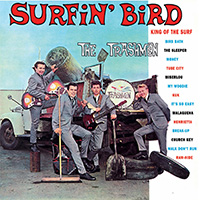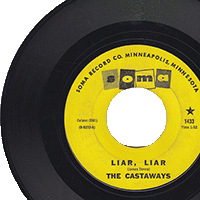Disc Jockeys
Twin Cities Disc Jockeys
- This list is of Twin Cities disc jockeys of the 1950s, ’60s, and ’70s. If I have continuing information, I will probably include it, but this website as a whole stop in 1974.
- The list leans heavily on those who played rock ‘n’ roll – don’t be looking for anyone from WCCO-AM.
- The dates are taken from what was available, and may not be right or all-inclusive. If it says 1972, it may have actually been before and/or after that as well.
- Only Twin Cities stations are included.
- Birth names are given in parentheses.
- All stations are AM radio stations unless otherwise indicated.
- If you have any additions or corrections, please, please, contact me. I would also appreciate any photos. Thanks!
More Disc Jockeys:
Barry Siewert (Barry McKinna)
Barry Siewert was born and raised in St. Louis Park. He has a brother Bruce who was an all-star basketball
Bill Diehl
Sources for this article include Timothy D. Kehr and an extensive interview with Bill and Helen Diehl in 2013. Many
Dick Driscoll
Dick Driscoll was one of the most active, prolific, peripatetic, and hilarious disk jockeys to grace the airways of the
Herb Oscar Anderson
Herb Oscar Anderson (HOA) didn’t spend much time in the Twin Cities, but he made a big impression, and went
Jack Thayer
There would be no music, local or otherwise, without disc jockeys, and one of the most influential DJs in the
Jimmy Reed
Jimmy Reed – KDWB (1966 -1967), KRSI (1969), WDGY (September 23, 1969 – 1984), WLOL (1986) James Arthur Rud
Johnny Canton
One of the indisputably most popular disk jockeys of the 1960s in the Twin Cities was WDGY’s Johnny Canton. His
Professor James Frances Patrick O’Neill
FROM DON BETZOLD The following tribute to one of the classic KDWB Disc Jockeys was written by former State
Texas Bill Strength
This is the first of a 5-page series. These pages are not intended to be a biography of Texas Bill,
Twin Cities Disc Jockeys
- This list is of Twin Cities disc jockeys of the 1950s, ’60s, and ’70s. If I have continuing information, I will probably include it, but this website as a whole stop in 1974.
- The list leans heavily on those who played rock ‘n’ roll – don’t be looking for anyone from WCCO-AM.
- The dates are taken from what was available, and may not be right or all-inclusive. If it says 1972, it may have actually been before and/or after that as well.
- Only Twin Cities stations are included.
- Birth names are given in parentheses.
- All stations are AM radio stations unless otherwise indicated.
- If you have any additions or corrections, please, please, contact me. I would also appreciate any photos. Thanks!
And we all know, being a disc jockey was like this:
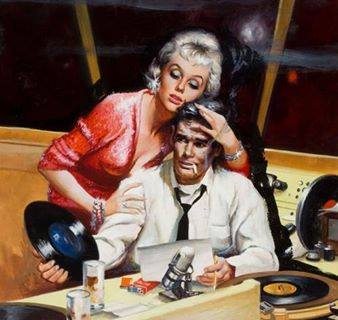
Dean Alexander – WISK (1959), KDWB (1959)
Dan Allan – WMIN (1954-1958), WLOL (1959; program director until October 1963), KSTP (1970)
Terry Allan (Terry Stripsky) – WAYL (1964-66), KQRS (1966-78) Terry writes:
I worked at WAYL from 1964 through 1966, which overlapped with my start at KQRS in 1966. Working at both stations made for some quick trips from Golden Valley (KQRS) to New Brighton (WAYL). I was working midday at KQ and had an hour to drive to WAYL for the afternoon/evening shift. At that time the formats of the two stations were so different I doubt anyone ever noticed I was on both stations even though they were very close on the dial.
Now there’s an interesting combination! Thanks, Terry!
Tom Ambrose – KQRS (1968); WWTC (1970-75); WCCO-FM (1975).
In June 1968 Ambrose participated in a contest at KQ by living in a motor home for four weeks, visiting various places around the Twin Cities and broadcasting his regular show from the KQ parking lot in Golden Valley. The contest was to guess how many miles he drove during those four weeks. Ambrose had also recently won the egg eating championship, “devouring one dozen eggs in less than five minutes on the air.”
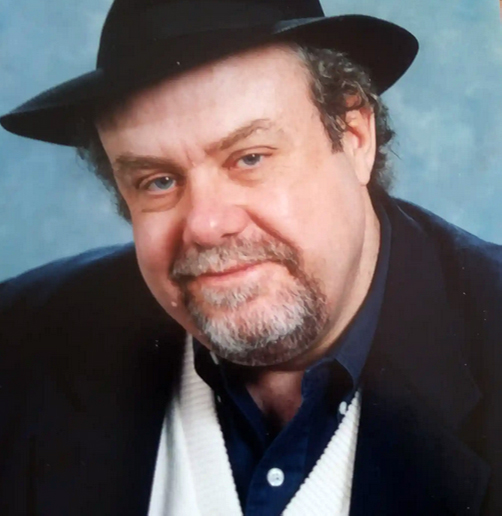
Tom Ambrose died on March 5, 2025. He was 79.
Don Anderson – WLOL (1954-59) – on the “Mr. Music Show” 5/58: D.A. Special: Freeway Club (4-7pm M-F), Swing Club (noon to 6 pm Saturdays). Could be the same Don Anderson who was a host of “Record Hop” on Channel 9 TV from 1957-59?
Herb Oscar Anderson – KSTP (1954-1956), WDGY (1956-1957). Follow the link for HOA’s own page.
Marc Anderson (Howard Leroy Anderson, Jr.) – KDWB (May 1969 – March 1973), WDGY (March 1973 – October 1974), KDWB again. KSTP (Adminstrative job until June 1979), WLOL (early 1980s)
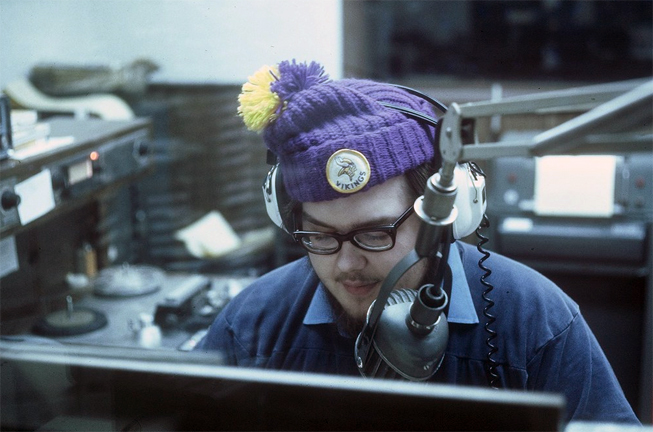
Photo from Rob Sherwood’s Blog Marc died on July 10, 2021, as a result of injuries from a fire at his home on July 6, 2021. He was 71 years old.
Marc Anthony – WLOL (1965)
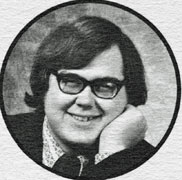
Marc Anthony – WLOL (1965)
Paul Anthony (Ralph Hull) – KDWB (June 1964 – June 1965 as Paul Anthony), KUXL (February 17, 1965 to 1966 as Preacher Paul Anthony).
I was lucky enough to have interviewed Mr. Hull over the phone in 2014, and of course I never wrote up my notes, so I hope I can understand what they mean. At the time he had just closed his restaurant, Sushi on the Sea, in Sooke, British Columbia. After his career in radio he had become a marine operator in commercial fishing and had retired to Canada, even renouncing his American citizenship.
Many of the things he told me were the same things that were in his profile in Secret Stash magazine. He was born in Portland, Oregon, and knew at age 14 that he wanted to make his career in radio. He ended up working at 23 stations over a 17 year radio career. In mid-1964 he got on at KDWB, but got fired for playing the blues. Program Manager Don French didn’t approve and fired him while he was on the air – General Manager Sam Sherwood had to come and finish the shift. He said it was one of nine times he was fired!
Secret Stash quotes him about his interview with KUXL:
For about six months he appears to have been working for KDWB and KUXL at the same time, but I didn’t figure that out until 2021, and by then it was too late to ask him about it.
As Preacher Paul he wrote a rather long article in the Twin Cities teen magazine Twin Cities a Go-Go in September 1965. Most of it was taken up in trying to explain things – the audience of KUXL (blacks and hip white kids ages 16 to 25), the gist of the station (“Truth Radio” or “Big Beat Radio”), and who can rightly sing R&B (only blacks with the exception of one in a million whites like the Righteous Brothers). He didn’t much care for all the white groups trying to sing R&B and would be better off adapting them to rock ‘n’ roll.
Says he Went to XERB in Mexico with Wolfman Jack in 1966. Other aliases were The Nazz, Les Moore, Ivan Goetz, Ref Snaborgadavitch, Captain Cash, the PJDJ, and Captain Rosta. In 2007 – 2011 he ran a sushi restaurant in Sooke, British Columbia.
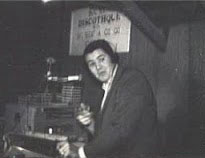
Paul Anthony – Photo courtesy Mark Groesbeck
Wayne Anthony
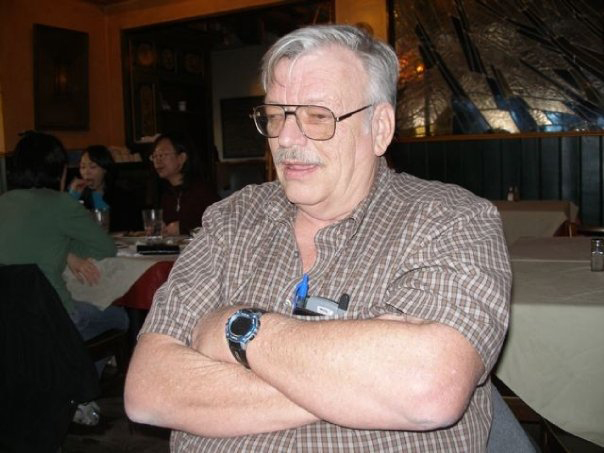
Wayne Anthony in 2009 posted by Randi Kirshbaum
Bill Armstrong – WDGY (March 1956 – 1958).
Armstrong was born in Fremont, Nebraska, on March 16, 1937, and graduated from Lincoln Northeast High School. He worked at Storz station KOWH in Omaha right after graduating from high school in 1954, and six weeks later was transferred to WTIX in New Orleans. In February 1956 he was one of the original DJs at the “new” WDGY, billed as “The All-American Disc Jockey.” He was only 19. He went into the National Guard in January 1957, but returned to WDGY six months later. When Jack Thayer became WDGY General Manager in June 1957, Loughnane transferred to Storz-owned WHB in Kansas City and Jack named Bill program director in mid-November 1958. Storz ad: “Smooth, mystery-tuner, birthday acknowledger, actor, impersonator, writer, newscaster, public speaker, producer, ex-radio a.e.”
Thayer and Armstrong had a falling out, and at the tender age of 21, Armstrong moved to Colorado and bought radio station KOSI in Aurora, which he owned for 25 years. He became involved in several businesses and pursued a political career, serving in the Colorado State House of Representatives (1963 – 1964), Colorado State Senate (1965 – 1972), US Congress from Colorado (1973 – 1979), and US Senate from Colorado (1979 – 1991). He served as President of Colorado Christian University from 2006 until his death on July 5, 2016, at the age of 79.
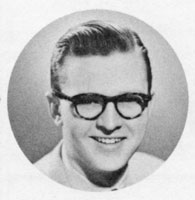
1956
Stu Armstrong – KEYD (1954 – 1955)
Vern Arthur – KTCR (1964)
Prime Minister Billy G. – KUXL.
In the spring of 1968 the Insider reported that he was on-air from 3:30 to 7 on Saturdays only.
Sam Babcock – WDGY (1964).
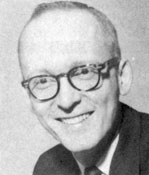
1964
“Boom Boom” Bailey – WDGY (1972-73)
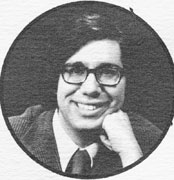
Chris Bailey – KDWB (1969)
Andy Barber – KSTP (1974). Andy replaced Machine Gun Kelly.
Len Bart – WDGY (October 1, 1955 – March 30, 1956)
Tom Barnard – KDAN (1973), KSTP (1974 – 1975), WDGY (2/1975 – 7/7/1977 “The Catman”), KQRS (1986- )
Thomas Mark Paul Barnard was born on November 7, 1951, in Long Prairie, Minnesota, and raised in North Minneapolis.
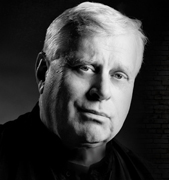
J.J. Barnes – KUXL (1967)
Tom Berry – WDGY (1973)
Len Bart – WDGY (1955-56)
Tal Bartell – WYOO/U100 (1975 – 1976.) He called himself “Tall Tan Tal.”
Bill Bauman – WDGY (1954-55)
Ralph BeBeau – KANO (1957 – 1958), KTCR (1962 – 1965)
J. Walter Beethoven (Wally Thornton) – WDGY (1964)
“Brother” Bill Bennett – WDGY (1956-60), WLOL (1963-65).
In 1956, Bennett came from another Storz station WTIX in New Orleans. He had his name officially changed from Moriarty as part of a St. Patrick’s Day promotion. Once led his own orchestra; WWII Veteran. Storz ad: “Comedian, emcee, TV performer, recording star, teen-dance innovator, ‘Northwest’s outstanding radio personality,’ likeable, perpetual smiler, teen-age columnist, magician, amateur clown.” Starting in April 1956, hosted shows at the Prom Ballroom on Saturday nights. Wrote a teen-oriented column distributed in 130 school papers.
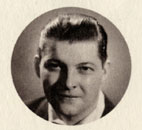
Buzz Bennet – KDWB
Bob Berglund – WWTC (1974), WDGY (1979), WLOL (part of Hines and Berglund), KSTP-AM (news)
Tom Berry – WDGY (1972)
Pharaoh Black (Thornton Jones) – KUXL (May 1, 1975-1979)
Art Blaske – news – KDWB, WDGY (1964)
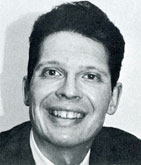
1964
Bill Blast – (Al Collins) KUXL (1967 – 1968)
This was the adopted name of the manager of Music City at 7th & Hennepin who hosted an hour of paid sponsorship for the store on Saturdays for a short period in 1967 – 1968. According to the Insider, he hosted an Oldies show.
True Don Bleu – KDWB (1968 – 1978).
Don was inducted into the Museum of Broadcasting Hall of Fame in 2005.
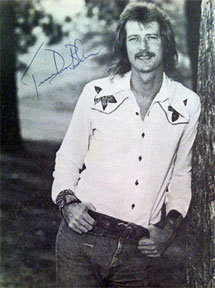
Ron Block – KDWB (1966-69).
On the November 18, 1967 hit list: “KDWB apologizes for what Ron Block said Tuesday morning.”
Benny Blore (Bill Hartman) – WYOO (1973), KDWB (1974 – 1976).
Hartman died in September 2020.
Chuck Blore – KDWB (1966)
Don Bowman – KDWB (1963-64).
Image below from KDWB Fabulous Forty Survey, December 21, 1963. Don Betzold Collection, courtesy Pavek Museum of Broadcasting.
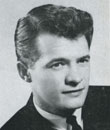
Jay J. Bowman – WDGY (1968).
Photo below courtesy Rick Burnett’s Twin Cities Radio Airchecks.

Steve “Boogie” Bowman – WWTC (1981), KEEY-FM.
Steve died on July 23, 1986, of lung cancer at age 41.
Jim (J. Peter) Boysen – WTCN (1944-54 “Musical Caravan”), WLOL (1957-59).
Photo below is from 1959 at WLOL.

Brad Bradford – WDGY (1966). Described as “rather idiosyncratic” by Mike Neudecker
Bob Bradley – WLOL (1954 – 1958). The “Swing Club” show on WLOL played some rock ‘n’ roll in 1953 – 1955, but mostly covers. WPBC (1959). Photo below from an August 1956 Top 40 courtesy of the Pavek Museum of Broadcasting.
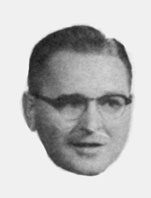
Susan Bradley – KQRS (1970), KRSI (May 1972 to May 1973), KQRS (December 1973 to at least August 1974 ). Susan and Randi Kirshbaum were the first female disk jockeys in the Twin Cities.
Gary Bridges – WDGY (1976)
Chuck “The Chucker” Britton – KDWB
Grady Brock (William Grady Brock) – KSTP (1974 – 1975). Grady died on June 28, 2015, of pulmunary fibrosis at the age of 66.
Jerry Brooke – WDGY (1968), KDWB (1970), WYOO (1974)
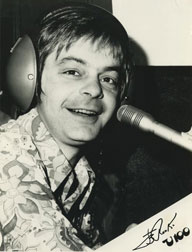
Brother Bob – See Brother Bob Hall
Marci Boelter – KQRS (1978)
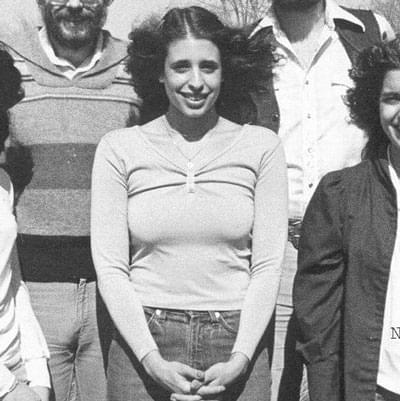
Charlee Brown – (Dave Nixon) – KDWB (1963 – September 1967, again May 25, 1970 – 1972).
Image below from KDWB Fabulous Forty Survey, July 20, 1963. Don Betzold Collection, courtesy Pavek Museum of Broadcasting.
“Charlee Brown was the go-to D.J. at all the bar/bat mitzvah parties in St. Louis Park in the mid ’60s. He knew who was dating who and more. Kind of creepy when you think about it.” St. Louis Park even had Charlee Brown Days in 1964.
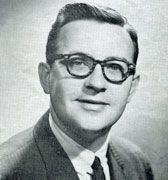
Chuck Buell – KDWB (1969-73)
Paul Bunyan – WDGY (1964-65)
Don Buehler – KSTP (1970)
Dan Burton – WDGY (1979)
Scott Burton – WISK (1956), WDGY (1965 – 1971) “The Boss Sound of Scott” In 1969 he was WDGY Program Director. From a 1970 ad: “The Solid Sound of Scott Burton starts out your day with his entertaining Burton ‘n Eggs Show, morning from 6 to 9. Road information, features, music. A Touch of Taste. Join the Call-In to Scott on the Good Morning Line, 827-9955.” Burton died of cancer on March 26, 2008. Photo below courtesy Rick Burnett’s Twin Cities Radio Airchecks.

Charlie Bush – KSTP (1963-81), WCCO-FM (1981-82), WDGY (1982-83), K102 (1983-91).
Charlie Bush passed away on October 30, 1991. Charlie was inducted into the Museum of Broadcasting Hall of Fame in 2009. Images below courtesy the Pavek Museum of Broadcasting.
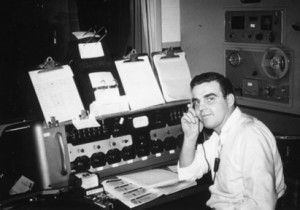

Mike Butts – KDWB (1974-1976)
Steve Cannon (Bernard Cannon) – WMIN (1949 – November 1954), WLOL (October 1955 – December 1957); KSTP-AM (December 15, 1958 – November 4, 1971), WCCO (November 15, 1971 – October 3, 1997).
Shows on WMIN in 1953 – 1954 were “Cannonball Express” and “Cannon Fodder.” In a column dated January 24, 1954, Will Jones called Cannon a “Hep Talking radio disc jockey.”
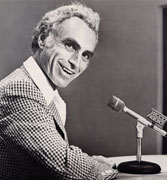
1956 – WLOL. Image courtesy Pavek Museum of Broadcasting In 1958 he was a Disc Jockey and a beatnik (says Will Jones) at Station KGO in San Francisco.
THE LITTLE CANNONS
Over the years, Cannon created characters that became known as the “Little Cannons.” The best known were Morgan Mundane, Ma Linger and Backlash LaRue. His voice characterizations were so real that the the union billed him for back dues!
The image below, from a 1959 ad for KSTP, is captioned,
THE ONE IN THE DERBY… is Steve Cannon, the marvelously adequate host of KSTP’s Morning Watch.. With him — pictured for the first time — are all the Little Cannons who appear with him daily. The Shakespearean janitor is Abilene Anderson; the mail boy is Jethro. The sorehead with the records is Mean Sam, and next to him is the marvelously inadequate Ma Linger. Contemporary Collins is the cool one at the bottom right.
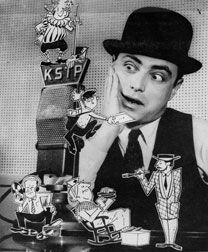
Image courtesy Pavek Museum of Broadcasting. The whole story of the Little Cannons can be read on the Pavek Museum of Broadcasting’s website.
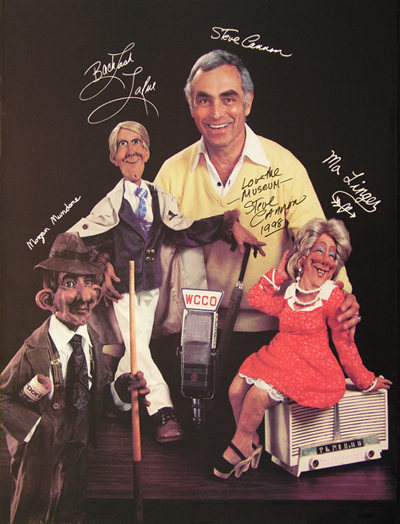
Photo courtesy Pavek Museum of Broadcasting Steve never allowed anyone to see him do his “Little Cannons” voices; when he was inducted into the Museum of Broadcasting Hall of Fame in 2002, he was almost persuaded to demonstrate if everyone shut their eyes, but too many peeked and it didn’t happen. Steve died in April 2009.
In 1975 Mpls. Magazine named Cannon one of Minneapolis’s Sexiest.
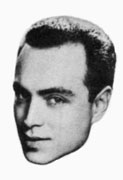
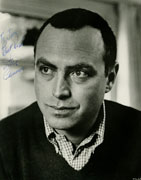
Johnny Canton – WDGY (November 1966 – March 1977). WCCO-FM/WLTE-FM (December 1977 – June 1984, September 1985 – December 2011). Click on Johnny’s name for a page about one of the Cities’ most popular DJs.
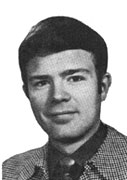
Captain Billy – WYOO (1974)
Al Carlson – KSTP (1973). Played C&W after midnight.
Hugh Carlson – WDGY (1965)
Larry Carolla – KSTP (1973-75)
Roy Carr – WLOL (1954-55), WTCN (1955-59)
Scott Carpenter – WLOL (1964), KRSI (1965), WWTC (1979-1980)
Walt Carpenter – WDGY (1961)
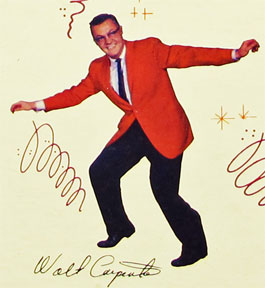
Walt twisting on the cover of a WDGY promotional album
Captain Billy – WYOO
Chuck Casey – KDWB (1964)
Steve Casey – KDWB
Hugh Cardenas – KRSI (1958 – 1961), KUXL (November 1961 – October 1962); WPBC (Sales, 1962 – September 1963). In 1965 he revived his dance band and performed all over the Twin Cities with his vocalist wife, Patty Hicks. He died on April 1, 2001, at age 66 of cancer.
Catman – see Tom Bernard
Don Cavitt – KRSI (1959)
Joel Cederholm – WYOO (1975)
Chuck Cell – KDWB (1963-64), WTCN-TV (1973)
Jack Chapman – WDGY (1964)
Bob Chase – WYOO (1972-73)
Todd Chase – KDWB (1968)
Bob Chasteen – KDWB (1959)
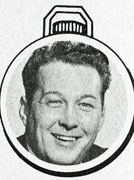
Ray Christensen – KUOM, WLOL (8 years, PD in 1956), WCCO Photos below courtesy Pavek Museum of Broadcasting. Christensen was inducted into the Minnesota Broadcasting Hall of Fame in 2002.
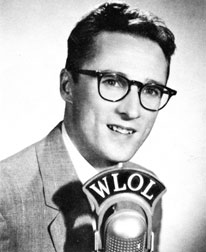
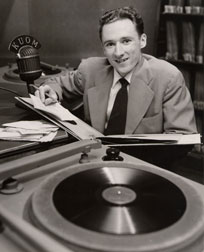
Ray Christensen passed away Sunday, February 5, 2017, at the age of 92.
Michael Christian – KDWB
Bob Christie (Jim Larkin) – KRSI (October 1969 – ) Became Music Director at KRSI in April 1971.
B.J. Clark – KDAN (1973)
Dick Clark a/k/a Mike Ryan – WYOO (1973)
Bill Cleary – WDGY (1954 – 1955)
Larry Clinton – WTCN (1944)
Steve Cochran – KDWB
Bob Cole – WDGY (November 1965 – October 1966). He died on March 5, 1998.
Randy Cook – WISK (1959), KDWB (1959-64), WWTC (1970)
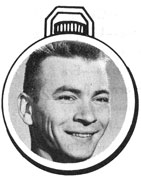
Dave Cooper – KDWB, WYOO (1975)
Cosmic Cowboy – KSTP-AM (1975)
B.J. Crocker (Ken Kops) – WWTC (1979-1984), KMFY-AM (1984-1985)
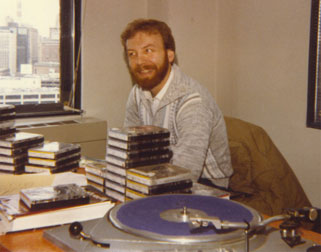
B.J. Crocker on WWTC, courtesy RadioTapes.com
Mort Crowley – WDGY (1964-65)
Larry Cummins – WDGY (1979)
Jerry Cunning – WLOL (1954 – 1958 “The Nightwatch”), KEVE (1959 – 1963), KTCR-FM (1973), WWTC (1985). Image below from an August 1956 WLOL Top 40 courtesy Pavek Museum of Broadcasting.
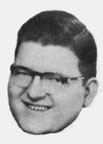
Mike Cunningham – WMMR (U of M), 1966 – 1970; KUXL (1972 – 1974); KTCR-FM, (1972 – 1977)
Information and photo courtesy Mike Cunningham via Rick Burnett’s Twin Cities Radio Airchecks.
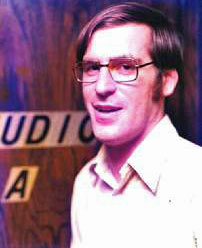
Evan Curfew – See Curt Lundgren
Bill Curtis – WDGY (1948)
Daddy Soul – See Jack Harris
Bobby Dale – KDWB (1960-61)
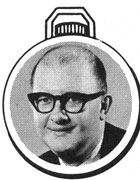
Roy Dale – WTCN (1953-54)
Dandy Dan Daniel – WDGY (1957 – 1961).
Vergil Glynn Daniel was born on December 18, 1934, and started as a disc jockey at age 17 on Armed Forces Radio with the US Navy. His first commercial job was at KXYZ in Houston in 1955. Todd Storz hired him for his station in Omaha in February 1957, and within two weeks moved him to WDGY. Storz ad: “Tall, thin, friendly, contest-minded, safety-conscious, record-hopper, Texas-drawler, heavily sponsored.” Some of his nicknames were Dandy Dan Daniel and Triple-D Daniel.
In August 1961 he went to New York, where he worked at a handful of stations until he retired from WCBS on December 31, 2002. Daniel died on June 21, 2016, after falling in his home the previous day. He was 82.
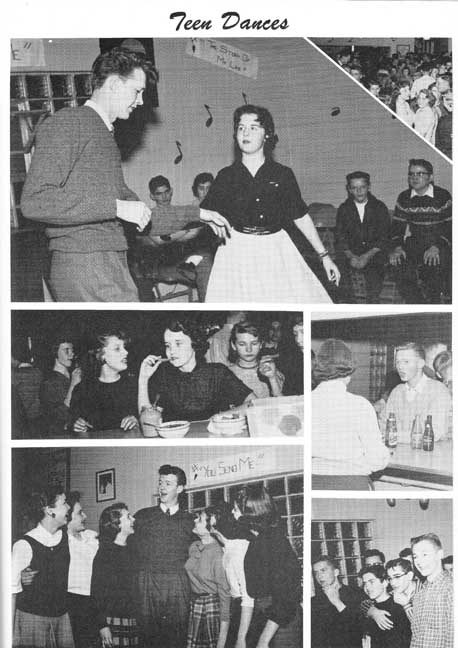
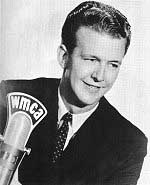
Wikipedia 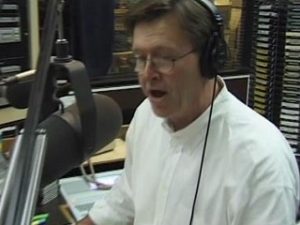
Dave Daniels (David Sikkink) – KANO (1980-’85). After my 1974 cutoff, but he was kind enough to send me a photo!
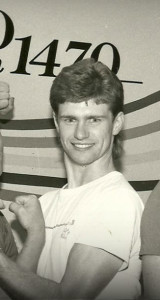
JIM DANDY
Diamond Jim Dandy (James Brian Everts, 1942 – 2010). WDGY 1965 – May 25, 1968. He returned to WDGY in May 1969 to replace Rob Sherwood when Sherwood left for KDWB-AM but moved on to Cleveland before the year was out.
In the Oct. – Dec., 1997 issue of the Pavek Museum of Broadcasting Newsletter, Mike Neudecker wrote his memories of Jim Dandy:
If any readers remember like I do, he had a high-pitched Mickey-Mouse-with-a-cold voice and an intentionally mildly abrasive manner and outlook. This was baldly for the purpose of generating annoyance and hence interest and hence ratings.
Within a week he generated – and read – “hate mail” over the radio, once from a classmate of mine. He’d call the Rolling Stones the “Rolling Uglies,” and would good-naturedly rail against white socks and agitate for keeping drive-ins open year ’round. He chartered the Royal Order of Night People, who would then engage in organized “moon tanning” under the light of the moon. Last, he’d faithfully end each show with the non sequitur, “… And remember, love is love and fun is fun, but isn’t it quiet when the goldfish die?” followed forthwith by “See You in September” by the Happenings!
All of this proved a winning formula, and Jim Dandy thus took ratings for the lucrative 7:00 pm teen time slot to an all-time high for the next year and a half. By late ’67, however, he tired of the shtick, quit the show, and left the station.
By spring of ’69 WDGY wanted him back at almost any price, and reportedly made him an unrefusable offer. By April the hype and hyperbole began. A Saturday in late May was selected as “The Time” and a grassy open area between Wards Southtown and the Southtown Bowl was selected as “The Place.” The pomp and circumstance would be provided by a band called the Tombstone Epitaph set up in front of the bowling alley wall for an event billed and ballyhooed as the “Return of the King.”
I arrived at the appointed time with a couple of friends, sat on the grass with a not overly large crowd, and began to wait.
The eggbeater sound and sight of a helicopter on the horizon…grew larger and louder [easing] down in the center of the large grassy rectangle. Jim Dandy got out to commence “The Return of the King,” and it was immediately apparent how dismayed he was at the small crowd. I’m sure he had expected hundreds more.
“The King” then walked briskly over to the microphone stand…and in a slightly pained and disappointed voice, greeted the faithful assembled for the second coming. He seemed at a loss for words as he quickly surveyed the scene. “Most of you graduating this June?” he asked, engendering nods and shouts of “Yes, yeah!” Not skipping a beat, he hastened, “Well, we’ve got a band here to play for you, and I hope you enjoy the music…” He then did a quick stage left as the Epitaph began to blare and discreetly disappeared in a manner antithetical to that in which he had arrived only five minutes earlier.”
In retrospect, what neither myself nor Dandy nor WDGY realized that spring was by 1969, “the times they were a-changin’” – and indeed had changed. The relatively simplistic and superficial mid-’60s ethos had metamorphosed to the super-hip, politically charged ethos of Woodstock, then only two and a half months away. Hence the small crowd and disappointed “King” and WDGY. Dandy would be gone a second and final time within the year.
Second photo below from 1969, courtesy Rick Burnett’s Twin Cities Radio Airchecks.
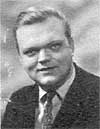
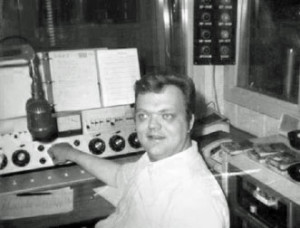
Big Al Davis (Al Arneson) – KSTP-AM (1973), WYOO (1976)
Bobby Davis – KDWB (1967-68) “Super Boob” in TV Guide ad
Bob Dayton – WMIN (1969), KDAN (1970), WDGY (1971 – 1973). Dayton took his name from Dayton’s Department Store, which, at one point in his career, was his only sponsor.

B. Mason Dean (Robert Gross) – WDGY (1966 – 1967)
Joe Della Malva – WDGY (1956) Storz ad: “News director, newscaster, WDGY news center overseer, Sound-Off editor, tipster-ringleader, scooper (on nearly every important local story), beauty judge, Simca-owner, pop science devourer), WPBC (1959)
Jimmy Delmont – WTCN (1952), WMIN (1953), WLOL (May 1953-), WCOW (1954 – 1955), WISK (1956). Sam Sherwood remembers that at WCOW, Delmont had a kind of “advice to the lovelorn” program that the ladies just ate up. He called himself their “sentimental servant” and opened his show with his theme song, “Tenderly.” A note on April 1, 1954, said that he was back at the Five O’Clock Club on WCOW after a couple of months’ illness. Jimmy hosted a Beach Party show at Phalen Park Beach in the summer of 1955 that was very popular with kids.
The first photo below comes from 1955 ad for WCOW. The second image is from Jimmy’s letterhead, courtesy Pavek Museum of Broadcasting.

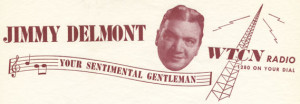
Gary DeMaroney – WYOO (1976)
Packhorse/Pecos Paul Denault – WCOW. Also did a kiddie show on Channel 5 TV called “Saddle and Boots” – he was Boots. Denault went on to a long career at WGN in Chicago as Paul Rogers. Denault died on March 3, 2007 at age 81.
Bill Diehl – WMIN (1948 – 1949, 1951 – 1955), WTCN (1955 – February 1956), WDGY (1956 – 1966), WCCO (1967 – 1995). Click his name for a separate page on this Twin Cities radio icon.
Johnny Dollar (Robert Dean (Bob) Moomey) – WDGY (1963 – 1966) [11-17-1936 to 1-19-2008]
John Dotas – WMIN (1961 – 1963, under his own name), WMIN (1963 – 1966, as Johnny West), WDGY (1967 – 1973, as Dr. George Young)
Don Doty – WCOW (July 1, 1952 to October 1953), KDUB-TV, Lubbock (December 1953), WTCN (January 1955 – March 31, 1958), WPBC (June 2, 1958 – April 16, 1959), KSTP (April 17, 1959 – May 1964), WTCN-TV (1965), WPBC (1965 – 1966).
Donald Smith Doty was born on April 23, 1926, in St. Paul. He was a graduate of the University of Minnesota and a veteran of World War II.
In his short 40 years, Don Doty spent most of them on the air, garnering many awards as the Twin Cities’ favorite DJ of the 1950s.
While at WCOW, “Denver Don” Doty was the top country DJ in the Twin Cities. He was also the Program Director.
He won a Favorite DJ contest run by Don Leary in 1955.
From February to April 1955, he hosted the Don Doty TV Show on Channel 11.
In February 1956, Doty won a “Minnie” Award for best Disc Jockey.
In 1958 he won a Minnie for Best Male Radio Announcer.
On April 4, 1958, Will Jones reported that Doty left WTCN because of “doubts about a racy new program policy that is to start soon.” Leigh Kamman was to replace him, but he went to KSTP instead, for the same reason.
In a letter to a fan dated May 6, 1959, Don reported that when he started at KSTP, “they built me my own little private studio inside the radio transmitter on Highway 61, about a mile north of Highway 36, out towards White Bear. I play my own records and run my own controls. I’ve never been happier with my work than I am now.”
In 1960 and 1961, Doty won Minnie Awards for best Disc Jockey.
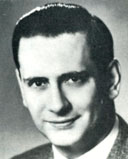
1964 On May 7, 1964, Will Jones reported that Doty announced he was giving up the rat race to become a bon vivant. Jones also reported that his contract had expired, which may have meant that he was fired. Apparently there was a rash of firings at KSTP – Don Morrison reported that several well-known personalities were “turned out” by KSTP.
In July 1964, Will Jones described Doty as a freelance TV announcer and radio DJ. He was also getting MC work.
Mentions in January and February 1965 say that Doty was working for WTCN-TV.
An article dated June 15, 1965, indicated that Doty was at liberty, freelancing on WTCN-TV.
In September 1965, Jones referred to him as “WPBC’s Don Doty.”
Don Doty died on October 12, 1966, at the age of 40, after a seven-year battle with cancer.
Jack Douglas – WCOW, WDGY, WMIN (1955 – 1958), WCCO (1973). Jack had a deep voice and did a show called Rhythm Roundup on WCOW featuring country uptempo tunes.
Lord Douglas (Phillip E. Heuer – also see Chris Roberts) – KDWB (10/1967 to 3/1968). Follow the link for an aircheck on radiotapes.com provided by Curt Lundgren.
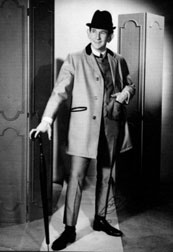
Michael J. Douglas (Wegner) – KDWB (1972 to 1973), WYOO (1975 to 1976), KSTP-FM/KS95 (February 1979 to April 1994). With Chuck Knapp, Douglas was half of the team of “Knapp & Donuts” on KS95. KQQL (KOOL 108) (1990s.) Douglas retired because of injuries sustained when he fell out of a tree. Michael died on April 24, 2013 at the age of 65.
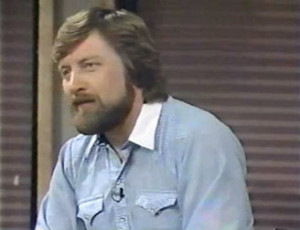
Click on the link for a page dedicated to Dick Driscoll. Photo below courtesy radiotapes.com
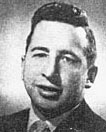
Roy Drusky – KEVE (1957). Also performed at the Flame Cafe.
John Ducart – WLOL (1959)
Don DuChene – KDWB (1961 – 1965), KSTP (1965 – 1970); KQRS (1971 – 1973). KSTP photo courtesy of Don’s son Tom. Second image from KDWB Fabulous Forty Survey, June 15, 1963. Don Betzold Collection, courtesy Pavek Museum of Broadcasting. Hear Don from the summer of 1965 on YouTube. Don passed away on May 14, 2016, at the age of 83.
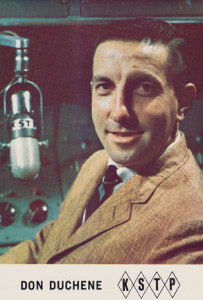
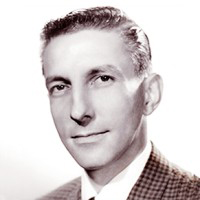
Dave Dudley (David Darwin Pedruska)- WISK (December 1957 – February 1958), KEVE (February 1958 – February 1960). Dudley’s online bios say he moved to Minnesota in 1960. He died in December 2003.
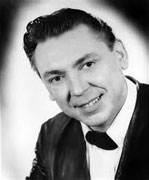
Larry Dukes – KDWB (1967)
Jim Duryea – WMIN (1959)
Dave Dworkin – KSTP-AM (August 28, 1973 – less than one year); KQRS (December 6, 1978 – 1984)
Dave was Captain Beefheart on KSTP in 1973. He gave away meat during a meat shortage!
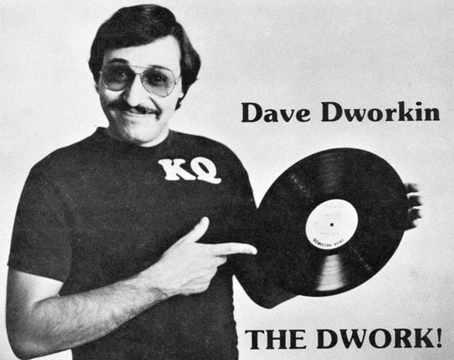
Dave passed away on October 14, 2018.
Rick Easton (Elroy Easton) – KRSI (1969). In 2022 Denny Long reported that Rick was a retired Chief of Staff officer from the North Dakota Army National Guard.
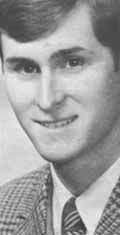
Rick Easton, from the KRSI Request Album, courtesy Roger Fischer
Curt Edwards – WTCN (1952)
Joe Edwards – WDGY (1972)
Eric Edwards – WDGY (9/1974-)
Frank Edwards – WMIN (1953-54), WDGY (1954)
Merle “Hub Cap” Edwards – WMIN/WMNS (1949 – 1955).
Merle had a late-night “Uncle Merle” request show in ’53-’54 where he played rock ‘n’ roll and rhythm & blues, including tunes by Clyde McPhatter and Little Richard. His other WMIN shows were Merle Edwards’ Caravan (1954) and Merle’s Mad House (1955). Bill Diehl told the story that he was offered a great show and time slot, but only if he changed his name to “Hub Cap” – apparently the sponsor was a car dealer or something. Well, Bill was already a well-known columnist in the St. Paul Pioneer Press, and couldn’t see doing such a thing, so he turned it down. So Merle became “Hub Cap.” First photo below from 1949. Merle’s is the second photo Stuart A. Lindman is holding up

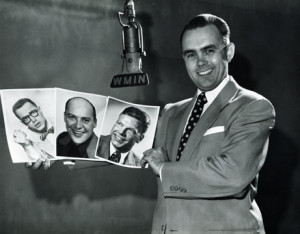
Marc Elliot – KDWB
Chuck Englund – WWTC (1965)
Chuck Evans – KDWB
John L. Evans – WDGY (1954-55)
Paul Evans – See Curt Lundgren
Peter Evensen – KSTP (1958 – 1959).
A 1965 ad said that Pete was a six-year KSTP veteran and frequently presented the news over KSTP Radio. He also regularly presented the weather on KSTP-TV on the Sunday 10:00 news.
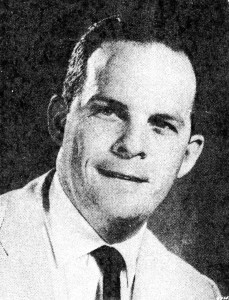
1965
Warren Falls – WYOO (1973)
Loyal Farrel – WWTC (1964-65)
John Fine – KQRS (DJ and Musical Director)
John Michael Fine died on September 5, 2008, at age 60.
John Fineberg – KQRS (1972), KRSI (1972 – 1973)
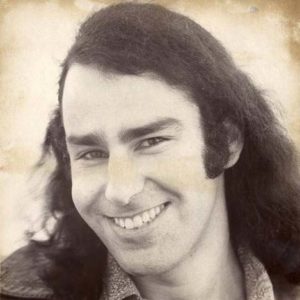
John Fineberg, 1972/1973 at KRSI. Photo courtesy John Fineberg. 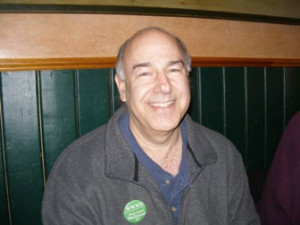
John Fineberg in 2009, posted by Randi Kirshbaum
Ken Firstahl – KEVE (1959)
Larry Fischer – WLOL (1951 – 1953), WTCN (1953 – 1956). Moved to Milwaukee in 1956.
Jack Fisher (The Ole Reb) – WLOL (1955)
George Donaldson Fisher – KQRS (early spring 1966 to 1971), KSJN (1974), MPR (1975 to 1976), Cities 97 (1985, 1986 to 1987, 1991)
George describes his disc jockey journey:
I began the Progressive (I referred to it as “Underground”) rock on KQRS in early 1967. The station had signed off the air at 11 p.m. when I did evenings until I was offered the overnight slot with Musicland as a sponsor. Then I was given stacks of albums of rock, bands from primarily the West Coast, to audition and play once my show began that Spring. I developed a “format” of album rock, blues, soul, some jazz, a bit of folk, classical, spoken word and anything I could find that interested listeners. The reaction to the music I played overnights was very favorable and the “format” expanded to evening hours and then into days and KQ became full time rock.
Here’s an aircheck from May 15, 1970, courtesy twincitiesradioairchecks.com
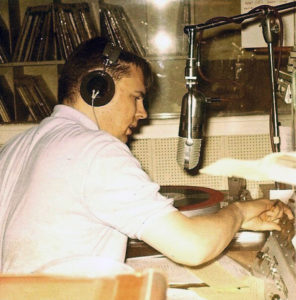
George at KQ in 1966 playing records for the MOR format 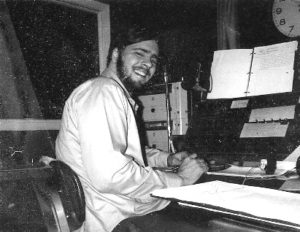
George in about 1968 at KQ, well into the “underground” rock format 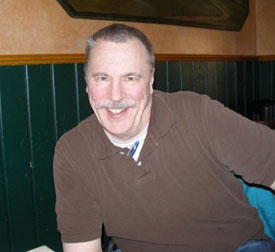
George in 2009, posted by Randi Kirshbaum George says he is always delighted to hear from his former listeners – his email is 1103@comcast.net
Arne Fogel –WWTC (1980-1984).
Arne is primarily a singer: a member of the rock group Batch in the ’60s and ’70s, and a prolific jingle singer to boot. I remember how he played oldies and told his audience some fun facts about the songs and/or artists!
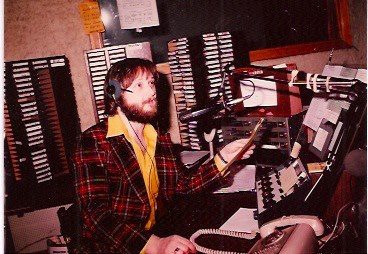
Arne in 1980 at WWTC
Curt Forsland – KSTP (1959)
Jim Foster – WCOW (1956), WISK (1956)
Charlie Fox (James Martin) – KDWB (1974-1975)
Dave Fransen – WDGY (1961)
Gary Frarck – KDWB (1959)
Alan Freed (that’s his real name!) – WWTC (1982 – 1983 Golden Rock, 1984 – 1985 Metro Radio, 1998 Beat Radio (and Beat Radio Network, at which WWTC was the flagship station)), KBEM (1977-1981), KMOJ (1981 – 1987), KTCJ (1984 – 1985), KMAP (1988 – 1989), Beat Radio 97.7 (1996), KFAI (1997 – 1998)
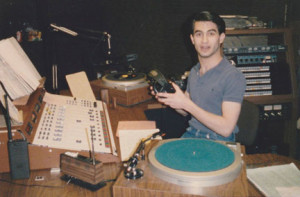
Don French – KDWB (1960). Photo of Don French interviewing Hubert Humphrey courtesy Pavek Museum of Broadcasting.
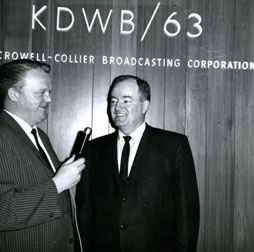
Bob Friend – WISK (1959 – Freund), KDWB (1959-63)
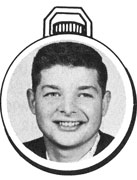
Ralph Jon Fritz – KRSI (1963, 1967). Known more for his TV career on WCCO. Photo below courtesy Minneapolis Central Library.
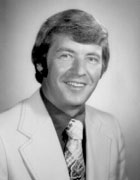
Stu Gang (Jeffrey Stewart) – WTCN ( -1/1957), WDGY (news 1/1957- ), WTCN-TV (1964)
Bill Gardner – KDWB (1973)
Mort Garren – KRSI (1959), KUXL (1963). In October 1963 Garren hosted a show called “Celebrity Table,” with remote broadcasts from places like the Waikiki Room at the Pick Nicollet Hotel.
Greg Gears – WWTC (1971 – 1975), WCCO-FM (1975)
Anthony Gee – (Tony Coloff ) – KRSI (1969). Denny Long reported that Tony became a multi-station owner in Iowa.

Anthony Gee, From the KRSI Request Album, courtesy Roger Fischer
Steve Gibbons/Ugly Steve Steele – WYOO (1972)
Tony Glover – KDWB Underground (April 1969-July 1970). He took over from Jonny Matthews.
Note that while Glover’s program on KDWB was extremely popular, it was by no means the first Underground music program in the Twin Cities. George Donaldson Fisher had begun playing a diverse selection of underground rock, jazz, blues and comedy (Firesign Theatre, Cheech and Chong) since 1967 on KQRS.
George writes:
In fact, one night in 1969 I called Tony and suggested we both play the same music at the same time to see if any listeners switched between our stations and noticed. They didn’t, but the point is I had the same music in the KQRS library as Tony had at KDWB. We played the same music for an hour coordinating over the phone.
The following information about Tony’s performing career comes from Tony’s website:
Tony Glover was a performing musician and writer since 1962. In the mid-sixties he recorded and toured as part of the seminal folk-blues trio Koerner, Ray & Glover. He authored three books of harmonica instruction, album liner notes, as well as countless feature articles, book and record reviews for publications as diverse as Junior Scholastic, Music Journal, CREEM and Rolling Stone.
In the seventies he played with Nine Below Zero, an electric band doing blues, country and rock classic tunes. In the late eighties he and Dave Ray began regular duo gigs, appearing with artists like John Lee Hooker, J J Cale and B B King. The nineties saw “reunion” KR&G appearances at Winnipeg, Vancouver, and Philadelphia folk festivals, as well as release of a live 1996 album by the trio. Glover also produced a two-hour documentary video on the life and times of the group.
[This documentary is apparently only available on a 2007 DVD that goes for over $100. There are many clips of performances and a shorter documentary on YouTube.
He continued writing as well. In 2000, his booklet notes for the CD release BOB DYLAN LIVE 1966 won the ASCAP-Deems Taylor award. He researched and co-wrote a biography of the harmonica great, Little Walter. Blues With a Feeling was published in Fall 2002 by Routledge Press.
He also continued performing and recording. With his partner Dave Ray he released four albums since 1987, and the two performed often in the Twin Cities and surrounding midwest area before Ray’s death on Thanksgiving day 2002. Glover performed with his acoustic trio V3, and did occasional gigs with Spider John Koerner.
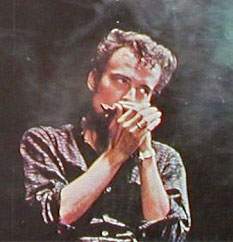
Tony Glover passed away on May 29, 2019.
“Tuneful” Tommy Graham – KTCR (1970); KSTP, WYOO, WRAH (all 1972); KSTP-FM (1976) Tommy Graham was apparently a colorful character with a long history in the music industry. Stories:
Last I heard he was in Dallas, at least two years ago. He had a quad bypass, though after that I watched him eat a steak/lobster dinner drenched in melted butter and gulping wine. Guy lived big.
Stuart Balcomb remembers:
When I knew Tommy, he looked like Alan Hale Jr. with a bleached-blond Little Richard bouffant. What a hoot. He said he had worked with Dick Clark, and even took a fall for him during the payola scandal. When I knew him in 1978, Tommy was working as an arranger for the John Davidson Singers Workshop on Catalina Island off of LA.
John Grimes – KSTP (1956)
Jo Jo Gunne – WYOO (1976)
Dick Haase – KRSI (1963), WWTC (1965)
Smokin’ Joe Hager – KSTP (1973 – 1974), KDWB (1974 -1979)
Joe was born in Philadelphia, Pennsylvania on January 17, 1945. Following graduation from Camden High School in Camden, New Jersey in 1963, he began his radio career at WRSU, the campus radio station, while attending Rutgers University. Leaving college, he joined radio station WMID in Atlantic City in 1965. He was drafted that year and spent two years in Vietnam, returning to work at stations on the East Coast from 1967 to 1972. After his years in the Twin Cities, he finished his career at various stations in Florida.
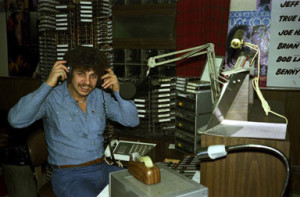
Joe Hager, KDWB, 1976. Photo courtesy RadioTapes.com 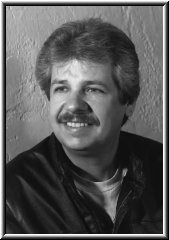
Joe passed away February 23, 1999, at the age of 54.
Sammy Hale – WDGY (1961)
Brother Bob Hall – WYOO (1974 – 1976). Also known as Brother Bob.

Photos courtesy RadioTapes.com
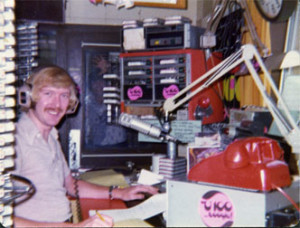
Dick Halvorson – WISK (1959), KDWB (1959 – 1961), KSTP (1973)
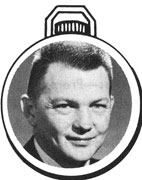
Dan Halyburton – WDGY (1977)
John Hamilton – KDWB (1967)
Lance “Tac” Hammer – KDWB (1965 – 1968), KRSI (1968 – 1974), KQRS (March 1, 1974 – 1979), WLOL-FM (1982 – July 1986). According to newspaper listings, Tac moved from KDWB to KRSI sometime between March 26 and April 21, 1968.

Tac Hammer, from the KRSI Request Album, courtesy Roger Fischer For fun I looked him up on Ancestry.com – Lance Douglas Hammer (12/10/1939 – 8/19/1993) came from Hammer Village, South Dakota, where everyone there was named Hammer! It is now a ghost town. Tac’s sister, Mary Beth Worm, sent in her memories of Tac’s home town:
My grandfather, Iver Hammer, owned much of the farmland and land in and around Hammer in the early and middle part of the last century. He and his wife Ingaborg raised nine children there. Their oldest daughter, Sophie Berit, died at young age and is buried in the cemetery as you turn down the road towards Hammer. It was once a busy town, but the story passed down in the family is that the railroad stopped going past as much or at all. Farming changed and the businesses could not survive. My uncle Selmer ran the grocery store, creamery, and post office. Iver and his sons owned and worked there, including my dad Hardy, who owned the gas station for a bit. World War II marked the beginning of the end for Hammer. Iver Hammer died in 1951 I believe. I spent summers there as the town was waning. It was a great place for a kid’s imagination!
Dick Hansen – WMIN (1956)
Dick Harris – KDWB TV Guide ad: “The Controversial Dick Harris. M-Sat midnight to 2am – Call in – if you dare”
Jack Harris, aka “Daddy Soul” – KUXL (1968-1970).
Jack came to KUXL in the spring of 1968 and quickly became the program director when Ray Moss left. The Insider reported that he was also an artist on the Chess/Checker label. In 1969 he produced the “Jackie Awards” to recognize black musical talent in the Twin Cities. Singer, song writer, radio executive and entrepreneur Jack “Jackie” Harris was born in Chicago in 1936 and started playing piano and singing when he was 5 years old. Billy Davis introduced him to Chess records and one single was issued. In 1970 he left to run a station in Omaha.
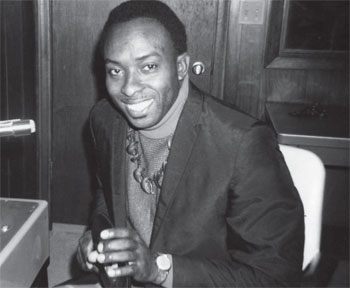
January 1969 – Minnesota Historical Society
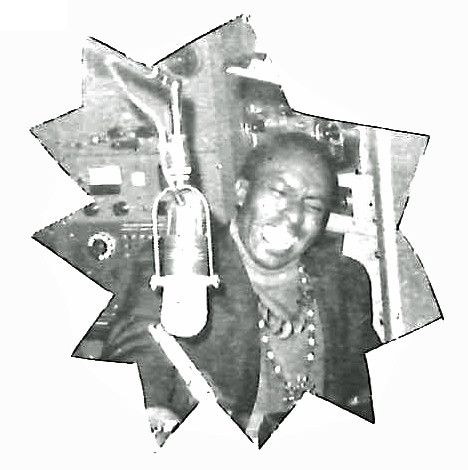
From 1969 KUXL Music Survey – RadioTapes.com
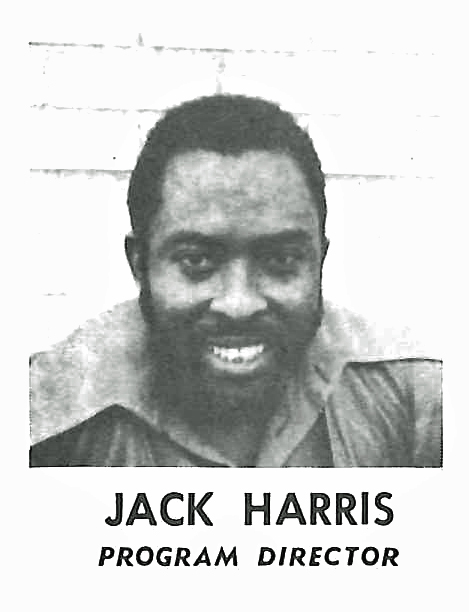
From 1971 KUXL Music Survey – RadioTapes.com
Tony Hart (aka Fast Eddie and Frank Miller) – KDWB-FM
Steve Hatley – KSTP-AM (1973 – 1975)
Steve died on February 28, 1984, at age 37 in a motorcycle accident in Albuquerque, New Mexico.
Don Hawkins – KSTP (1945-1959) Don “Night Hawk” Hawkins show. Don died in 2007 at age 95. Thanks to Dave Fairhurst for sending this fabulous photo!
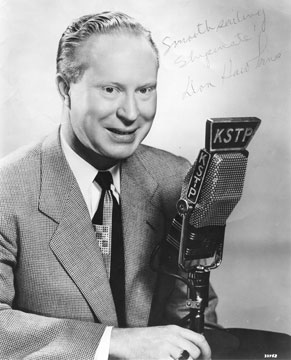
Paul Hedberg – WMIN (August 1958), WTCN, WLOL, and KDWB (1961 – December 30, 1962). He went on to build stations around Minnesota and Iowa. Paul was inducted into the Museum of Broadcasting Hall of Fame in 2002.
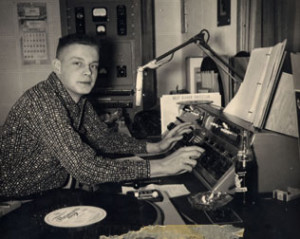
Photos courtesy Pavek Museum of Broadcasting.
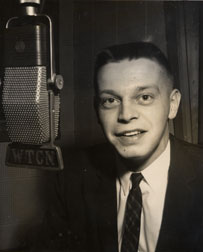
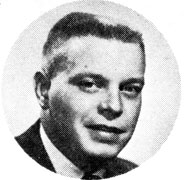
Paul Clifford Hedberg passed away on May 27, 2021, at his home in Southlake, Texas, at the age of 81. He was born on May 28, 1939, in Cokato, Minnesota.
Max Henderson – WTCN (1952-54)
Marv Henry – WLOL ( – 1962), KSTP (1962 – )
Myron Heuer – KEVE (1959)
Steve Highsmith – WDGY (1979)
John Hines – WWTC (1971- 1973), KSTP (1979), WLOL-FM, KEEY-FM, WCCO
Ed Hinshaw – KSTP (1962)
Jim Hobbins – WCOW. Hobbins was actually an audio engineer, but the Tedesco Brothers, who owned WCOW, had a policy that WCOW engineers had to be on the air for an hour a day. Hobbins’ on-air name at WCOW was Juniper Jim.
Fun fact: Hobbins went from WCOW to TV station WMIN and then WTCN. When Casey Jones first came on the air in September 1954, it was Hobbins who wrote the famous “Happy Birthday Song” that every Boomer kid knows and loves. It was probably written because the traditional “Happy Birthday to You” was under copyright, with a stiff royalty. In 2016, a Federal court declared that “Happy Birthday to You” was no longer under copyright, and the copyright itself was probably fishy from the start. But then we never would have had our wonderful “Happy Birthday Song!” Many thanks to Al DeRusha (and Wikipedia) for this great information!
Franklin Hobbs – WCCO (1959 – 1981: Hobbs’ House), KEEY FM (April 5, 1981 – January 1983), KLBB (March 14, 1983 – 1995). Hobbs died on October 19, 1995, at the age of 75. Franklin Hobbs was inducted into the Minnesota Broadcasting Hall of Fame in 2007.
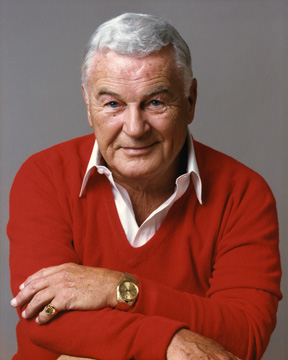
Photo courtesy Pavek Museum of Broadcasting
Dolly Holiday – KSTP (1970)
Blueberry Bill Hood – KDWB (1974 – 1976). Blueberry Bill hour with local musicians on Sunday nights.
Bob Hooper – KDWB (1974 – 1976)
Hal Hoover – KDAN (April 1970 to March 1972), WAYL, KQRS (September 1977 to 1981), WDGY
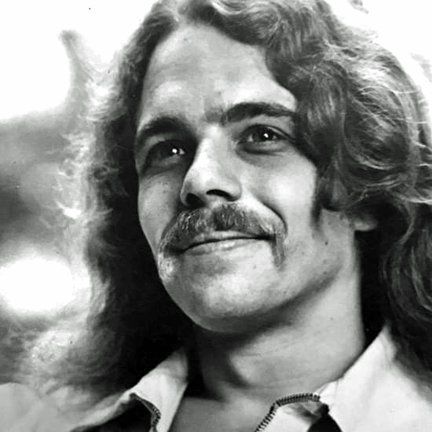
Louis E. “Lou” House, Jr. – WDGY (1955), WMIN (1956 – 1958), KDWB (1959)
Lou House was possibly the only black DJ in the market before KUXL came on the air. In 1957 – 1958 WMIN put weekly ads in the Minneapolis Spokesman urging readers to listen to “Lucky Lou,” Sundays from 10 pm to 2 am. His program was described as “Jazz and Bits and Pieces of Music.”

St. Paul Recorder, August 30, 1957 From what I can tell, Lou went to WTMB in Tomah, Wisconsin, in 1959; was in Chicago (WAAF?) in 1965; became the Director of the Council for Bio-Medical Careers Training in New York in 1968; and hosted at least one edition of the “Black Journal” newsmagazine TV show for WNET in New York in 1969.
Jack Houston – WWTC (1964-65)
Mike Hoyer, KEVE (1945 – 1959)
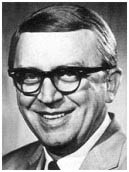
Mike Hoyer was a legendary overnight Country radio air personality, whose show reached “from coast to coast and border to border and then some,” as he said each night to open his program. Hoyer started in radio right out of high school at age 17 when he joined KEVE in 1945 to at least 1959. He went on to several other Midwest Country stations before retiring. Hoyer was also a United Artists recording artist, co-writing “Looking at the World Through a Windshield,” a hit for Del Reeves.
Mike Hoyer was inducted into the Country Music DJ Hall of Fame in 1995. He also received a Lifetime Achievement Award at the 2007 Mid-America Music Hall of Fame. Hoyer died on February 1, 1999.
Information and photo from virtualtruckroute.com
Ralph Hull – See Paul Anthony
Jim Hutton (James Utton) – KSTP (1958 – 59)
Bill Ingram – KSTP (1955)
Slim Jim Iverson – WRHM (WTCN) (1932), WDGY (1947-1949), KEYD (1953-1956), KSTP, WLOL.
Slim Jim hosted Slim Jim’s Westerners on KMSP-TV Channel 9 in the 1950s. He was inducted into the Museum of Broadcasting Hall of Fame in 2003. He died in 1958.
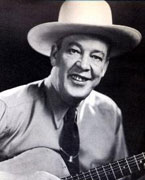
Photo courtesy Pavek Museum of Broadcasting
Bo Jangles: See Gary Marshall, below.
Paul Jay – KDWB (started November 26, 1960 – January 1961), KSTP-AM (1965 – 1966)
Lord Jeffrey (Jeffrey Diamond) – KUXL (1967-1970)
Jay Jenson – KTCR (1964)
Johnny T. – KEYD (1956 – 1957)
Amos Johnson – KUXL (1971)
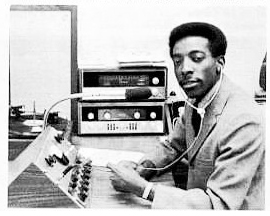
Insider, September 1971
Brad Johnson -WMIN (1958 – “The Old Professor”), WTCN (1959 – “The Bumper-to-Bumper Club”), KRSI (1964), WLOL (1967 – program director), WCCO (Sales).
In 1960 Brad switched to WTCN-TV, doing weekend weather and hosting “Lucky 11 Dancetime” on Saturday afternoons. He also guest hosted Dick Clark’s “American Bandstand” in Philadelphia. Brad passed away in 1988. He was inducted into the Museum of Broadcasting Hall of Fame in 2008.

Photo courtesy Pavek Museum of Broadcasting.
Deane Johnson – KDWB (May 1969 – September 1970). Became General Manager of KDWB in October 1970.
Don Johnson – WISK (1959), KDWB (1959)
Paul Johnson – WDGY (1961). This is the original Paul Johnson, twisting away on a WDGY promotional album.
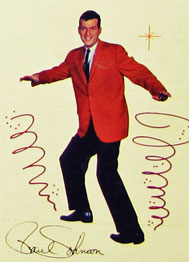
Paul Johnson – WDGY (1979). This is WDGY’s second Paul Johnson, on staff when the station went Country in the 1970s.
Red Jones – WDGY (1963 – 1964)
Tom Jones (Jim Channell) – KSTP-AM (1973 – 1975)
T. Michael Jordan – KDWB (1968)
Leigh Kamman – WLOL (1940 – 1942), (1946 – 1950), (July 1, 1956 – April 1958), KSTP (April 15, 1958 – 1973), MPR (1973 – 2007 – “The Jazz Image”). (*Leigh was slated to take Don Doty’s slot at WTCN in April 1958, but Will Jones reported that when KSTP found out he was available, they made him an offer. Both Doty and Kamman had “doubts about a racy new program policy [at WTCN??] that is to start soon.”)
There is much to say about the great Leigh Kamman, and I won’t attempt it here. If nobody has written a book about him, they certainly should. I only spoke to him briefly before he died on October 17, 2014, at the age of 92.
Leigh was inducted into the Museum of Broadcasting Hall of Fame in 2003. Photo below from an August 1956 WLOL Top 40 courtesy Pavek Museum of Broadcasting.
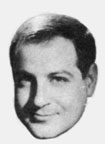
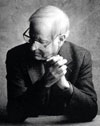
Bob Kaye (Krekelberg)- KEYD (1952-1955) – later sales at WCCO. Bob died in 1996.
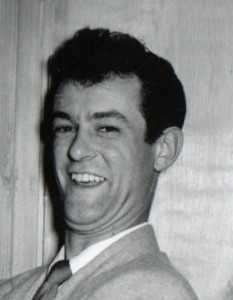
Bob Kaye in 1953 – photo courtesy Mimi Vogel
Don Kelly – WLOL (1954 – 1957; with Steve Cannon January 1957), WDGY (early 1957 – 1960).
Storz ad: “‘Morning Mayor,’ happiest man in radio, radar-location divulger, ‘Smilin’ Irishman,’ singer, comedian, wit.” Image below from an August 1956 WLOL Top 40 courtesy Pavek Museum of Broadcasting.
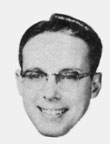
Machine Gun Kelly (Gary Sinclair) – KSTP-AM (1972 – 1974)

Machine Gun Kelly at KSTP, courtesy RadioTapes.com
Tim Kelly (Tim Sabean, Sam Sherwood’s son) – KDWB (1976 – 1979), WYOO/U100
Alan Kennedy – KDWB (1959)
Rodger Kent (Vogel) – WDGY (1950), KSTP (1954 – 1957), WCCO, WTCN (1959), WAYL (1979), KTWN, KLBB. Born June 9, 1924, in Waukegan, Illinois, died November 28, 2014 in Cook, Minnesota. Rodger was inducted into the Museum of Broadcasting Hall of Fame in 2003.
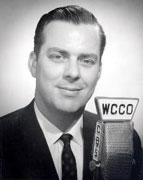
Photo courtesy Pavek Museum of Broadcasting
Tom Kilbride – WLOL (1958), KEVE (1959), KANO (1960 – 1965).
Tom remembers: “When they let me go at WLOL, I was replaced by Carl Peterson I think his name was. ‘The Singing Swede.’ Jim Boysen hired me at WLOL and when I got the axe at KEVE, he got my time slot.” Tom moved to Waco, Texas, in 1969.
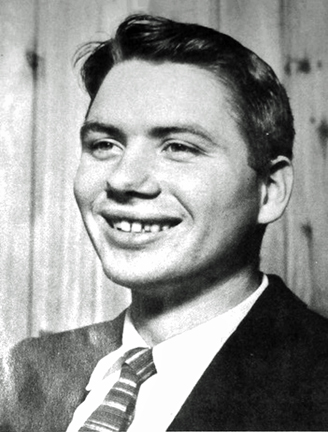
Tom’s AFTRA photo, courtesy Tom Kilbride
Mesa Kincaid (Cheryl Holm) – WYOO (1975 – 1976), KSTP, KQRS, WCCO-FM.
Mesa was known as “The Fox That Rocks.” She died on September 6, 2009 at the age of 52.

Bill Kirby – WTCN (1944)
Bob Kirby – WTCN (June 6, 1960)
Randi Kirshbaum – KQRS (1970-1975). She and Susan Bradley at KRSI were the first full-time female disk jockeys in the Twin Cities. Tom L. says “She was very soft spoken (kind of sounds like a public radio DJ) but sexy too.” Randi was 16 years old when she started. RetroRandi photo below courtesy of Randi herself!
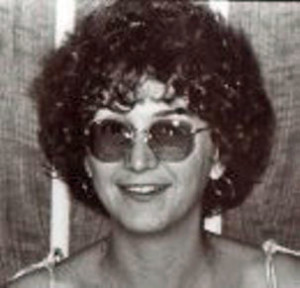
Chuck Knapp. Chuck and Charlie Bush had the morning drive spot on KSTP-AM from July 1973 to April 1976. After a time in Philadelphia, Chuck returned to the Twin Cities and did the Knapp and Donuts show with Michael J. Douglas on KS95 (KSTP-FM) from February 1979 until April 1994. From 1998 to 2007 Chuck was on KTIS-FM, and then on Bob-FM (KLCI) with Jon Engen. Chuck retired in 2013. He was inducted into the Museum of Broadcasting Hall of Fame in 2008.
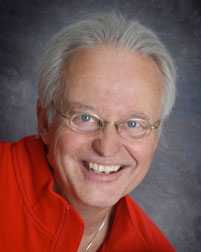
Photo courtesy Pavek Museum of Broadcasting.
Jerry Knight – KRSI (1973)
Pat Knight – KSTP (1974-75) (Also see Pat McKay)
Virgil Kohrs – KDWB (1959)
Roger Krupp – WDGY
Russ Kruse – WTCN (1954-1955)
Bill Lake (also know as Carl Lensgraf) – WYOO (1974)
Brad LaMay – KRSI-FM (1973), KFMX (1974)
“Bullet” Bob Lange – KDWB (1972 – 1979), WLOL-FM, WWTC (1988-1989), KSTP
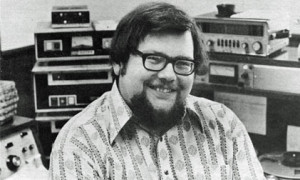
Bob Lange, 1973, KDWB. Photo courtesy RadioTapes.com
Dan Larkin – WLTE-FM 102.9 (1984 – 1985 and 1991 – 1996). Dan worked overnights the first time and then 7p-12a as the original host of “The Love Lite”
Jim Larkin began his career as a disc jockey in 1967, according to an article 10 years later. In October 1969 he was Bob Christie at KRSI; he became Music Director at KRSI in April 1971. In 1974 he became the Music Director for KQRS. In July 1977 the format at KQ changed, and Larkin left the station for a job as a record promoter. “It used to be fun, the pay was secondary. But with the new format, it became a job.” (Jon Bream, Mpls. Star, August 3, 1977)
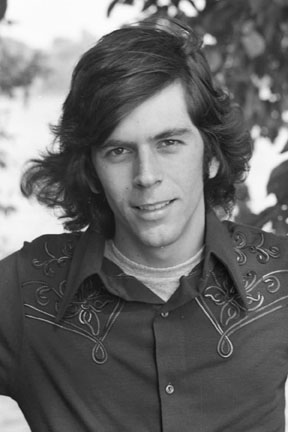
Jim Larkin at KRSI, September 17, 1972. Photo copyright Mike Barich
Joel Larson – WWTC (1970 – 1975), WCCO-FM (1975)
Daryl Laub – WLOL (1945), WMIN (1949), WTCN (1952), KSTP (1960s), KQRS (1973).
Laub passed away Friday, August 28, 2015, at the age of 90.
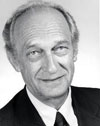
Photo courtesy Pavek Museum of Broadcasting.
David Lawrence – KDAN (1973)
Gene Leader (Gene “Mean Gene” Okerlund) – KDWB (March 27 to October 29, 1968), WDGY (December 13, 1968, to October 28, 1970). (Dates taken from listings in Star Tribune). From a 1970 ad: “Follow the leader! That’s Gene Leader, every day from 3 to 7. Keeping company with more people than a sold-out Twins game. Gene’s solid sound is excellent company going home.”
Okerlund left radio in 1970 to work at Channel 11 TV as a salesman. In an article in the Star Tribune (August 25, 1982), Mike Kaszuba described:
Okerlund happened to be walking across the studio at Channel 11 in 1971 during an employee strike just before a live professional wrestling show went on the air. Someone remembered he had some on-air experience, asked him to fill in as the announcer, and that was that.
Coached by Al DeRusha, he spent the rest of his career as a professional wrestling announcer. He was also known for his commercials, and Jeff Lonto says that he also did voice imaging on WWTC around 1980:
Voice imaging is pre-recorded soundbites saying things like “Ladies and gentlemen, you’re listening to Brad Piras on the Golden Rock, WWTC!” You can hear a couple of snippets of him starting at 1:44 in this station history.
Gene died of kidney failure on January 2, 2019, at the age of 76.
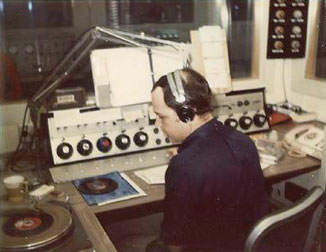
Photo from 1969 courtesy Rick Burnett’s Twin Cities Radio Airchecks. 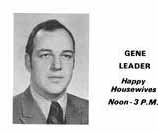
Photo from WDGY Hitlist
D.J. (Dennis John) Leary – KDWB (1962 – July 1963) “Hotline,” KRSI (January 1964 – February 1966). He moved to Duluth to manage WEBC in February 1966.
The first photo below is from the front of the March 16, 1963 KDWB Fabulous Forty Survey, Don Betzold Collection, courtesy Pavek Museum of Broadcasting. The caption: “Used in recreation rooms coast to coast, the D.J. Leary Dart Board.” He started his media career as a radio reporter and disc jockey, creating a new kind of show, “Live Line to Sports” at KDWB, where he poked fun at local sports organizations.
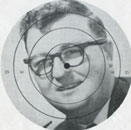
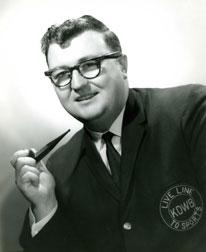
Leary died at home on August 4, 2021, at age 84, shortly after a diagnosis of pancreatic cancer.
Bruce Lee – KQRS (1968)
Gregg Lindahl – WDGY (1979)
Stuart A. Lindman – WMIN (1949-54).
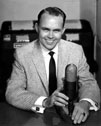
Photo courtesy Pavek Museum of Broadcasting.
Denny Long – KDAN, WMKT (1966-1967), KRSI (1967 – August 1971), WCCO (September 1971)
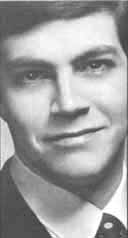
Denny Long, from the KRSI Request Album, courtesy Roger Fischer Denny Long came to WCCO as music director in 1971. In 1975, Mpls. Magazine named him as one of Minneapolis’s Sexiest. At the end of 1977 he led the station into a pop format, away from the MOR it had played for 50 years.
Johnny Long – KTCR (1964)
Verne Lotz – KEVE (1956)
Don Loughnane – WDGY (February 6, 1956 – June 1957)
In 1956, when WDGY was purchased by Todd Storz, he transferred from Storz station WTIX in New Orleans to become General Manager of WDGY. He was replaced by Jack Thayer in June 1957.
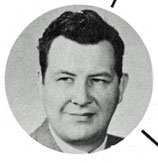
1956
Thomas Love – KUXL (1972). Photo below from a KUXL “Super Soul Thirty” from July 1, 1972, courtesy Rick Burnett’s Twin Cities Radio Airchecks.
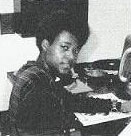
Paul “Fast Eddie” Lowell – WWTC (1971 – 1973), WLOL (1973), KSTP.
Fast Eddie was accused of making slurs against homosexuals by gay activist Jack Baker, but the FCC ruled that Baker was a public figure and denied the request for action. Eddie ended up doing janitorial work and died in 1995 at the age of 60.
Curt Lundgren, aka Evan Curfew, aka Paul Evans – KUXL (1966 – 1968 [Curfew]); WMIN (1968 [Evans]); WCCO-FM (1975 – 1983) [Lundgren]); WCCO (1983 – 1996 [Lundgren]).
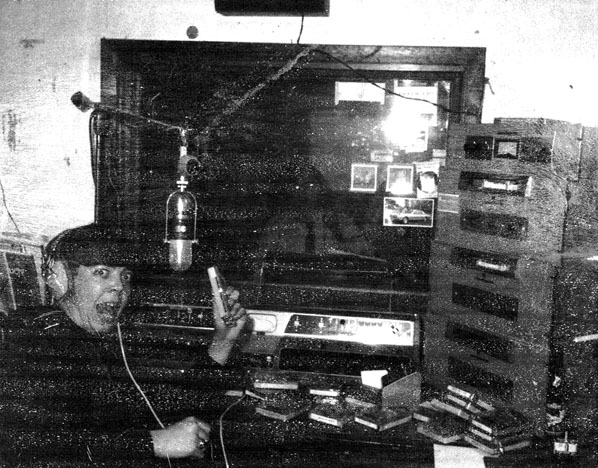
Evan Curfew, 1966 at KUXL 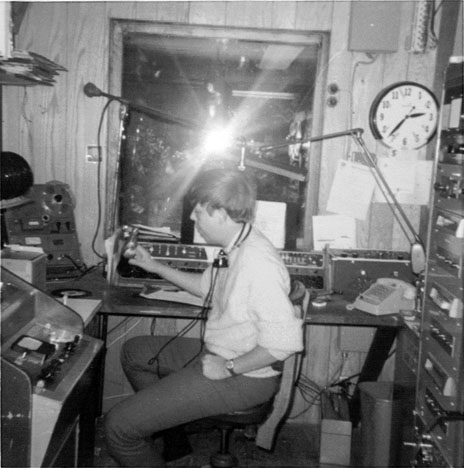
Evan Curfew, 1967/1968, KUXL 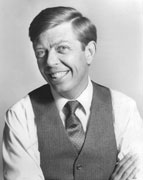
Curt Lundgren, WCCO, June 12, 1985
Mike McCormick – WDGY (1965)
Tom McCrumb – WMIN (1954)
John MacDougall – WLOL (1941 – 1947). After the next 12 years as a New York freelancer, MacDougall returned to the Twin Cities to anchor the news at KSTP-TV from December 1959 to 1971. KSTP-AM from 1979 until his death on October 13, 1993, at the age of 68.
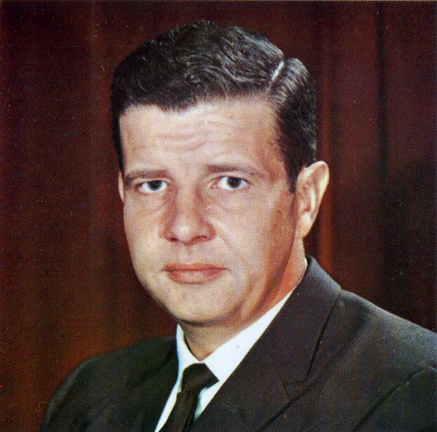
Photo courtesy Pavek Museum of Broadcasting
Joe McFarlin – KRSI (1964), WCCO (Jazz Show)
Pat McKay – U100 (1975-76) (Also see Pat Knight)
Jeff McKee – KDWB (1974 – 1976)
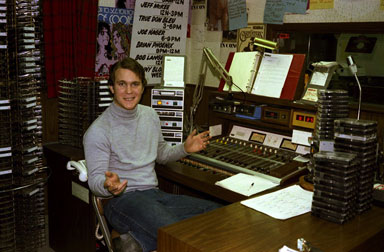
Jeff McKee, KDWB, 1976. Photo courtesy RadioTapes.com
Jack McKenna – WLOL (1965)
Barry McKinna (Siewart) – KDWB (1968 – 1973), WTCN-TV (1972 – 1983), WWTC (May 1981 – late 1981), WDGY (1981-), KS95, KOOL 108, LOVE 105
Photo below from 1973 at KDWB, courtesy RadioTapes.com
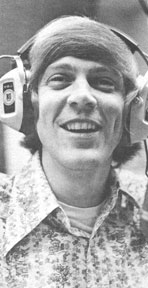
Doug MacKinnon – WYOO (1972 – 1973)
Stanley Mack – WDGY (1957 – 1961).
Storz ad: “Legitimate stager, vaudevillian, radio actor (Sam Spade series), man of a thousand voices, dialectician, singer, drummer.”
Ty Mack – WDGY (1955)
Mike Malloy – WTCN (1953 – 1954)
Allen Peter Malmberg – KFMX (1974), WYOO/U100, WCCO-AM
David Malmberg: KEEY (Program and operations director), K102, KLBB, WDGY
Stu Mann – WMIN (1953), WTCN (1954 – 1955)
Gary Marshall (Marsh Walzer): U of M WMRR and WYOO/U100 (1972 – 1976), WLOL/AM-WRRD 13 Rock
(Also known as Bo Jangles filling in on Christmas Eve and Christmas Day for different Twin Cities stations in the ’70s through the ’90s)
Dave Martin – KQRS (1975)
Donald K. Martin – KDWB (1964 – 1967), WDGY (1969 – 1977)
Donald K. was inducted into the Museum of Broadcasting Hall of Fame in 2010. He passed away on September 24, 2012. He was a swell guy. Photos below courtesy Pavek Museum of Broadcasting: 1963 at KDWB (first two), 1972 at WDGY.
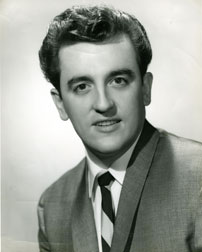
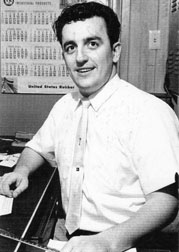
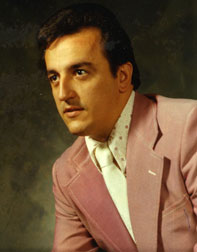
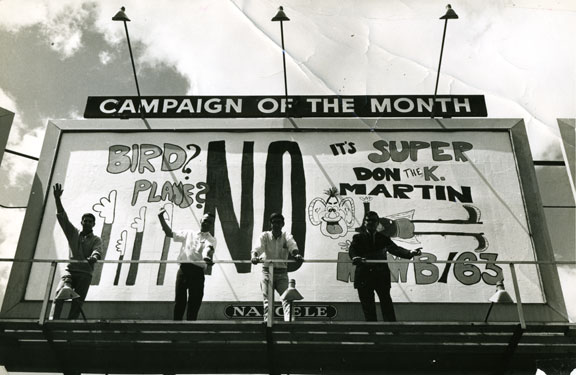
Ralph Martin – WDGY (1956 – 1957). Storz ad: “Crisp, incisive, smooth, news-voice of WDGY, commentator, community force.”
Ernie Martz – WMIN (1954 – 1956 – went into the military), WCCO, KSTP, KMSP-TV (weather and live booth announcer in 70’s and ’80s)
Jonny Matthews – KDWB (1966 to April 1969) “Go Underground with Jonny Matthews, 11 pm to 5 am.”
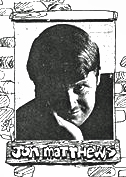
1968 “Johnny (sic) Matthews had started the underground show on KDWB, but Matthews admittedly knew nothing about underground music. [Tony] Glover contacted him, took him some records and, after a certain amount of haggling, got his first class radio license and took over the show when Matthews left the Twin Cities.” (Minneapolis Tribune, June 8, 1969) The article implies that Glover took over in April 1969.
The Insider indicated that Matthews was new to KDWB in 1968.
** Note that George Donaldson Fisher had started his Underground music show in 1967 on KQRS, before it appeared on KDWB.
Ralph Mauseth – WDGY (1955)
Peter Huntington “Hookshot” May – WDGY (1961), KDWB (1966 – 1967, 1970).
Peter also produced and managed Stillroven. After a long and varied career, Peter died at his home in Eden Prairie at the age of 80
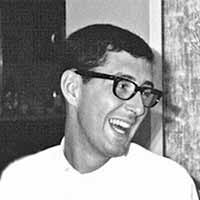
Courtesy Minneapolis Star Tribune
Doug Melges – WTCN (1955), WCOW (1955). Photo below is from a 1955 ad for WCOW.

John Messenger – KDWB, KSTP, WWTC (1982), KEEY/K102
King Michael – (Mike Waggoner) WDGY (1970 – 1972). Also see Mike Wegner
This is the legendary Mike Waggoner of the Bops, one of the first rock ‘n’ rollers in the Twin Cities! Read about his career on minniepaulmusic.com From a 1970 ad: “Hold court with King Michael every morning, midnight to 6. Serving up the sounds of today with royal taste! Mike programs with you in mind.”

Johnny Michels – WDGY (7/1956)
Ken Mills – KRSI-FM, WCCO-FM
Bob Mitchell – WISK (1957 – R&B show)
“Buffalo” Bob Montgomery – WCOW (1952), WTCN (to December 1956), WCCO (December 1956-64 as Bob White), KRSI (as Bob White), WLOL. Was known as Big Bill Cash on WCCO for five months in 1956 during the Contest Craze. Also known as Lee Thomas? In 1963 he was hired by H.L. Hut to voice Life Line, a “right-wing daily radio commentary” which aired locally on KSTP and WMIN 15 minutes/day, reported Will Jones.

Photo courtesy Pavek Museum of Broadcasting.
Chucker Morgan – WYOO (1975 – 1976). Photo courtesy RadioTapes.com
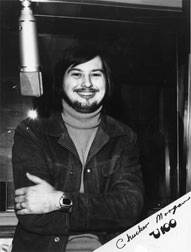
Johnny Morris (Wigren) – WLOL (1946 – April 1954), KSTP (April 1954 – 1971).
Johnny started his career in 1945 in Mankato and quickly moved to WLOL in Minneapolis. In 1954 he moved to KSTP Radio and then to KSTP-TV. Video of Johnny on KSTP-TV Here. A KSTP ad from 1965 described Johnny as the top-rated TV weatherman in the Twin Cities for more than a decade. In 1971 he moved to Albuquerque, where he anchored the news until he retired in 2000. In the early ’70s he interviewed Senator Hubert Humphrey, one Minnesotan to another. Click Here for a video that gives an overview of his career made by his Albuquerque station when he retired. Thanks to Johnny’s son Tom Wigren for the info and photos!
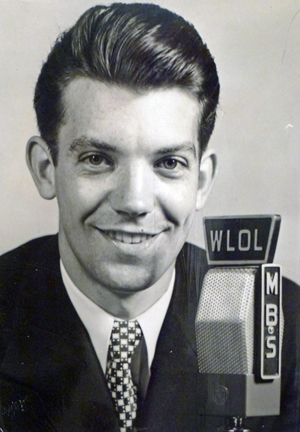
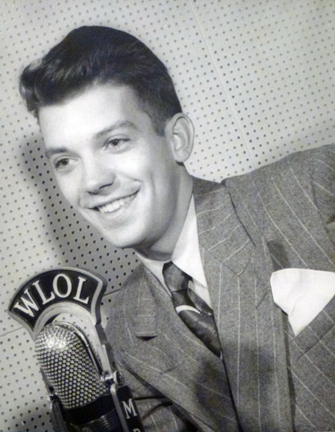
Throck Morton – WLOL
Bobby Moske – KQRS (1972 – 1973)
Ray Moss – KUXL (1966), XERB, KUXL (1968).
Ray was a bartender at a Minneapolis nightclub and met some execs from KUXL at the club. They were impressed with his “verbal fluency” (noted the November 1966 In-Beat) and vast knowledge of music and offered him a job. He was first hired to do the jazz show, but soon took over the Rhythm & Blues show. He did all his own programming. He became Music Director in March 1968.
Chuck Mulkern – WMIN (1948). Hillbilly Hits
Hal Murray – KDWB (1959 – 1963)
Hal died September 17, 1988 at age 67. First image below from KDWB Fabulous Forty Survey, October 26, 1963, Don Betzold Collection, Pavek Museum of Broadcasting. Autograph card also from Pavek.
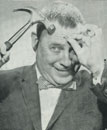

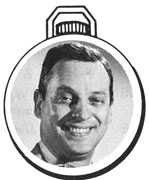
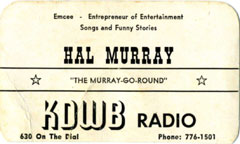
George Murphy – KRSI (August 1962 to February 1963), WLOL (August to September 1964).
There is an ad dated February 11, 1963, picturing George Murphy, Twin Cities host for KRSI’s hour-long NEWSCOPE feature every night from 6-7. He is described as “wide-eyed” in a 1964 WLOL ad. In September 1964 Murphy was renamed Dino Day and hosted “A Date With Dino” on TV, followed by “Upbeat.” See TV Shows.
Tom Murphy – WLOL (1964)
Richard Nelson – KUXL (1966 – 1968).
Known as “Admiral Richard E.” In 1964 he started a bootleg AM station in his basement in South Minneapolis. Richard went to WBAY in Green Bay in 1968…was the off-air production director at KQRS in the early 70s, and put in a few months at KYMN in Northfield around 1974. He then moved to Los Angeles and got into video production.
Phil Nolan – WDGY (1961 – 1962).
First image below is from a WDGY Twist album, 1961. Second image (WDGY, 1962) courtesy Pavek Museum of Broadcasting. Nolan passed away on September 4, 2015, from complications related to Alzheimer’s disease.
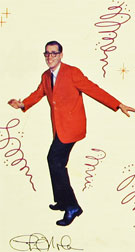
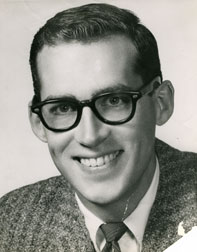
Bruce Normandin – WMIN (1959)
Randy Norris (Randolph John Norris) – KEYD (1951-1956).
Just happened to find him in the St. Louis Park phone book! Norris was born in 1920 in Minnesota and from 1951 to 1954 lived at 7516 North Street in the Park. In 1940 he was listed in the census as a musician. In 1951 he was an instructor at the Beck School of Radio. This photo, also from 1951, courtesy Randy’s sister-in-law, Mimi Hillory Vogel.
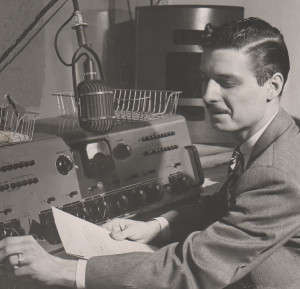
Adam North – (Edward Van Cleve, Ph.D.) KDWB (1970 – 1973), KRSI-FM (1973). Photo courtesy radiotapes.com
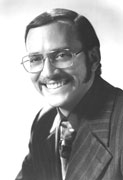
Don O’Brien – WDGY (1954-55), WCCO-TV (1964)
Ed O’Brien – KSTP-AM (1975), KDWB (1979)
Steve O’Brien – KDWB (1974)
James Francis Patrick “Professor” “Jim” O’Neill – KDWB (1961 – August 25, 1967). Image below right from KDWB Fabulous Forty Survey, March 9, 1963. Don Betzold Collection, courtesy Pavek Museum of Broadcasting. Click on the link for a tribute to O’Neill written by Senator Betzold.
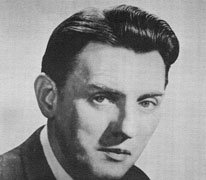
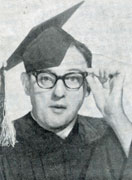
“Sweet” Michael O’Shea – WYOO (1973), WLOL (1973 – 1976), KS-95, WWTC (1988-1989)
Glen “Big Daddy” Olson – WWTC (1971 – 1975 – had worked at the station earlier as G. Edward Foshay), WLOL/WRRD (1975), WDGY, KTWN, WLTE, WCCO, KOOL 108. Glen died on July 15, 2013.
Jim Osterhaus – KQRS (1970 – 1972), WWTC (1972)
Phil Page – KDWB (1959 – 1960)
Page had the 3-6 shift in December 1959: “Color Radio as it Should Be”

Lorrin Palagi – KDWB
Tony Parker – KEYD (1954 – 1955). Eventually became the sports anchor at KMSP-TV.
John Paul – WTCN
Al Paulson (Allan C. Paulson) – WLOL (March 1947 “Night Watch”), WDGY (December 1952 – May 1953), WTCN (December 1954 – 1956), KRSI (July 1959), KSTP-TV (1962 – 1986).
Paulson was born in Minneapolis, graduating from Roosevelt High School and Brown Institute, then called Beck’s School of Radio. His career started in 1941 in Medford, Wisconsin.
Paulson died of heart failure at the age of 67 on November 26, 1989, at his home in South Minneapolis.
Steve Perrun – KDWB, U100, KSTP
Curt Perry – WDGY (1972 – 1973)
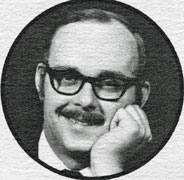
Rod Person (Rodney Russell Person) – KANO (1959), WDGY (1960 – 1961), KRSI, KSTP-TV and AM (1965-2000).
Rod was born on November 3, 1935, in Elk River and raised in Anoka. He served in the Marine Corps in Korea (1952-1954) in communications and trained with Seals in amphibious reconnaissance. He attended Brown Institute for Broadcasting, and started his professional radio career in Anoka at KANO radio in 1959. Was a DJ for WDGY when it was the #1 Rock & Roll station. He was asked to audition for the local teen dance show “Date with Dino” on Channel 9. He became a Booth Announcer at KSTP-TV Channel 5 in 1965 and worked for 35 years as a writer, producer, and staff announcer before retiring in 2000. Rod died of MS on March 12, 2016.
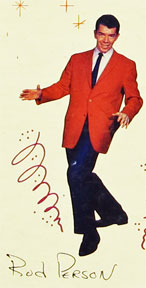
Rod twisting on the cover of a WDGY promotional album. 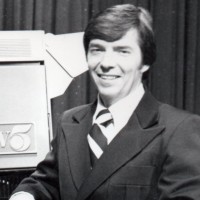
John Pete (John Peterson) – WLOL (1962 – 1965), KQRS (Program Director 1968 – 1972), KRSI-FM (1972), KQRS (1973-1974).
John came to WLOL’s Nightwatch show in June 1962 from Mankato. John died on September 13, 2020, at the age of 82, from COPD.
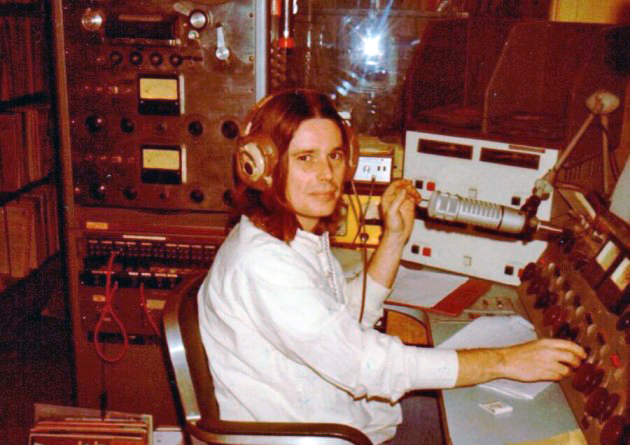
Photo courtesy John Fineberg via the Minneapolis Star Tribune, September 20, 2020 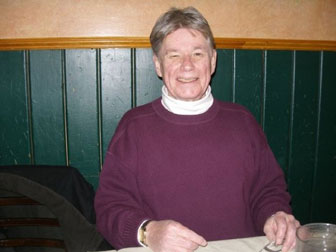
John Pete in 2009, posted by Randi Kirshbaum From Jon Bream’s obituary for John Pete in the Minneapolis Star Tribune, September 20, 2020:
Pete was born in St. Paul where he became a champion diver at Central High School. After studying at Brown Institute, he worked in Great Falls, Montana, as well as outlets in Detroit and San Diego. Between radio gigs in the late ‘70s and early ‘80s, he managed popular local bands Daisy Dillman and the Flamin’ Oh’s, whose music he’d championed on KQ.
Carl Peterson – WLOL (1958 – 1959) March 1958: Nightwatch, midnight to 6am – the “Swingin’ Swede” answers record requests via Western Union only. WDGY (1959).
Carl recorded “Rhythm Review” with the Glenrays at Gaity Records in 1959. His father was a recording artist in Sweden.
Gene Phillips – WDGY (1965)
Brian “The Cosmic” Phoenix – KDWB (1974-1976)
Brad Piras – KTWN-FM (1978-79), WWTC (1979-1981)
Dan Pothier (pronounced Poh-SHAY) – KUXL, WJSW (June 1968 – April 1969), KQRS (October 1970 – September 1973).
Dan called himself the Soul Man (before Sam & Dave’s hit of the same name) and played jazz. While at KUXL, Dan served as Recreation Director at The Way, a refuge for troubled teens on Plymouth Ave. in North Minneapolis. In 1969 he hosted the “Black Voices” program on KTCA-TV. Pothier went on to teach a course on the blues at Howard University in Washington, DC from 1973 – 1975, and from there he worked for NPR searching out and interviewing blues legends.
Jim Ramsburg – WLOL (May – July 1956 – in 1956 he was the “Commodore”), WDGY (July 1956 – June 1957 – Hosted “Night Beat” program on WDGY in 1957; left to go into the National Guard on June 15, 1957), KSTP-AM (1970 – 1972)
Jim Ramsburg owned a successful boutique ad agency and typically voiced his own commercials for clients like Holiday Station Stores and Culligan.
Ramsburg published a book Network Radio Ratings, 1932-1953: A History of Prime Time Programs Through the Ratings of Neilsen, Crossley and Hooper.
Jim was inducted in the Minnesota Broadcasters Hall of Fame in 2006. He passed away on January 18, 2021.
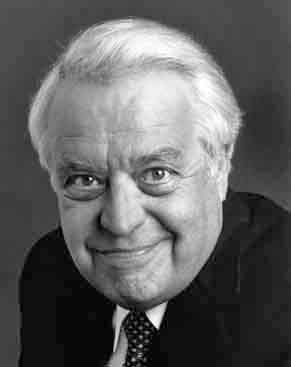
Photo courtesy Pavek Museum of Broadcasting.
Ted Randal – KDWB
Hal Raymond – WDGY (1962 – 1964).
Hal died of ALS (Lou Gehrig’s disease) August 8, 2005.
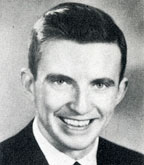
1964
Dave Reau – KEYD (@1954 – 1955). Reau was born in Minneapolis on October 30, 1922, but got his radio start playing country music in the South. At KEYD he had his own record show, “Dave Reau’s Key Room,” and “Remember Time” with Randy Norris.
Jimmy Reed – See Separate Page.
Carson Rennie – WLOL (1963 – 1965). Reportedly stood during his show.
Jack Reynolds (nee Reyelts) – KRSI
Jay Reynolds – WDGY (1965)
Ron “Killer” Richards – KDWB (1979), WYOO
“Loveable” Lou Riegert – KDWB (started September 10, 1960 – 1965), WWTC (1965).
Lou became early CNN anchor Lou Waters. Lou was inducted into the Museum of Broadcasting Hall of Fame in 2005.
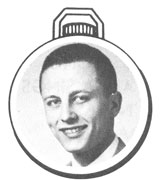
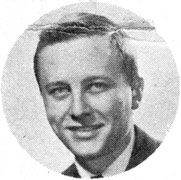
1961
Don Riley – KEYD (1949), KSTP (1954 – 1956), WLOL (Daily sports talk show). Passed away in 2016.
Ed Ripley – WDGY (1964 – 1965)
Jeff “Mother” Robbins – (Scott Wright) – WYOO (1974 – 1976) (pictured below at U100). He also used the name Shadoe Steele. Photo from Rob Sherwood’s blog.
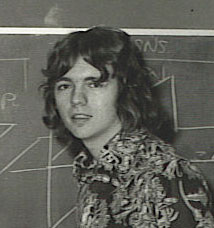
Chris Roberts (Phil Heuer – also see Lord Douglas) – KDWB (March 1971 to September 1973) Follow the link for an aircheck on radiotapes.com
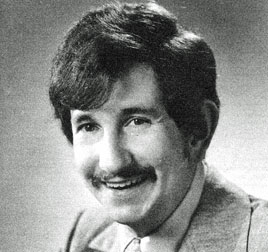
Chris Roberts in 1973, courtesy RadioTapes.com
“Ugly” Del Roberts (Darrell E. Mulroy) – KDWB (1965 – news), WWTC (September 1979 – September 1981, 1984, 1988), KLBB (1989), KDWB (1990), KJJO (1993), WWTC (2003)
Ugly Del died on March 16, 2003. Click here for an interview from RadioTapes.com
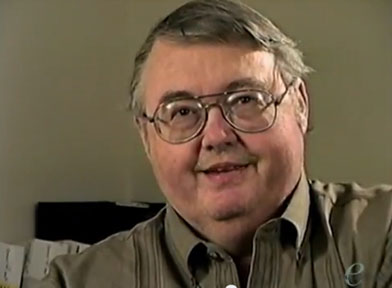
Photo courtesy RadioTapes.com 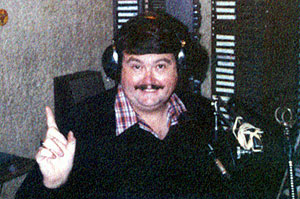
Photo courtesy Jeff Lonto
Gene Robinson – WISK (1956 – 1957)
Ronn the Rajah of R&B – See Ron Samuels
Dan Ronald – KDWB (1959)
Terry Rose – WDGY (1962 – 1964).
In May 1962, Rose rode on the roller coaster at Excelsior Amusement Park for 3 hours an 21 minutes as part of WDGY’s high school fun day. The Minneapolis Daily Herald reported, “During the course of his 70 consecutive rides Rose ate three hot dogs, lost his tie clip and seven pounds. Tired, bruised and exhausted after his 35 mile ride Rose said, ‘I don’t care if I never see another roller coaster.’”
Nancy Rosen – KQRS, WWTC
Jackson Ross – KDWB (1966 – 1968)
Scott Ross – WDGY (1972)
Bill Rudd (Oliver Rudrud) – WDGY (1954 – 1955)
Red Rush – WLOL (1959)
Russell Russ – KQRS (1973)
Mike “Records” Ryan – WWTC (1981 – 1982), WAYL, WWTC
Elton Ryberg – KSTP (1962)
Sam Sabean – see Sam Sherwood
Jerry St. James – WYOO (1975 – 1976). St. James was profiled in Mpls. Magazine in January 1976 as someone who was “going places” in 1976.
Kevin St. John – KQRS (1974)
Perry St. John – WDGY (1963 – 1967) (d. Feb. 27, 1999)
Bob Salmon – KDWB (1962 – 1963)
Ron Samuels (Ronn the Rajah of Rhythm & Blues) – KUXL (1965)
The Savage? KDWB (1974)
Harry Scarbourough – WDGY (1967), KQRS (1967) – died January 2012
Marvin Schultz – KRSI (1959)
Bob Schuman – WYOO (1972)
Bob Scott (Bob Wittnebel) – KDWA (1965), KUXL (1966)
John Sebastian – KDWB (1974 – 1978), KSTP-FM. Photo below from October 1976 issue of Little Bit Magazine, courtesy Alan Freed.
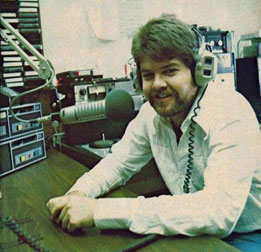
“Dynamite Dave” (Senechal), KDWB (1976). Photo courtesy RadioTapes.com. When posted on Facebook, much was made about how he was smoking at work. How soon we forget!
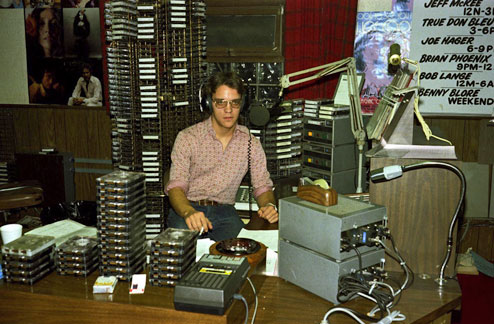
Bob Shannon (Robert J. Adams) – KDWB (1964 – 1966; 1974 -1975)
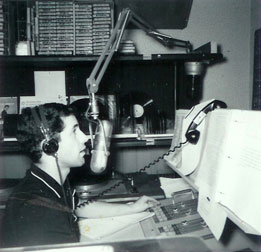
Bob Shannon at KDWB, 1964 and 1974. Photos courtesy RadioTapes.com
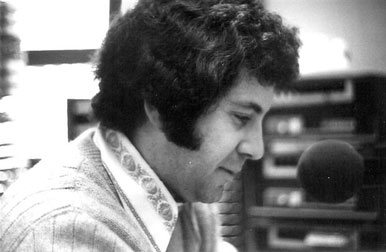
Steve Shannon – KSTP-AM (1975), WLOL-AM/WRRD (PD, 1979)
Dean Sherman (Gordon Kapitan) – WDGY (1955)
Rob Sherwood (Buff Setterquist) – WDGY (November 1967 – April 1969), KDWB (April 1969 – April 6, 1974), WYOO (April 1974 – September 1976), KSTP-AM (September 1976 – February 1978)
Photo below left from Rob’s blog. Here’s an aircheck from September 30, 1971, courtesy of Deane Johnson.
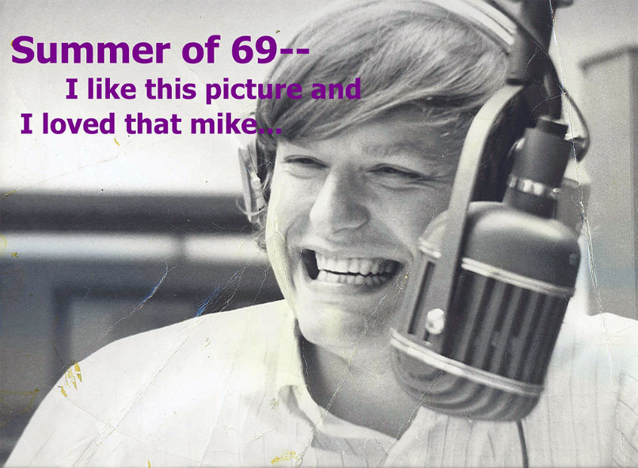

Above and below: Sherwood at KDWB, September 1971. Photo courtesy Rick McComb, who got to see him do his show! 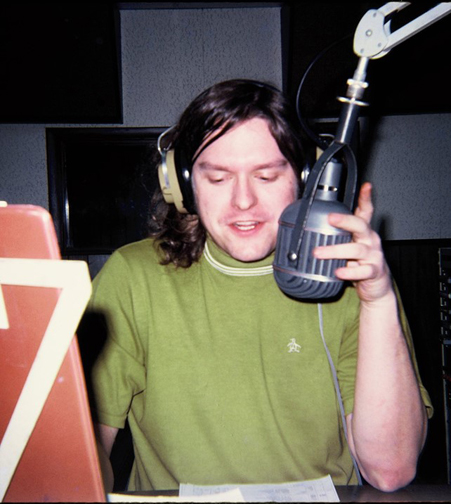
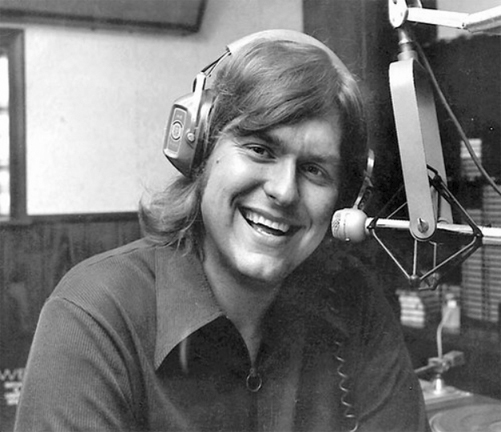
At WYOO
Sam Sherwood (Sabean) – WCOW (1953 – 1956 as Sam Sabean), WISK (1957 – 1959 as Sammy Sherwood), KDWB (1959 – 1969), WAYL-FM (1973), WWTC (1985 – 1987). Also see WCOW.
Sam Sabean started out at WCOW, working himself up from writing ads in 1953, to reading the news on Saturdays, to getting his own show in 1954. He had several monikers, including Sidesaddle Sore Sam, Milkman Sam, and Hobo Sam and his Bum Program. He actually got a call from an organization called Hobos of America, who had copyrighted the name and asked him to stop using it. Sam joined them at one of their “Boolyas” down by the railroad tracks, where he met people from all walks of life who liked to ride the boxcars. They made a deal to let him use the name if he plugged the organization.
He left WCOW and produced films for about a year, then came back when the station had changed to WISK. He had to have a different name, so he selected Sherwood. At KDWB he was a disc jockey from 1959 – 1962, Program Director from 1962 – 1964, and General Manager/Vice President from 1964-69. When KDWB was sold, Sherwood joined Entertainment Communications and pioneered the beautiful music format with WAYL FM, where he spent ten years as general manager. Sam was inducted into the Museum of Broadcasting Hall of Fame in 2005.

Photo from 1955 ad for WCOW 
Photo from KDWB Top 40 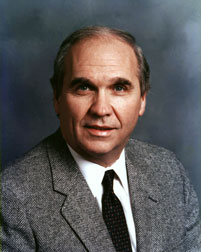
Photo courtesy Pavek Museum of Broadcasting
Verne Sheppard – KEVE (1956)
Barry Siewert – see Barry McKinna
Sandy Singer – WTCN (1956 – 1957), WDGY (August 1, -), WLOL (1958 – 1968).
At WTCN Singer introduced records with piano chords; if the record didn’t play at the right speed there was… dischord.
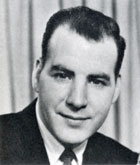
1964
Mike Sirlan – WISK (1956)
Irv Smith – WDGY (1954 – 1955)
Jere Smith – WMIN (1958), KMSP-TV (host of “Record Hop,” @1957 – 1959, weather 1959 – 1975)
Jimmy Smith – KUXL (1972).

Photo from a KUXL “Super Soul Thirty” from July 1, 1972, courtesy Rick Burnett’s Twin Cities Radio Airchecks.
Len Smith – WDGY (1972), KRSI (1973)
Ralf Smith – WCOW (1952), WMIN (1954 – 1958; his show on WMIN was Ralf and His Records)
Art Snow – WYOO (1974). Photo courtesy RadioTapes.com
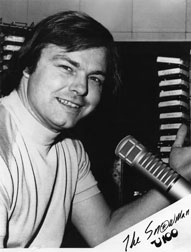
Paul Sohmson – WDGY (1961)
Daddy Soul – See Jack Harris
Paul Stagg (Steigerwald) – WWTC (1969), WCCO Radio and TV (18 years as an announcer, music director, and program director), KLBB (until 2007)
Paul Stagg was inducted into the Minnesota Broadcasting Hall of Fame in 2017.
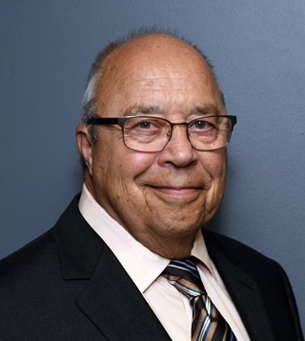
Photo courtesy Pavek Museum of Broadcasting
U.S. (Ugly Steve) Steele (Steve Gibbons) – WYOO (1976). Photo courtesy RadioTapes.com
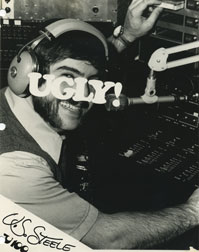
Gary Stephens – KDWB
Gregg Stevens – WLOL (1973-74), WYOO (1974), WDGY (1975-1979)
Scott Stevens – KDWB, WWTC
Jim Stokes – KRSI
Jeanne Stolz – WISK (1956)
Alan Stone (Shel Danielson) – KQRS (1968 – 1980), Cities 97/KTCJ (1985 – 1996).
Between 2002 and 2006, Alan was a volunteer reader for the Radio Talking Book Network, recording news and audio books in his wonderful mellow radio voice!
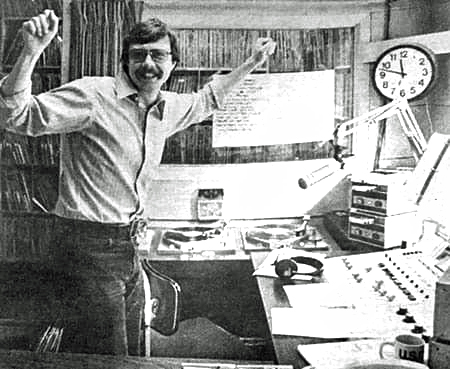
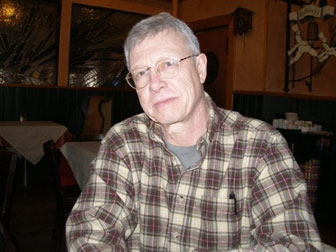
Alan/Shel in 2009, posted by Randi Kirshbaum
David Stone – KSTP (1954-1962). Stone hosted the Sunset Valley Barn Dance
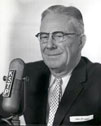
Photo courtesy Pavek Museum of Broadcasting
Texas Bill Strength – KEYD (November 26, 1955 – June 1956), KEVE (June 1956 – January 1957 and April 1957 – March 31, 1958), KTCR (April 2, 1962 – July 1965), WMIN (August 1965 – February 7, 1966, and March 1967 – March 1968).
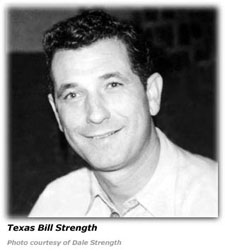
Capp Sutherland – WCOW (1954 – 1956). Image below from a 1955 ad for WCOW.

Chuck Swenson – WMIN (1959)
Johnny T. Talley – KEYD (1956), KEVE (1956)
Gene Taylor – WCOW (1953-1956). Photo below from WCOW ad 1955.

Henry J. Taylor – KSTP (1955)
Tedesco Brothers – See Radio Stations, WCOW
Jim Teeson – WWTC (1971 – 1975), WCCO-FM (1975)
David Teller – WWTC (1971-1973)
Jerry Telser – WLOL (1959 – 1964)
Terry Tersari – KRSI (1967)
Jack Thayer – WLOL (1943 – August 1952), WTCN (August 17, 1952 – January 1956), WDGY (February 6, 1956 – December 24, 1958).
Dave Thomson – KDWB (1976 – 1977)
John Tollefson – KQRS (1968)
Rod Trongard – WLOL (1959-1968), KSTP (1968-1982). Sportscaster Rod Trongard was inducted into the Broadcasting Hall of Fame in 2003. He died in 2005.
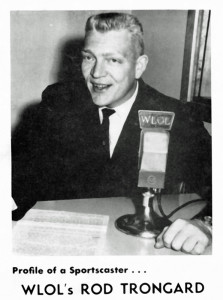
Photo courtesy Pavek Museum of Broadcasting.
Earl L. Trout III – KDWB (1967 – 1968)
Jerry Urdahl – KEVE (1959)
Jimmy Valentine – WDGY (1938), KSTP (1941 – 1948). Jimmy was also a pioneer on KSTP TV from 1948 to 1986. Jimmy was inducted into the Museum of Broadcasting Hall of Fame in 2002.
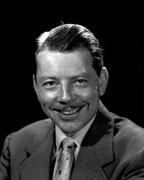
Jimmy Valentine retired in 1986, and passed away December 2, 2002, at the age of 83.
“Cheerful Charlie” Van Dyke – WDGY (1970 – 1973)
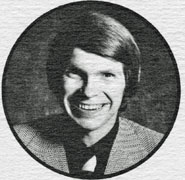
Fred Van’t Hull – KEYD (1955).
From 1962 to 1986 Fred and his wife Muriel ran the Van’t Hull (Old Time) Liquor Store at 7835 Wayzata Blvd. in St. Louis Park.
Ray Vecellio – KRSI (1966 – 1970), WCCO (1970 – 1997). Inducted into the Museum of Broadcasting Hall of Fame in 2011.
Ray: “The photo [below] was, indeed, taken at KRSI. Actually it was taken in the recording studio as I was producing commercials. I was the morning drivetime announcer at KRSI including the period when the station’s format was Request Radio.”
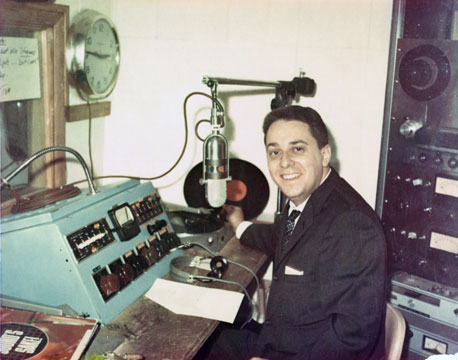
Photo courtesy Pavek Museum of Broadcasting
Howard Viken – KEYD (1949), WCCO (1950 – October 12, 1989), KLBB (1989 – 1994).
Viken was inducted into the Museum of Broadcasting Hall of Fame in 2004.
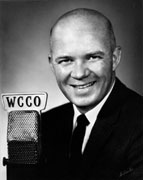
Joe Vogel – KQRS (1974)
Lee Vogel – Did the WDGY Nightbeat show until October 26, 1963. Moved to KSTP on November 4, 1963.
Jay Walker – KDWB (1974)
Wally Walker – KQRS (1979 – 2020)
Ron Wandmacher – KEVE (March 30, 1959 to October 8, 1962); WLOL (May 16, 1965 to March 1970); KTCR. (Dates taken from published reports in Star Tribune; not guaranteed to be accurate.)
Ron was often listed as Rod at KEVE. He was a graduate of Brown Institute. In the mid sixties he hosted a call-in show on WLOL, discussing controversial topics. Ron died on May 21, 2016.

Photo courtesy Minneapolis Star Tribune, May 29, 2016
Albert Vant “Flash” Washington – WLOL (1940s) See a photo of Washington taken by John Glanton under Kenneth Wilson, below.
Fat Daddy Washington (Art Hoehn) – KUXL (1964 – 1966), XERB (1966), MPR.
In 1966, Hoehn traveled from Minneapolis with his fellow KUXL staffers Bob Smith (a.k.a. Wolfman Jack) and Ralph Hull (Preacher Paul Anthony and the Nazz) to Baja California, to take over XERB: The Mighty 1090, a “border blaster” station. There, he played the Wolfman’s sidekick “Fat Daddy Washington.” A year later, Hoehn returned to his alma mater to join Kling in operating what became MPR’s flagship station. Hoehn was inducted into the Museum of Broadcasting Hall of Fame in 2010. He died in 2011.
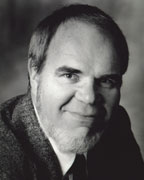
Photo courtesy Pavek Museum of Broadcasting 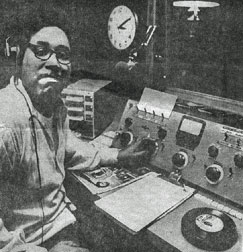
Photo courtesy Twin Cities Radio Airchecks.
Art Way – KDWB (1961 – 1963).
Image below from 1962 KDWB Fabulous Forty Survey, November 1962. Don Betzold Collection, courtesy Pavek Museum of Broadcasting
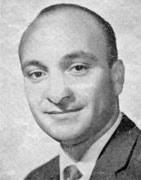
Bobby Wayne – KDWB (January 1966-)
An article from the December 1966 Inbeat says that he has eight telephones when he broadcasts, answered by Secretary Melody Galore. She is supposedly a real person, but Wayne had other characters, such as Louis K. Lush, the hungover engineer, Katie Kute, the go-go girl, and Sleepy O’Dell, the weather girl. Bobby died in 1993. Image from Don Betzhold Collection, courtesy Pavek Museum of Broadcasting.
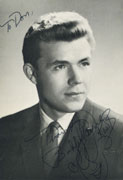
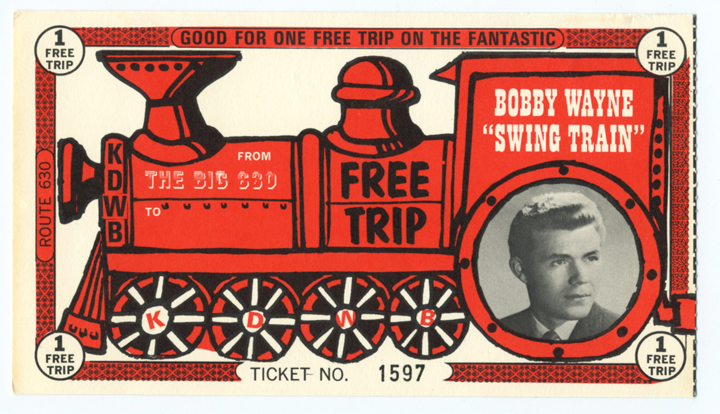
Vern Weegman – KEYD (1956), KEVE (1956 – 1958), KTCR (1962 – PD)
Mike Wegner (Mike Waggoner of the Bops!) KDWB (1973)
Warren Weikle – KRSI (1959)
Johnny West (John Dotas) – WMIN (1963 – December 1966) Dotas was working under his own name when new management came along and gave staff new western names over the weekend. (Minneapolis Star, June 5, 1963)
Bob White (nee Montgomery)
SEV WIDMAN
Sev Widman – WMIN (early 1940s – 1945), KSTP (July 1945 – November 1947), WMIN (December 1947 – February 1, 1949), WDGY (February 1, 1949 – September 12, 1952), WTCN (September 27, 1952 – January 1960 – Program director 1956 to January 1960), KEVE (June 1960 – August 1960. In November 1960 he was identified as KEVE’s Sales Manager).
Excerpted from Steve Iverson and Julian West’s site Minnesota Kid Vid:
In the early 1940s, Sev Widman (Severance J. Widman, Jr. 1922-1981) launched “Studio Party Wham,” a midnight program on WMIN Radio with his friend Leigh Kamman. The show featured big band and jazz music, broadcast from a club called Mitch’s, where the audience was quizzed and awarded free dinners. He left WMIN in 1945. In August 1946 he was hosting “Lets Turn The Tables,” a midnight radio show on KSTP. In December 1947 Widman left KSTP radio “in a huff,” following an interview with actress Virginia Mayo. She was in town promoting “The Secret Life of Walter Mitty,” and ended up in tears after the interview. Apparently the “KSTP switchboard lit up like a yule tree,” with complaints from listeners. He moved back to WMIN. In January 1949 Widman, described as an “irrascable disc jockey,” was fired from WMIN for munching popcorn on the air. He then moved to WDGY radio.
It was apparent that something was going on, since entertainment columnist Will Jones always referred to Widman in lower case letters…
There was record called the “Sev Widman Polka” by Harold Picha and His Band, which indicates his popularity! Here’s a photo of it, courtesy Greg Carr, former DJ of “Dig Up the Roots” on KFAI. The label says it was “Made in Hollywood for Non-Commercial Use.” Greg has donated this fine instrumental 78 to the Pavek Museum of Broadcasting! Thanks, Greg!
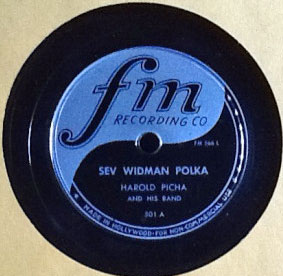
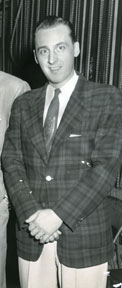
Sev in 1952 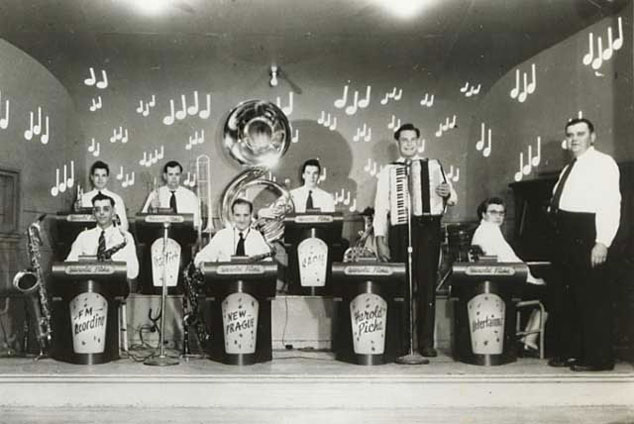
Harold Picha and His Band, 1950, courtesy Minnesota Historical Society. Front L to R: Emil Tuma, Tommy Thomas, Allen Ista, Mayme Borak, Harold Picha. Back L to R: Germanus Kipp, Herb Dallmann, Richard (Dick) Rosenthal.
After serving in the Merchant Marine during WW II, Widman started his radio career in Winona, Minnesota. In 1960, Widman won a seat on the New Brighton City Council. In 1969 he became a partner in polka station WJSW in Maplewood. Widman died on May 14, 1981, in St. Petersburg, Florida, where he had “worked in fundraising for many years.”
Bill Wigginton – WPBC (June 2, 1958)
Gary Wilcox – WYOO (1973)
Kenneth Wilson – WLOL (1940s) The photo below shows Wilson (standing) broadcasting in the 1940s with Albert Vant “Flash” Washington.
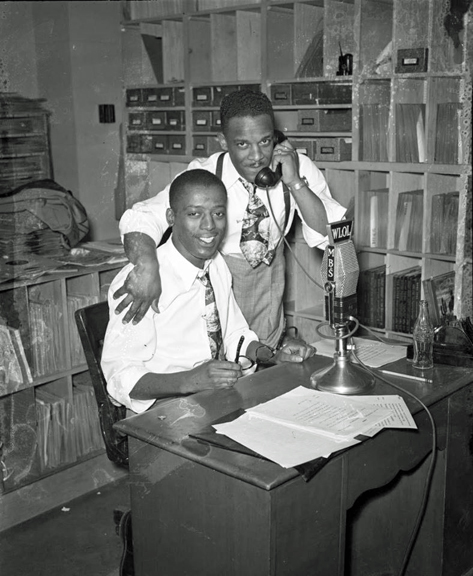
Photo by John Glanton courtesy Hennepin County Library
Jim Wise – KSTP (1970)
Henry Wolf – KSTP (1970)
Tom Wynn – WLOL (1957 – 1958), WDGY (1958 – 1961), KRSI (1962 – 1964), WWTC (1964 – 1965), WLOL (1967 and 1972 – 1976). He spent almost 40 years doing mornings at KFGO in Fargo. He retired about three years before he died in April 2021 at the age of 83. WLOL-A/WRRD-A, WDGY-A, KRSI-A, and WWTC-A.
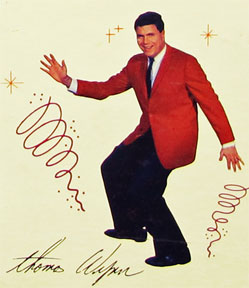
Tom twisting on the cover of a WDGY promotional album. I wonder if this twisting thing was fun or embarassing for these WeeGee DJs?

Tom Wynn, 2021
George Young (John Dotas) – WDGY (1967 – 1973). Radio name was in homage to WDGY station founder, optometrist Dr. George Young. From a 1970 ad:
The man with a smile! That’s George Young. Keeping the afternoon pace light and lively everyday from noon to 3. Call George’s Phon-A-Song Line, 827-9955, to hear and win your favorite song. George keeps women Young!
Also see Johnny West.
Jimmy Young – KSTP (1954 – 1955)
John Young – WISK (1959), KDWB (1959)
Lee Zanin – WWTC (1969, sales; 1972 – 1977, General Manager). Voted one of Minneapolis’s Sexiest in 1975 by Mpls. Magazine.
Harry Zimmerman – KEYD (1948 – 1949), WTCN (1954 – February 1956), KSTP (February 6, 1956 – 1959)
Harry took over Herb Oscar Anderson’s show when HOA moved from KSTP to WDGY in 1956. Zimmerman was also the host of “Hi-Five Time” on KSTP-TV from 1958 – 1959.
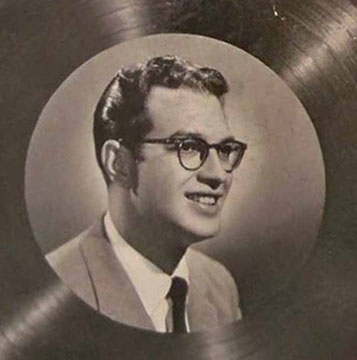
JOE ZINGALE
Joe Zingale – “Mr. Rhythm” – WCOW (1955 – 1956), WISK (1956 – 1958). Joseph T. Zingale came from Cleveland and started selling time at WCOW in about 1954.
He came to the Tedescos with an idea to do a rhythm and blues show, and although he had never been on the air before, he went for it in about March 1955 and the show was an enormous hit.
Since everyone on WCOW had a Western nickname, Joe was originally billed as Jolly Joe Zingale when he was first listed on the radio log on April 29, 1955. He was apparently either very popular or very overworked – we see him three times a day, sometimes at long stretches at a time when shows then were often only 15 minutes.
The station became WISK starting on May 15, 1956, according to the radio logs, and Zingale remained on the air until October 9, 1958. Both WCOW and WISK signed off at 8:00 PM.
Zingale was also Augie Garcia’s manager and arranged for Augie to open for Elvis when he came to town in May 1956. Joe then took it a step further and booked the St. Paul Auditorium for a Rhythm & Blues show with great locals such as Augie Garcia.
In 1956 or ’57 (must have been 1958 since he was here until that October) Zingale went to station WHK in Cleveland, where he and other salesmen Norman Wayne and Bob Weiss pooled their commissions, unheard of at the time. They decided to buy a radio station in White Plains, New York but after a year their wives missed Cleveland. They found out that a station in Cleveland – WIXY 1260 – was for sale, so they returned to Cleveland and made it into a powerhouse rock ‘n’ roll station.
When the list of venues for the 1964 Beatles tour did not include Cleveland, the station sent Joe to New York to negotiate with Brian Epstein. Epstein needed a commitment from a venue and a guarantee of $50,000. Back at the station a telegram was crafted with the name of the owner of the Music Hall – without the owner’s knowledge. Then Norman Wayne went to the owner of Metromedia in New York – the owner of the station – to get the $50,000. They made money, although the Music Hall only had the capacity of 10,000. In 1966 the Beatles returned to Cleveland and sold out 25,000 seats.
Norman Wayne, Zingale’s associate for many years, says that the decision to play Top 40 was one of business, not musical taste.
When WIXY was sold, Weiss and Wayne moved on and Joe pursued his interest in tennis, eventually owning part of the Cleveland Nets World Tennis Team. He also had stakes in the Cleveland Indians and Cleveland Cavaliers basketball team. Joe died on March 14, 2014.
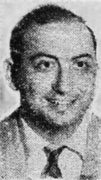
Photo from a 1955 newspaper ad for WCOW 
Texas Bill Strength: Minneapolis
November 1955
KEYD
In his column on November 22, 1955, Cedric Adams announced:
Radio Station KEYD will change its policy greatly starting this Saturday [November 26]. The station will move into complete programming of nothing but western and country music. Two of its regular disc jockeys have been dismissed and will be replaced by imports, Texas Bill Strength and Johnny T from Tennessee.
The all-country idea was that of Robert M. “Bob” Purcell and Nashville promoter A.V. Bamford. It was the first station in the Upper Midwest to be dedicated to country music on a full-time basis.
(Minneapolis Star)
TBS’s arrival was also announced in an ad entitled “On the Route with ‘Sunny Jim’ the Golden Guernsey Kid.” Sunny Jim (apparently a baby milkman) mentions the Sonny James show, KEYD’s new manager, Mac Lester, and KEYD’s new disk jockeys.
Starting Saturday all day long the disc jockeys are going to spin the cowboy and country records – and they got two famous cowboy singers coming to work at KEYD. One’s “Texas” Bill Strength, whose two current Capitol Record hits are “The Yellow Rose of Texas” and “Cry, Cry, Cry.” The other one’s the famous Johnny “T” From Tennessee, whose recordings are real popular. They’ll be at the Auditorium, too, along with our own favorite Slim Jim. Then all of the Grand Ole Opry people, “Texas” Bill, Johnny “T” and Slim Jim will have an all day long festival on KEYD Saturday. KEYD’s new slogan is “The Country-Western Station at the Top of the Nation.” Better turn your ear to 1440 on your radio Saturday and hear the fun.
(Minneapolis Tribune, November 22, 1955)
Sonny James, the tall folk-singer guitarist, has joined a troupe of country and folk artists to decorate the stage of Minneapolis auditorium Friday [November 25, 1955] at 8 pm. The Grand Ole Opry show will also feature:
- Ernest Tubb
- The Wilburn Brothers
- Mitchell Torok
- Wanda Jackson
- Arlie Duff
- Ray Price
- Al Terry
- Texas Bill Strength
- Rusty Gabbard
- Billy Byrd
- The Texas Troubadors
Reported by Bob Murphy in the Minneapolis Star, November 20, 1955.

Minneapolis Star, November 25, 1955

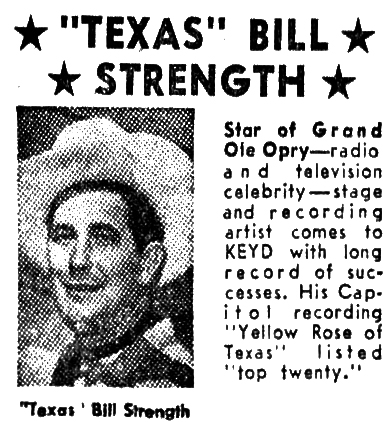
Minneapolis Star, November 25, 1955
On November 28, [26] TBS begins his duties at the turntables at KEYD, Minneapolis, where he’ll also do a daily TV show. He asks all record companies to send releases to him at KEYD, Foshay Tower, Minneapolis, effective immediately. Dick Stuart took over the afternoon shift at KWEM in West Memphis. (Billboard, November 26, 1955)
Although Strength had never performed in the area (he called it “Paul Bunyan Country”), he knew that there was an audience for Country music. Ever the entrepreneur, he set his sights on not only becoming a DJ, but opening a club (as he had done with the Silver Slipper in Atlanta) and a record store.
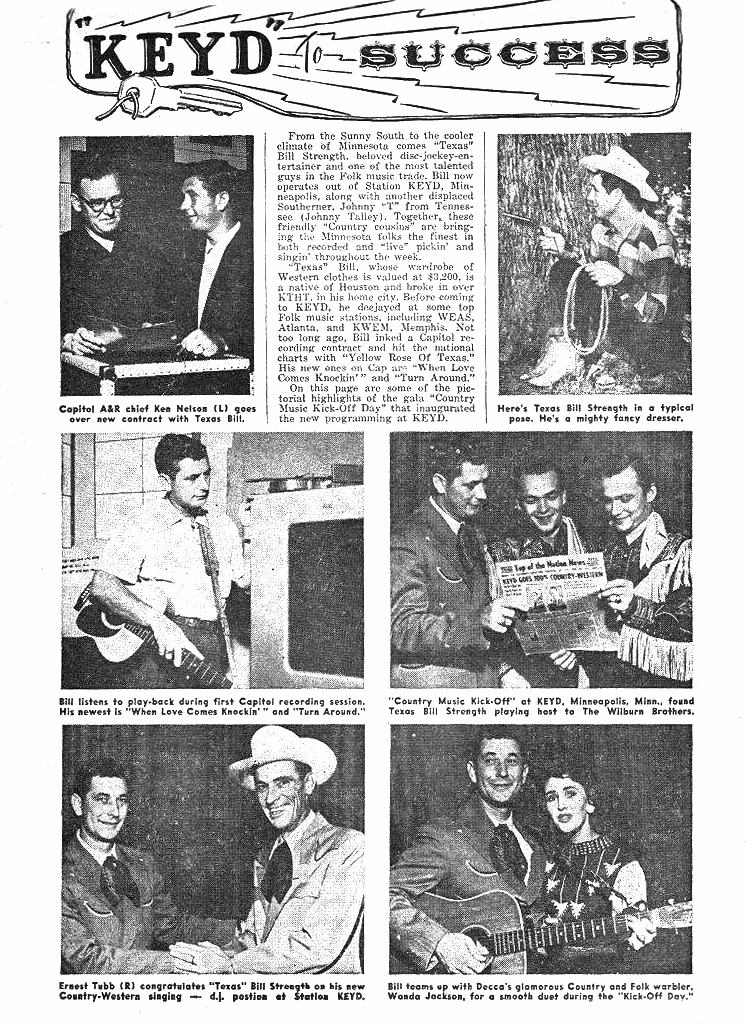
December 1955
The ad below for KEYD announced, “Now All Day – Country Western Music” and announced DJs “Texas” Bill Strength and Johnny “T” from Tennessee, and Slim Jim Iverson.
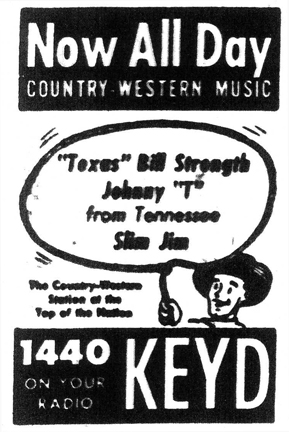
Minneapolis Tribune, December 1, 1955
Billed as Family Broadcasting, KEYD first signed on in 1948. From 1953 – 1955, announcers included Howard Viken, Don Riley, Harry Zimmerman, Slim Jim Iverson, and Slim Jim’s brother the Vagabond Kid. Those last three had a show called “Record Rodeo.” The format included several types of shows, including country, Top 10, Gospel, and others.
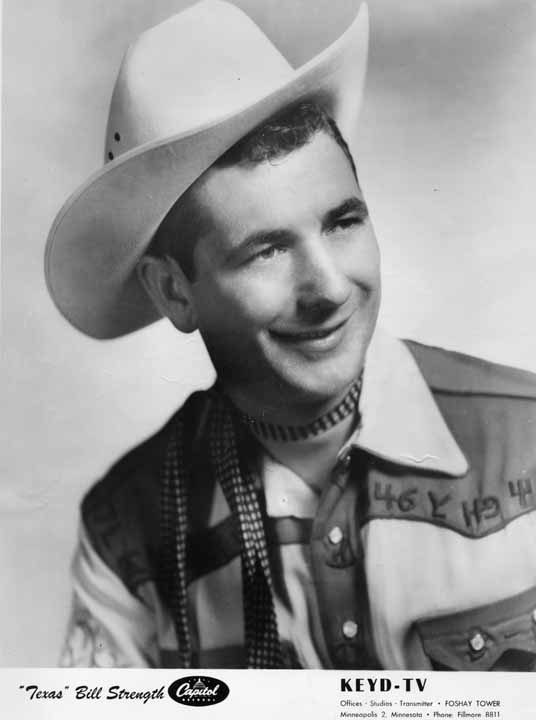
Photos courtesy Dale Strength

Bill’s personal appearances began right away.
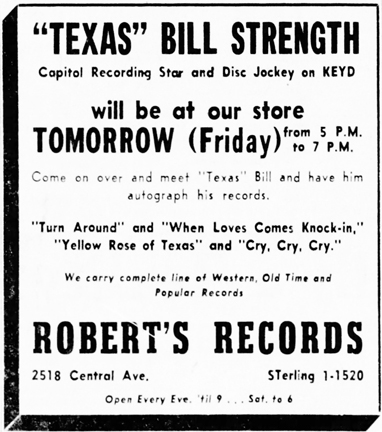
Minneapolis Star, December 22, 1955
On December 31, 1955, A.V. Bamford produced a “Grand Ole Opry” package at the St. Paul and Minneapolis auditoriums. Faron Young will resume activity, following his lengthy illness. Others on the bill were:
- The Wilburn Brothers
- Porter Waggoner
- Marvin Rainwater
- Jim Edwards and Maxine Brown
- Texas Bill Strength, emsee
- Johnnie Talley
- Bobby Lord
- The Wagon Masters Trio
(Billboard, December 24, 1955)
TBS is listed as one of many C&W DJs who double as Wax Artists. His label is Capitol and his station KEYD, Minneapolis. The most successful C&W deejay operating in the personal management field, of course, is Bob Neal, WMPS, Memphis, who manages Elvis Presley.
(Bilboard, December 31, 1955)
ROUNDUP more MONEY with TBS
An undated but undoubtedly early publication was a promotional brochure put out by KEYD to sell TBS to potential advertising sponsors. It has great photos which we’ll try to do justice to here.
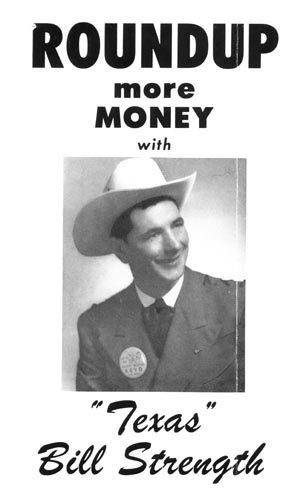
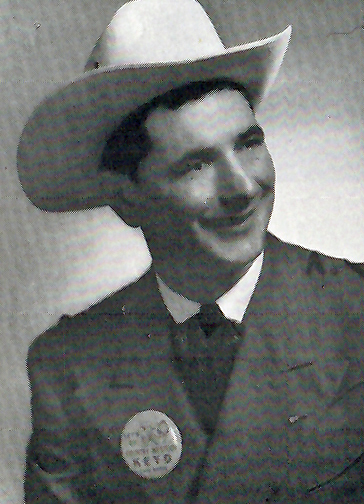
Closeup of the photo above. 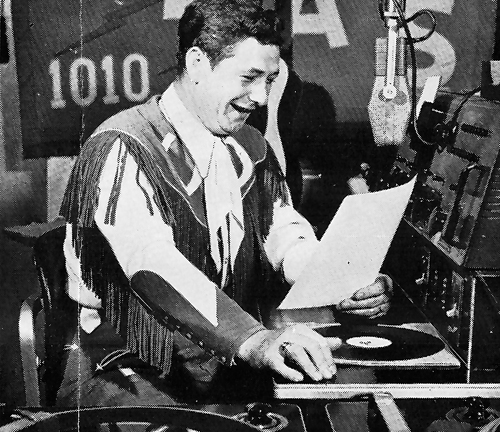
This photo was apparently taken at WEAS in Atlanta. 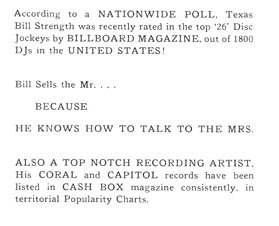
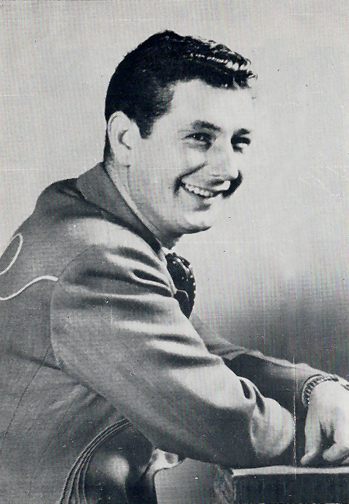
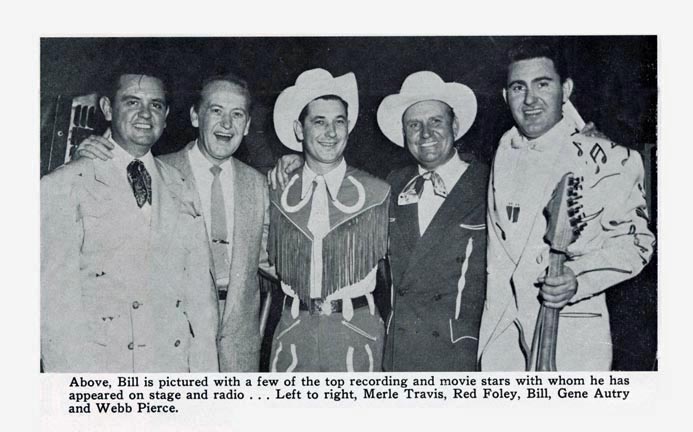
Bill (center) is pictured with Merle Travis, Red Foley, Gene Autrey, and Web Pierce. Photo courtesy Dale Strength 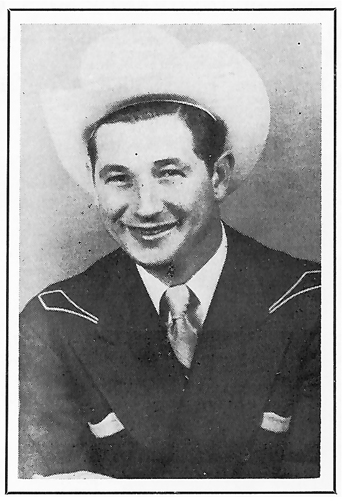
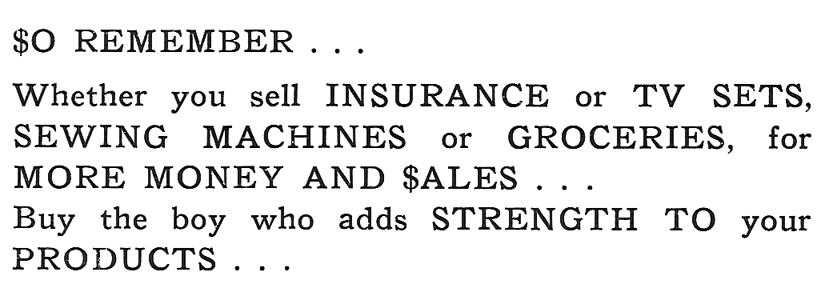
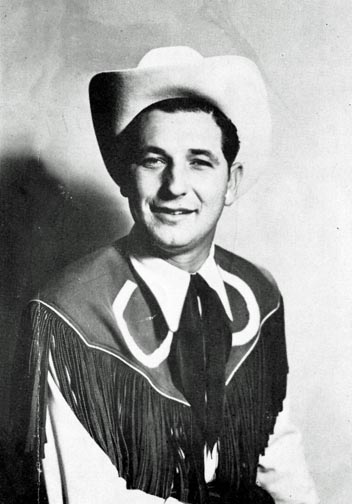

1956
In the 1956 Minneapolis phone book, TBS was listed as living at 902 Second Ave. So., identified in permit records as the Holland Hotel. The Hotel was demolished in August 1959. It is now the site of the Oracle office towers, 900 2nd Ave. So., built in 1984.
January 1956
Jimmy and Ardis Wells and Their Dakota Round-Up, along with the Royal Rangers, are holding forth nightly at the Flame Supper Club, Minneapolis. Appearing with them each Wednesday night is TBS, who now spins the country wax on KEYD, Minneapolis. (Billboard, January 21, 1956)
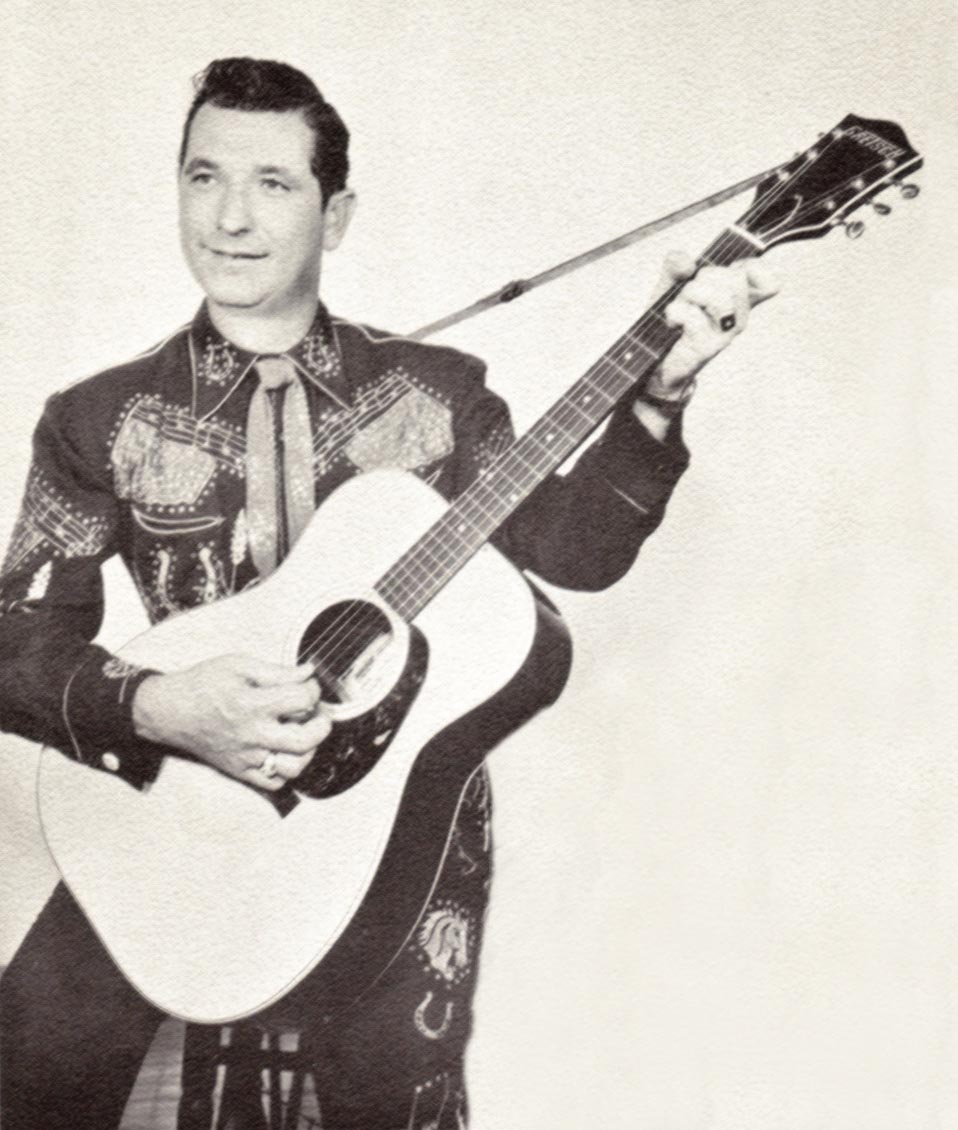
Undated photo, courtesy Dale Strength On January 29, 1956, TBS guested on “Grand Ole Opry” with Faron Young. (Billboard, February 11, 1956.)
He also appeared on the “Ernest Tubb Jamboree” over WSM, Nashville. (Billboard, February 11, 1956.)
WILL JONES
A wealth of information was provided through the years in the daily “After Last Night” column by Will Jones in the Minneapolis Tribune. On January 29, 1956, Jones wrote about the arrival of TBS and Johnny T in this fanciful article:
“Transcribbled” Music Makes KEYD Hillbilly Dream Land
One of my favorite outdoor sports, when driving in places like Tennessee and Oklahoma, is to turn on the car radio and listen to the local radio stations.
Thanks to KEYD radio’s new staff of imported hillbillies, the long drive is no longer necessary. It’s almost as good as a winter vacation to drive through the Twin Cities’ slush with the car radio tuned to 1440.
Practically any time of day you can pick up the whining git-tars, the insistent beat, the mush-mouthed announcer that go with an all-out hillbilly station.
A man named Texas Bill Strength (pronounced strenth) plays and exclaims over the national anthem (“The Yellow Rose of Texas”). A man named Johnny T from Tennessee carries on endlessly over the delights of corn bread & pot likker, soppin’ gravy & biskits.
“I don’t say y’all don’t have gewid kewiks up north here,” says Johnny T the other day. “Lots of southern ladies have moved up north.”
These new citizens of the Twin Cities are learning their way around fast. Their first week on the air, they complained about frozen ears.
A batch of assorted earmuffs promptly came in the mail.
Other staff members at KEYD – old-timers – looked on enviously and reported: “These guys weren’t on the air two days before listeners started sending them big, beautifully-decorated cakes.”
Texas Bill plays a record for Mrs. Harry B. out in Balloominton” and then asks: “Whar’s Balloominton?” He has a sponsor whose address is 1201 Hormone place.
Texas Bill is also a philosopher, reciting lines like: “Blessed are they that walk around in circles, for they shall become Big Wheels.”
The world Texas Bill and Johnny T dwell in is filled with titles like “You Clobbered Me,” “Ink Dries Quicker Than Tears,” and “Lie Detector,” and tenderly sentimental lines like, “Take your cotton-pickin’ hands off my girl.”
It is a world populated largely by broken-hearted lovers and cheatin’ husbands and wives. It is also a world of gang love, with three girls pining in harmony for three lovers – I think I’ve got the names straight – Jack, Johnny and Jonas.
These tunes are neither recorded nor transcribed. In the words of Johnny T, they are “reseeded and transcribbled.”
The man who brought all this salt port and greens to the Twin Cities is Robert Purcell, a towering, dignified, gray crewcut Madison Avenue type by way of Hollywood.
He’s never run a hillbilly station in his life, and, except for playing an expensive guitar as a hobby, knew nothing about the music until a few weeks ago. His label for it – the music trade label – is country-and-western, frequently abbreviated these days to C. & W.
Purcell was brought here last year to inject new life into KEYD.
“For a while we considered going top-10-tunes kind of operation,” said Purcell, and competing with the stations that are already doing that. We already had a little top-10, plus a little classical, and a little semi-classical, and a little religion, and a little bit of everything. A friend of mine came to town, a man who books country-western shows like Grand Ole Opry for auditoriums. He takes these shows all over the country. He told me this was his second-best territory. Denver, I believe, was first. If it was such good territory for him, I reasoned that a country-western station should do well too. To do it right, we brought in a couple of top country-western personalities. Getting Texas Bill and Johnny T to play country-western is about on a par with getting Frankie Laine and Rosemary Clooney as disk jockeys for the top-10 market.
“So far it’s been very successful, and we’ve found out something else: this kind of programming is more compatible with religious programming. Or at least, the people who listen to one kind of program are less offended by the other.”
February 1956
THE FLAME
As noted above, the first mention of TBS at the Flame appears to be January 21, 1956, in Billboard. Here at home, on February 1, 1956, columnist Cedric Adams wrote:
Western music has spread out a good deal in the last few years and now it takes over a Minneapolis theater café. The Flame at Sixteenth and Nicollet experimented with a western band for a couple of nights and found the customers liked it, so now makes it regular policy. Johnny T and the Tennesseans, one of the top country and western bands, moves into the place tonight and square dancing and other hoppity steps are the rule. The Flame goes whole hog on the theme, using the Dakota Roundup troupe in the lounge, with special Wednesday night appearances by Texas Bill Strength, the hillbilly singer. Any square dance group, incidentally, can bring its own caller along, so you may hear some verbal improvisations. (Minneapolis Star)
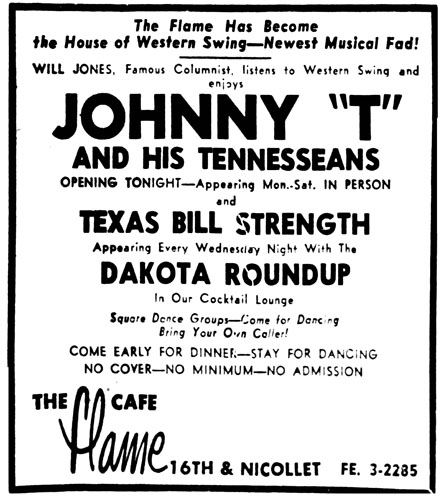
Minneapolis Star, February 1, 1956 The Flame had yet to adopt its distinctive rope font that makes its ads so difficult to find!
Although the photo below implies that it was taken at the Grand Ole Opry, Dale Strength has labeled it as coming from the Flame. It must be an early photo, as TBS’s guitar still has its decorative top.

Photo Courtesy Dale Strength
On February 2, 1956, Will Jones of the Minneapolis Tribune also noted the Western trend:
Western music has been a feature of the front bar [of the Flame] for a number of years, but it didn’t invade the big back room until last week. The management tried out Johnny T and his Tennesseans, liked them, and hired them as an every-night attraction.
The Dakota Roundup continues in the front bar, with Texas Bill Strength as a regular Wednesday night guest.
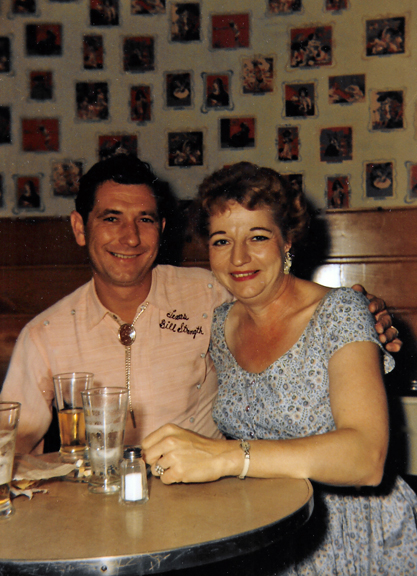
TBS with fellow Flame entertainer Fern Dale at the Flame. Photo courtesy Dale Strength
The Flame would hand out 8 x 10 glossies of the stars to the first 200 guests each night. Below is an autographed image of TBS’s Flame picture, found on eBay selling for hundreds of dollars!
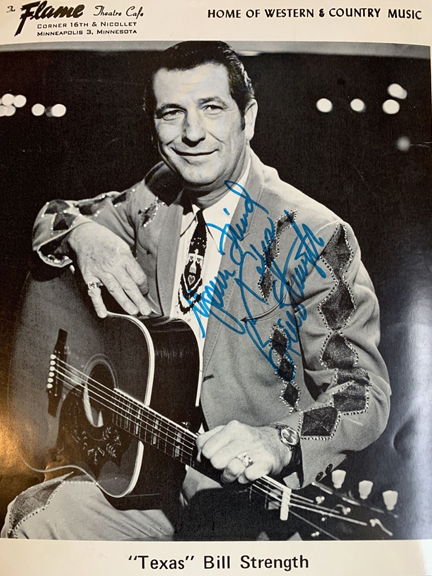
THE GAY NINETIES
In Will Jones’ column of February 2, 1956, he wrote that “The Gay Nineties has also gone western, with Dave Dudley’s band every night and Texas Bill as a guest Tuesday, Friday, and Saturday nights.
Billboard kind of confirmed this account on February 11, 1956: “Dave Dudley (King) and His Country Caravan have moved into the Gay 90’s, Minneapolis, for an indefinite stand. Guesting there each Tuesday night is TBS, who’s now spinning the country wax over a local station.”
TBS was the feature on “Barnyard Frolic” over KLRA, Little Rock. (Billboard, February 5, 1956)
On February 11, 1956, TBS played a repeat on the Pee Wee King show over WBBM, Chicago. (Billboard, February 18, 1956)
THE MINNIE AWARDS
The annual Minnie Awards took place on February 15, 1956. These TV and Radio awards were sponsored by the local chapter of AFTRA and the Advertising Club of Minneapolis, and probably morphed into the local Emmy awards. TBS won one of the five categories for “Hillbilly” performers – best male singer on the TV side, representing KEYD-TV. Slim Jim won best hillbilly-western personality (KEYD-TV), Harry Siles won best farm show personality (WCCO-TV), and Hall Garven won best hillbilly-western personality (WCCO radio). Will Jones reported:
When TBS was proclaimed best male singer, there were a few raised eyebrows around the Minnesota Terrace and a number of people asking “Who’s he?” (A Twin Cities newcomer, Strength could refer them to Capitol records for some answers. They credit him with five top-selling national record hits, including “The Yellow Rose of Texas.”)
Texas Bill’s popularity was proven by the 1,200 to 1,500 letters he claimed he received when asked in 1970. Although most of it was fan mail, some Minnesotans were not ready for either Country nor Western music. Ronnie Pugh wrote of a dean at Augsburg College who urged readers of the school paper to help keep the odious genre out of the area. “I answered him over the air,” said Bill. “I really chewed him out … told him that he would see the day when country music would come into its own as respectable music.”
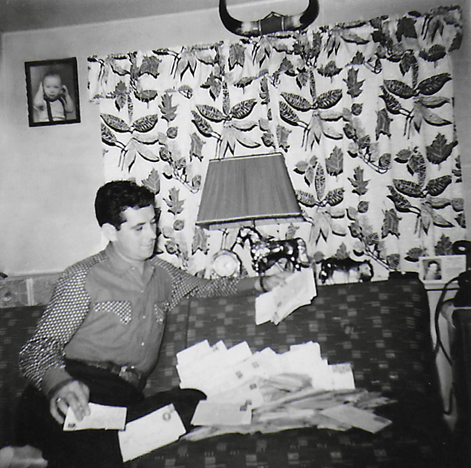
Photo courtesy Dale Strength TBS himself was enjoying amazing popularity in nationwide polls: one year he was Number 22, and another he was Number 26, out of about 1,800 considered. (Ronnie Pugh)
The Grand Ole Opry came to the Twin Cities several times in 1956. The TV show was sponsored by Pillsbury, and shown on 120 stations around the country. The TV show’s contract required that a troupe visit each of the 120 communities that gets the show on TV at least twice per year. The four troupes were headed by Roy Acuff, Webb Pierce, Hank Snow, Ernest Tubb and Faron Young. (That’s five but that’s what Will Jones said.)
The February 16, 1956 show featured:
- Hank Snow
- Jean Shepard
- Little Jimmy Dickens
- Lonzo and Oscar
- Hawkshaw Hawkins
- Tommy Warren
TBS and Johnny T shared emcee duties.
(Minneapolis Tribune, February 16, 1956)
CAPITOL RECORDS
On February 23, 1956, TBS had his second recording session at Capitol Records in Hollywood under Ken Nelson, the label’s Country A&R chief. He cut four sides:
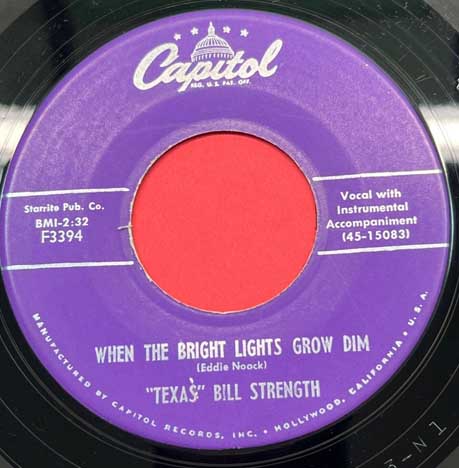
”When the Bright Lights Grow Dim” 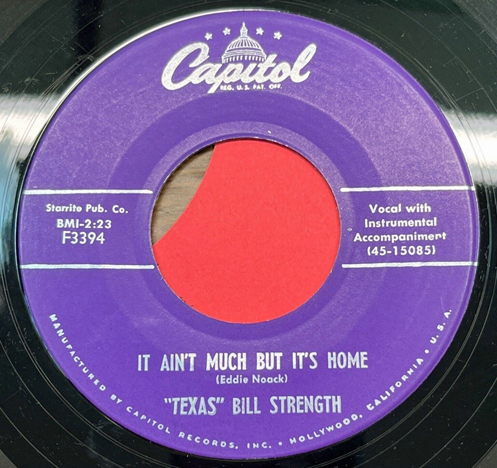
”It Ain’t Much But It’s Home 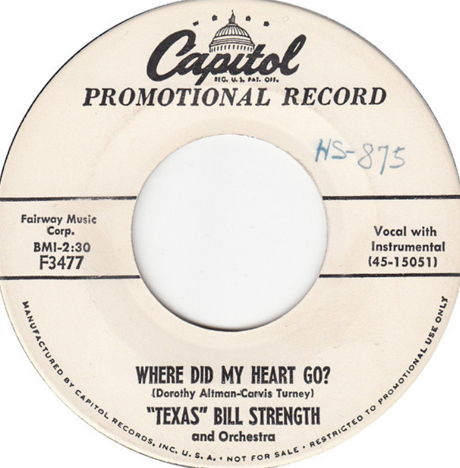
”Where Did My Heart Go” 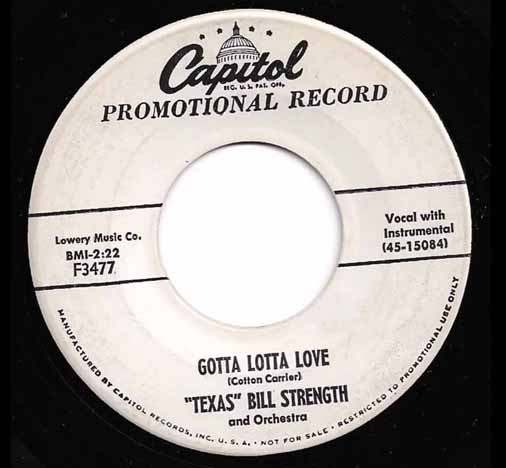
”Gotta Lotta Love” Capitol F3394 was released in April 1956 and Billboard reviewed it on April 14, 1956:
- “When the Bright Lights Grow Dim” – “A moving reading by Strength on a plaintive weeper with effective lyrics.”
- b/w “It Ain’t Much But It’s Home” – “A strong vocal job on an appealing up-tempo tune with clever lyrics.”
Capitol F3477 was released in mid-July 1956, and Billboard reviewed it on July 14, 1956:
- “Where Did My Heart Go?” – “Sincere warbling on a moving ballad with effective lyrics.”
- b/w “Gotta Lotta Love” – “Up-tempo tune is wrapped up in a strong vocal stint and a good beat.”
On September 6, 1956, the Pike County, Pennsylvania, Dispatch, commented, “TBS does well with a sad ‘un, “Where Did My Heart Go?” “Gotta Lotta Love” backs it to make a good combination.” The press release apparently described “Where Did My Heart Go?” as “a sad ‘un,” since it was described that way from Milford, Pennsylvania to Chula Vista, California.
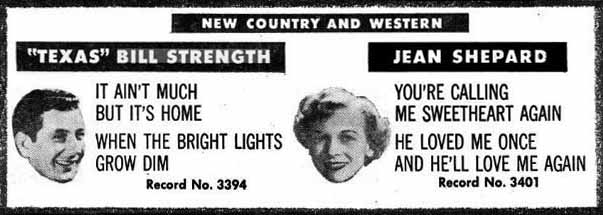
A rare promotional ad in Billboard, April 4, 1956
March 1956
In its Radio News column, the headline was “Texas Bill Warbles in Color”: “KEYD’s “Texas Bill” Strength appeared in a color telecast while he was in California cutting records.” (Minneapolis Tribune, March 5, 1956)
Jimmy and Ardis Wells and their Dakota Round-Up continue to hold forth at the Flame Supper Club, Minneapolis, where Johnny T. and His Crazy Tennesseans carry on it the club’s rear room each Friday and Saturday night. TBS, now spinning the country wax over a Minneapolis station, appears as guest with Jimmy and Ardis each Wednesday night. The Flame devotes two nights a week to country music exclusively. (Billboard, March 17, 1956)
April 1956
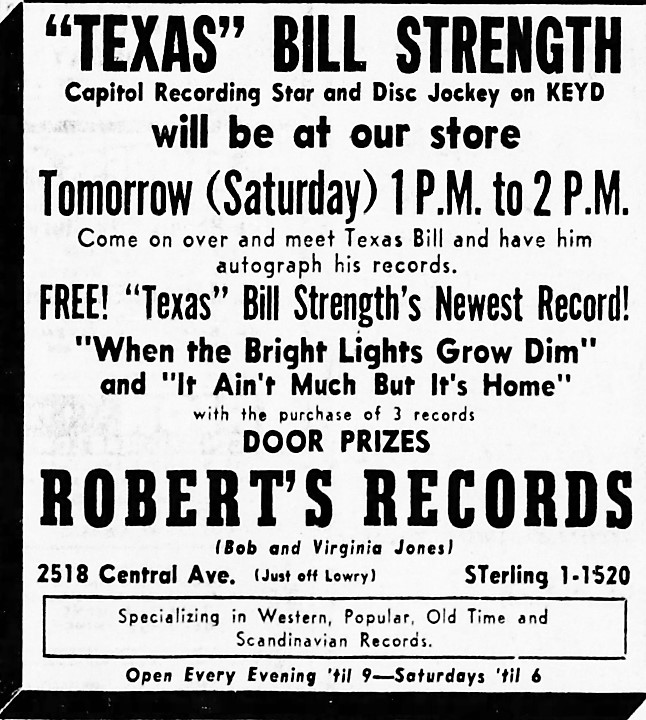
Minneapolis Star, April 6, 1956
Ardis Wells and her all-girl band, the Rhythm Ranch Queens, has opened in the front room of the Flame, Minneapolis, with Jimmy Wells and the Dakota Round-Up Gang holding forth in the Flame’s rear room. TBS (Capitol) is a nightly guest at the spot. (Billboard, April 14, 1956)
The endorsements and appearances continued – this one for King Dodge:
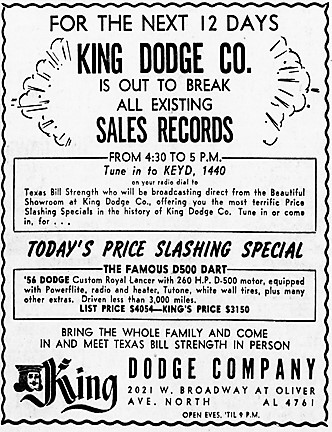
Minneapolis Tribune, April 17, 1956
On April 29, 1956, TBS (Capitol) emseed the “Grand Ole Opry” package, at the St. Paul Auditorium. The show featured:
- Webb Pierce
- Jim Reeves
- Hank Locklin
- Charline Arthur
- Farmer Boys
Billboard, May 5, 1956
May 1956
TBS was featured on the May 1956 cover of Cowboy Songs.
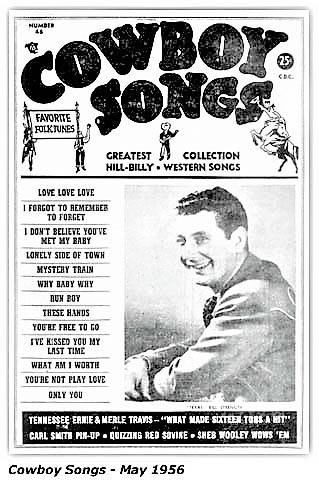
Image courtesy Dale Strength Bill says he’s working a seven-day-a-week schedule, but will take time out to greet his friends at the MOA convention in Chicago, May 6-8, and the Jimmie Rodgers Memorial Celebration in Meridian, Mississippi, May 25-26. (Billboard, May 5, 1956)
REUNION WITH ELVIS
On May 13, 1956, Elvis was in town for concerts in Minneapolis and St. Paul, and was less than well received – opener Augie Garcia whipped up the audience so much than an apoplectic Tom Parker had him kicked off the stage. But TBS was glad to see his old friend.
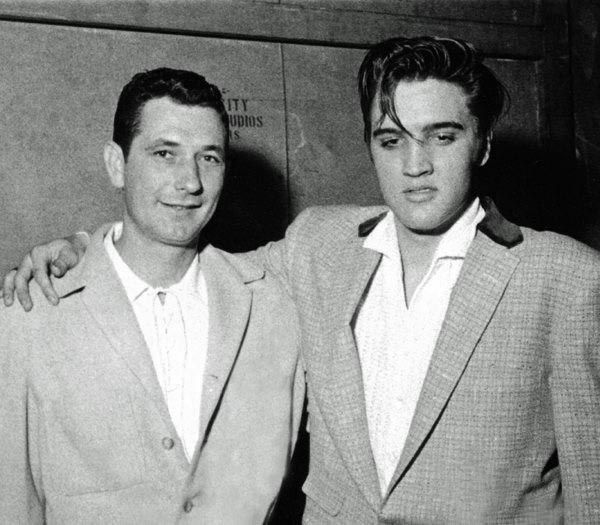
Photo courtesy Dale Strength
TEX RITTER KICKS OFF NATIONAL STARS AT FLAME CAFE
Will Jones announced the addition of national Western stars to the Flame:
Tex Ritter, singing cowboy, will be the first of a string of western names to be booked into the Flame Café. He will appear there next Wednesday night. [May 16, 1956]
On later Wednesday nights the spot will offer Tabby West, Betty Foley, Marvin Rainwater and Bobby Lord – all of whom I have been assured are big names in the western music field. (Ritter I’m sure of, largely because of “High Noon.”)
On nights other than Wednesday, the Flame is still all-western, with Ardis Wells and the Rhythm Ranch girls in the front bar, and Jimmy Wells and the Dakota Roundup in the back room. (Minneapolis Tribune, May 10, 1956)
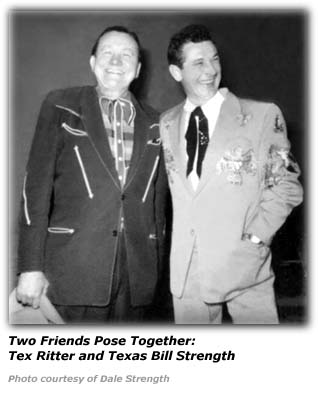
Tex Ritter and TBS were always close, as evidenced by the postcard below that Ritter sent to Bill from a vacation to Cairo. Although there is no date on it, it must have been between November 1955, when Bill joined KEYD, and June 1956, when KEYD changed its call letters to KEVE.
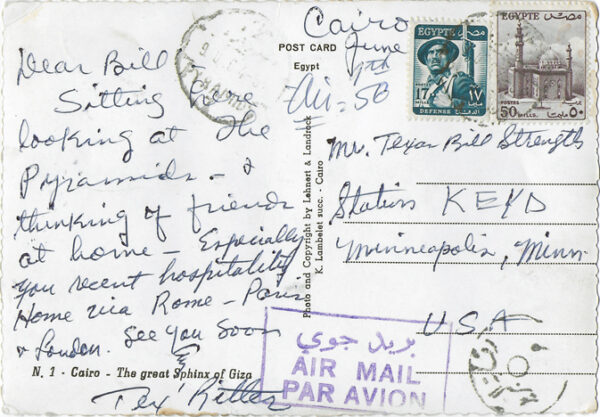
May 16, 1956, was the first time we see TBS in an ad for the Flame Cafe. TBS was on most/all of the Flame ads for 1956. Jimmy Wells and the Dakota Roundup was the house band in the show room. Jimmy’s wife Ardis Wells had her own band, the Rhythm Ranch Gals, in the Cocktail Lounge.
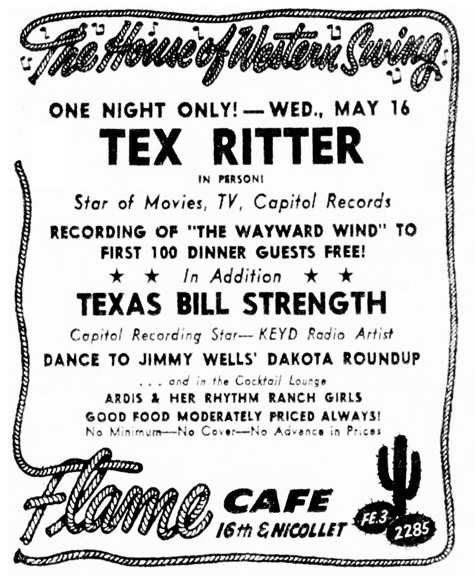
Minneapolis Tribune, May 1956
Texas Bill’s co-star at the Flame on May 23, 1956, was Tabby West. Bill had made a 45 with Ms. West on Coral Records in 1954.
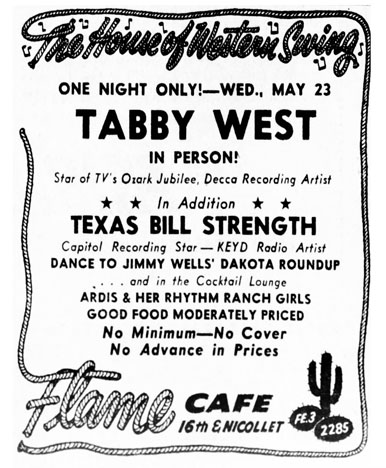
Minneapolis Star, May 22, 1956
RADIO ROULETTE
On May 25, 1956, rival country station WCOW was renamed WISK and the format changed from full-time Country & Western to a combination of Lombardo/Welk/etc. and an occasional Top 10 tune. This left KEYD as the only full time C&W station in the Twin Cities area.
JIMMIE RODGERS CELEBRATION
The fourth annual Jimmie Rodgers Memorial Celebration was held on May 25-26, 1956, in Montgomery, Alabama. Ernest Tubb, Hank Snow, and TBS appeared. Coverage of the event was considerably scaled down from the year before.
Appearing at the Flame from May 30 to June 2, 1956 were:
- Betty Foley
- The Westerners – the World’s only Square Dance Roller Skaters
- TBS
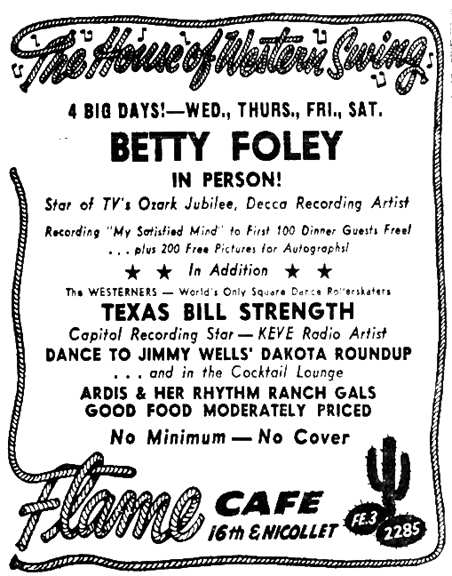
Minneapolis Star, May 29, 1956
June 1956
Headlining at the Flame on June 6-9, 1956 were good friends Marvin Rainwater and TBS.
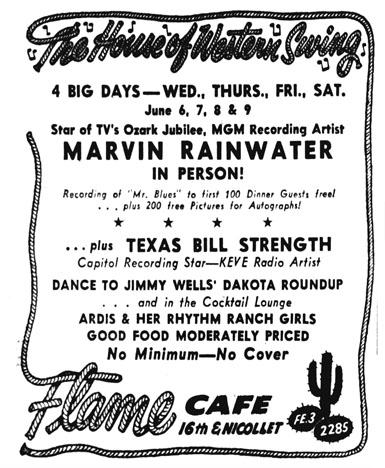
Minneapolis Star, June 5, 1956
TBS was quite a handsome sight at the Flame, decked out in his Nudie suits and all the accoutrements of a rhinestone cowboy.
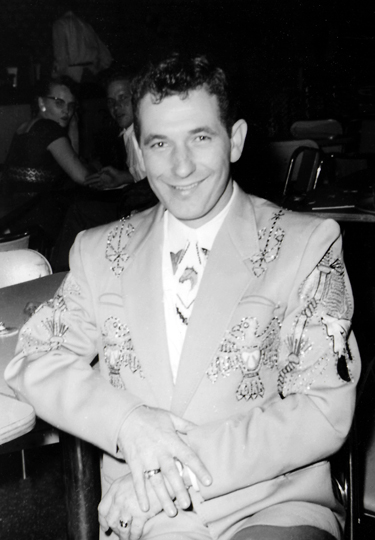
Photo courtesy Dale Strength TBS and Johnny T are still flipping C&W platters weekdays over KEYD, Minneapolis, with Vern Weegman gaining in recognition with his country shows over the same station on Saturdays. (Billboard, June 9, 1956)
KEVE
In June 1956, KEYD was sold, changed its call letters to KEVE, and played full time Country and Western – one of the first in the country to do so. [The format changed to classical music in 1961. It became KQRS on December 1, 1964.]
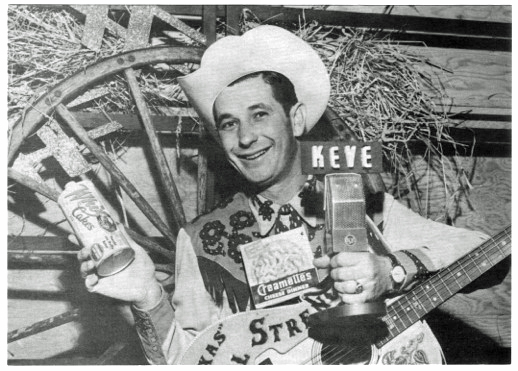
Photo courtesy Dale Strength 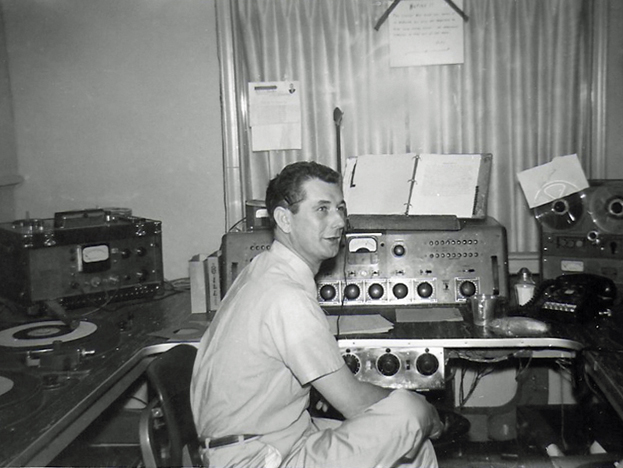
TBS at the KEVE Console. Photo courtesy Dale Strength
TEXAS BILL BOOKS THE FLAME
TBS urged record companies to send new releases to the new KEVE call letters. He says he’s now booking talent into the Flame. (Billboard, June 23, 1956)
Indeed, TBS had become a booking agent and emcee for the Flame and brought in major Country acts, most of whom were already personal friends. These included Jim Reeves, Johnny Cash, Ernest Tubb, Hank Snow, Hank Thompson, and Carl Smith. He performed several nights per week himself in the Lounge, and opened the Main Room shows for the bigger acts. An additional draw was that he would take his friends hunting and fishing if they were so inclined. (Ronnie Pugh)
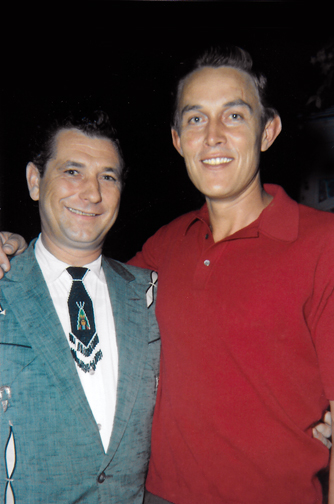
TBS with Jimmy Dean – Photo courtesy Dale Strength 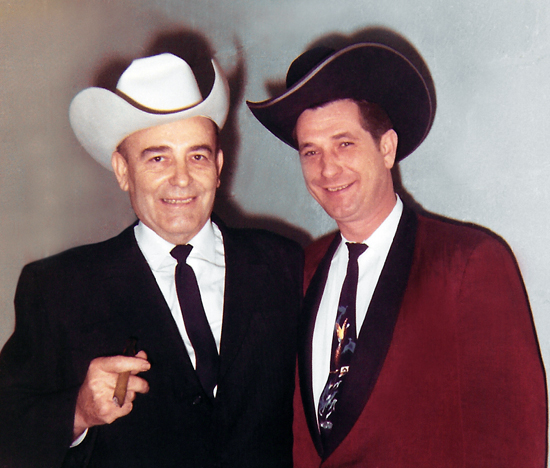
Bob Wills and TBS – Photo courtesy Dale Strength
COUNTRY MUSIC DISK JOCKEY CONVENTION
The Country Music Disc Jockeys Assn. (CMDJA) was organized at an event called “The Convention,” which was the second year of a birthday party for the Grand Ole Opry given by Radio Station WSM in Nashville.
The organization was officially chartered on November 21, 1953, at the Andrew Jackson Hotel, with 76 charter members, including TBS. By April 1, 1956, the list had grown to 150, including TBS, a “giant in the industry today.” “By 1958 it was apparent that there was a need for an all-industry association, in which the disk jockey would be an integral part, and the Country Music Association was born.” (Billboard, October 16, 1971)
On Thursday through Saturday, June 14 – 16, 1956, TBS participated in the Association’s first convention at the Colonial Hotel in Springfield, Missouri. The purpose of the 1956 gathering was to further public acceptance of country music.
On Thursday night, visitors attended the “Eddy Arnold Show,” featuring Arnold and Chet Atkins.
Friday afternoon was dedicated to the board meeting. After that came a chicken and dumpling lunch sponsored by Red Foley’s “Ozark Jubilee.” On Friday night a show was held at the Jewell Theater – a “corker” – with some 1,200 in the audience. The four-hour show was emceed by Red Foley and Sonny James and featured:
- Bill Wimberly’s Band
- Nelson King
- The Bonn Sisters
- Brenda Lee
- Uncle Cy Brasfield
- Johnny Horton
- The Philharmonicas
- Lebby Horne
- Pete Stamper
- Jim Edward, Maxine, and Bonnie Brown
- Billy Walker
- The Carlisles
- Johnny Cash
- TBS
- Smiley Burnette
- The Foggy River Boys
- Red and Betty Foley
- The Belew Twins
- Chet Atkins
- Janis Martin
- Audrey Williams
- Chuck Bowers
- Earl Bowers
- Bonny Gan
- Roy Drusky
- Jerry Reed
- Slim Wilson
- The Westport Kids
- Junior Haworth
- Shirley Caudel
- Warren Smith
- The Ferguson Sisters
The show raised $1,219 for the organization’s treasury.
On Saturday night the conventioneers were in the audience for Red Foley’s “Ozark Jubilee,” which emanated from the Jewell Theater. Late Saturday, Red Foley Enterprises and Decca Records hosted everyone with a cocktail and supper party. Winding up the festivities Saturday night was the awarding of a plaque to the “Ozark Jubilee” crew by the CMDJA members.
(Billboard, June 23, 1956 – article by Bill Sachs)
According to the ad below, TBS was also at the Flame on June 13 – 16, 1956, with Bobby Lord and Wanda Jackson. This overlapped with the covention described above.
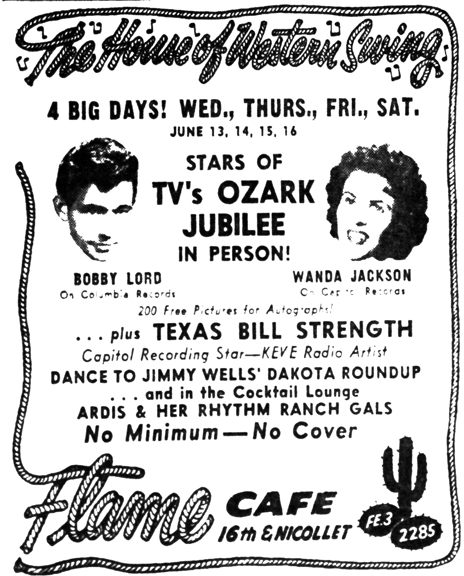
Minneapolis Tribune, June 12, 1956 
Texas Bill and Wanda Jackson
From June 20-23, 1956, TBS shared the Flame stage with Billy Walker and the Westerners.
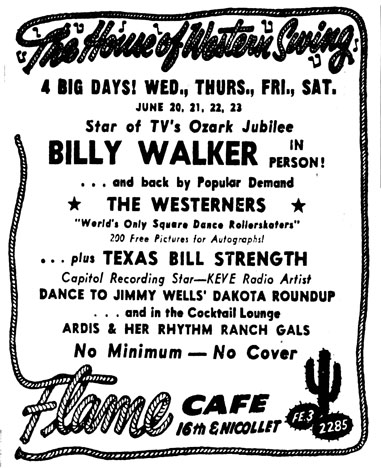
Minneapolis Star, June 19, 1956 On June 20, 1956, Kenny Roberts, whose TV show is now on four days a week over WHIO, Dayton, Ohio, plays the Flame Supper Club with TBS and group. (Billboard, June 2, 1956) (Does not jibe with ads)
On June 21, 1956, TBS made a personal appearance and remote broadcast at a Plymouth dealer.
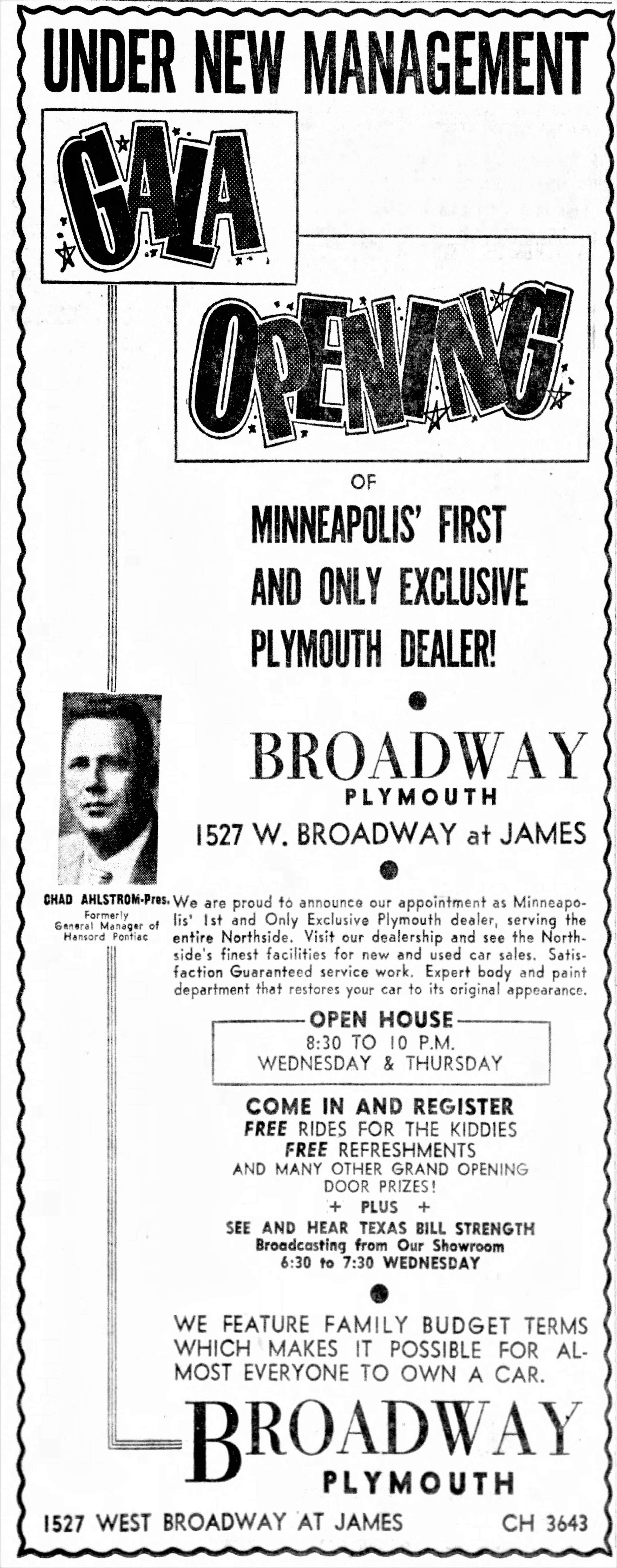
Minneapolis Tribune, June 21, 1956
On June 27 – 30, 1956, TBS was on the Flame bill with Mac Wiseman.
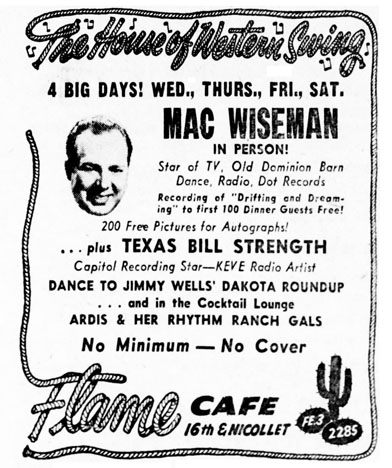
Minneapolis Star, June 26, 1956
July 1956
In July 1956, TBS was featured on the cover of Country & Western Jamboree magazine. Only a few short paragraphs were devoted to Bill inside, but the magazine did mention he was the number one rated Disc Jockey in the Minneapolis-St. Paul metropolitan area.
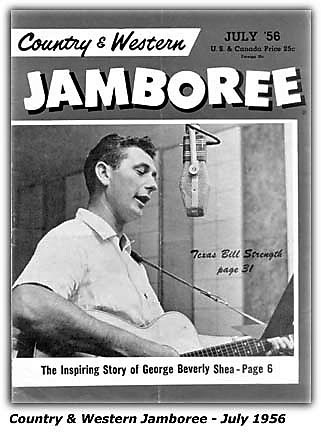
Image courtesy Dale Strength
From July 4 – 7, 1956, Justin Tubb shared the stage with TBS at the Flame.
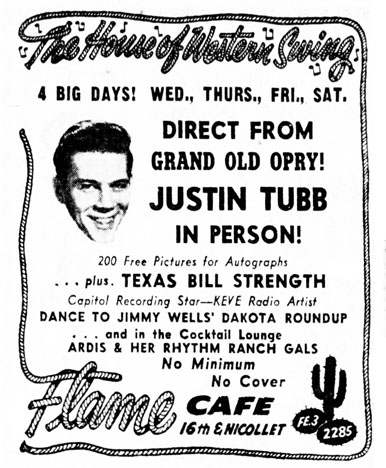
Minneapolis Tribune, July 3, 1956
From July 11 – 14, 1956, Arlie Duff was the guest with TBS at the Flame.
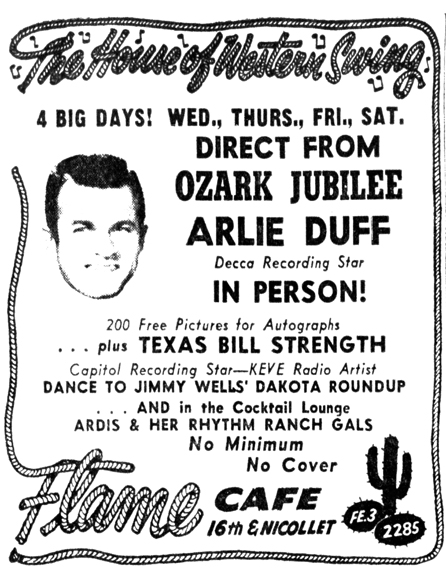
Minneapolis Tribune, July 10, 1956
From July 18 – 21, 1956, Jerry Reed was the special guest with TBS at the Flame.

Minneapolis Tribune, July 17, 1956
From July 24 to 28, 1956, TBS shared the stage with Joe Carson and His Southernaires at the Flame. Carson subbed for Jimmy and Ardis Wells who took a vacation.
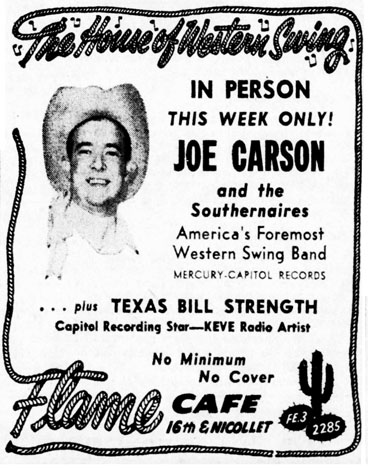
Minneapolis Tribune, July 24, 1956
RED FOLEY – JULY 28, 1956
On July 28, 1956, TBS appeared on Red Foley’s Ozark Jubilee out of Springfield, Missouri, which was broadcast nationwide on the ABC network. Other performers on the show were actor Cannonball (Dub) Taylor, and singers Johnny Bond and Red Garrett. Porter Wagoner hosted the first section and Foley took over for the second. (Houston Chronicle, July 28, 1956)
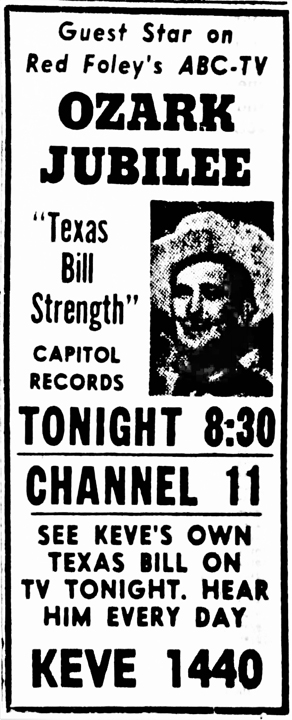
Minneapolis Star, July 18, 1956 This show was broadcast on Saturday, August 4, 1956, from 7:30 to 9:00 pm in Los Angeles. (Los Angeles Evening Citizen News, August 4, 1956)
August 1956
From August 1 to 4, 1956, Marvin Rainwater and TBS were to share the stage at the Flame.

Minneapolis Star, Tuesday, July 31, 1956
CAPITOL RECORDS
But once again, he couldn’t be at the Flame and Hollywood at the same time. On August 3, 1956, TBS was back at the Capitol Recording Studio, cutting four sides. Or, in Billboard talk, “TBS, now working on a heavy schedule twirling the C&W biscuits at KEVE, Minneapolis, was in Hollywood last weekend to cut his third session for Capitol.” (Billboard, August 11, 1956)
- “North Wind“
- “But Do You Think I’m Happy“
- “I Wanna Ride, Ride, Ride (On Your Merry-Go-Round)“
- “I.O.U.“
Capitol F3568 was released in October 1956, and reviewed by Billboard on November 3, 1956:
- “But Do You Think I’m Happy?” – Strength sells with sock songmanship on an amusing rhythm-novelty by Justin Tubb, with good punch-line lyrics.”
- b/w “North Wind” – Appealing vocal treatment of a haunting ballad with sensitive lyric line.
NORTH WIND
One couldn’t say that Capitol wasn’t giving it all it had in its promotion of “North Wind” and “But do you Think I’m Happy” – at least in Japan. At least two versions of a slick package for the single have been found, with lyrics, photos, and red vinyl. TBS’s real head appears to be floating above a sketch of him, and the Capitol Records building seems to be under attack. Let’s hope this creativity sold records – at least in Japan.
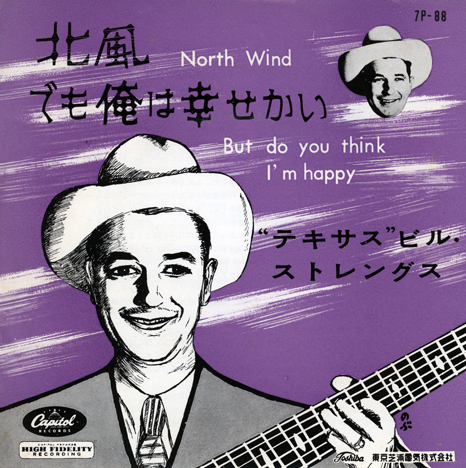
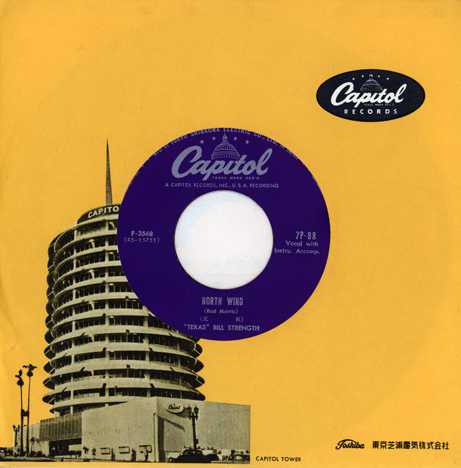
I.O.U. was never issued, and “Merry-Go-Round” was paired with “Six Fools,” which was recorded later on February 25, 1957.
On April 27, 1957, Billboard reviewed Capitol No. 3701:
- “I Wanna Ride, Ride, Ride On Your Merry-Go-Round” – A slick bit of rhythmic wax with a story that has certain touches of double entendre. A happy and well handled version that could easily generate some jock and juke box action.
- b/w “Six Fools” – An unusual piece of material rendered in a minor key. Fancy banjo plucking backs the chanting. Side rates attention and could compete with the flip for plays.
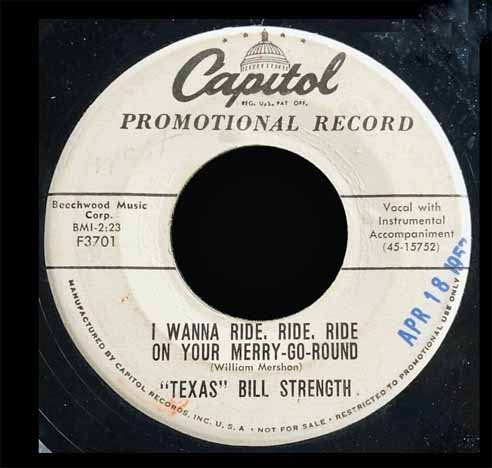

“Six Fools” was also included in a 1962 British compilation called “Round Up, that also included tunes by Tommy Collins, the Farmer Boys, and Ferlin Husky.
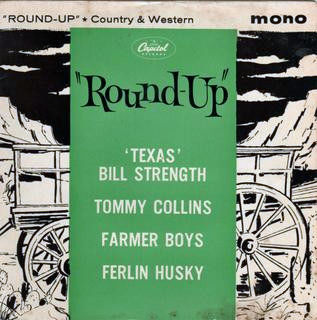
In the August 4, 1956, issue of Billboard, Verne Lotz wrote from Minneapolis: “I’m now with KEVE, the Twin Cities’ and Minnesota’s only all-country & western station. TBS (Capitol) and Johnny T. Talley, newly signed with Mercury, are spinning ‘em here also, as is Vern Weegman.
Mike Jann sent in this photo of TBS at a promotional event and remote broadcast on KEVE from King Dodge, August 1956. Mike said his camera was jostled, giving the picture a kind of echo effect …
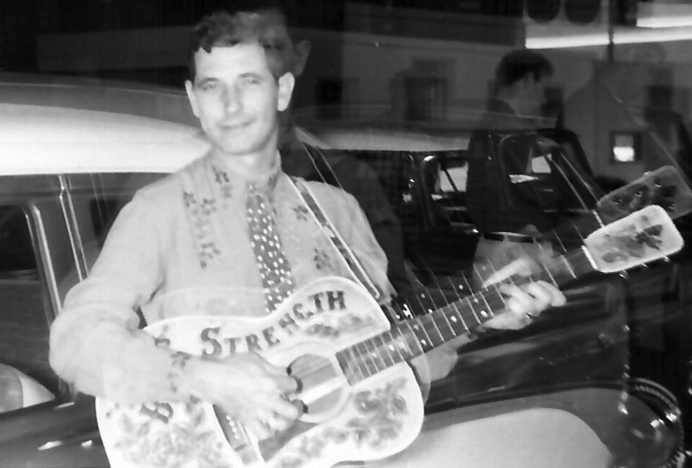
Photo courtesy Mike Jann Below is Mike himself, at a remote broadcast with TBS on KEVE from the old Minneapolis Auditorium. The gentleman on the right is the radio engineer.
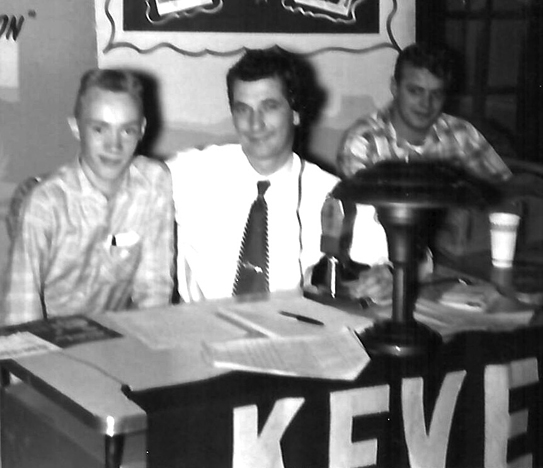
Photo courtesy Mike Jann
On August 8 and 9, 1956, Lee Emerson and the Everly Brothers starred with TBS at the Flame.
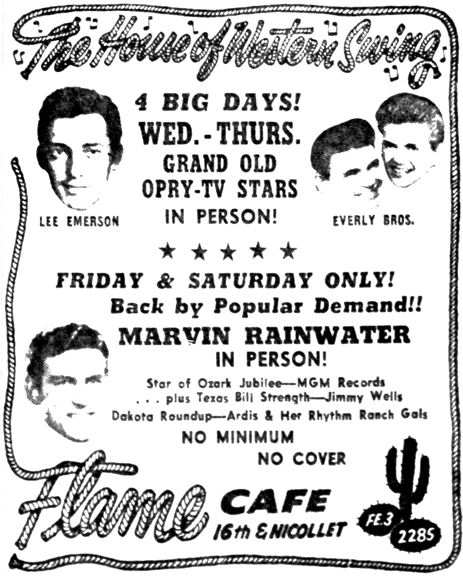
Minneapolis Star, Tuesday, August 7, 1956 
TBS with the Everly Brothers
On August 10 and 11, 1956, Marvin Rainwater and TBS rounded out the week at the Flame.
On August 15 through 18, 1956, Bobby Lord and TBS entertained at the Flame.
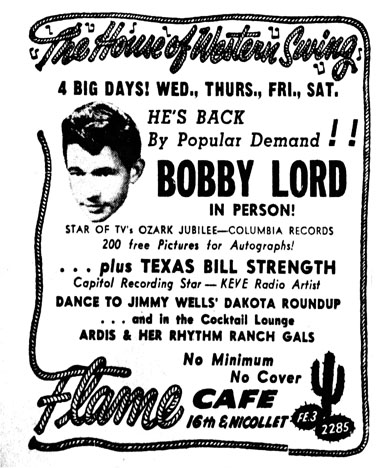
Minneapolis Star, August 14, 1956 Andy Williams visited with TBS at KEVE “last week.” (Billboard, August 25, 1956). Nothing comes up in a search for a country singer named Andy Williams, but dollars to donuts I’ll bet you it’s not the “Moon River” Andy Williams.
From August 22 to 25, 1956, Autrey Inman and TBS performed at the Flame, except that Del Woods and Bonnie Sloan are down for August 23.
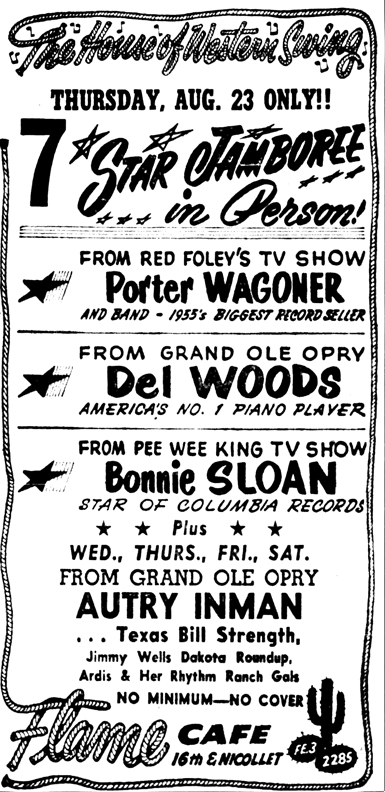
Minneapolis Tribune, Tuesday, August 21, 1956
From August 29 through September 1, 1956, Mitchell Torok (“Caribbean”) and TBS entertained at the Flame.
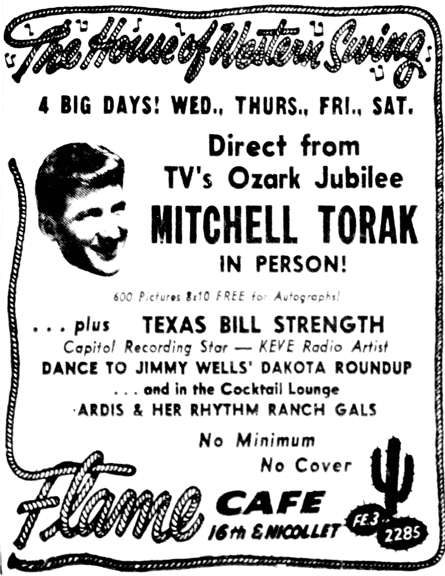
Minneapolis Tribune, Tuesday, August 28, 1956
September 1956
From September 5 though 8, 1956, TBS hosted Miss Audrey (Mrs. Hank Williams) at the Flame.
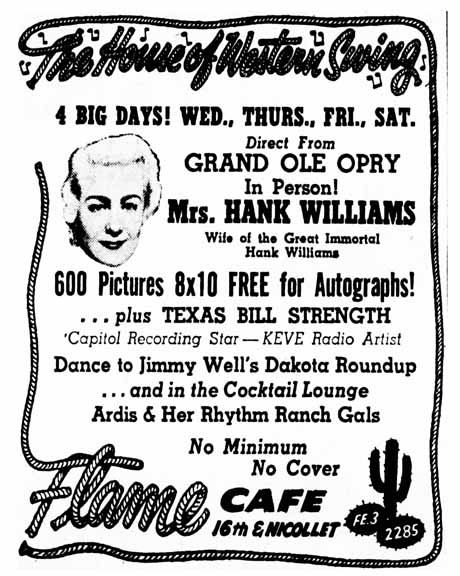
Minneapolis Star, Tuesday, September 4, 1956 From September 12 through 15, 1956, Yodeler Kenny Roberts shared the bill with TBS at the Flame. Kenny was famous for leaping into the air while playing guitar and harmonica at the same time, which gave him the nickname “The Jumping Cowboy.” Unfortunately there doesn’t seem to have been an ad that week.
Still trying to keep his family fed, on September 13, 1956, TBS appeared at a grocery store in Oxboro, south of Bloomington. Also appearing were Steve Cannon as Johnny .44 and Clellan Card as Axel.
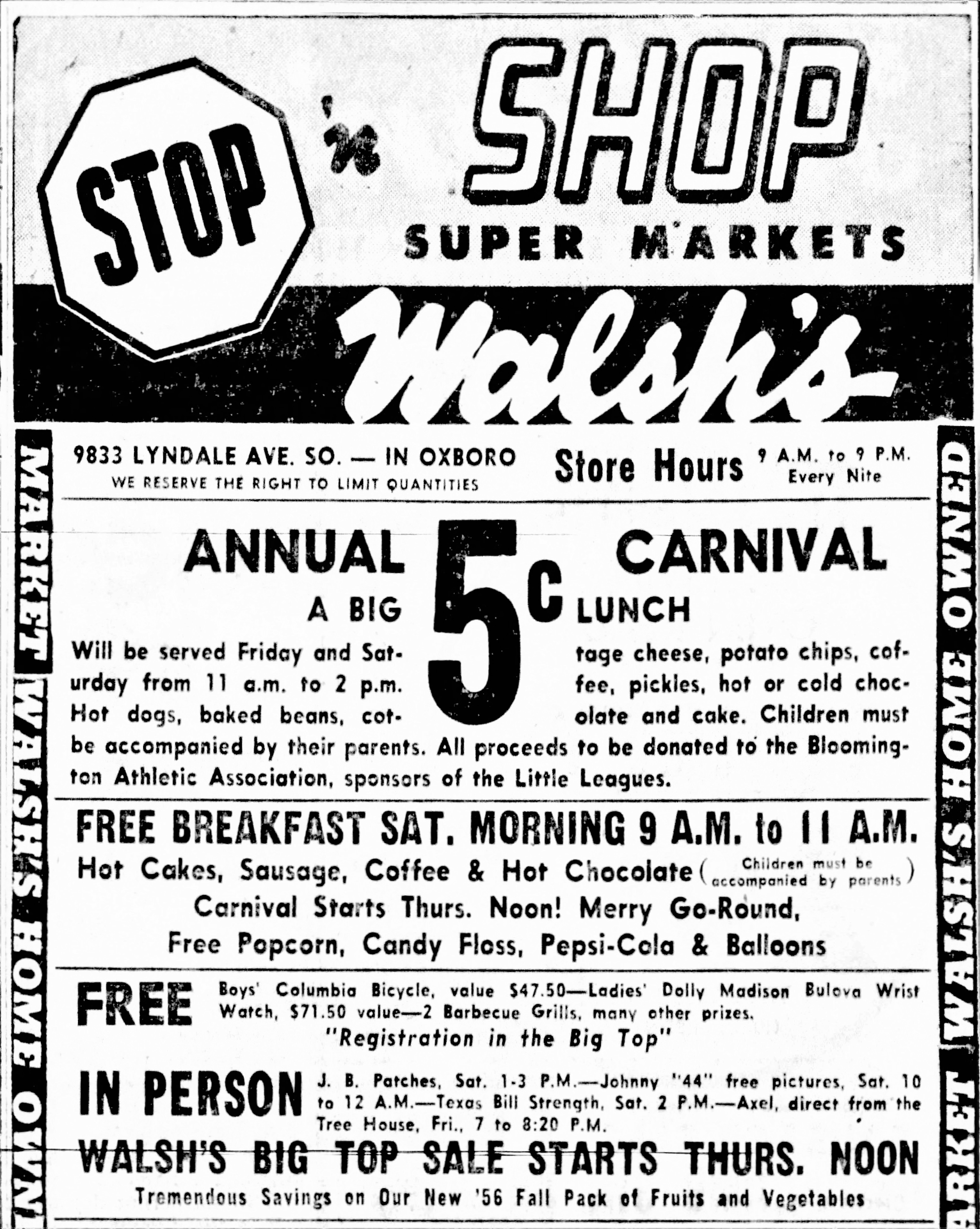
Minneapolis Star, September 13, 1956
From September 19 through 22, 1956, Leon Payne was TBS’s co-star at the Flame.
On September 20, 1956, one of four traveling Grand Ole Opry Troupes came to the Minneapolis Auditorium, with David Stone of the KSTP Barn Dance as emcee. Billboard reported that they “pulled a fat house.” During the show, Johnny T of KEVE was presented with a plaque by Ernest Tubb on behalf of Musicland Records for his achievement in the field of country and western music and for being Mercury’s top record seller in the five-state area. Along with TBS, performers were:
- Roy Acuff
- Ernest Tubb
- Kitty Wells
- Johnny and Jack
- George Jones
- Jimmy Newman
- Tommy Collins
- Hank Locklin
- Betty Foley
(Billboard, October 13, 1956)
“The Flame Books 2 Special Stars”
Two special attractions will come to the Flame café … Thursday [September 27] to perform with regular entertainers in the cast.
Marvin Rainwater, star of the Ozark Jubilee air show, and Mimi Roman, Decca recording star, will be on the bill for the one night.
Appearing also will be Cowboy Copas, Grand Ole Opry performer who is playing Wednesday through Saturday [September 26 – 29], and Texas Bill Strength and the Jimmy Wells and Ardis musical groups, regular entertainers.
(The Minneapolis Star, September 26, 1956)
October 1956
In early October, 1956, Tex Carman (Sage & Sand) and Freddie Hart (Columbia) have been set by TBS for a week’s stand. (Billboard, September 1, 1956). Apparently this did not work out, although ads for Carman and Hart at the Flame can be found in 1960.
From October 10 to 13, 1956, TBS shared the stage at the Flame with Justin Tubb.
Bob Murphy described Mimi Roman (from the aforementioned Flame show) as a “looker” and reported that she went over so well on the September 27 show that they were bringing her back for a four-day run on October 17-20. “On the bill also are the regulars, Texas Bill Strength, and Jimmy Wells and Ardis and their groups.” (Minneapolis Tribune, October 14, 1956)
TBS took a few days off from his platter spinning at KEVE last week for a bit of bear hunting in Montana. Johnny T and Verne Sheppard spelled him during his absence. (Billboard, October 20, 1956)
November 1956
The 1956 Billboard C&W Disk Jockey Poll placed TBS at Number 20 nationwide. His affiliation was listed as KEVE KEYD. (Billboard, November 10, 1956) (In June 1956, KEYD was sold, changed its call letters to KEVE.)
November 10, 1956, Billboard: TBS placed an ad thanking his friends in the business. His affiliations were KEVE Radio, KMGM-TV, Capitol Records.

Billboard, November 10, 1956
December, 1956
THE TBS RECORD SHOP
Like his friend and idol, Ernest Tubb, TBS opened a record shop on December 1, 1956, shortly after arriving in Minneapolis.
On December 1, 1956, TBS celebrated the opening of the Minneapolis record shop bearing his name with a two-hour remote broadcast featuring talent from the Twin Cities area. Bill asks artist to send him autographed photos for the shop. His address is KEVE Radio, 806 North Lilac Drive, Minneapolis The shop was located at 1003 Marquette Ave. in downtown Minneapolis. (Billboard, December 8, 1956)

Letterhead image courtesy Dale Strength 
Photo Courtesy Dale Strength Someone only identified as “Pee Dee” wrote in to describe his experience as a teenage gofer for TBS:
My days at the TBS Record Store were not the most auspicious, and my experiences with TBS himself less than complimentary…to either him or me. I was a 16-year-old “go-fer” who shuttled him and his out-of-town Opry guests around town. In spite of still being in school I did night duty as his driver (he would imbibe…) to places like the auditorium and the Flame (on Nicollet, if I recall). I’d pick up folks like Marty Robbins, Hank Snow and the like at the airport and take them to a hotel or the auditorium downtown. I was also a bit infatuated with Wanda Jackson who drove her own three-toned Dodge La Femme convertible to the ‘Cities and let me chauffeur her around in it, and I chored for a very accomplished fiddle player named Benny Martin who had me shagging across the street to the drug store opposite the shop about twice daily to pick up “cough medicine” — turpin hydrate and codeine with a good percent of alcohol — when he came to town. For his (ahem) cough…back then they’d sell that stuff to anyone including a 16-year-old kid.
I have no idea what [the story] about him being wounded in the thigh was all about. But I do recall that once when he played his cowboy role complete with nickel-plated revolvers — on one particular evening at the Flame all three were loaded but the latter two with blanks, thank heaven — that he got into a difference of opinion with Marvin Rainwater, pulled out one of those things, stuck it in Marvin’s stomach and blew a big black hole in Marvin’s trademark buckskin jacket.
Of course, the unmistakable sound of a shot sent the place into a panic. Fit to be tied, Marvin virtually lifted Bill up by the collar of his prize Nudie-made sequin-spangled jacket and slammed him up against the wall, proceeding with a string of epithets that stopped only when he heard the sirens out front as the cops showed up. Not one for drinking, Marvin got a grip on himself, loosened his on Bill who was pretty much out of it. He instructed me to go get Bill’s shop station wagon and to bring it to the back stage entrance, which I did.
In an abundance of caution, Marvin relieved Bill of his six-shooters and threw them under the front seat. We then stuffed him into the passenger side and I drove him home to his trailer(?) outside of Minneapolis. I then took the station wagon home, back to Clumsy Heights just about in time to turn around and drive to school the next morning.
That morning, I proudly showed up at school in the station wagon which I parked conspicuously right out front…and by doing so I guess I slammed on the brakes a bit too hard because two six-shooters came sliding out from under the seat against my feet! Not too intrigued with showing them to classmates, I pushed them back and left them there until the evening when I brought the station wagon back to Bill at the shop.
Imagine that happening today…
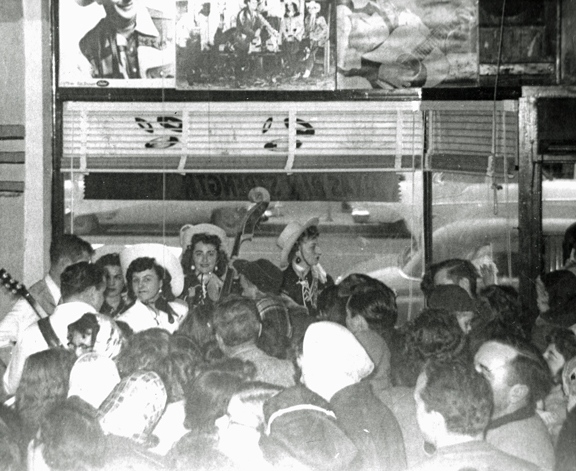
Live performance at TBS Record Shop with TBS, Ardis Wells, North Sisters, Fern Dale, 1957. Photo Courtesy Dale Strength
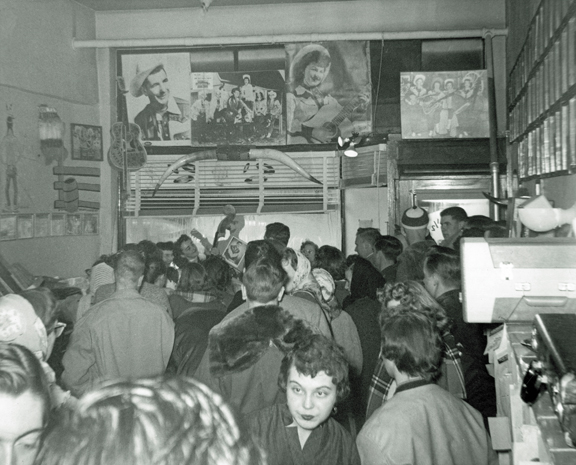
TBS Record Shop Live Performance, 1958. Photo courtesy Dale Strength
This item came over the transom – a record dealer had found an empty package from Texas Bill’s store in an antique shop in New Prague and sent in a photo of it.
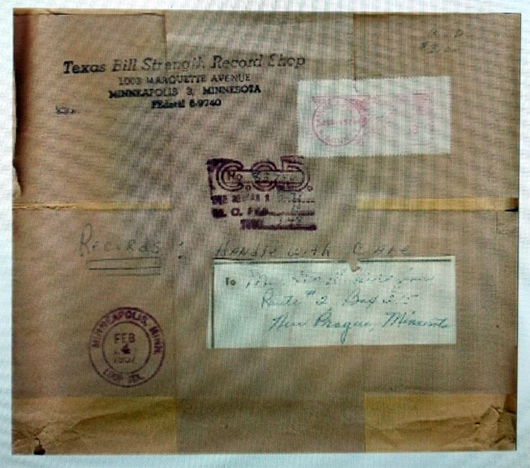
Image courtesy Mike in Shakopee 
Close-up of the return address
At some point the shop moved to 202 So. 10th Street in Minneapolis, as evidenced by this card found in the archives of the Manske Sisters:
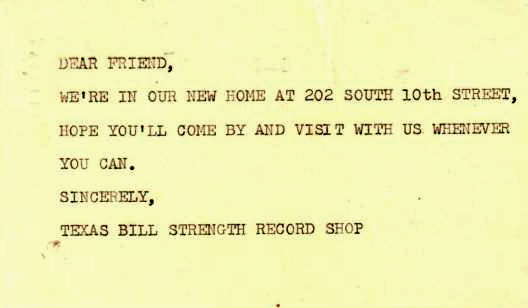
The record shop was “disposed of” in April 1958.
Another activity of “Texas Bill Strength Enterprises, Inc.” was a series of songbooks. Here’s Volume 2, featuring one of the best closeups of his face:

Image Courtesy Dale Strength
From December 18 to 22, 1956, entertainment at the Flame included Marvin Rainwater, TBS, and Johnny T.
The December 1956 issue of Country & Western Jamboree included the results of various fan polls they had taken. TBS had finished third after other disc jockey legends as T. Tommy Cutrer and Don Larkin as “Favorite Local Radio Disc Jockey.” That list also included other legends that would be in the Country Music Disc Jockey Hall of Fame: Randy Blake and Bill Mack.
A New Year’s Eve 1956 show at the St. Paul Auditorium starred:
- Ray Price
- Ferlin Husky
- Martha Carson
- Autry Inman
- Simon Crum
- Porter Waggoner
- Mitchell Torok
- Texas Bill Strength
1957
January, 1957
TELEVISION
On January 1, 1957, TBS began hosting the TV show, “Adventure Time With Texas Bill,” on KMGM-TV, which was Channel 9 at the time. The program aired from 6 to 6:30pm. He showed Western serials and sang Western songs. On March 23, 1957, Billboard published a list of Local Live Country and Western TV Shows. TBS was listed as the producer of his show, the only one in Minnesota. The show had 14,000 loyal followers. (Ronnie Pugh)
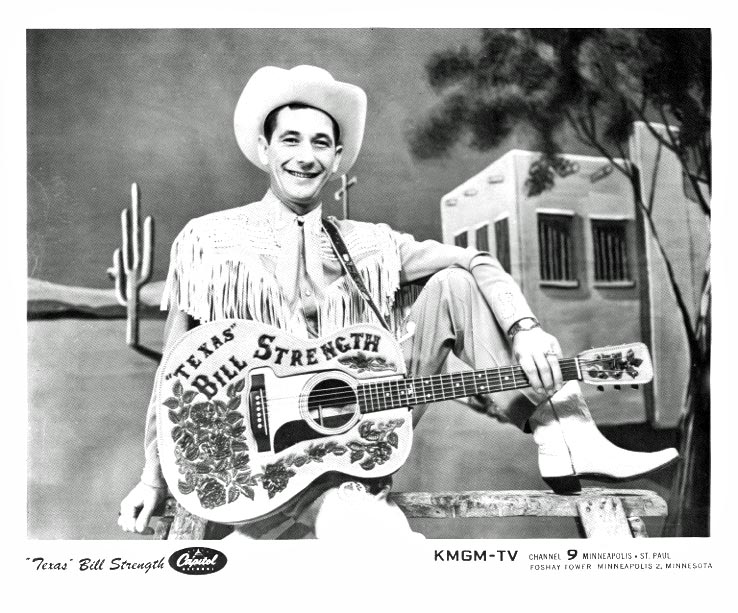
Photo courtesy Dale Strength 
Minneapolis Tribune, January 2, 1957 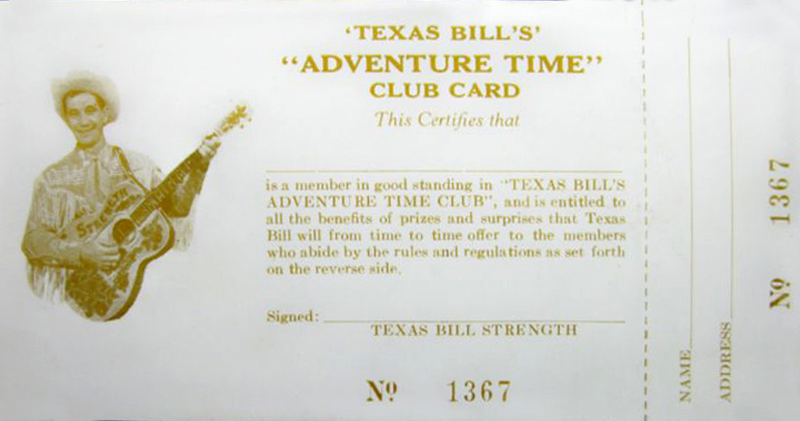
Adventure Time Membership Card, Front – Image courtesy Dale Strength 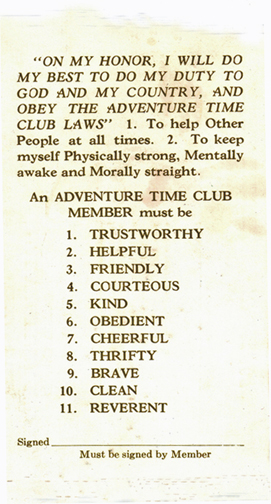
Adventure Time Membership Card, Back – Image courtesy Dale Strength
January 13 – 19, 1957, was the last time TBS was listed on the weekly Flame ad. His co-star that week was Carl Perkins, and Johnny T was also on the bill. It is presumed that he continued his hosting role off and on, as he reportedly resigned that job at the end of March, 1958, replaced by Dave Dudley.
TBS has quit his deejay chores at KEVE to devote more time to his record shop, which is proving fairly successful. Bill also will give more time to promoting himself as an artist. (Billboard, January 26, 1957)
Strength has just kicked off an hour-long TV show, seven days a week, over KMGM, titled “Adventure Time With Texas Bill.” (Billboard, January 26, 1957)
February 1957
On February 15, 1957, TBS leaves on a two-week tour, which will include a double session for Capitol in Hollywood, several West Coast dates for Americana Corporation. (Billboard, January 26, 1957)
On February 16, 1957, TBS appeared on the “Big D Jamboree” in Dallas. Other guests were the Five Strings and the Rangers Quartet. (Billboard, February 23, 1957)
CAPITOL RECORDS
February 25, 1957: TBS made his last recordings for Capitol. Billboard had reported that this was to be a double session, but as far as we know, only two songs were recorded:
- “Cloud 13”
- “Six Fools”
“Cloud 13” was never issued, and “Six Fools” was paired with “I Wanna Ride, Ride, Ride (On Your Merry-Go-Round)” from the previous recording session, released in April 1957.
April 27, 1957: Billboard reviewed Capitol No. 3701:
- “I Wanna Ride, Ride, Ride On Your Merry-Go-Round” – A slick bit of rhythmic wax with a story that has certain touches of double entendre. A happy and well handled version that could easily generate some jock and juke box action.
- b/w “Six Fools” – An unusual piece of material rendered in a minor key. Fancy banjo plucking backs the chanting. Side rates attention and could compete with the flip for plays.
Below is a photo of TBS listening to a playback at one of his four sessions at Capitol Records in Hollywood.
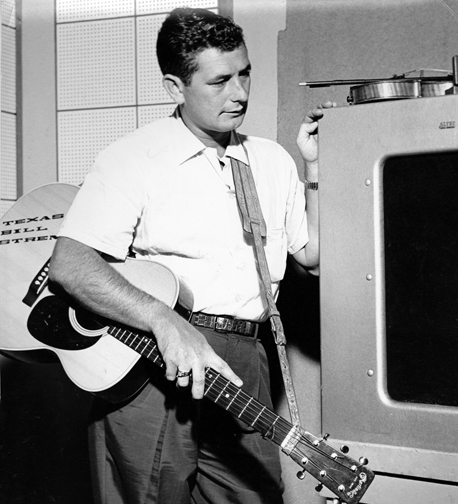
Photo courtesy Dale Strength
March 1957
RED FOLEY – MARCH 2, 1957
On March 2, 1957, TBS made his fourth guest shot on “Ozark Jubilee” in Springfield, Missouri. Also appearing were Patsy Cline, Libby Horne, and comedienne Little Eller Long.
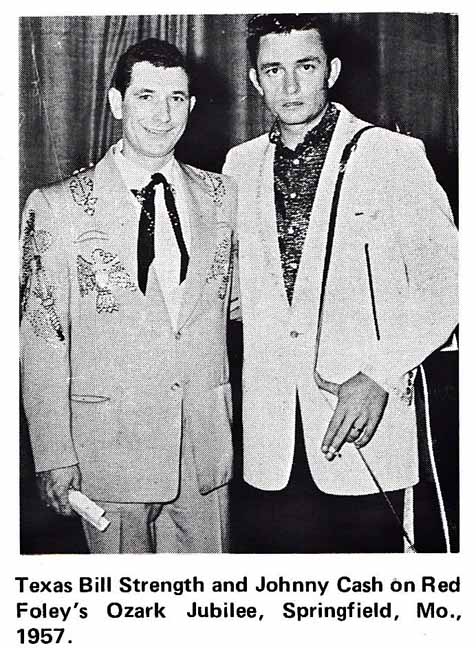
Photo courtesy Jan Sherman via Derik Olson
April 1957
Speaking of Minneapolis, what has happened to our good friend, TBS? (Billboard, April 6, 1957)
Much news in a Billboard report dated April 13, 1957:
TBS has settled down to his usual activities in Minneapolis after a two-week sojourn on the West Coast. [First two weeks in April 1957?]
[TBS continues] his daily show over KMGM-TV, “Adventure Time With Texas Bill.”
Strength has resumed former duties of spinning C&W platters five hours a day over KEVE.
Bill also reports success with his recently opened record shop, which is devoted to C&W music exclusively.
His newest Capitol release is “The Six Fools.” Any deejay wanting an extra copy may write to him at either of the above stations.
MORE RADIO ROULETTE
April 18, 1957, Minneapolis Star:
District Judge John A. Weeks today signed an order to show cause, to be heard before him April 23, by which radio station WISK seeks to prevent William (Texas Bill) Strength, cowboy singer and disk jockey, from continuing to work for radio station KEVE.
WISK claims that Strength signed a 90-day contract March 30 which would move his services to WISK, but has continued to work for KEVE. The contract, it was reported, had options exercisable for the rest of the year, and was effective April 15, but Strength failed to make the change. [I have found no evidence that he ever worked for WISK.]
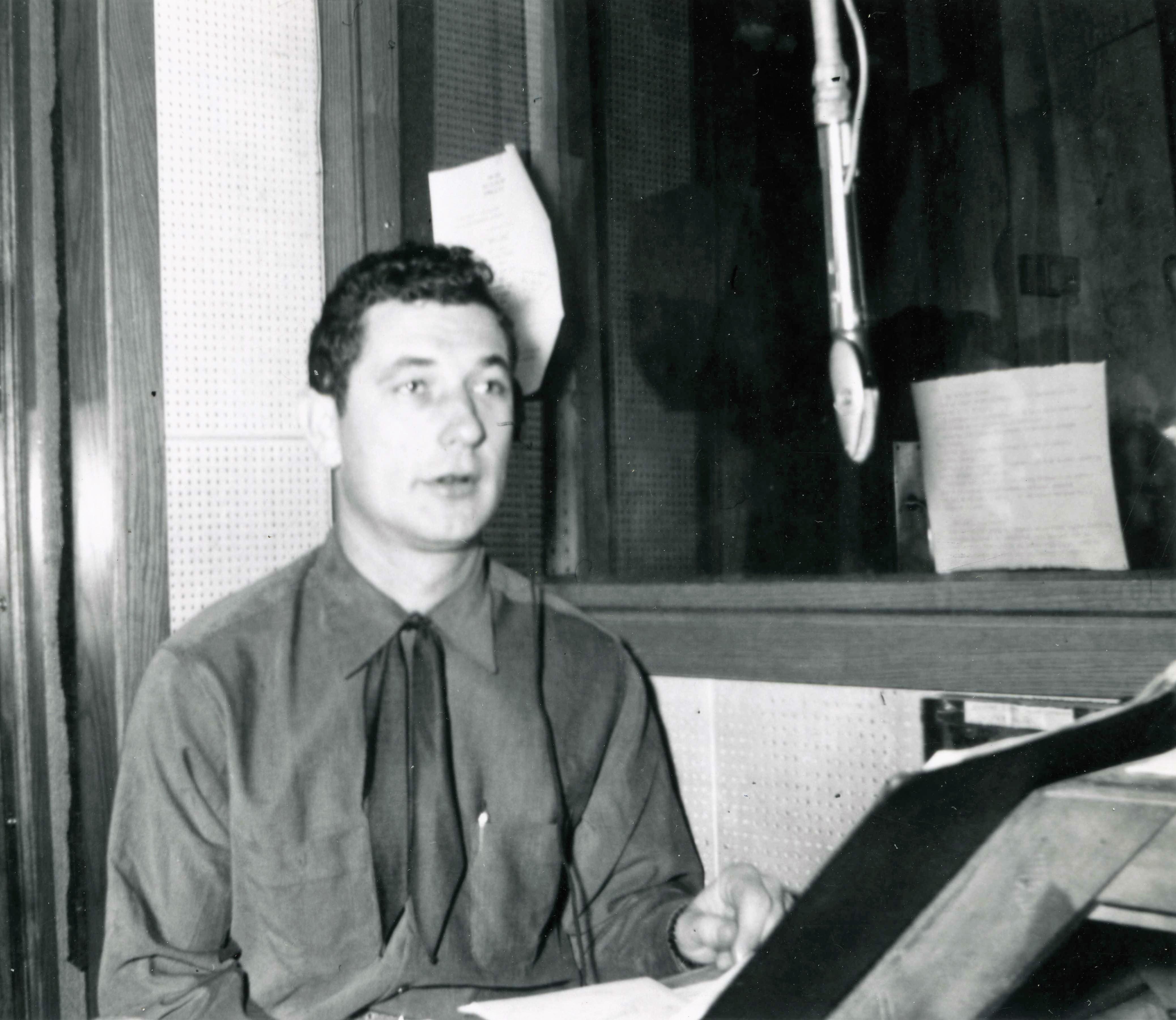
The photo above comes from a fan scrapbook, approximately 1957. The back indicates two different radio stations he could be working at, but it’s pretty clear that he was at KEVE during this time.
STINKY
Stinky was a pet skunk that TBS picked up while he was on one of his early Minneapolis radio stations. He, Dale, and Bobby were on the road somewhere, and they traveled with him in the car for a few days. One morning when they were checking out of their motel, Stinky wouldn’t budge from under the bed. The boys tried to catch him, and they chased him around in the room for a long while, but he didn’t want to be caught and started getting aggressive. Bill finally got frustrated and said, “To hell with him, leave him there.” And they left.
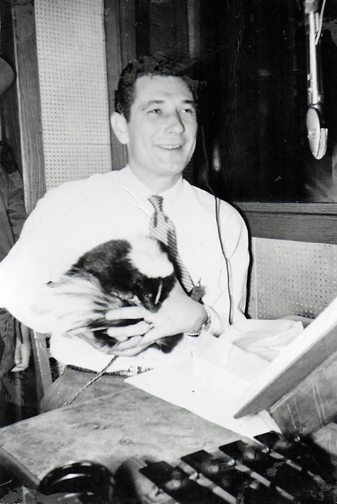
TBS and “Stinky”
On April 18, 1957, Will Jones wrote:
A big western and country music bash is on tap at 8 pm Saturday [April 20] in the Minneapolis Auditorium, put on by radio station KEVE. Plunking, twanging and drawling will be:
- Sonny James
- Johnny Cash and the Tennessee Two
- Jerry Lee Lewis
- Gene Stewart
- The Country Gentlemen
Texas Bill Strength, who bunks in the Twin Cities, will be master of ceremonies. KEVE says the show is aimed at popular, as well as western, music fans. (Minneapolis Tribune)

Image courtesy Dale Strength
Below is the program for the event, which features KEVE’s disc jockeys, Texas Bill and Vern Weegman.
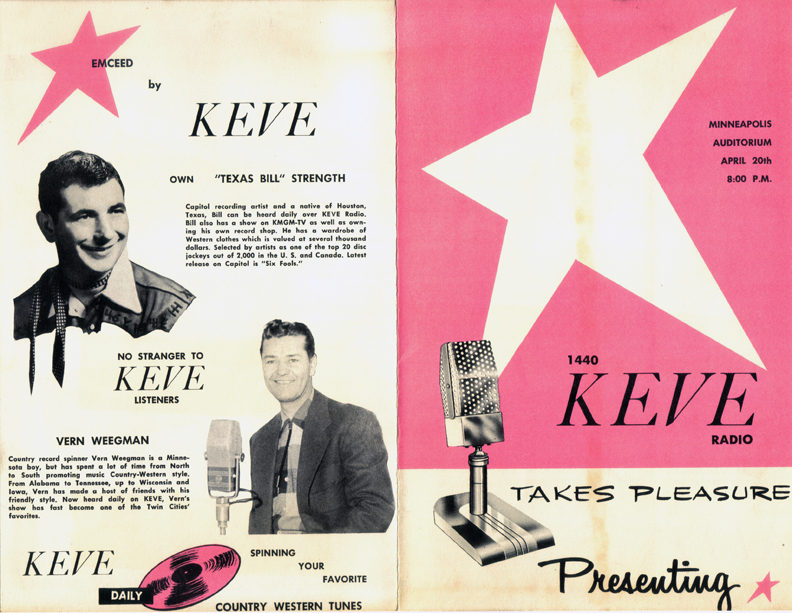
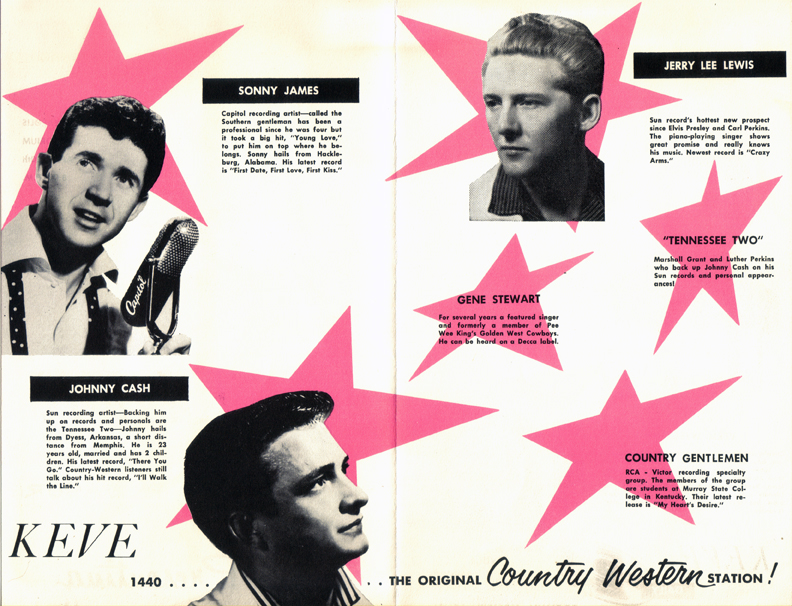
May 1957
FRONT PAGE NEWS
On May 5, 1957, the front page of the TV Tab entertainment supplement of the St. Paul Sunday Pioneer Press was dedicated to TBS, with a big picture of him captioned “KMGM’s Texas Bill Strength.” The headline was “Movie Stardom is Texas Bill’s Aim,” subtitled “Singer is Host for Westerns.” Staff writer Howard Ryan lists TBS’s many enterprises:
- Host of “Adventure Time with Texas Bill” on Channel 9 (KMSP-TV) from 6 to 6:30 M-F. Ronnie Pugh wrote that this was a kiddie show that had 14,000 loyal followers at one time.
- Disc jockey on KEVE from 10 am to noon and 2:30 pm to 5:30 pm, M-F and 10:30 am to 3 pm on Saturdays
- Owner of his own record shop
- Five personal appearances on average each week
- Occasional appearances on “Grand Ole Opry unit guest appearances”
- Music publishing firm in partnership with Tex Ritter
He reported that he was leaving on May 19 for about 10 days to do some personal appearances with Ritter and work with him in a couple of films in California. His biggest ambition was to be a Western movie star. “I’ve had some real good encouragement from producers and directors in Hollywood,” he said. Although he had no formal acting training, he expressed his belief that “I’ve got a natural ability for Western parts.”
As for his musical career, he had had 18 releases with Capitol Records at that point, but his goal was to hit with a million seller.
TBS professed his love for the Twin Cities, which was the Number 2 market for Country music behind Nashville, he said. “Unlike most Texans, I prefer the colder weather – I feel better. I love the people here, too. They have more or less accepted a ‘foreigner’ and made me feel welcome.”
DOMESTIC HIGHS AND LOWS
The Pioneer Press article of May 5, 1957, reported that TBS lived with his family in a “large trailer home at Medicine Lake,” and although he had been promising himself a two-week mountain vacation with his family for five years, he always wound up making personal appearances instead.
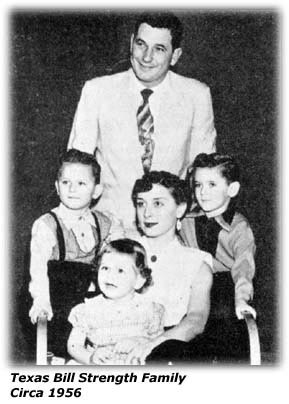
Photo courtesy Dale Strength
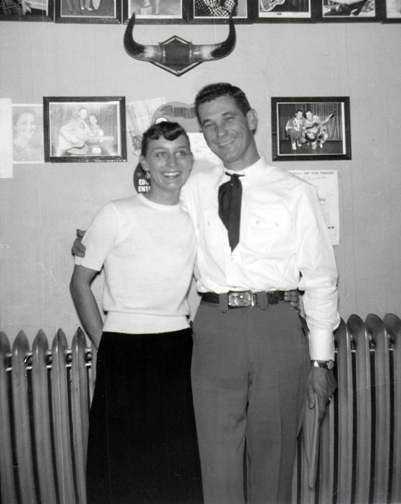
Dorothy and Bill, all smiles at his Record Shop. Photo courtesy Dale Strength
TEXAS BILL’S SCRAPBOOK
The letter below, unfortunately undated, tells us that TBS put together a chronological scrapbook of his career – a copy of which would make this project a lot easier! There are snippets of this book available, but according to the letter, fans sent in snapshots and news clippings to help him piece together his peripatetic career around the United States and all of the celebrities and fans he met along the way. Pictures that could be matched with events have been placed accordingly. Unfortunately, the two pages found on the Internet were too small to post in most cases. And there are pictures of people that are yet to be identified. They are posted here, under the letter.
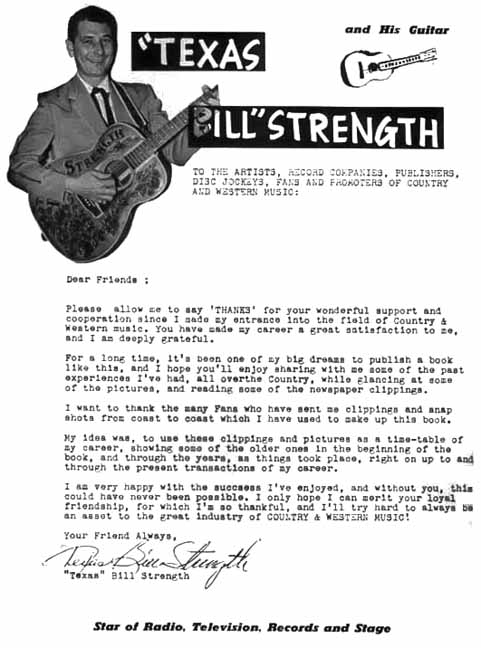
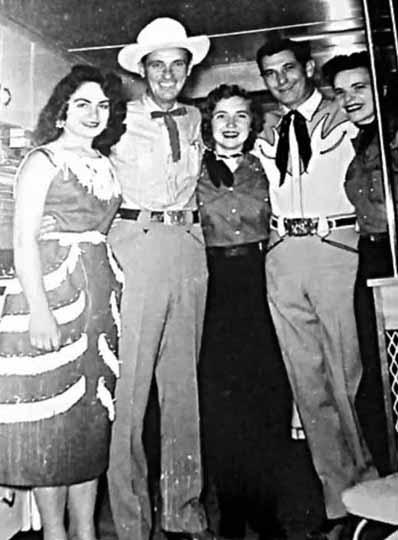
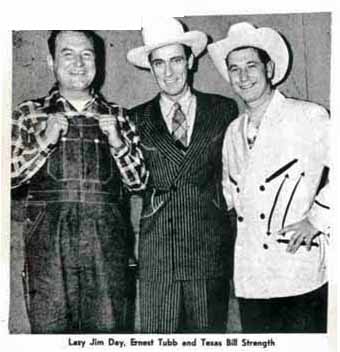
Larry Jim Day, Ernest Tubb, TBS
HOLLYWOOD
If the dates in the Pioneer Press story of May 5, 1957, were correct, Bill was out in Hollywood between May 19 to 29. His goal was to do some personal appearances with Tex Ritter and work with him in a couple of films.
Billboard reported that while he was there he had a two-day guest shot on “Town Hall Party,” and was called in on a session that may net him a movie shot soon. (June 10, 1957)
On May 26, 1957, Will Jones reported that he “landed himself a part in a new western movie. The film will star Webb Pierce and Red Barry. Strength will go back sometime this summer to make the film.”
Although this would have been TBS’s dream come true, it did not come to fruition.
June 1957
On June 2, 1957, TBS played the Griffith High School Gymnasium in Munster, Indiana, with Tex Ritter. Also on the bill were Paul Kersey and His “Melody Playboys,” and Ann Young and the Thomas Brothers.
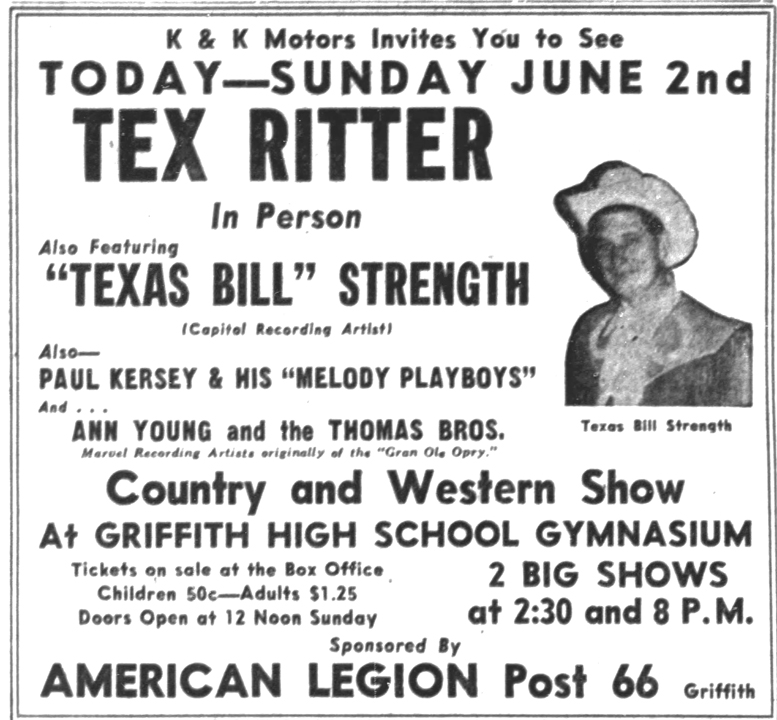
Munster, Indiana, Times, June 2, 1957
On June 14, 1957, Marvin Rainwater and TBS presented a Stage Show and Dance at the Monterey Ballroom in Owatonna, Minnesota.
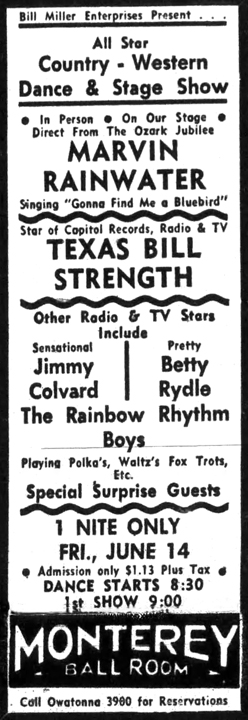
Austin Daily Herald, June 13, 1957
On the next night, June 15, 1957, the two were at the Granite City Coliseum in St. Cloud, joined by Jimmy Colvard, Betty Rydle (must be Rydell?) and the Rainbow Rhythm Boys.
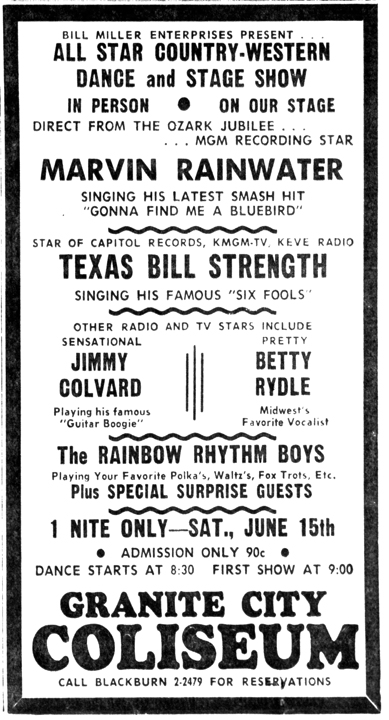
St. Cloud Times, June 14, 1957
July 1957
On July 12, 1957, TBS joined Tex Ritter at the Monterey Ballroom outside of Owatonna, Minnesota for a Stage Show and Dance. Also on the bill were:
- Jimmy Colvard
- Betty Rydell
- Milton Skeie
- Bob Steile

Rochester Post Bulletin, July 11, 1957
On July 13, 1957, TBS was back at the Granite City Coliseum in St. Cloud, again with Tex Ritter.
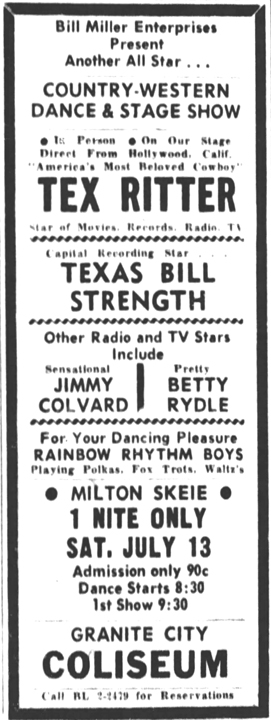
St. Cloud Times, July 11, 1957
On July 21, 1957, Red Foley and the “Ozark Jubilee” TV show cast came to Minneapolis for a big country show at Metropolitan Stadium. Much was made of the fact that the cast flew in for the date. Other performers included:
- Marvin Rainwater
- Foggy River Boys
- Shisk & Whistler
- Bill Wimberly’s band
Local entertainers included:
- David Stone, KSTP-TV
- TBS, KEVE
- Johnny T, WISK
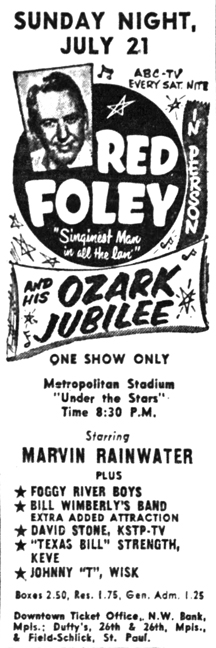
Minneapolis Tribune, July 20, 1957
On June 28 through 30, 1957, TBS and his Trio entertained at the Upper Midwest Championship Rodeo, Metropolitan Stadium in Bloomington, Minnesota. Smiley Burnett, Gene Autrey’s sidekick, was also on the program.
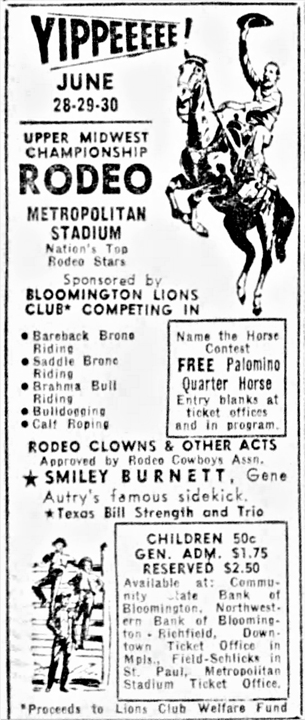
Minneapolis Tribune, June 29, 1957
August 1957
On August 9, the Monterey Ballroom hosted a big Dance and Stage Show, starring:
- Carl Perkins
- TBS
- The Rainbow Rhythm Boys
- Jimmy Colvard
- Betty Rydle (surely Betty Rydell)
- Milton Sky

Rochester Post Bulletin, August 8, 1957 On August 10, 1957, the same troupe as the night before was at the Granite City Coliseum in St. Cloud.

St. Cloud Times, August 8, 1957
On August 17, 1957, TBS played Tiny Tillman’s Happy Hollow Lake in Independence, Missouri. (Billboard, August 19, 1957)
On August 30, 1957, before the Minnesota Twins played Omaha on Appreciation Night at Met Stadium, a softball game between the Celebrities (managed by sportscaster Frank Buetel) played the Minutemen. Buetel vowed to beat the Minutemen’s two-platoon system with brute strength, so he promptly named TBS as his leadoff batter. The Celebrity lineup was:
- Bill Strength, 3b
- Roy Drusky, ss
- John Kundla, 1b
- George Mikan, cf
- Frank Buetel, p
- Wally Karbo, lf
- Dennis Stecher, rf
- Dick Nesbitt, sf
(Minneapolis Tribune, August 29, 1957)
September 1957
On September 7, 1957, TBS and his new all-girl unit, the Westernettes, play the County Fair at Madison, Minnesota, along with Tex Ritter and Smiley Burnette. (Billboard, September 2, 1957)
TBS recently shared the bill with Ernest Tubb and His Texas Troubadors at the Stillwater Speed Bowl, Stillwater, Minnesota. He invites all C&W artists passing thru the Twin Cities to visit him at his record shop at 202 South 10th Street, Minneapolis, and to appear with him on KEVE radio. Strength recently left the Capitol label and is reported dickering with Decca and Columbia. (Billboard, September 9, 1957)

Undated photo courtesy Dale Strength Bill’s wardrobe for his personal appearances was reportedly valued at over $3,200.
On September 9 – 12, 1957, the furniture store Borg and Powers, 247 Nicollet Ave. in Downtown Minneapolis, held a sale to get rid of inventory in preparation to move to a new warehouse. (Actually, the building was part of skid row and was demolished in 1961 as part of the Gateway Redevelopment Project.) To draw people to the sale, personalities from KEVE and the Flame were on hand, broadcasting from the store.
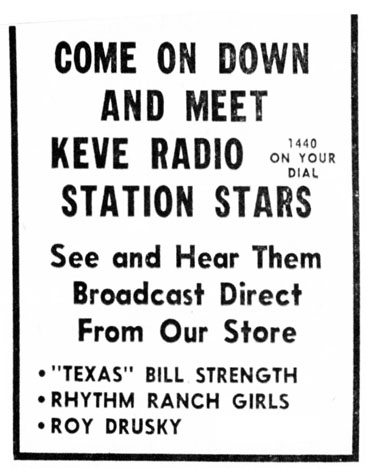
Minneapolis Tribune, September 8, 1957
November 1957
TBS, in addition to his daily deejay and TV shows over KEVE, is appearing five nights a week at the Flame. He’s again doing the booking there. Bill says he’s all set for the big blowout [disc jockey convention] in Nashville. (Billboard, November 4, 1957) He didn’t make it because he came down with the flu. (Billboard, December 23, 1957)
December 1957
From December 11 to 13, 1957, Bill Strength and Roy Drusky were back broadcasting from the Borg and Powers Furniture Store at 247 Nicollet Ave. in Minneapolis.
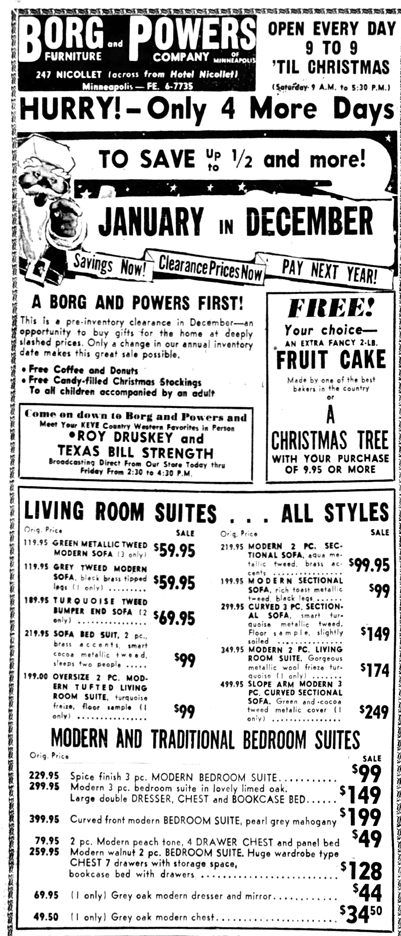
Minneapolis Star, December 11, 1957
TBS, entertainer-deejay, who still holds forth at KEVE, typewrites that he was all set to fly into Nashville for the recent deejay conclave, when he was brought down with the flu. (Billboard, December 23, 1957)
On December 31, 1957, TBS was booked for a big New Year’s Eve Country show and dance at the Minneapolis Auditorium, featuring eight recording artists:
- Jimmie Rodgers
- Porter Wagoner
- Johnny Horton
- George Morgan
- Anita Carter
- Bobby Lord
- Don Davis
- The Wagon Masters Trio – apparently Porter Wagoner’s backup band.
Doing the math, it’s unclear whether Texas Bill was the eighth artist on the bill or the master of ceremonies, as he often played that role in these types of shows.

Minneapolis Tribune, December 28, 1957
1958
Prague1Frank’s records show that TBS cut five unissued sides in 1958, titles unknown. One is identified as on the MGM label.
January 1958
A curious note in a letter from “Uncle” Jim Christie, who must have had something to do with country music, as he was writing to the Manske Sisters country fans, says “Is Bill Strength still around? Did KEVE change their signal or something? Seems like I read about some changes there.” Letter dated January 8, 1958.
February 1958
TBS, entertainer-deejay at KEVE, has been ordered by his doctor to take four-week vacation, due to physical and mental exhaustion which the doc described as the first stages of a breakdown. Now recuperating in Texas and Mexico, Texas Bill plans to resume his KEVE duties around February 15. (Billboard, February 3, 1958)
Ever the pitchman, TBS is seen in an ad for dog food.
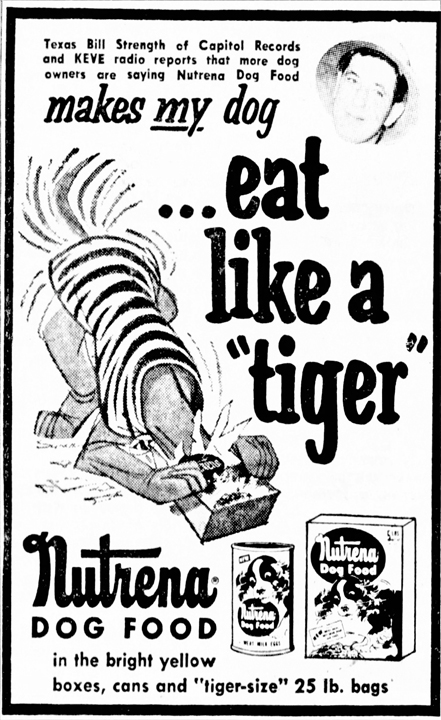
Minneapolis Tribune, February 28, 1958
April 1958
DISENCHANTMENT WITH MINNEAPOLIS
In his April 2, 1958, column, Will Jones reported:
This has been a week of sudden departures in the radio business. Texas Bill Strength left KEVE and the country-western Flame Cafe after a flareup, and was replaced Monday [March 31] at both places by Dave Dudley, country-western singer and disk jockey from Duluth (by way of Chicago and Nashville, Tenn.)
Billboard also reported major changes in Bill’s life:
TBS has set it down at the Vasser Grove Trailer Park, Hopkins, after taking departure from Minneapolis, where he resigned his deejay post at KEVE. Says he has been planning getting out of the disk jockey business for some time in an effort to build his status as a C&W artist. Bill put in most of last week in Chicago, while playing a Calumet City, Illinois, nitery. He reports that he cut a session recently, with the release due soon on either Columbia or Decca.
He also gave up his emsee job at the Flame. Texas Bill says his Minneapolis exodus was not due to a flare-up or conflict as one of the columnists there state, but rather due to health reasons.
Strength says he also has disposed of his record shop in Minneapolis and that he is contemplating a change of scenery and atmosphere.
(April 21, 1958)
ABDUCTION
Sometime between May 1957 and 1958, Bill’s wife Dorothy left Bill and took the kids back to Houston. Bill decided that he wanted the boys with him, and he abducted them from their Aunt’s house in Houston, where Dorothy was living. He didn’t take their sister Sandy, because she was born blind, and he didn’t feel he could give her the help she needed. (She eventually had operations that allowed her to see just fine.)
Dorothy hired a detective to track the the boys down, but TBS kept them hidden by placing them with various friends while he performed around the country. The detective could find Bill, but not the boys. He got word that the authorities had already been to their Grandma Jessie’s place (Bill’s mother) looking for them, and Bill thought it would be safe to let them stay there for a few weeks while he did some show dates. He eventually picked them up and they moved on from there.
Eight-year-old Dale took the photo below of his Grandma Jessie and brother Bobby, a few months after after the abduction. A 1958 directory showed William, Sr. and Jessie living at 1277 Sheffield, in Houston, a house Dale described as a shack. WT was listed as a carpenter. Dale described the place like this:
During the summer of 1958 Bob and I spent a few weeks on Sheffield Boulevard in Houston at Grandma and Grandpa Strength’s place. They lived in something called a “Court,” as in trailer court, but instead of trailers there were a half a dozen or so identical shacks all in a row down a dirt drive in the middle of an industrial neighborhood. There were plenty of trees on the couple of acres where the shacks stood and a small woodland nearby where Bob and I would play. But mostly industrial buildings dotted the neighborhood.
In hindsight the “house” kind of had that “Grapes of Wrath” vibe to it, but we didn’t know or care. They were pretty basic structures with indoor plumbing. I fortunately have one picture of the place that I took with my Dad’s black and white Polaroid camera, the newest and coolest thing to have at the time. The “house” was built up on columns of cinder blocks a couple of feet off the ground. I remember Bob and I exploring and playing under the house. The floors were wood and I recall being able to see the ground through some of the cracks, except where there was linoleum. The kind that came in big rolls and you spread it on the floor like a carpet. Grandma Jessie had a faux oriental rug theme that I thought was really pretty. I really liked the colors and designs.
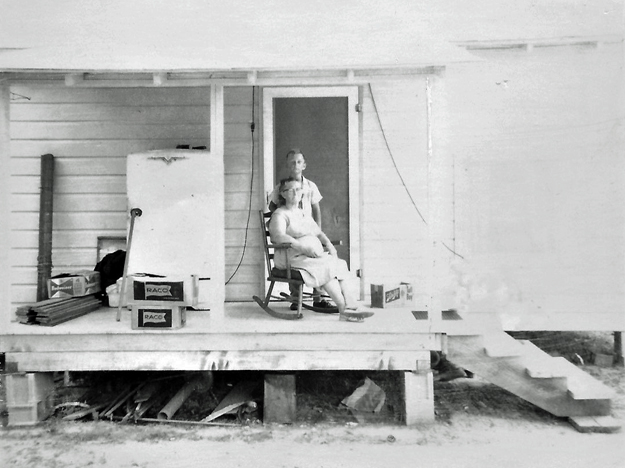
Photos courtesy Dale Strength
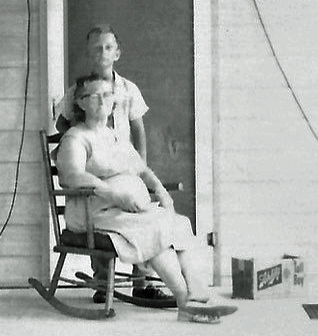
The boys eventually lived with the family of “Ma and Pa Norrbom,” whose daughter Mary was the manager of the Flame.
A 1959 Minneapolis directory listed TBS living at 2514 15th Ave. So. His occupation was listed as “entertainer.” By 1959 he had already moved to California, but this may have been a good address for at least part of 1958.
May 1958
In May and June, 1958, TBS played a series of week stands in Midwest niteries. (Billboard June 30, 1958)
Milwaukee’s Cackle Shack may have been one of them. Although this ad came without a year, and the Cackle Shack didn’t come up in a newspaper search, TBS was on Capitol Records from 1955 to 1957, and May 31 fell on a Saturday in 1958, so that’s our best guess.
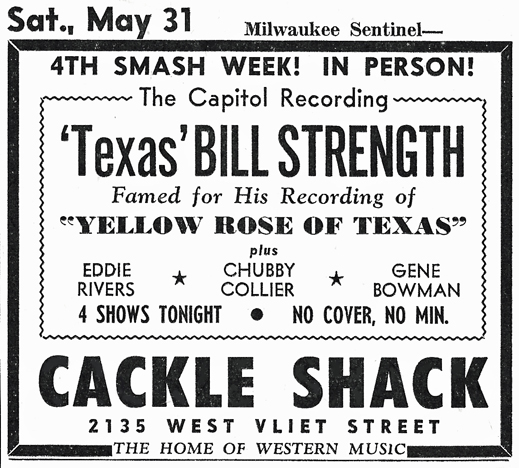
Ad courtesy Dale Strength
June 1958
On June 29, 1958, TBS appeared at the World’s Championship Rodeo at Crystal Springs Ranch, Clear Lake, South Dakota, along with Smiley Burnett, Johnny White, and the Sons of the West, of WELO-TV, Sioux Falls. (Billboard, June 30, 1958)
TBS has planted roots at KISD, Sioux Falls, South Dakota, where he’s doing three and a half hours of C&W music a night. He asks that artists and record companies take note of his new location. (Billboard, June 30, 1958)
July 1958
On July 28, 1958, TBS was in Sioux Falls, South Dakota, performing in a Hometown Jamboree at the Community Playhouse. Other acts were:
- Curtis and Marvin, “Western Melodiers”
- The Caddies
- Harry Schutte
- Rocky Mountain Playboys
- Harvey and Andy
- Curtis and Marvin
- Hezzy Jones
- Walt and Johnny
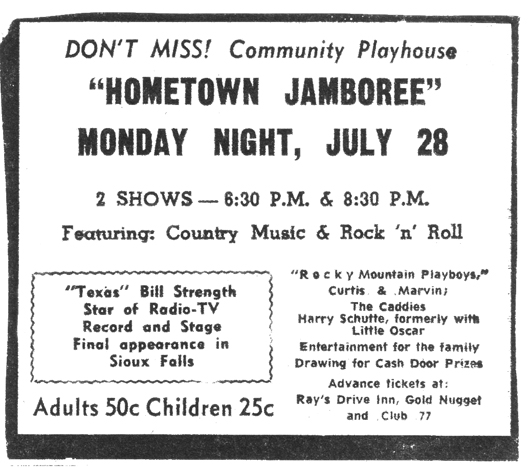
Sioux Falls Argus Leader, July 28, 1958
August 1958
On August 2, 1958, TBS appeared on “Big D Jamboree” in Dallas, sharing the spotlight with:
- Martha Carson
- Wally Fowler
- The Johnson Sisters
- Roy Carter
- Harvey and Andy
While in the Western Country, Texas Bill visited with Mac Sanders and Hiram Higsley at KSIR, Witchita. He also visited Hank and Dorothy Thompson at their home in Oklahoma City. (Billboard, August 11, 1958)
TBS has been roamin’ the country far and wide on personals since leaving his deejay chores at KEVE several months ago. (Billboard, August 11, 1958) [KEVE changed its format to classical in 1961.]
September 1958
On September 19, 1958, TBS was back in Houston at Cook’s Hoedown Club.
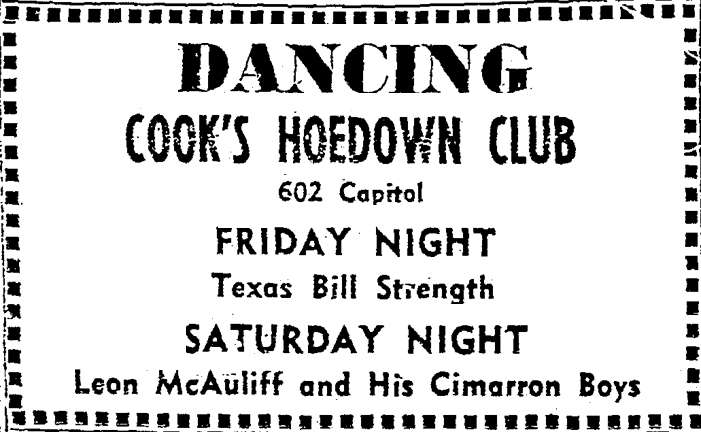
Houston Chronicle, September 1958
On September 27, 1958, TBS performed on “Louisiana Hayride” in Shreveport, Louisiana. Other performers on the show were:
- Charlie Phillips
- Mel Tillis
- Johnny Dollar
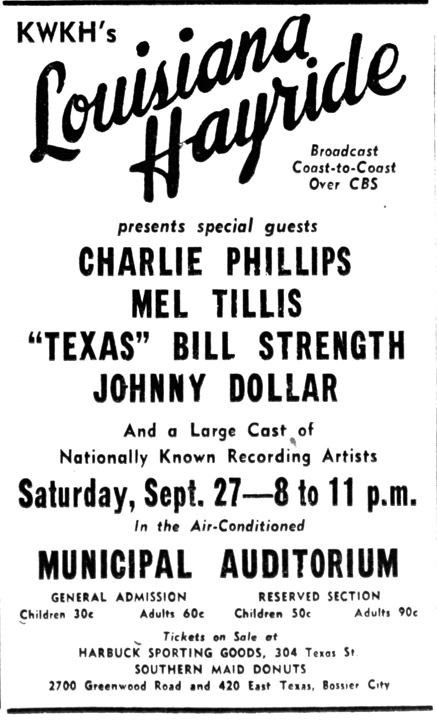
Shreveport Times, September 26, 1958
October 1958
RED FOLEY
TBS did a guest stint on Red Foley’s “[Ozark] Jubilee U.S.A.” at Springfield, Missouri, on October 11, 1958, which goes out over the TV lanes on October 13. (Billboard, October 13, 1958)
TBS scribbles that he’s been constantly on the go the last several months, trying to beat the depression. He says he’s a sure shot to make the big C&W deejay convention in Nashville November 21-22, 1958. (Billboard, October 13, 1958)
CALIFORNIA
In late 1958, TBS and the boys made the move to California, living in Long Beach and working for KFOX, “the Only 100 Percent Country-Western Music Station in Southern California.” He kept an office at 5927 Sunset Boulevard in Hollywood. (Ronnie Pugh)
The ad below apparently announces a new format for KFOX. The mess at the top that you can’t read says THE in front of FOX, and GOES WESTERN below that. This was quite a find but difficult to clean up – faces are always troublesome and my photoshop doesn’t do what it used to do. But this gives us a time frame for when he was at KFOX in California.

Long Beach Independent, August 5, 1959 Another interesting thing about this ad is that TBS worked with Joe Allison. From June 29, 1957 to April 11, 1959, Joe was the host of a local show in Los Angeles called Country America. At the time, Joe was or had been a DJ at station KRKD. An undated list of Texas Bill’s “Recent Appearances” included a guest appearance on Country America, although a newspaper search of guest stars did not find him. It may have been that Bill could have gotten the DJ job at KFOX with a little help from his friend Joe. Just speculating.
December 1958
Jan Sherman of the North Sisters remembered that TBS have she and her partner Patti each cowboy hats, and sent along a picture of the card that came with the hat. It is dated December 16, 1958.

Courtesy Jan Sherman TBS, the “Denver Dragon,” spent the holidays with the home folks in Houston. (Billboard, January 5, 1959)
1959
February 1959
On February 16 and 17, 1959, TBS, the Rhythm Ranger Quartet, Betty Rydell, and Betty Holmer played the Turf Bar in Austin, Minnesota.
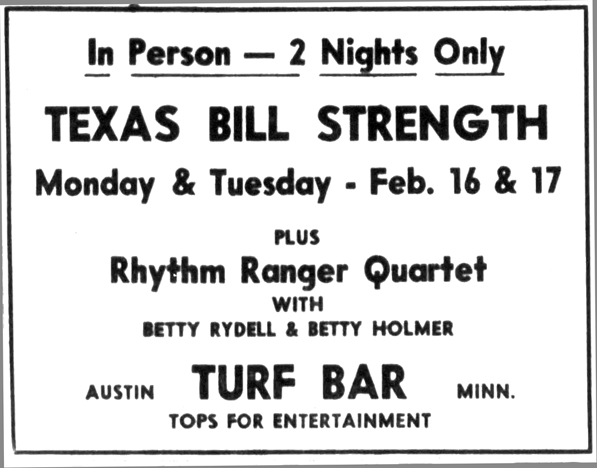
Albert Lea Tribune, February 15, 1959
March 1959
On March 5, 1959, TBS played the Manger Club in El Monte, California. (Billboard, March 16, 1959)
On March 8, 1959, TBS did a live broadcast at Riverside Rancho, Hollywood, with the Squeekin’ Deacon Moore show over KXLA. (Billboard, March 16, 1959)
On March 9, 1959, TBS showed his wares at the Crow’s Nest, Oxnard, California. (Billboard, March 16, 1959)
On March 13, 1959, TBS played Laramie, Wyoming. (Billboard, March 16, 1959)
TBS, who has been hopping hither and yon for the last 10 months, reports from Hollywood that the breaks are finally coming his way, when MGM slates to issue its first release on him almost any day now. [There are no known releases on MGM Records.] (Billboard, March 16, 1959)
TBS recently appeared with Hank Penny and Wade Ray’s band at the Goden Nugget, Las Vegas. (Billboard, March 16, 1959)
On March 16, 1959, TBS begins a six-week stand at Brady’s in Minneapolis. (Billboard, March 16, 1959)
April 1959
On April 13, 1959, Cedric Adams of the Minneapolis Star reported that “Brady’s on 6th is still pitching western with the Rhythm Rangers quartet plus TBS, whose first Capitol recording of “Yellow Rose of Texas” became a national hit. Strength was also one of the popular stars on Grand Ole Opry.”
May 1959
In May 1959, TBS worked three dates with George Jones and Wanda Jackson in Minnesota. (Billboard, June 1, 1959)
On May 23, 1959, TBS hopped into Houston for a guest shot on the new “Texas Jamboree.” (Billboard, June 1, 1959)
On May 24, 1959, TBS made an appearance at Magnolia Gardens in Houston. He then jumped from Houston to the West Coast, where he’ll work out a string of dates before heading back to his Minneapolis headquarters. (Billboard, June 1, 1959)
June 1959
In the first week in June, 1959, TBS hops to Alaska for a 10-day trek. (Billboard, March 16, 1959)
JACKIE YOUNG
On June 20, 1959, TBS married Jacqueline Ann Young (nee Stanford) in San Diego. Jackie was from Houston and an avid Country music fan, acting at one time as the secretary of the George Jones Fan Club. (Ronnie Pugh) One report said that by 1965 she had been married four times; one of her husbands was Andrew Jackson Young.
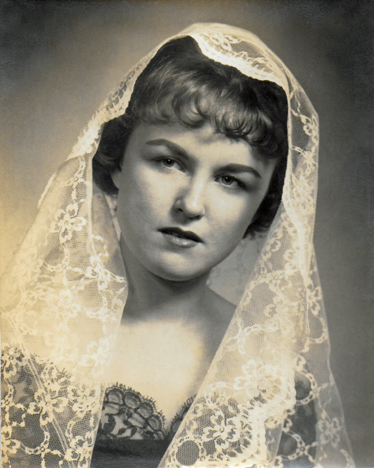
Photo courtesy Dale Strength The photo below shows Jackie, Bill, and Country performer Floyd Tillman. Tillman’s name was on the marriage certificate as a witness, and may have been the best man. This photo would have been taken on or near the wedding day.
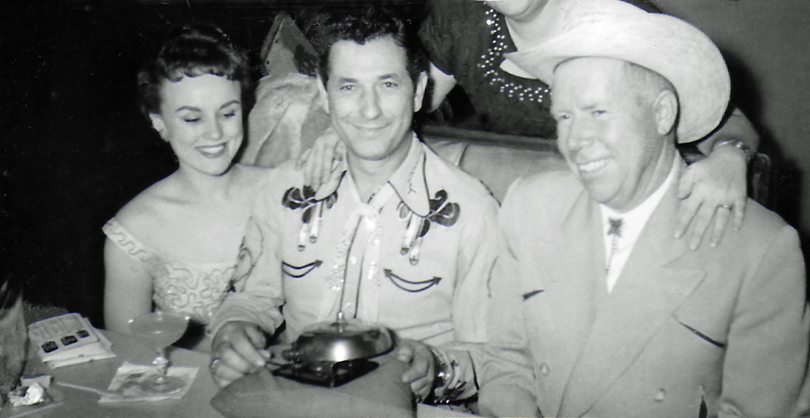
Bill’s sons Dale and Bobby lived with him in California, and remember having some fun times with Jackie.
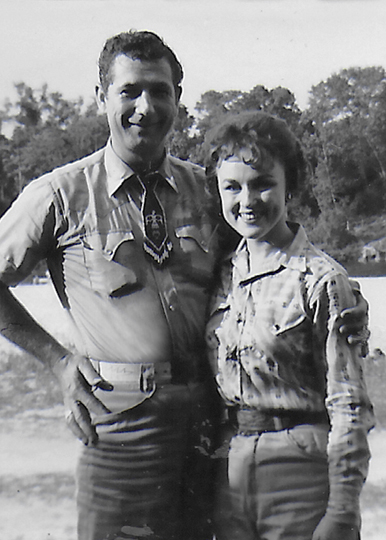
Photo courtesy Dale Strength
Excuse Me
By the fall of 1959, TBS’s marriage to Jackie had fallen apart. Ronnie Pugh described her packing for her departure back to Houston and George Jones’s Fan Club while the couple was being visited by Harlan Howard and Wynn Stewart. Howard told this story to Rich Kienzle:
Wynn and I were trying to figure out how in the hell to get out of there because it was embarrassing. Finally Bill stood up and said, “Well, you guys’ll have to excuse me. I think I’ve got a heartache.” And he walked into the bedroom. Wynn and I left and were drivin’ away and I said, “Wynn, that’s a hell of a song title.” . . . A week or two later I jotted it down like I usually do and I told Buck [Owens] about it . . . “
Buck Owens recorded the song “Excuse Me (I Think I’ve Got a Heartache)” on December 23, 1959, and it became a No. 2 hit in the fall of 1960. TBS got no royalties for his title or his pain.
Despite the divorce, TBS and Jackie continued to have a hot and cold relationship. A letter from Jackie found in his archives, dated July 14, 1963, indicates that they had just been together (perhaps in California). Her words indicated that she had done something to make him doubt her fidelity, and she pledged her love to Bill in no uncertain terms, even suggesting that they remarry in the future. After that meeting, Bill returned to Minneapolis and Jackie flew back to Houston.
Jackie Young’s Murder
On Saturday, November 6, 1965, Jackie’s lifeless body was found in the back of her sports car in a pasture, “Four miles south, Highway 146 near La Porte.” She was 25 years old. Her death certificate shows that the immediate cause of her death was asphyxia due to strangulation. Her father reported that she had been a secretary in the steel industry.
A UPI article dated November 7, 1965, described her as a “secretary who wanted to be a country singer.” She died of one or more blows at the base of her skull, according to the medical examiner. A tire tool, the possible murder weapon, was found 62 feet from the car. It was later determined that the tire iron was from the trunk of her car.
On December 11, 1965, Billboard reported that TBS made a trip to Houston from St. Paul to aid the sheriff’s department in solving the mystery. On the night she was killed, Miss Young had attended a dance near LaPorte, a small resort town on Galveston Bay, at which George Jones and band were featured. The Jones band members, who were among the last to see Miss Young alive, were questioned and released.
TBS was told by the police that Jackie had been driving home and was drunk when she stopped for gas, so an attendant offered to drive her or forced his way into her car. He pulled off the road, and his attempt to sexually assault her were met with a ferocious battle, given the skin and blood under her fingertips. TBS was devastated, and reported to Billboard that he and Jackie had set a date to be remarried on February 20, 1966.
On June 6, 1966, Victor Eugene Miller, 21, was arrested in the Dallas suburb of Mesquite, and the next day he was indicted for the murder. He was described as an ex-convict living in West Memphis, Arkansas. He had indeed worked as an auto mechanic in the Houston area and had served time for breaking and entering and larceny in North Carolina. (AP report)
On March 18, 1967, Billboard reported that TBS was in Houston recently to attend the trial of the man arrested in the murder of Jackie. The trial was originally supposed to start on March 13, but was delayed when Miller’s court-appointed lawyers “angered the judge by submitting a thick stack of pre-trial motions.” The trial was postponed to June 5, 1967. (Lubbock Avalanche Journal, June 6, 1967)
On May 7, 1967, Miller and two other prisoners in a new Harris County jail complex escaped through an open window and pressed a button that released a lock on a door leading outside. Miller supposedly had been assigned as a trustee on duty in a recreation room, according to the Liberty (Texas) Vindicator. The three were tracked down by bloodhounds and caught in woods four hours later about a mile from the jail. (AP report)
On July 13, 1967, a UPI story told the tale of a 21-year-old former Mexican night club hostess and exotic dancer who had been held in jail as a material witness for ten months. Juanita Gallardo Garcia was released on bond pending the trial, now set for August 21, 1967. Ms. Garcia had met Miller in Mexico in 1964. They fell in love, and swam the Rio Grande two weeks later. They lived in Charlotte, North Carolina for eight months, and Pasadena, Texas for almost a year before being separated accidentally in January 1966. They were reunited three days after he was jailed in June 1966. (UPI report)
After several postponements, the trial was set for August 21, 1967.
On September 1, 1967, Miller was found guilty of murder. Although the prosecution “vehemently demanded the death penalty,” the jury recommended he be given a life sentence. Miller, who had first admitted the slaying “to news media, police officers and others” (Liberty Vindicator) and then repudiated the admission, said he would seek a new trial. “I believe I’ll get justice somewhere along the line,” he was quoted as saying. He claimed to newsmen that he had never seen Mrs. Young. Jackie was described as a “four-time divorcee, last seen alive in the camper wagon of a Western music performer.” (AP report)
In 1968, the Liberty Vindicator printed a story that boasted of Liberty Attorney Boots Krueger, one of the defense lawyers for Miller. The sensational article said that the “attractive” “young divorcee” was found “strangled and brutally beaten.” The story of the murder trial was covered in a nationally distributed magazine, the Vindicator went on, and crowed that the verdict was a success since Miller did not get a death sentence. Thanks to the lawyer from Liberty. (All references to the Liberty Vidicator from March 28, 1968)
Thus ends the sad saga of Texas Bill’s second wife Jackie.
Back to 1959
TBS is currently filling some dates for Steve Stebbins, of Americana Corporation, Woodland Hills, California, and plans to remain on the West Coast for some time. (Billboard, June 22, 1959)
TBS typewrites from Hollywood that he’s set on a long string of club dates up and down the Coast by Steve Stebbins and that he plans to remain in that area indefinitely. (Billboard, June 29, 1959)
October 1959
On October 19 and 27, 1959, TBS broadcast on KFOX from 11:30 to midnight, as reported by the Long Beach Independent.
December 1959
On December 31, 1959, TBS was back in Minneapolis, at least for New Year’s Eve, as he hosted a huge New Year’s Eve show featuring:
- Jimmie Rodgers
- Porter Wagoner
- Johnny Horton
- George Morgan
- Anita Carter
- Bobby Lord
- Don Davis

Minneapolis Tribune, December 27, 1959
1960
A 1960 directory lists TBS living at 755 Orange Ave. in Long Beach with wife Jackie. His occupation is listed as Disc Jockey, KFOX. Either the directory was behind or Jackie was around longer than the fall of 1959.
An ad in the 1960 Country Music Who’s Who claimed that he was “soon to be heard on Challenge Records,” but that never panned out. (Ronnie Pugh)
January 1960
On January 21, 1960, TBS made one of his first appearances at The Big Fresno Barn. At this show he shared the stage with Cousin Herb Henson (a fellow DJ) and his Trading Post Gang.
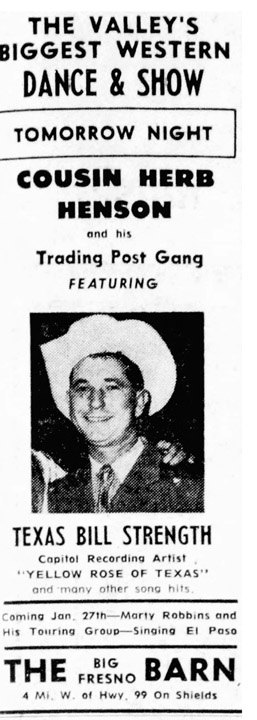
Fresno Bee The Republican, Friday, January 22, 1960 TBS has transferred his activity from KFOX, Long Beach, to KIKK, Bakersfield, where he is serving as program director and deejay. In addition, Texas Bill does a daily stint with Cousin Herb Henson on KERO-TV in the same city. Strength asks that artists and diskeries put him on the list for samples of new releases. (Billboard, January 25, 1960)
February 1960
On February 13, 1960, TBS headlined the dance and show at the Big Fresno Barn.

Fresno Bee, February 13, 1960 On February 19, 1960, TBS was on the bill with Ray Price and Pauline Parker at the Big Fresno Barn.
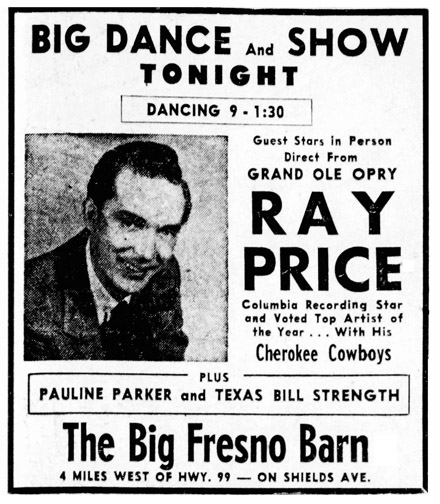
Fresno Bee The Republican, Friday, February 19, 1960
March 1960
On March 12, 1960, TBS was back at the Big Fresno Barn, this time again as the headliner.
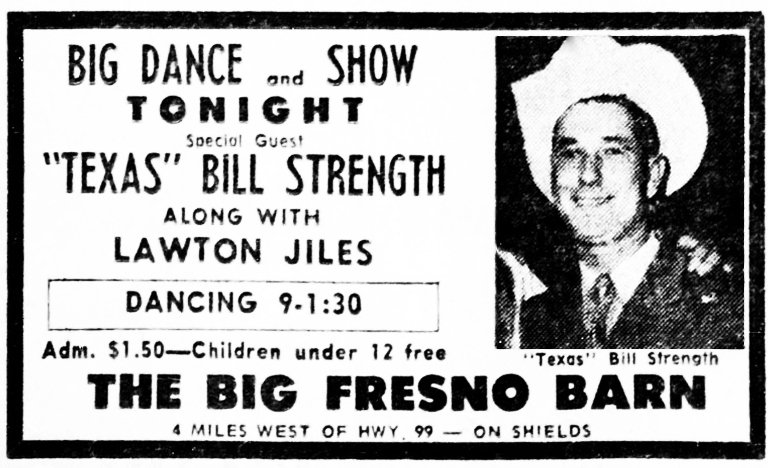
Fresno Bee, March 12, 1960 TBS, now on the staff of KUZZ, Bakersfield, requested that artists send him station breaks and their new records. (Billboard, March 28, 1960)
May 1960
On May 8, 1960, there was an open house at the Kaehn household, for TBS who was visiting in the area. He was on a personal appearance tour, and stopped off here, and rejoined the tour on the 9th in Texas. (Manske Sisters newsletter, May 22, 1960)
TBS was a guest on KCUL, Fort Worth, recently, en route from California to Minneapolis. (Billboard, May 9, 1960)
SUN RECORDS
July 1960
At the invitation of Sun Records promotional manager Cecil Scaife, TBS went to Memphis to record seven sides for the label on July 19, 1960. These were not made at the original Sun Studios at 706 Union Ave., but at Sam Phillips’ new recording studio, a few blocks away at 639 Madison Ave. Scotty Moore wrote on his website that the new studio had been in use off and on as early as January 1960 but was officially was launched on September 17, 1960. The producer is unknown, but the recording engineer was Charles Underwood.
Frank lists the personnel on these sides as:
- Bill Strength – Vocal and Guitar
- Scotty Moore – Guitar
- Stan Kesler – Steel Guitar
- R.W. “T-Willie” Stevenson – Six String Bass
- D.J. Fontana – Drums
- Larry Muhoberac – Piano
- The Gene Lowery Singers
You might notice that the list above includes the members of Elvis’ original band.
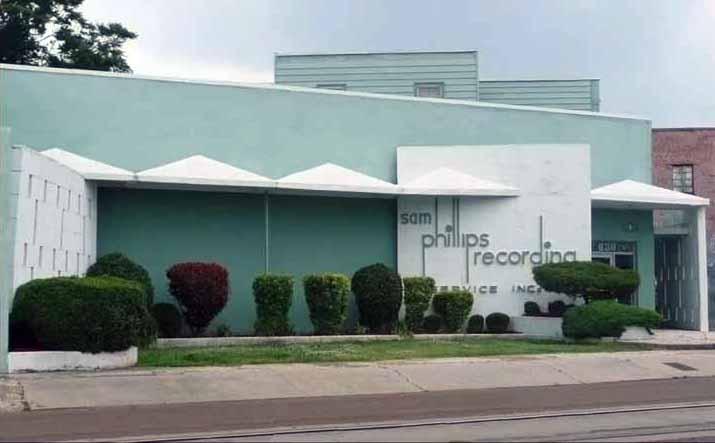
1960 As many as seven sides were recorded.
TBS’s only Sun record, Number 346, was issued in September 1960. It was reviewed by Billboard on October 3, 1960.
- “Guess I’d Better Go” – TBS has a strong side here. It’s in the best weeper tradition, with a country-oriented performance which can nevertheless go to pop.”
- b/w “Senorita” – “A bouncy side, with a Tex-Mex flavor. Contrasts sharply with the flip.”

“Guess I’d Better Go” 
“Senorita”
- “Call of the Wild” was included on TBS’s Greatest Hits album, identified with the recording date of 1960. That may be the version recorded at Sun. It was also issued as a 45 on Twin Town Records in 1965, which may have been a re-recording. That version is available on YouTube. Interestingly, the writing credit for “Call of the Wild” was attributed to Cecil Scaife.
- “You Can’t Hurt Me Anymore” was written by TBS. In 2006, this song was released on a Sun Compilation record called “Sun Hillbilly.” This song can also be heard on YouTube.
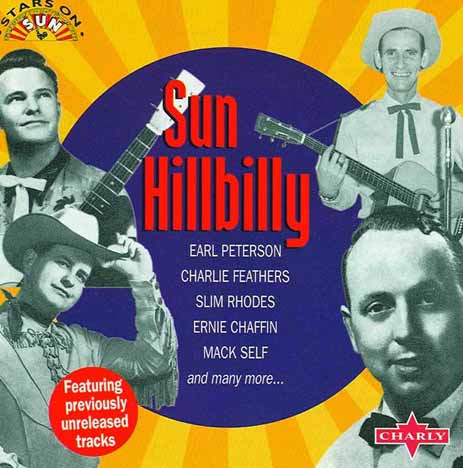
- “Nothing is Sweeter Than You” was released in 1973 on Brite Star, perhaps a re-recorded version.
- “Timber Man”
- “No More Listening”
Frank says “It is possible that some of the above recordings may have been recorded at a session held at Sun Studio on May 15, 1961. Alternatively, this may have been an overdub session.”
August 1960
TBS is back in Hollywood after a jaunt that took him to Chicago, Minneapolis, Houston, and, most recently, Memphis, where he signed a recording pact with Sun Records. His first release for Sun is due out in two weeks. (Billboard, August 22, 1960)
Strength will work club dates on the Coast until Nashville convention time in November, after which he plans to return to Minneapolis.
TOPPA RECORDS
In August 1960, TBS recorded two sides for the Toppa label, of Covina, California. Songs feature the steel guitar of Ralph Mooney.
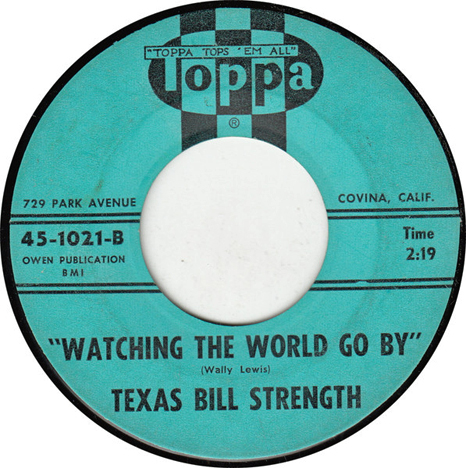
“Watching the World Go By” 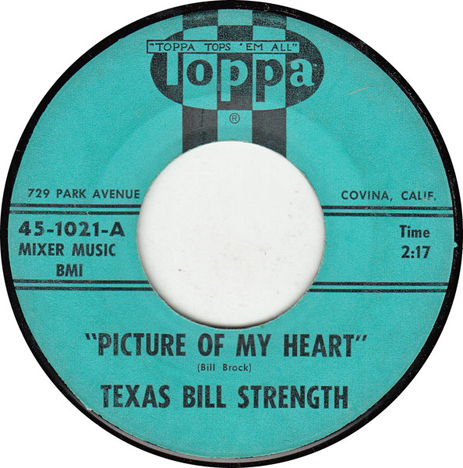
“Picture of My Heart” Billboard reviewed Toppa Record 1021 on August 22, 1960:
- “Watching the World Go By” – “The Texas singer handles this country novelty in good fashion as he explains that he’s lonesome.”
- b/w “Picture of My Heart” – “On this weeper the singer comes thru with a warm vocal, aided by good backing. Listenable waxing.”
This one’s a little strange. Bill was awaiting the release of his two Sun sides in August 1960 that he recorded on July 19, 1960. On August 22, 1960, Billboard reported, “Meanwhile, he is plugging a new release on the Toppa Records label, of Covina, California, coupling “Watching the World Go By” and “Picture of My Heart.”” TBS would have another Sun session on May 15, 1961. Wouldn’t it be unusual to be signed with two record companies at the same time?
September 1960
On September 10, 1960, TBS was a guest star at Tom and Bill’s Palomino Club, Los Angeles’s Largest Western Night Club, located in North Hollywood.
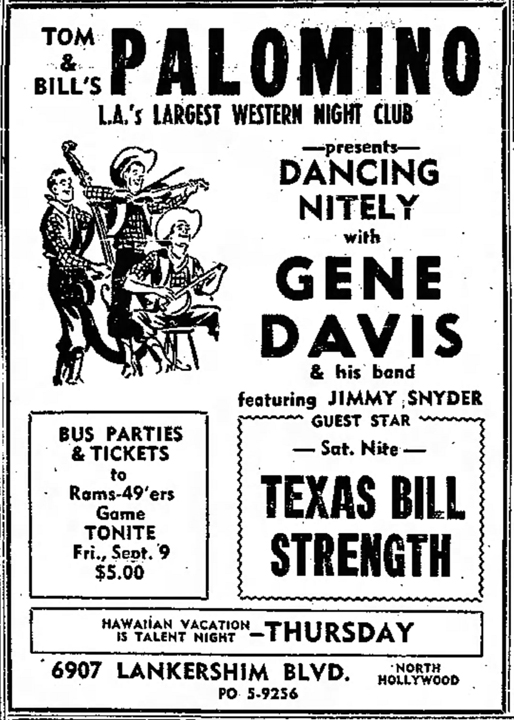
Valley News, Van Nuys, California, September 9, 1960
In September 1960, TBS Registered as a Democrat in Orange County. His address was 7681 El Monte Drive, Buena Park, California.
October 1960
On October 8, 1960, TBS entertained the Okies in Ventura County on a big Saturday night.
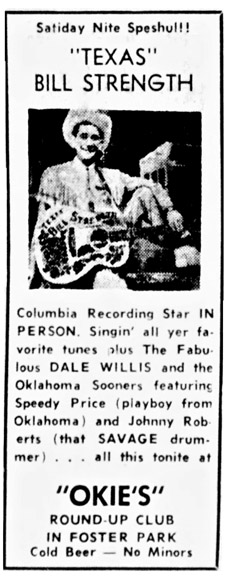
Ventura County Star Free Press, Friday, October 7, 1960 TBS spent four days in the San Francisco sector last week, playing dates for Blackjack Wayne and making radio and TV personals on KNBA, Vallejo, California. Bill, who is presently kicking up dust with his new Sun release, “Guess I Better Go,” will make the country music festival in Nashville November 4-5, after which he plays dates in Tucson and Phoenix with Merle Travis, booked by Raymac Enterprises, Anaheim, which also handles Skeets McDonald, Joe Maphis, Eddie Dean, Johnny Bond, Bonnie Sloan and Rose Maddox. (Billboard, October 24, 1960)
Skeets McDonald placed an ad thanking (disk jockeys?) for putting his song “This Old Heart” on the charts. “also my deepest thanks for your help on “Guess I’d Better Go” TBS (Sun Records).” (Billboard, October 31, 1960) This is curious, since they were on two different labels and McDonald wasn’t a writer of the song.
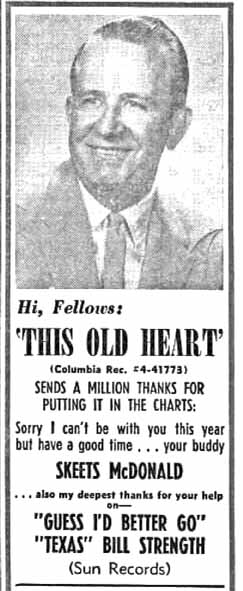
November 1960
TBS had the first of three appearances at the Tucson Gardens on November 11, 1960, along with Bonnie Sloan. Ads were placed in Phoenix and Tucson papers.
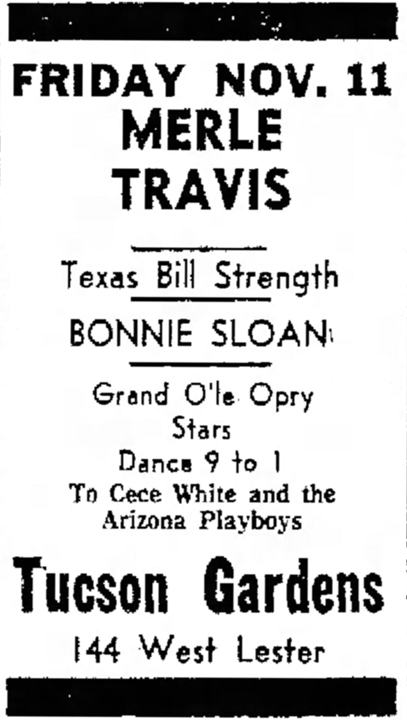
Tucson Daily Citizen, November 11, 1960
Bill returned to the Palomino as a Special Guest Star on November 19, 1960.
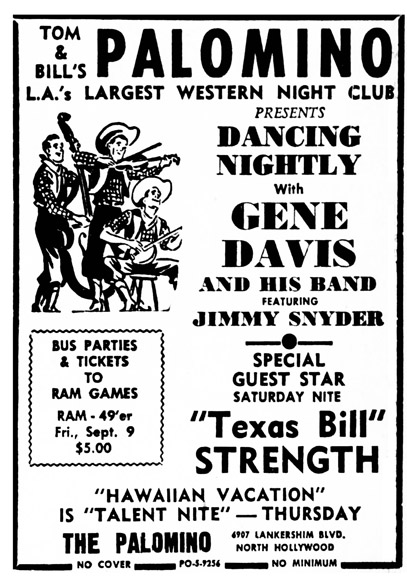
Valley Times Today, North Hollywood, Friday, November 18, 1960
1961
January 1961
SUN RECORDS
TBS departed Anchorage, Alaska, January 16, 1961, for Memphis to cut another session for Sun Records. Texas Bill, together with Bonnie Sloan, played the Montana Club in Anchorage, with appearances on KENI-TV, KFOD and KBYR. The Montana Club is located at 222 Fourth Avenue, Anchorage. The Sun Records firm, which recently knocked the “Texas” off of Bill Strength’s name, will revert to the Texas Bill billing when they spring with his new release. (Billboard, January 23, 1961)
If there were any records released from such a session, they don’t seem to be listed anywhere.
February 1961
The second ad found for the Tucson Gardens was for February 24, 1961.

Tucson Daily Citizen, February 24, 1961
April 1961
On April 22, 1961, TBS worked the Grand Ole Opry in Nashville. (Billboard, May 15, 1961)
On April 29, 1961, TBS worked the Big D Jamboree in Dallas. (Billboard, May 15, 1961)
May 1961
On May 5, 1961, TBS appeared at Todd’s Western Club in Fort Worth.
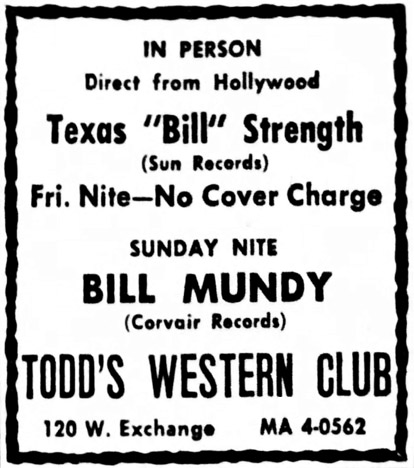
Fort Worth Star Telegram, May 5, 1961 On May 6, 1961, TBS worked the Cowtown Jubilee in Fort Worth. (Billboard, May 15, 1961)
SUN RECORDS
Bill Strength has just finished another session for Sam Phillips’s Sun Records, with release due any day now. (Billboard, May 15, 1961)
TBS’s third performance at the Tucson Gardens was on May 27, 1961.

Tucson Daily Citizen, May 27, 1961
June 1961
TBS landed in Chicago last week after playing a string of engagements in and around his native Houston. En route to the Windy City, Bill stopped off in Tucson for a stand at Tucson Gardens (see above) and appearances over KUUN-TV and KMOP Radio. (Billboard, June 12, 1961)
September 1961
On September 6, 1961, TBS was apparently appearing at the Frontier Bar in Madison, Wisconsin, although this ad is confusing. It is from the Wisconsin State Journal, which is/was published in Madison.
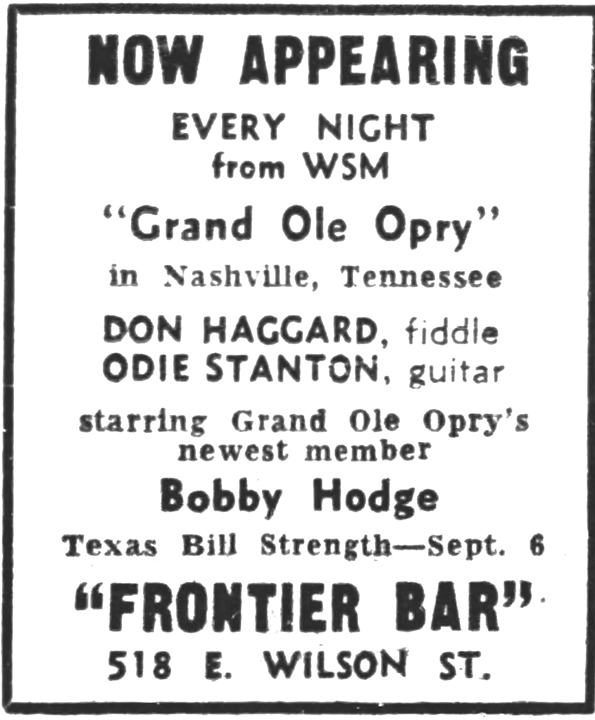
Wisconsin State Journal, September 6, 1961
BACK TO MINNESOTA
Six years after he had first come to Minnesota, TBS was back, this time to stay. When asked why he had returned in a 1970 interview, he responded, “Well, KTCR had just started with country music so I could go to work for them. Beside, Minneapolis and its people have always been good to me.”
This is a fun find. Dale had the photo below, of his dad with the North Sisters at a personal appearance, with no date. Appears to be at one of the many car dealers on Lake Street. Years later, Jan Sherman (North) came up with a similar photo, obviously taken at the same event. This time she could name the year, and because the photo had Stonewall Jackson in the lineup, a quick look at the Flame appearance spreadsheet allowed us to deduce that the date was September 16, 1961!
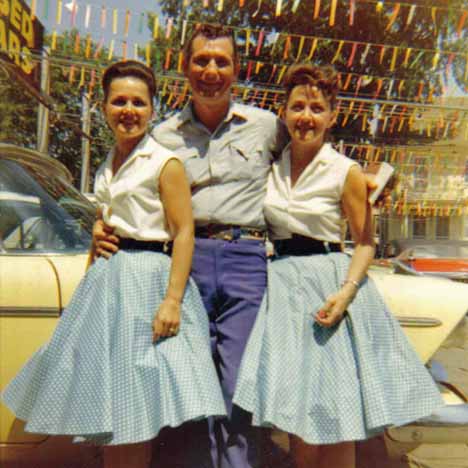
Jan, Bill, and Patti. Photo courtesy Dale Strength 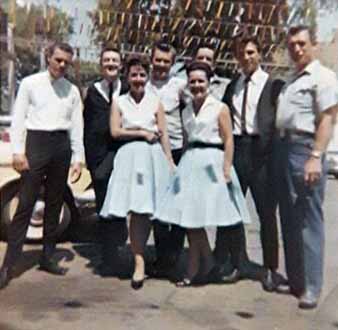
Picture above: Back Row, No. 1 & 4: Members of Chill Hilmin’s band; No. 2: Duke Larson; 3: Stonewall Jackson; 5: Chill Hilmin; 6: TBS. Front: Jan and Patti North. Photo courtesy Jan Sherman
TBS appeared at the Montana Club in Anchorage, Alaska. The add below is dated September 21, 1961. The ad says he was appearing through October 8.
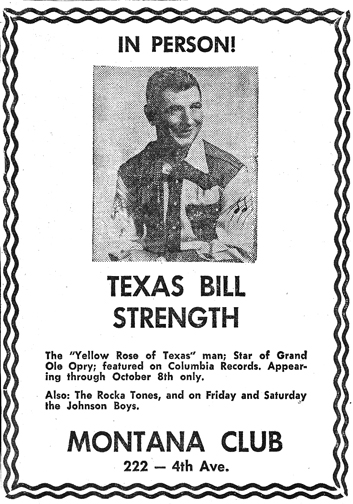
Ad courtesy Dale Strength
Billboard indicated that TBS had been at the Montana Club back in January 1961. The ad below could have been from either appearances or even another one – apparently Alaska was one of Bill’s favorite retreats.
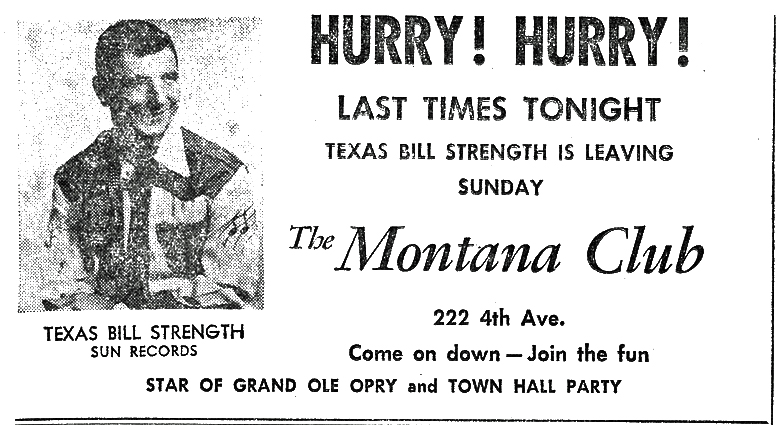
Ad courtesy Dale Strength
November 1961
Jimmy Simpson, of Radio Alaska, Anchorage, reports that Lefty Frizzell and TBS are scoring handsomely on personals in the Anchorage area. Jimmy had them as recent visitors on his air show. (Billboard, November 13, 1961) This must have been before TBS started his job as “permanent emcee” at the Loon.
THE LOON
From November 7 to 12, 1961, Pee Wee King and Redd Stewart were featured at a new C&W club, the Loon, which has made its bow at 2935 Nicollet Ave., Minneapolis, with TBS as permanent emsee. Owned by the operator of the present Torch Club there, the Loon operates Tuesday through Sunday, with Sunday shows starting at 4 pm. (Billboard, November 20, 1961)
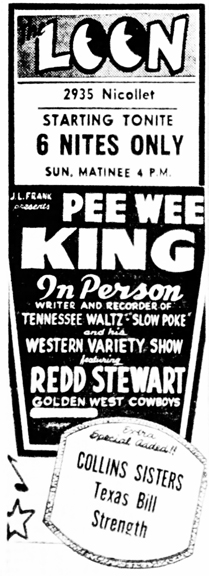
Minneapolis Tribune, November 7, 1961
From November 14 to 19, 1961, Lonzo and Oscar were featured at the Loon, with TBS as emsee. (Billboard, November 20, 1961)
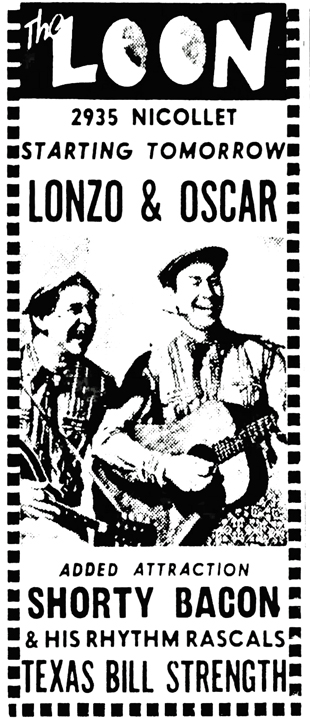
Minneapolis Star, November 13, 1961
The ad below is only for Shorty Bacon at the Loon on November 15, 1961, with TBS, “Minneapolis’ Favorite Son,” also on the bill. (Billboard, November 20, 1961)
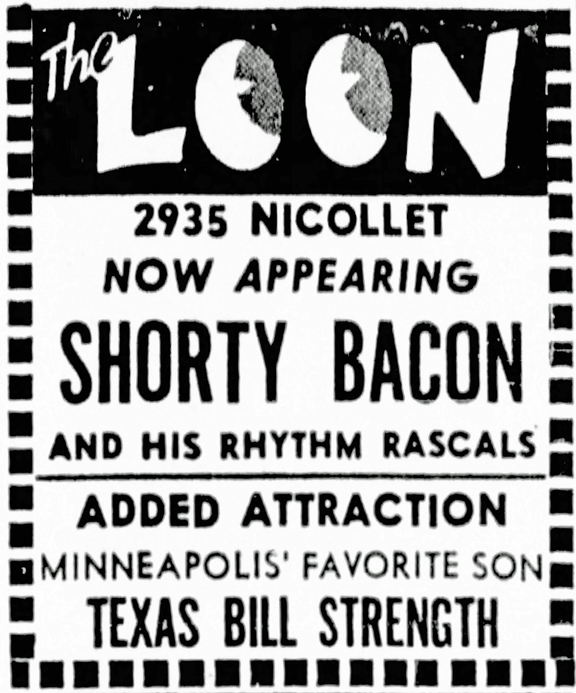
Minneapolis Tribune, Wednesday, November 15, 1961 Jerry Reed performed at the Loon on November 21 to 26, 1961. (Billboard, November 20, 1961)
Claude Gray performed at the Loon on November 28 to December 3, 1961. (Billboard, November 20, 1961)
December 1961
Wanda Jackson and her all-girl unit performed at the Loon from December 5 to 10, 1961. (Billboard, November 20, 1961)
THE TORCH
From December 6 to 10, 1961, TBS worked at the Torch, which was at 607 W. Lake Street – which became the site of Dulono’s Pizza.

Minneapolis Tribune, December 1961
1962
February 1962
On February 4, 1962, Texas Bill’s first wife, Dorothy L. Altman, married Thomas Edwin Pettis, Jr. in Harris County, Texas. She was 31 and he was 36. They divorced on February 2, 1981, and had no children.
On February 11, 1962, TBS performed two shows at the UAW Hall in Chicago Heights, Illinois. Other stars on the bill were:
- Lonzo and Oscar
- George Jones
- George Riddle
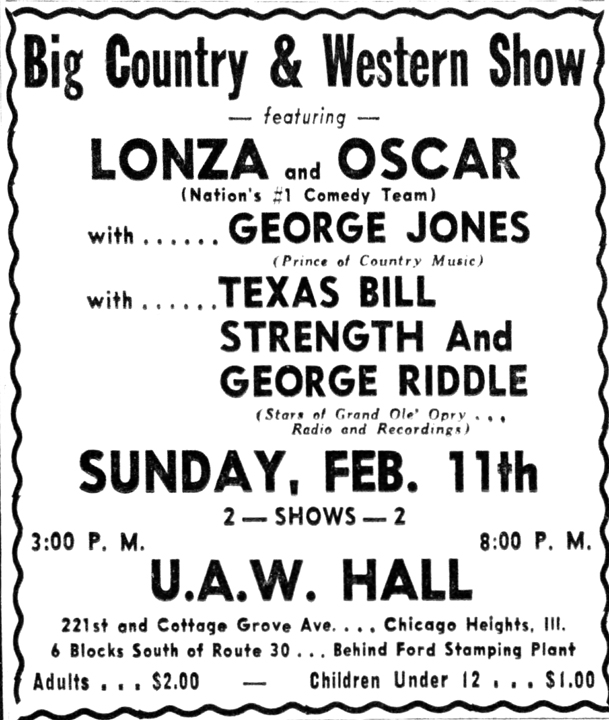
The Times, Munster, Indiana, February 11, 1962
FOLK TALENT & TUNES
March 1962
In a March 24, 1962, article in Billboard, a column by Bill Sachs headed “Folk Talent & Tunes” had a lot of news about TBS:
- Texas Bill Strength, recently returned from his third [at least fifth] jaunt to Alaska, where he played the U.S. Air Force bases in Kodiak and Anchorage and appeared with Paul Harper and His Western Combo at Anchorage’s Alibi Club
ALASKA
Already a fish out of water, being a Southerner living in Minnesota, Texas Bill loved to get even further north to Alaska to perform and to hunt. Here are some of his trips to Alaska, as reported in Billboard:
- In the first week in June, 1959, TBS hops to Alaska for a 10-day trek. (Billboard, March 16, 1959)
- Texas Bill, together with Bonnie Sloan, played the Montana Club in Anchorage, with appearances on KENI-TV, KFOD and KBYR. The Montana Club was located at 222 Fourth Avenue, Anchorage. He departed Anchorage on January 16, 1961. (Billboard, January 23, 1961)
- TBS appeared at the Montana Club in Anchorage, according to an ad dated September 21, 1961. The ad said he was appearing through October 8.
- Jimmy Simpson, of Radio Alaska, Anchorage, reports that Lefty Frizzell and TBS are scoring handsomely on personals in the Anchorage area. Jimmy had them as recent visitors on his air show. (Billboard, November 13, 1961)
- He recently returned from his third [at least fifth] jaunt to Alaska, where he played the U.S. Air Force bases in Kodiak and Anchorage and appeared with Paul Harper and His Western Combo at Anchorage’s Alibi Club.
CC TAP
TBS and his Western Swing Band appeared throughout the month at the CC Tap Bar in March 1962.
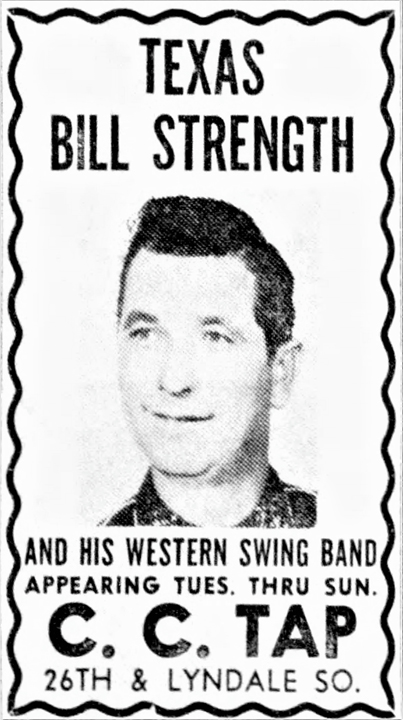
Minneapolis Star, March 8, 1962
KTCR
Billboard: Bill has been engaged to twirl the c&w platters on KTCR, new all-country and western station in the Twin Cities which takes to the air late this month. He says he needs programming material from the artists and diskeries to bring KTCR’s library up to date.
SUN RECORDS
TBS recently stopped off in Memphis to cut six more sides for Sam Phillips’ Sun Records and says he has an album coming up on the label early in the summer. Prague Frank has no record of a Sun session after May 15, 1961.
April 1962
KTCR
KTCR signed on as a Country station in Minneapolis on April 5, 1962. The 1929 Model A below was TBS’s signature car until he sold it to Johnny Cash in 1970. According to an item by Will Jones, Cash wanted to use it in a movie.
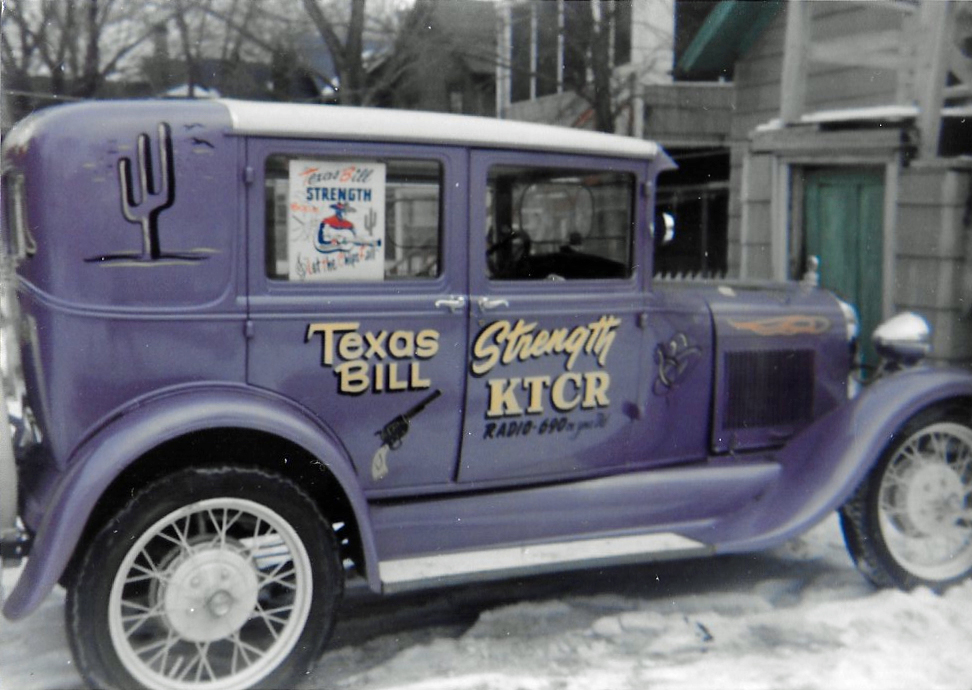
Photo Courtesy Dale Strength
May 1962
George Grimm:
On extension 345 came a voice with a drawl so musical you expected the guitar to start its accompaniment.
“This is TBS,” the southwest-flavored words said. “You know anybody who’d like about 300 old law books? I got ‘em from Mister Eaton who runs Eaton’s ranch south of town here. Figured I’d do a little law book readin’. But I never got to it. Had a couple of attorney friends look the books over. They said they’re useful, but a little outdated. Like I have a complete set of ‘Corpus Juris’ but now there’s a ‘Corpus Juris, Secundus’ that took over. Anyway, maybe one of your readers would like those 300 law books. All he has to do is to drive out to my house and pick them up.”
Texas Bill – with that drawl what else could you want to call him – says please don’t phone. Just arrive with your transportation and take the books with you. His address: 2514 So. 15th Ave.
Even when that fellow talks about law books, it sounds like the verse of a song about somebody’s true, true love!
Minneapolis Tribune, May 7, 1962
June 1962
In addition to his deejay chores at KTCR, and working area dates with his own band, TBS is handling bookings for a nearby club using acts Thursdays through Sundays. (Billboard, June 16, 1962)
August 1962
At the end of August (but before August 23, 1962), TBS went to New York to call on DJs and other trade folk. (Billboard, September 1, 1962)
On August 26, 1962, TBS made an appearance at Twin City Speedway.
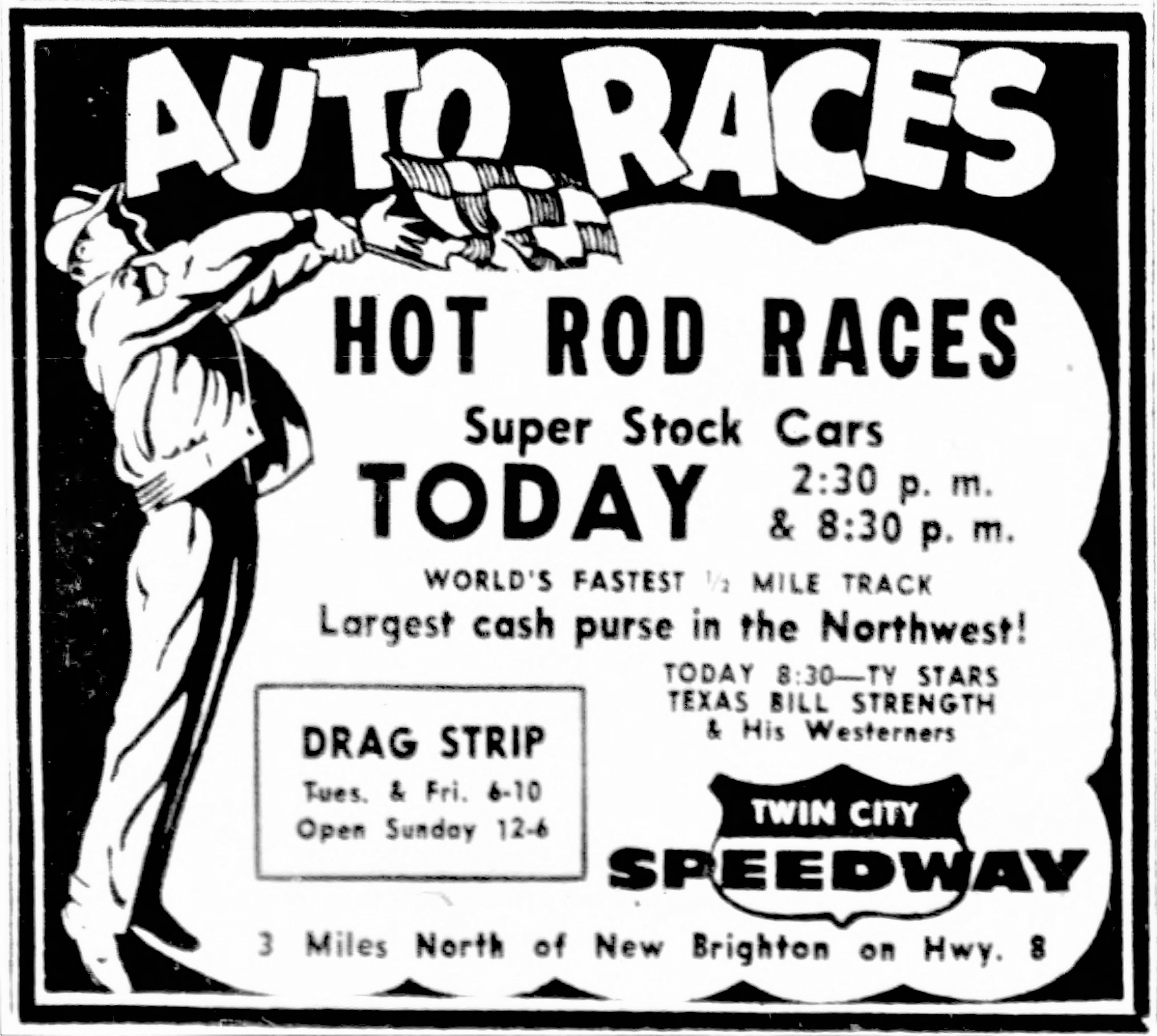
Minneapolis Tribune, August 26, 1962
THE 1962 SHOOTING
The headline in the August 23, 1962, article in the Minneapolis Star read: “Disk Jockey Critically Shot in Scuffle in Apartment:” TBS was described as a disk jockey and a singer at Triviski’s Bar, 678 Selby Ave. in St. Paul.
The night before, August 23, TBS and a friend, Donald “Duke” Larson, were playing behind Barbara Lee Mac at Triviski’s. After the show, they met two young ladies, Barbara Lindberg, 20 (Duke’s sister-in-law), and Rose Kasown, 19. (TBS was 34) They all went to the girls’ first floor apartment at 2437 Elliott Ave. So.
At 2:30 am, the upstairs neighbor, Marcus J. Styer, 26, got fed up with the noise and called the police, but the four went out to eat and were gone when police arrived. The four came back to the girls’ apartment at 3:15 am, and Duke and Rose left. TBS and Barbara sat in the kitchen talking. Finally Styer, who had been in a Wisconsin mental institution in 1957 and 1958, had had enough of the noise. He grabbed his shotgun and headed downstairs.
There accounts differ as to whether Styer burst in shooting or whether TBS grabbed the gun and it went off accidentally. Larry LaPole, Barbara’s brother-in-law, fellow country performer, and Bill’s good friend, said that when Bill opened the door the shotgun went off. Either way, TBS was left with a shotgun wound in the right thigh. Styer said that he used his belt as a tourniquet while Barbara called the police.
Officers arrived at 4:23 am to find TBS lying on the floor of the apartment, and the shotgun leaning against the wall in the hallway. Styer told police, “I shot him and gun isn’t loaded.”
The next day, August 24, the Minneapolis Star reported that Styer was charged with with second degree assault. It also said that TBS was taken off the critical list at General hospital but was still considered serious from a shotgun wound in the groin.
Now this is odd. TBS had actually been hit in the upper right thigh, which the Star had correctly reported the day before. His son Dale says it was a two inch hole, and Larry LaPole described it as just inches from the family jewels.
THE MINNEAPOLIS DAILY HERALD
A bit of explanation here: From April 13 to August 7, 1962, the Minneapolis Star and Tribune were on strike. On May 1, 1962, the Minneapolis Daily Herald was created by businessman Maurice McCaffrey to pick up the slack. He intended for the Herald to continue, even after the Star and Tribune’s strike ended, and it did for a while, but the last issue of the Herald came out on October 1, 1962.
Nonetheless, there was some overlap, and the Herald seemed to care about the medical progress of TBS much more than the big boys, often putting its articles on Page One. The following information was taken from articles from the Minneapolis Daily Herald.
August 23: TBS was taken to General Hospital (now Hennepin County Medical Center). Styer was held in city jail. Styer told police he became irritated with Strength’s singing. He accosted the entertainer with a .12 gauge shotgun but claimed that Strength caused the weapon to fire when he tried to knock it out of Styer’s hands. Homicide officers said that Strength was hit it in the lower abdomen. [There must have been a lot of blood to confuse a leg with a lower abdomen…] Styer was booked in the morning on an open charge for further questioning. The names of the persons whom Strength was visiting were not released.
August 24: “Singer Said to be Better”
Disk jockey and singer “Texas Bill” Strength was taken off the critical list Thursday night in General hospital. Staff personnel said the shooting victim’s condition was revised to “serious.”
August 18, 1962: “Texas Bill Still ‘Serious’; Gun Wielder Charged.”
TBS’s condition remained serious. Styer was charged with second degree assault.
August 31: “Texas Bill Recovers.” This front page story with a headshot of Bill in bed had this caption:
Still in serious condition from a shotgun wound is “Texas Bill” Strength, who already has had three surgeries and now is due for a fourth at General hospital. The night club entertainer and disk jockey was shot Aug. 24 following an altercation at 2437 Elliott Av. S. Held on a second degree assault charge on the case is Marcus Styer, 26, of the same address. He is alleged to have accosted Strength at 4:45 am in relation to a disturbance at the apartment below his. Texas Bill told a Daily Herald reporter: “Disturbance? I didn’t even have my guitar with me.”
September 1962
On September 5, the headline read: “Texas Bill Faces Fifth Surgery.”
TBS was still in serious condition, and was told he may have a fifth surgery soon. This article repeated the “lower abdomen” description.
The September 27, 1962, headline read: “Texas Bill Strength Shows Improvement.”
His condition has dropped from critical to serious, and for the first time in 36 days, and six operations, Texas Bill Strength, disk jockey and night club entertainer, seemed to be evidently on the mend. Texas Bill was wounded in the upper left thigh by a shotgun blast Aug. 24.
Now, let’s give the Herald it’s due for reporting more frequently on the condition of TBS, but there are some problems that may be indicative of why the paper didn’t last.
- The Star reported from the beginning that the wound was in his leg, not his “lower abdomen,” which the Herald was still reporting in September.
- The Star also knew from the beginning the names of the other people in the apartment, which the Herald couldn’t come up with.
- Maybe his condition went up and down, but TBS seemed to go from critical to serious twice.
- TBS also seems to have recovered twice.
A search for information about the Herald yields this scathing report of its demise in Time magazine (October 12, 1962):
Hastily flung together by Maurice McCaffrey, a Minneapolis adman, the error-prone and amateurish Herald rose to a circulation of 140,000 simply because news-famished Minneapolitans would buy anything. But when the city’s two dailies resumed publication last July, Herald circulation fell with a sickening thump. Last week McCaffrey’s Herald, anemic and skinny, gave up the ghost.
And here ends our visit to the Minneapolis Daily Herald. We thank them for their chronology of TBS’s condition and surgeries.
By the way, those big guys weren’t always right either. A photo in the initial report of the shooting run by the Star on August 23 identified TBS as “William Straight.”
BENEFIT
Will Jones reported that some musician friends would hold a benefit for TBS, who was still in the hospital. It was scheduled to take place at the Hitching Post on Highway 61 in Forest Lake on September 9, 1962, from 1pm to 1am. Ten bands and 20 acts were scheduled to perform. (Minneapolis Tribune, September 6, 1962)
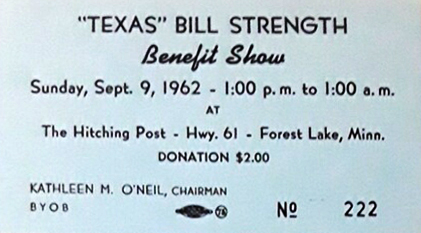
Ticket to the Benefit, courtesy Jan Sherman About a week later, a delegation visited Bill in the hospital to deliver the check from the benefit. Jan Sherman found him with both of his legs elevated in stirrups – she thought both inner thighs were affected. The wound looked like “strips of bacon” where the skin grafts were being done, taken from his back and sides.
In the photo below, Teddy O’Neil, husband of benefit organizer Kathleen O’Neil, presents Bill with the check from the benefit.
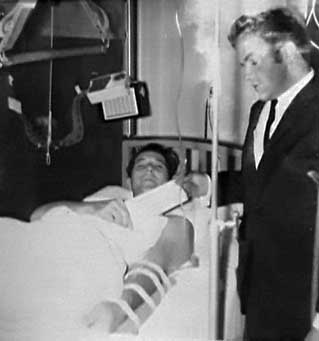
Photo courtesy Jan Sherman 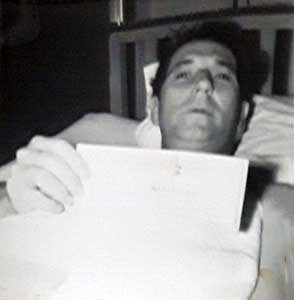
Bill with his check. Photo courtesy Jan Sherman Below, Jan’s brother Dan Northrop presented a sport jacket to TBS. Dan won it in a raffle at the benefit after spending about $50 in tickets. Dan is sort of propping Bill up in bed.
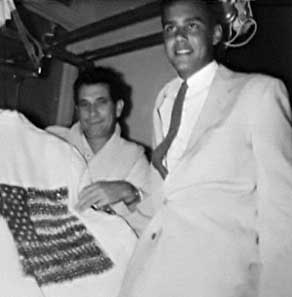
In the picture below, Jan Sherman and Ted O’Neil are shown visiting. Note radio over the bed.
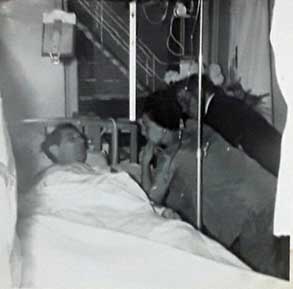
Photo courtesy Jan Sherman Larry LaPole also visited Bill at the hospital, and recalled TBS saying to him that he was “all done with the wild side of life.”
November 1962
THE TRIAL
Styer’s trial opened in Hennepin County District Court on November 15, 1962. Barbara Lindberg admitted that there had been some noise at about 2 am that night, when she and Rose Kashown were throwing a baseball around with a dog and the ball broke a window. Just before the shooting, she said that she knocked an ironing board into a tin cabinet while going to let the dog out. This time she said that she was the one who applied a tourniquet. She also testified that he kept saying “I’m sorry, I’m sorry, I didn’t know where the noise was.” He pleaded with them to tell police that TBS had grabbed the gun, she said.
On November 19, 1962, Styer took the stand, testifying that he heard “repeated outcries of a woman’s voice” and took his shotgun downstairs to frighten the noisemakers, not checking to see if it was loaded. He denied the allegation that he “burst in,” saying that he and TBS engaged in conversation for several minutes. Styer told him to quit making a disturbance and get out, and TBS mumbled several times “I’ll go,” but then TBS grabbed the end of the gun, which was pointed in the air, and brought it down. This caused Styer’s finger to brush the trigger, and the gun discharged.
After deliberating only two hours, the jury found Styer not guilty of the charges on November 21, 1962. The jury did not believe the “burst in” story (or apparently the wrestling with the gun theory) in light of the contention of the State that the X-ray pattern of the gunshot wound showed that he was a good eight feet away from Styer at the time of the shooting.
GOLDEN WING RECORDS
In 1962, TBS has a recording session that was probably in Minneapolis, for local label Golden Wing:
Discogs.com has no date for this single (GW 3013), but the last verse of “Let the Chips Fall” is about the shooting. (Thank you to Sherwin Linton for pointing this out.) The writer of both songs is listed as P. Wegman.
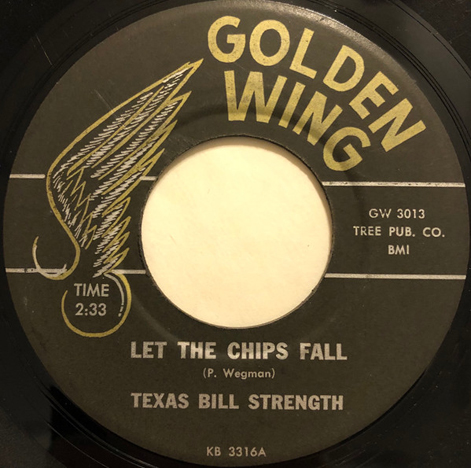
“Let the Chips Fall” 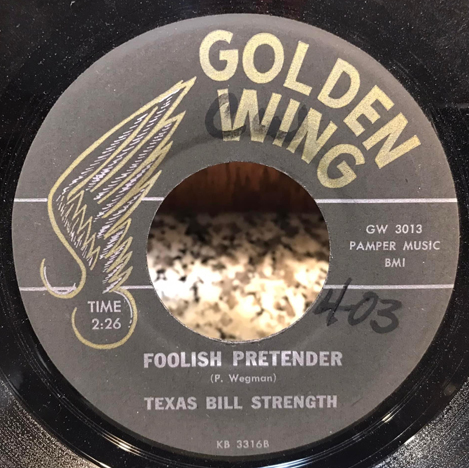
“Foolish Pretender”
At the end of 1962, TBS did a series of appearances for Atlantic Mills Department Stores.
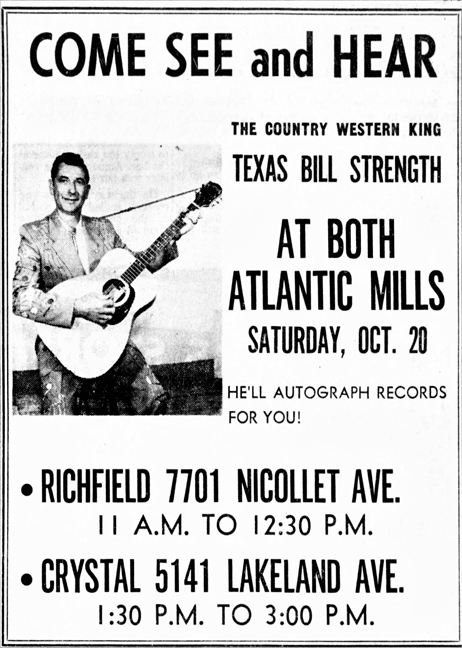
Minneapolis Star, Thursday, October 18, 1962 
Minneapolis Star, November 29, 1962
1963
Another Golden Wing session was apparently held in 1963, resulting in GR 3024. It was released on the Golden Ring subsidiary label.
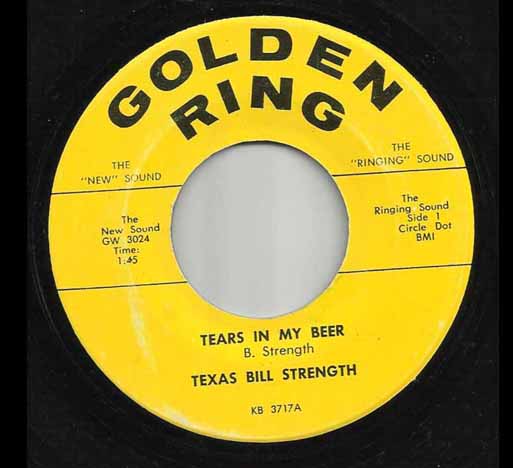
“Tears in my Beer,” written by TBS 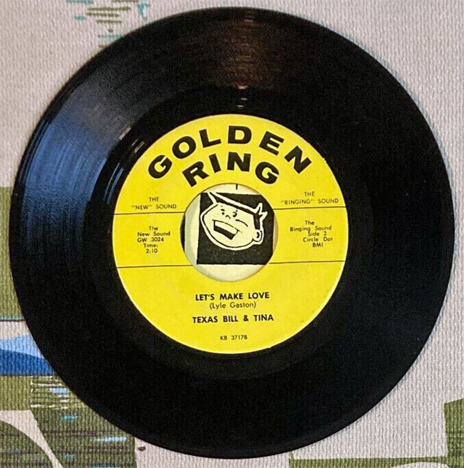
“Let’s Make Love” “Let’s Make Love” was apparently a duet with someone named Tina. In January 1964, one notes that there was a yodeler named Tiny Tina who performed on a show in Rochester, Minnesota, described as from Minneapolis. Could this be her?
Sometime in 1963, TBS ran for the board of directors for the musicians union, as evidenced by the flyer below:
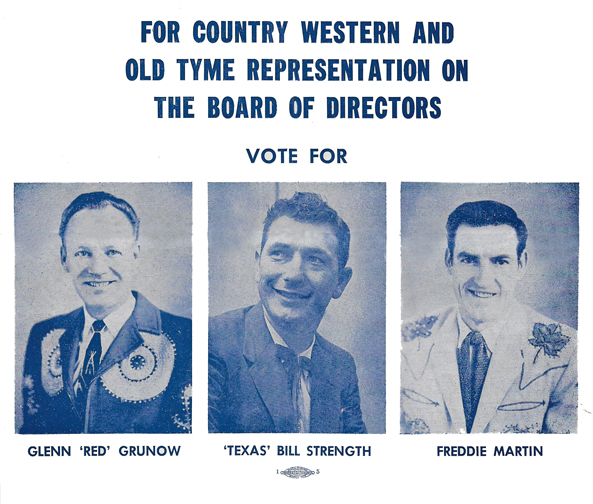
Image courtesy Dale Strength
May 1963
On May 16, 1963, Rex Allen was in town for a stint at the Flame, and Will Jones relayed this story:
Like all true night club performers, he even enjoys zinging an inside joke. TBS, who was involved in a shooting scrape not long ago, was in the audience the other night. During a bit in which Allen showed off his cross-draw 45s, he looked over at Strength’s table and said: “Y’don’t hafta worry, Bill, they’s blanks in these.”
June 1963
On June 8, 1963, KTCR presented the Grand Ole Opry at Met Stadium. Headliners were:
- Claude King
- Skeeter Davis
- Don Gibson
- Merle Travis
- Tex Ritter
- Marvin Rainwater (who was robbed of $650 from his suitcase at the Leamington Hotel)
- Roy Drusky
- Bobby Hankins
- Texas Bill Strength, emcee

Minneapolis Tribune, June 6, 1963
July 1963
A letter from his ex-wife Jackie indicated that TBS and she had met somewhere before July 14, 1963, that was neither Minneapolis nor Houston. TBS had his sons with him.
On July 21, 1963, TBS and his Troubadors appeared at the Hot Rod Races at Twin City Speedway.
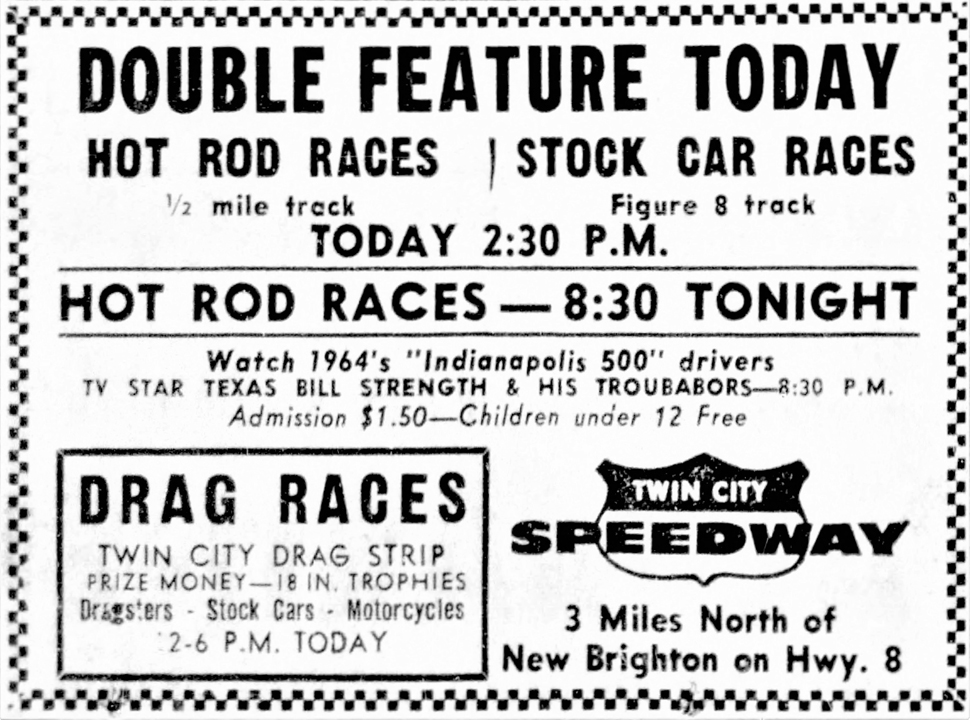
Minneapolis Tribune, June 23, 1963
August 1963
On August 16, 1963, someone recorded his show on KTCR-AM, and it is available to hear on Twin Cities Radio Airchecks. The songs themselves are “scoped.”
November 1963
Minneapolis was in the middle of a huge folk music craze in 1963, and Hootenanny was the word of the hour. Apparently the organizers of this Muntz TV Hootenanny event on November 10, 1963, thought that folk music consisted of Country music and polka. Hopefully WDGY brought some Kingston Trio records.
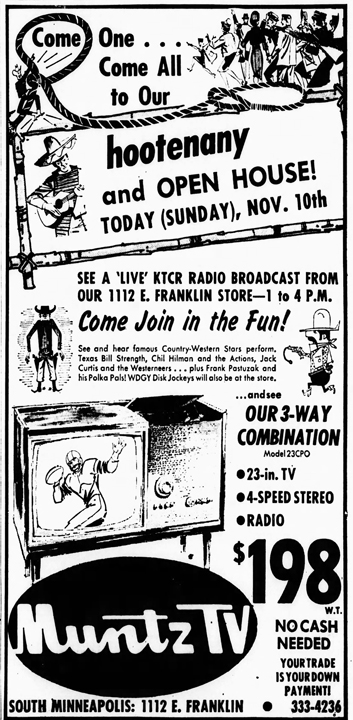
Minneapolis Tribune, November 10, 1963
December 1963
On December 7, 1963, TBS did a remote broadcast from Downtown Chrystler-Plymouth from 2 to 4:30 pm, along with Jack Curtis and the Westerners and guest stars.
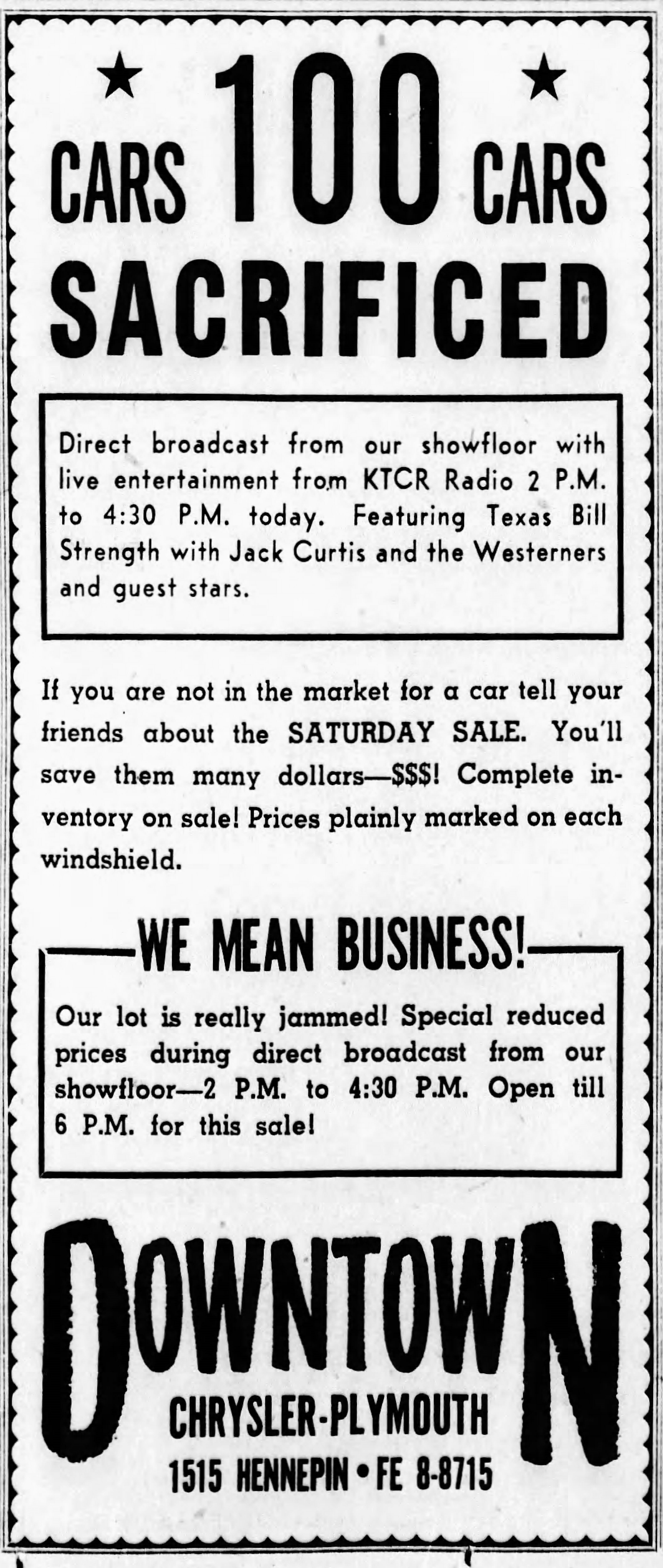
Minneapolis Star, December 7, 1963
1964
January 1964
On Saturday, January 25, 1964, TBS performed in a Grand Ole Opry Show at the Mayo Civic Auditorium Theatre in Rochester. The two shows were sponsored by the Rochester Jaycees.
Also on the bill were:
- Bill Anderson
- Bob Luman
- Bob Prouty and the Country Playboys, a local Rochester band
- June Harrold
- Sharron Sparrow
- Topper
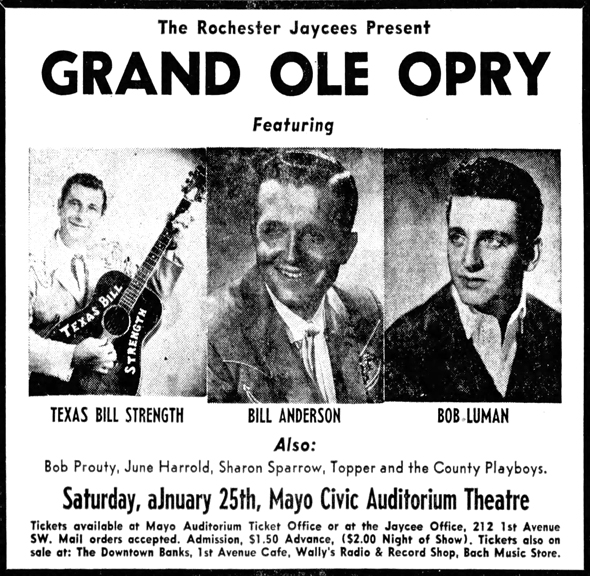
Rochester Post Bulletin, January 23, 1964 The Rochester Post Bulletin reported that an estimated 1,500 people attended the two shows. Surprise guest yodeler Tiny Tina also appeared. At the end of the second show, Bill Anderson was brought back for a 45-minute encore. (January 27, 1964)
February 1964
On February 15, 1964, there was a Grand Ole Opry Show, Blockbuster Number 3, at the Minneapolis Auditorium. These Grand Ole Opry shows were booked by a DJ named Smokey Smith from Iowa. This show featured:
- Faron Young
- Webb Pierce
- Lefty Frizzell
- Earnest Ashworth
- Sonny James
- Elton Britt
- Jan Moore
- Texas Bill Strength

Minneapolis Tribune, February 15, 1964 This show played to 7,308 paid admissions, grossing over $16,700 – a record gross for Smith in the three years he has been promoting country shows at the Minneapolis Auditorium. (Billboard, February 29, 1964)
April 1964
Spinning the country platters on KTCR are Jay Jenson, Vern Arthur, TBS, and Johnny Long. (Billboard, April 18, 1964)
June 1964
TBS, along with the Minnesota Twins, appeared at Midway Ford on June 25, 1964.
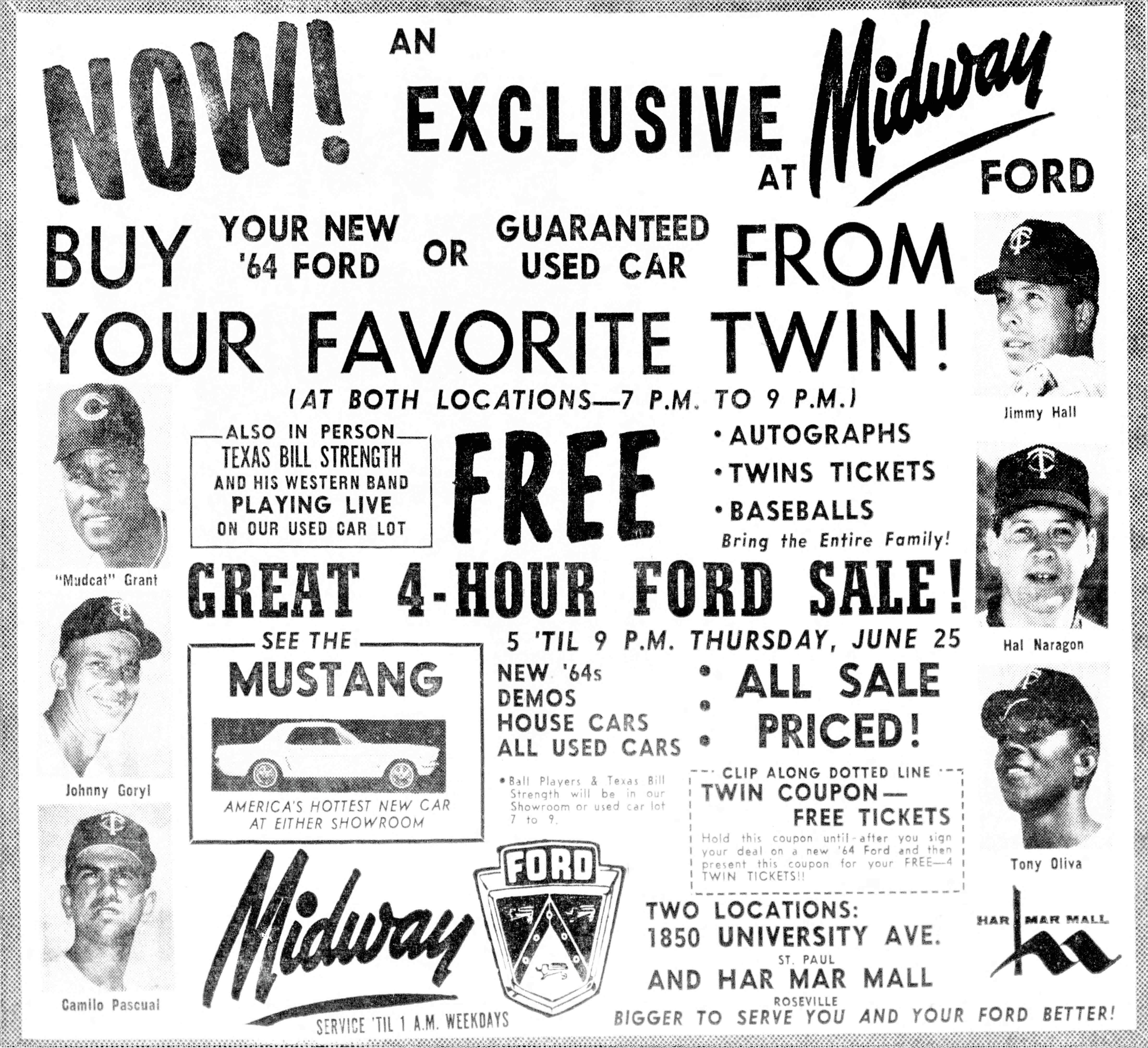
Minneapolis Star, June 25, 1964
July 1964
The Marty Robbins Show came to town on July 11, 1964, sponsored by KTCR. Other performers were:
- Red Foley
- Bobby Lord
- Melba Montgomery
- The Canadian Sweethearts
- Skeets MacDonald
- Grandpa Jones
- Sheb Wooley
- Johnny Bond
- Mac Wiseman
- Johnny & Jonie Mosby
- Joe Maphis & Rose Lee
- TBS
- Pete Nolan of “Rawhide”
The description of the show in the July 11, 1964, edition of Billboard calls it “KTCR’s First Annual Country & Western Music Spectacular,” and only lists Marty Robbins at the top of the list of stars, not the namesake of the show.
Plans were for it to start with an hour-long parade through downtown Minneapolis starting at 2 pm.
Next was a chuck wagon dinner from 6 to 8 pm, and then the three-hour show.
Climaxing the event was the First Annual Minnesota Square Dance Festival, featuring nearly 2,00 square dancers from nearly every county in Minnesota, according to KTCR. That was expected to run from 11 pm to 2 am.
KTCR’s signal reached 70 counties in Minnesota, Wisconsin, and South Dakota; the show was expected to bring in more than 20,000 spectators.

Minneapolis Tribune, July 11, 1964
August 1964
The photo below was taken in about August 1964, ad features Fern Dale and Barbara Lee Mac posing with fans at the Flame. TBS’s name can be seen on a poster behind them.
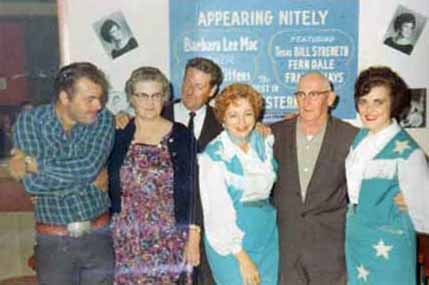
Image courtesy Brett Williams
September 1964
From September 14 to 17, 1964, TBS was on the bill with Marvin Rainwater at Todd’s in Fargo, North Dakota. He was dubbed the “Denver Dragon” on the ad below. Also appearing, three times nightly, were:
- Barbara Lee
- Fern Dale, the Banjo Queen
- Frankie Mayes and his Singing Guitar

Fargo Forum, September 13, 1964
November 1964
BANGAR RECORDS
In November 1964, TBS recorded two sides for Bangar, a local Minneapolis label. The disks were pressed at Kay Bank Studio. Bangar BA00649 was released in 1964.
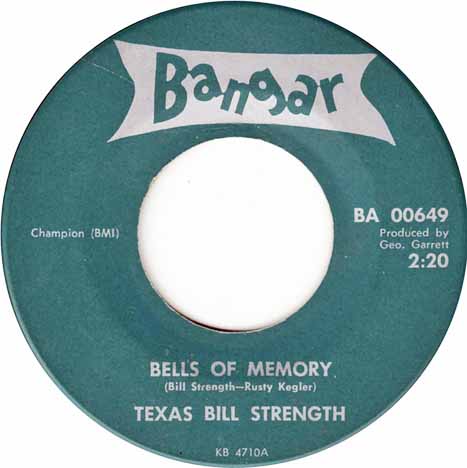
“Bells of Memory,” written by TBS and Rusty Kegler 
“Paper Boy Boogie,” written by TBS and T. Trent Billboard reported that TBS was giving away a German shepherd puppy in his Name the Puppy Contest. (November 28, 1964)
1965
TWIN TOWN RECORDS
In 1965, TBS moved to another local Minneapolis label, Twin Town. He cut four sides; no recording or release dates are available. The songs were produced by George Garret, who owned the Nic-O-Lake Recording Studio, in the basement of his record store. Garrett either owned Twin Town or had a big hand in it.
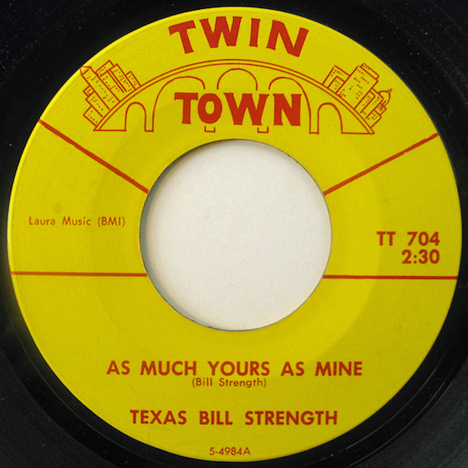
“As Much as Yours as Mine,” written by TBS 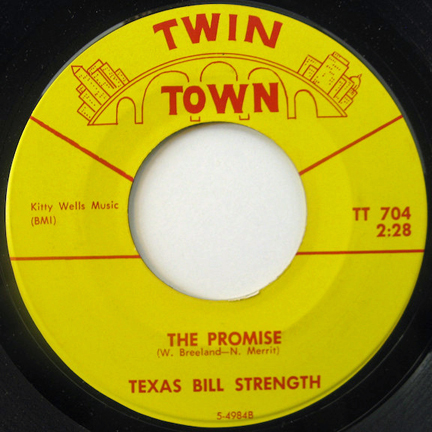
“The Promise” 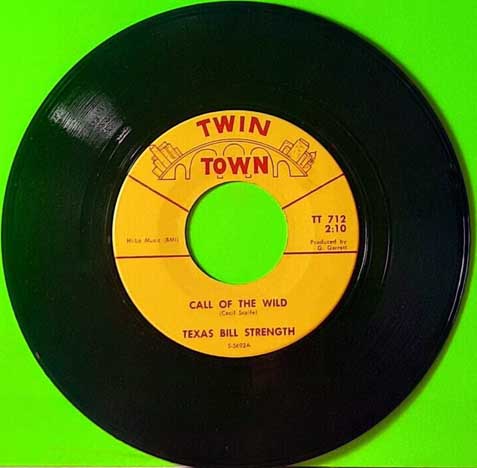
“Call of the Wild” 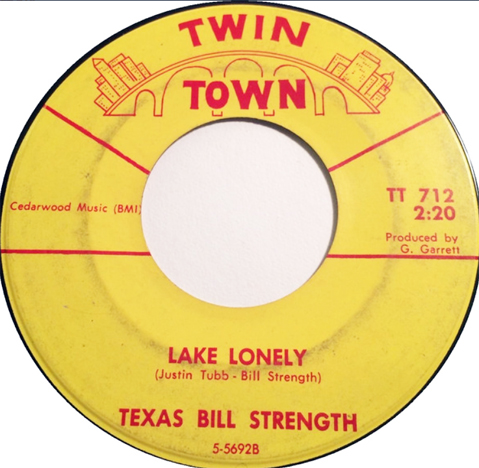
“Lake Lonely,” written by TBS and Justin Tubb “As Much Yours as Mine” b/w “The Promise” was issued as TT 704
“Call of the Wild” b/w “Lake Lonely” was issued as TT 712.
STUDIO CITY RECORDS
Studio City was another George Garrett label. In 1965, TBS recorded a song called “Million Memories,” which was given the number SC1036.
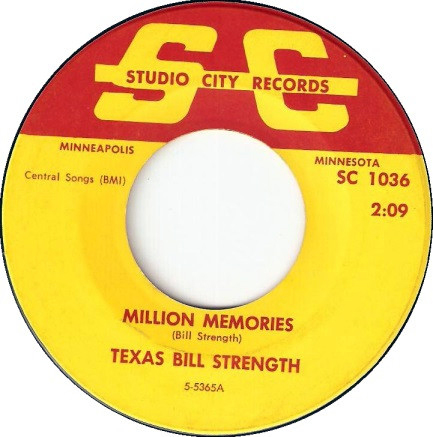
January 1965
An article about how disc jockeys move around a lot, dated January 14, 1965, said that “Bill Strength departed KTCR and returned to KTCR.”
On Saturday, January 23, 1965, TBS participated in a show in West Palm Beach, Florida that apparently took place in a tent theater set up on a polo ground. Other acts included:
- Hank Snow
- Rainbow Valley Boys
- Barbara Lee Mack
- Curly Smith and the Blue Mountain Boys

Palm Beach Post, January 17, 1965
February 1965
On February 11, 1965, TBS appeared at the premiere of “Your Cheatin’ Heart,” the story of Hank Williams.
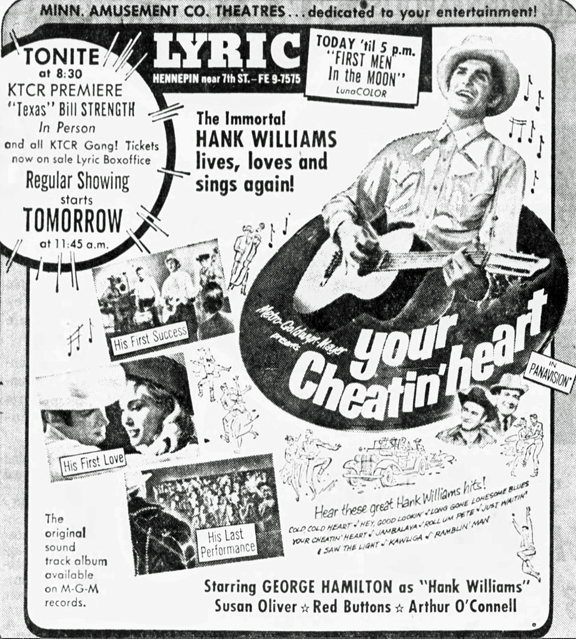
Minneapolis Star, February 11, 1965
Mid-February, 1965, found TBS up in Duluth at the Office. This job was on February 20.
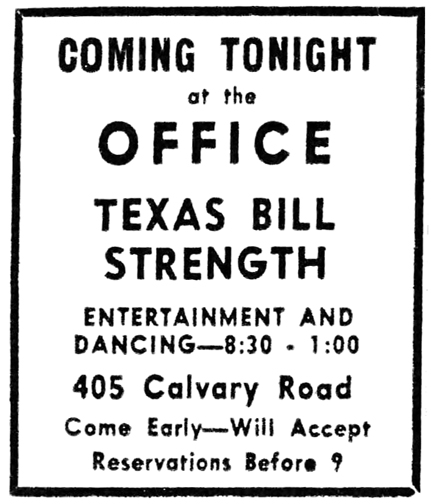
Duluth News Tribune, February 20, 1965
THE EXCUSE CLUB
Starting in 1965, on and off until at least 1967, TBS performed on and off at the Excuse Club at Cedar/Riverside.
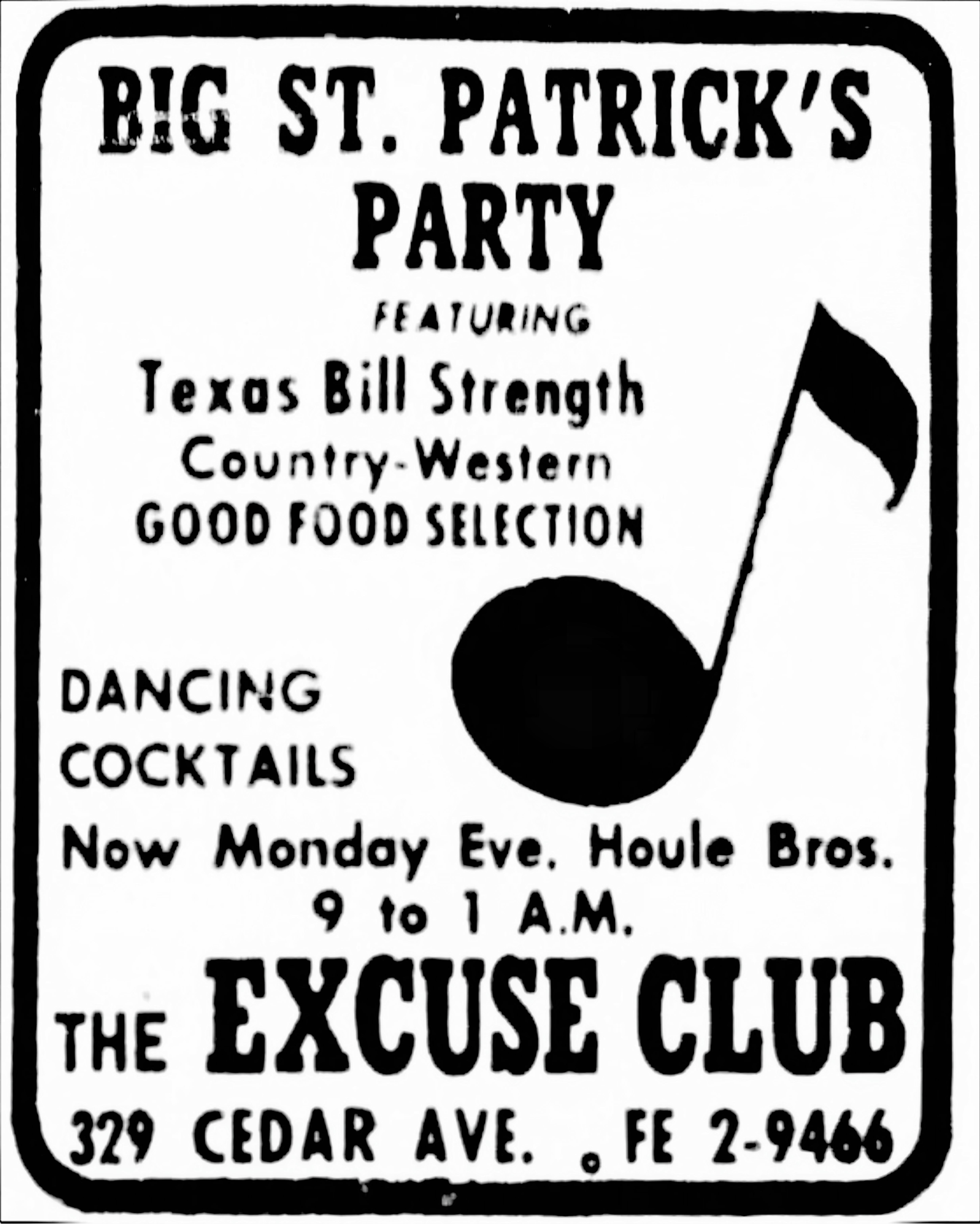
Minneapolis Tribune, March 17, 1965
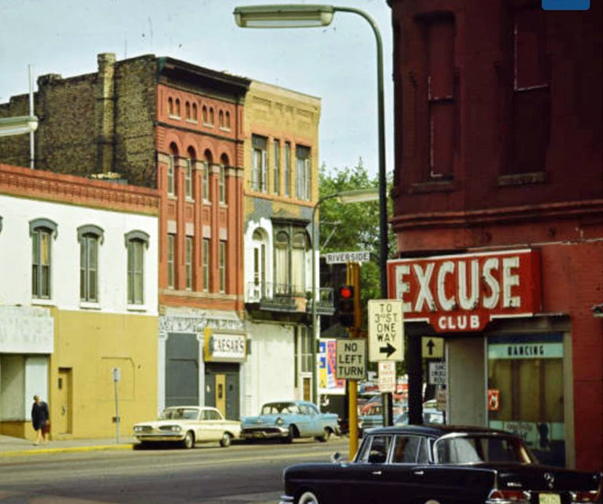
1967 Photo courtesy Hennepin County Library
April 1965
In April 1965 (probably), TBS, Dale, and Bobby participated in a benefit for Lenny Paro at the Medina Ballroom. The show featured performers from the Flame Café, including Sherwin Linton and the Fender Benders. Another performer was Johnny Western; April is the guess because he was performing at the Flame for a week that month. Dale and Bobby appeared playing in a band, and there is a few seconds of footage, but it is silent.
From April 19 to 24, 1965, TBS was back at the Flame as the headliner:
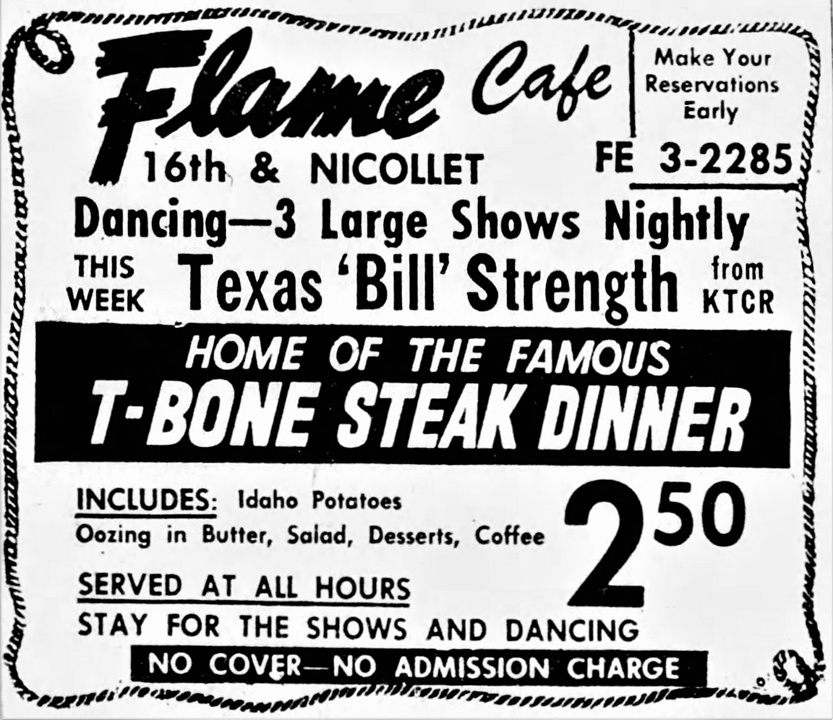
Minneapolis Star, April 19, 1965
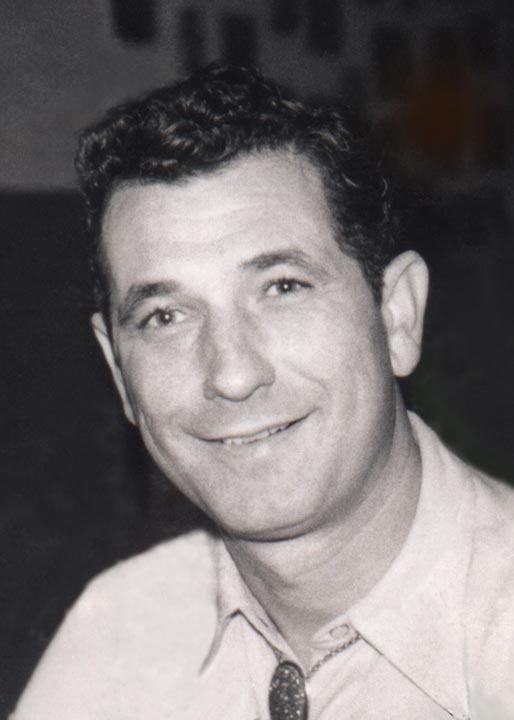
Photo taken at the Flame, courtesy Dale Strength
May 1965
May 15, 1965, found our wandrin’ boy in Lake Henry, Minnesota, entertaining the folds along with Miss Sherry Davis and his Excuse Club buddy Larry LaPole & The Polecats. He was billed here as “The World’s Second Most Beloved Cowboy.” Who was the first?
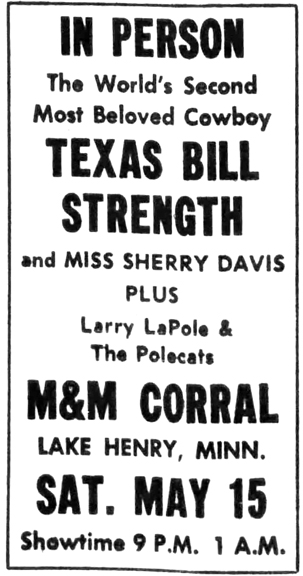
West Central Tribune (Willmar), May 15, 1965
On May 22, 1965, the 9th Grand Ole Opry Show came to town, and TBS was on the bill, along with:
- Johnny Cash and the Tennessee Three
- Tex Ritter
- The Willis Brothers
- June Carter
- Bob Luman
- The Statler Brothers

Minneapolis Tribune, May 16, 1965
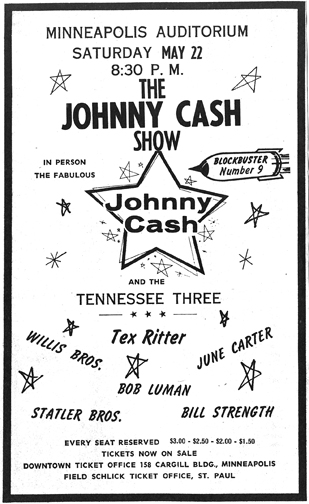
Image courtesy Dale Strength
July 1965
WMIN? KTCR?
On July 3, 1965, Billboard reported that TBS was named music director of KTCR. He was in charge of reviewing new records and making up the KTCR Top 50 Chart. Billboard rated the station as “being tops in influencing the sale of country records and Strength as top DJ in the market in influencing the sale of country records.”
On July 5, 1965, a blurb in the Tribune announced TBS’s move to WMIN radio to host a noon to 3 pm record show.
On July 10, 1965, a Billboard Radio Response Rating for Minneapolis/St. Paul still identified TBS as working for KTCR. It said he had 78 percent of the Country audience, with Art Blaske and Vern Arthur at KTCR and Johnny West from WMIN sharing the other 22 percent of the country DJ ratings.
On July 28, 1965, a gossip column in the Houston Chronicle called “The Big Beat by Maxine” had this to say: “Biff Collie, the former Houston deejay, has not entered the public relations field on the West Coast. Biff has been in radio out there for some time. He also reports that another ex-Houston radio voice, Texas Bill Strength, has been upped to program director at KTCR in Minneapolis.”
On August 2, 1965, another blurb in the Tribune repeated TBS’s move to WMIN.
On August 5, 1965, the ad below made the move to WMIN official. The black eyes refer to a cigarette ad campaign, “I’d rather fight than switch,” no doubt.
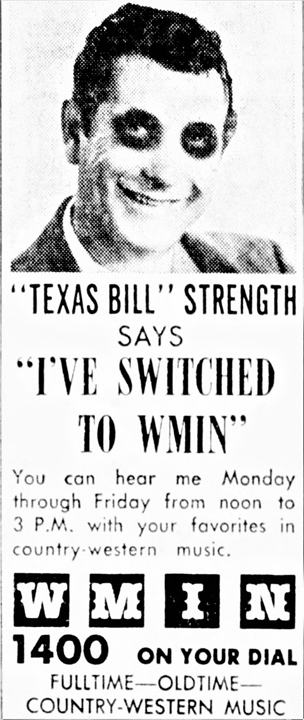
Minneapolis Star, August 5, 1965
On August 14, 1965, Billboard reported that TBS has joined countrified WMIN, St. Paul. He was with KTCR there. In Biff Collie’s “West Coast Ramblings” column in the same edition of Billboard, Biff says “TBS has been upped to program director at KTCR Radio, Minneapolis. Bill and I worked together in Houston in the late 1940’s. What a character!” (Billboard was a weekly, so it must have been difficult for them to keep up.)
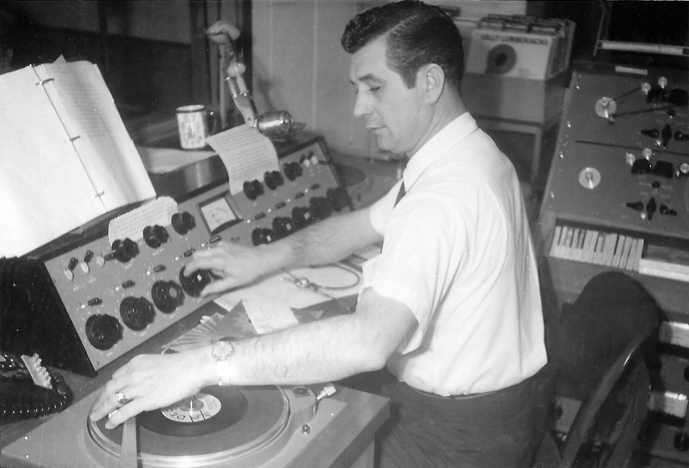
TBS at the WMIN Console. Photo courtesy Dale Strength
FRONTIER CLUB GATHERING
In about 1965, there was a gathering of Twin City and Nashville entertainers with the George Kent Band at the Frontier Club.
Shown kneeling: Texas Bill Strength and Mercury Recording artist George Kent. Standing: Sherwin Linton; Tony Farr; Chill Hilmin; Gary Verne, George Kent’s Drummer; George Guinn, who was from Oklahoma and popular in the Midwest; and Wayne Wilson, who later became Buck Owens bass player. All those with matching shirts were George Kent’s band.

Photo courtesy Sherwin Linton
August 1965
The ad below for an appearance at Midway Ford on August 2, 1965, mentions both stations, none directly associated with TBS:
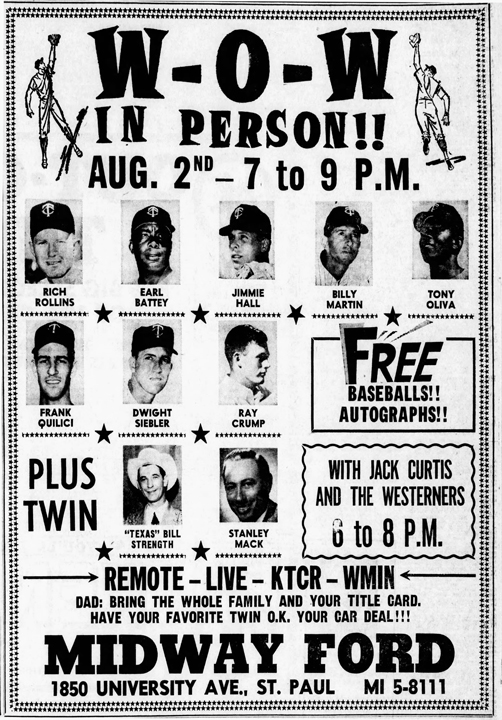
Minneapolis Star, August 2, 1965
TBS was back at the Excuse Club on August 6 and 7, 1965.
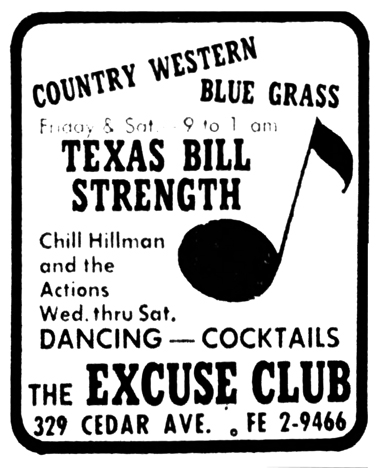
Minneapolis Star, Thursday, August 5, 1965
September 1965
A TIME OF TROUBLES
On September 1, 1965, TBS’s mother, Jessie Leon Strength, died at her home in Conroe, Texas.
The ad below indicates that TBS was scheduled to play the Excuse Club on September 3 and 4, 1965.

Minneapolis Tribune, Friday, September 3, 1965
TBS was scheduled to make a personal appearance at Major Ford on Saturday, September 25, 1965.
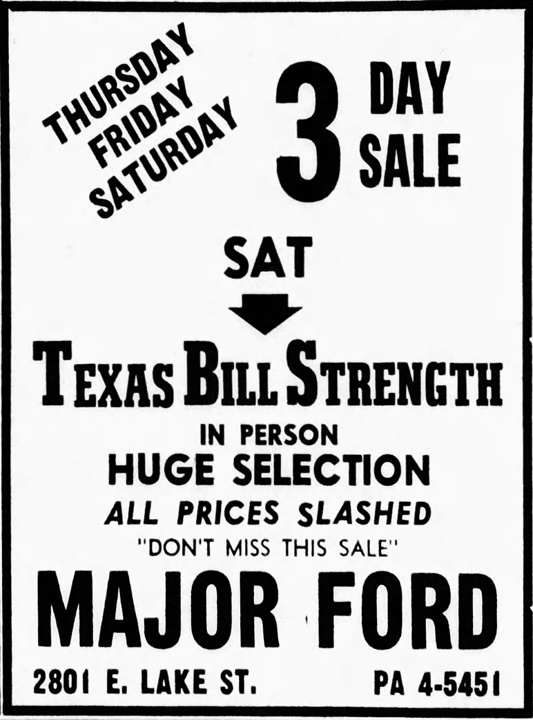
Minneapolis Tribune, Thursday, September 23, 1965.
The ad below, for the same appearance, indicates that Bill was bringing along his band and would perform.
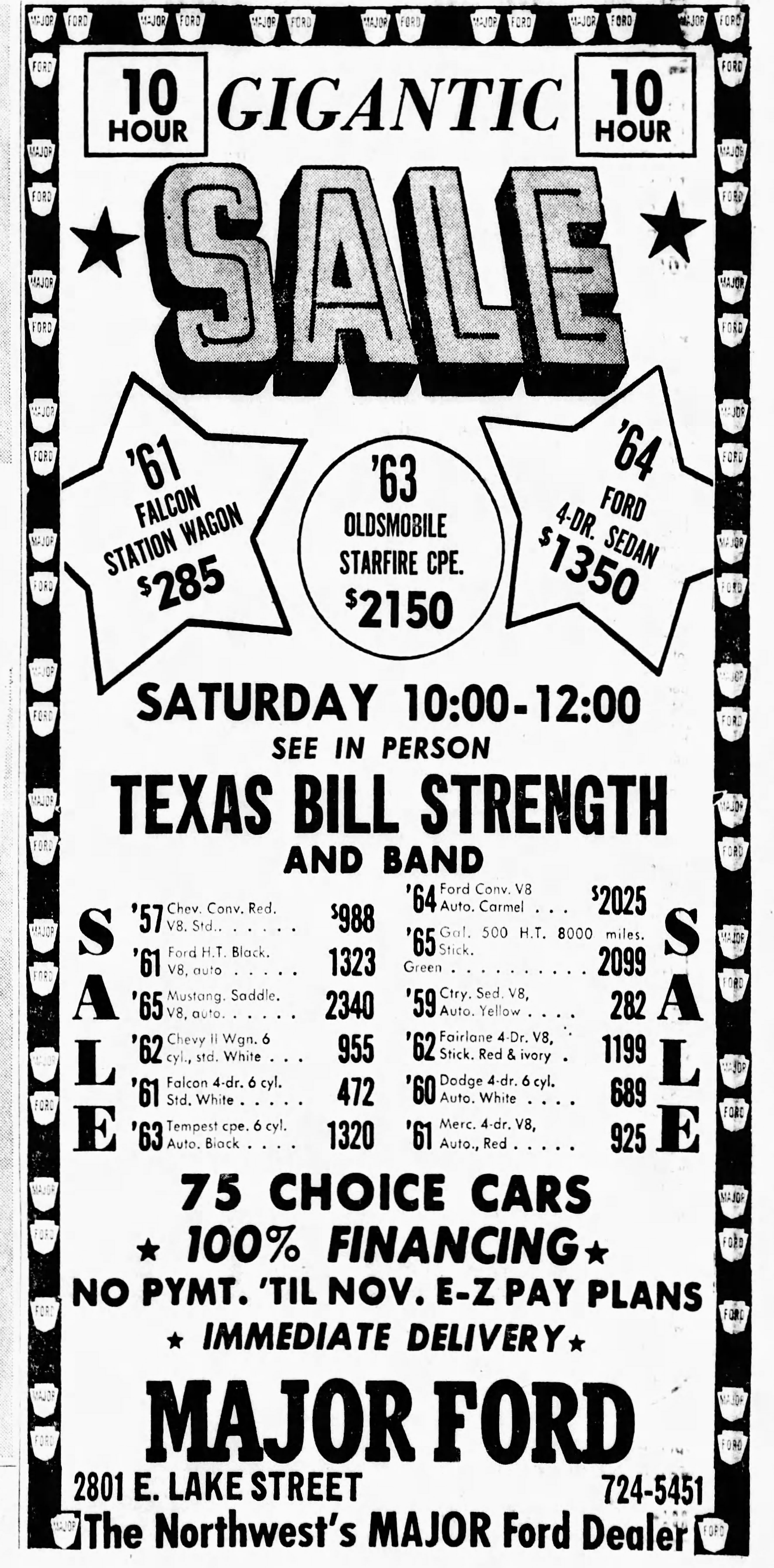
Minneapolis Tribune, Friday, September 24, 1965
October 1965
TBS was back at the Excuse Club on October 8 and 9, 1965. One of his fellow performers were the Polecats, led by Larry LaPole. Larry wrote many of the surf songs recorded by the Trashmen!
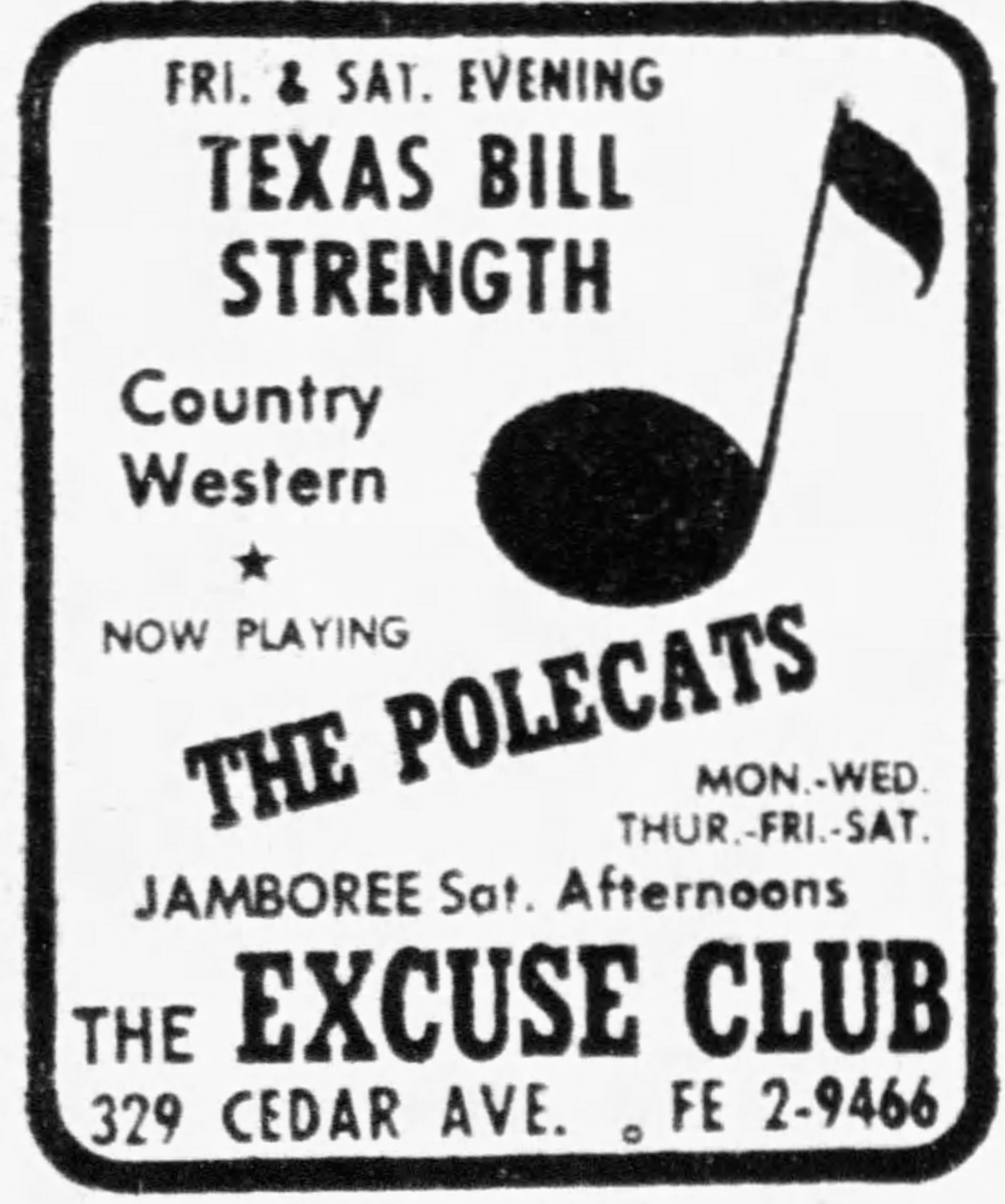
Minneapolis Star, Thursday, October 7, 1965
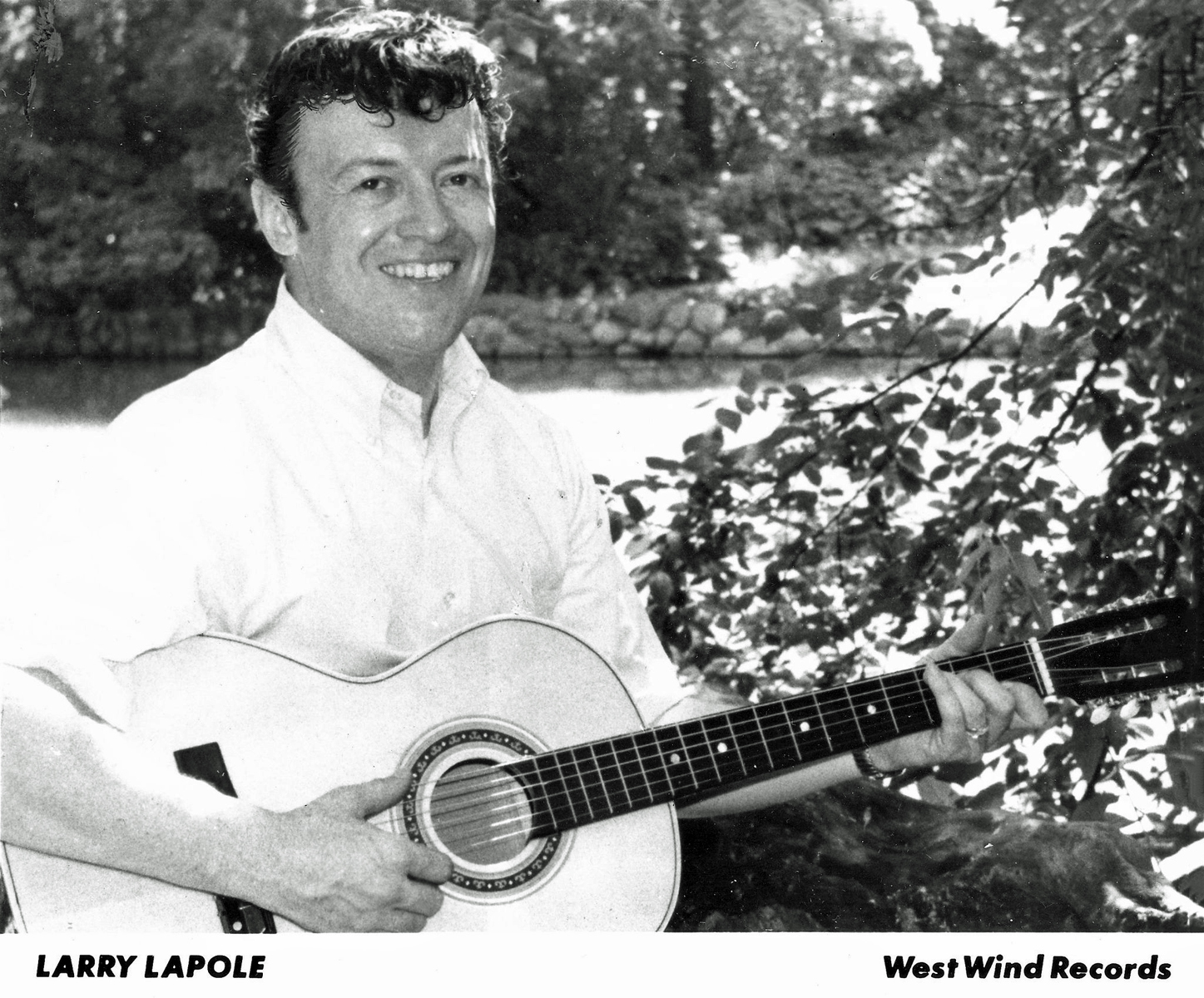
Photo courtesy Mike Jann
November 1965
On Saturday, November 6, 1965, the lifeless body of Jackie Young, TBS’s second wife, was found in the back of her car in a pasture in rural Texas. She had been strangled and bludgeoned with a tire iron. She was 25 years old. Despite the fact that they had divorced, TBS was devastated. See above under 1959 for the details.
December 1965
It was back to the Excuse Club on December 3 and 4, 1965.
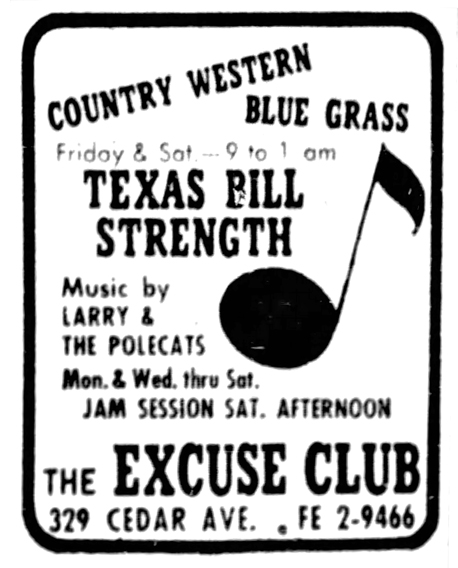
Minneapolis Tribune, December 3, 1965 On December 9, 1965, TBS and his buddy Marvin Rainwater, the Houle Bros. Band and Miss Sherry Davis traveled to Albert Lea for a big show.
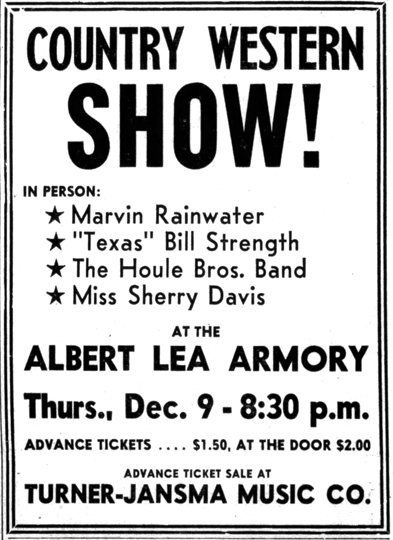
Albert Lea Tribune, December 5, 1965 With the addition of Johnny Long and Miss Louise Drew, the same troupe traveled to Willmar, Minnesota, on December 17, 1965.
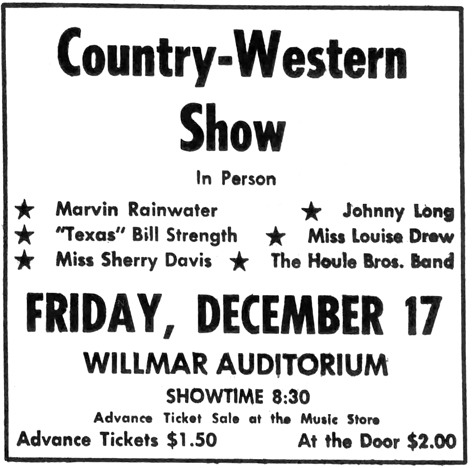
West Central Tribune (Willmar), December 16, 1965
1966
January 1966
On January 28, 1966, TBS was booked at the Parkway Ballroom in Foley, Minnesota. The ad said, probably mistakenly, Rock ‘n’ Roll Dance. Bill’s band was called the Countrymen.
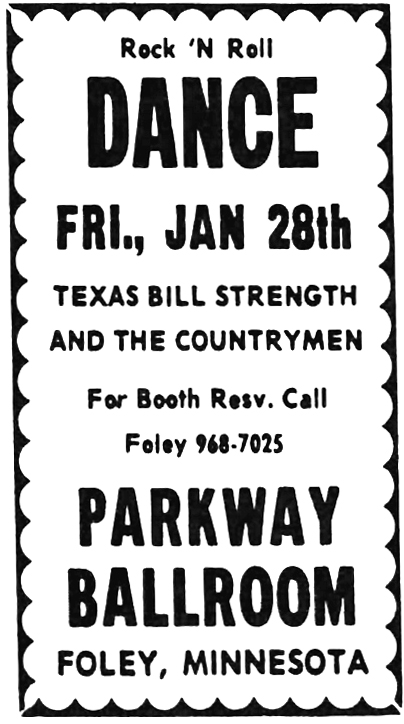
St. Cloud Times, Thursday, January 27, 1966
February 1966
On February 4, 1966, TBS was again at the Parkway Ballroom in Foley, this time billed as a “Big Western Show” with Roger Mews and the Countrymen.
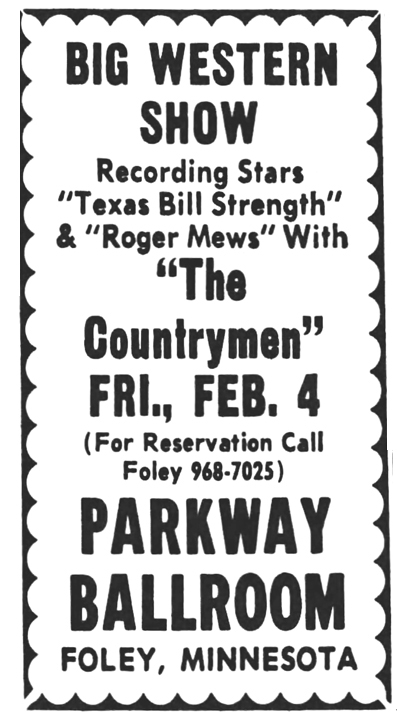
St. Cloud Times, Wednesday, February 2, 1966
On February 7, 1966, TBS’s father died at the VA Hospital in Houston.
Also on February 7, 1966, TBS was stricken ill and was a patient in two hospitals. Doctors at the Mayo Clinic detected a spot of cancer on his left lung and a case of cirrhosis of the liver. Strength, who has in recent years been featured on several local radio stations with his own country platter show, will be forced out of action for some six weeks. (Billboard, March 26, 1966)
Given the information above, it is unlikely that Bill was able to fulfill the obligation below to play a dance at the Parkway on February 11, 1966.
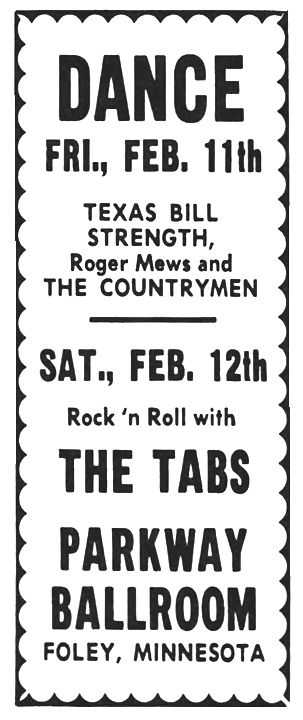
St. Cloud Times, February 11, 1966
March 1966
March 17, 1966:
TBS, veteran country music entertainer and deejay who was forced to relinquish his deejay post on February 7 due to illness, informed Billboard that he is well on the way to recovery and hopes to be back in harness soon. Writing under date of March 17, Strength says, “I was in Mayo Clinic for 14 days. They thought I had a touch of lung cancer but got it cleared up in time by giving me pulmonary dilating treatments and oxygen four times daily. They also discovered I have a 40 per cent portion of my liver chewed up, but I’m recovering real well.” Friends may write to Texas Bill at 2600 East Medicine Lake Boulevard, Minneapolis, 55427.
This address appears to be in Plymouth, although the house at that address wasn’t built yet. Perhaps it was the one next door, which was built in 1920. (Billboard, April 2, 1966)
A benefit show for TBS’s medical expenses was held at the Medina Ballroom on March 27, 1966. More than 17 area bands, as well as local deejays and radio and TV personalities, have donated their services for the benefit show. Merle Travis has been busy lining up other acts. Mail will reach Strength in care of Mr. and Mrs. Ralph Rundquist, 1490 64th Avenue NE, Minneapolis. The closest this address computes today may be where Highways 100 and 694 meet in Brooklyn Center. (Billboard, March 26, 1966)
April 1966
TBS had an extended engagement at the Golden Spike Club in or near Sauk Rapids, Minnesota, from at least April 7 through April 10, 1966.
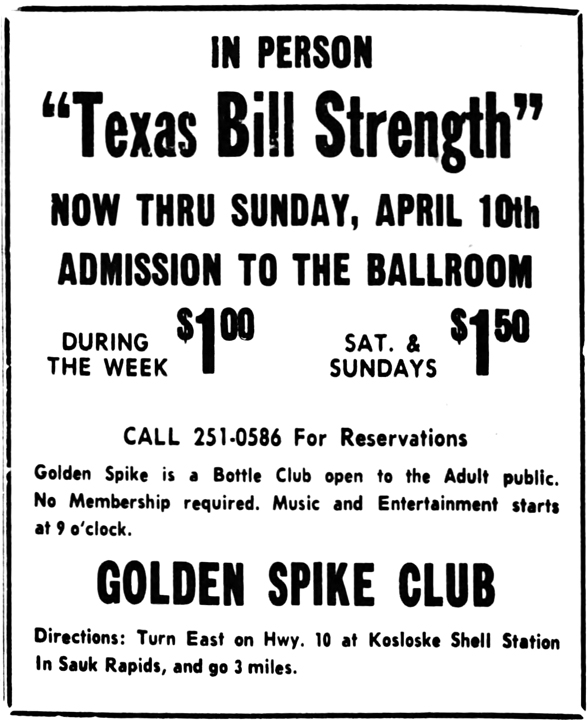
St. Cloud Times, Thursday, April 7, 1966
June 1966
NASHVILLE
TBS, forced to relinquish his deejay chores recently on a Minneapolis station due to illness, which laid him low for several months, has recovered and will henceforth work as a country music single. Strength says he has given up the deejay business, at least temporarily. He arrived in Nashville recently [June 1966] to scout for a potential hit song and a recording session. (Billboard, July 9, 1966)
NASHVILLE/STARDAY RECORDS
In June 1966, TBS cut two sides for Nashville Records, a subsidary of Starday. NV5291 was released in 1966.
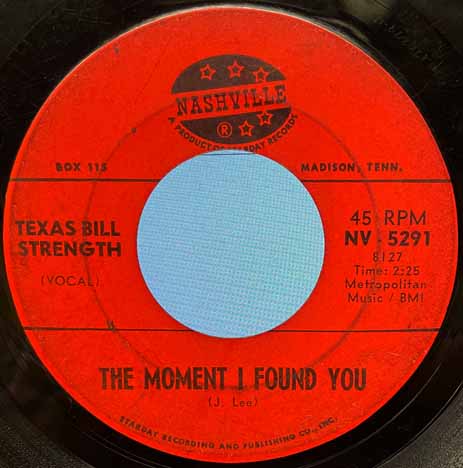
“The Moment I Found You” 
“Best Thing in Life is Love”
It was also probably at this session that two other sides were recorded; they were on TBS’s Greatest Hits album, released in 1967, so it’s a guess that they were recorded in 1966:
- “I’m Gonna Catch You Baby”
- “Betty Lou”
On June 24, 1966, TBS appeared on Bobby Lord’s TV show in Nashville. (Billboard, July 9, 1966)
On June 25, 1966, TBS appeared on Ernie Tubb’s Midnight Jamboree TV show. (Billboard, July 9, 1966)
On June 28, 1966, TBS appeared on Ralph Emery’s early-morning TV show. (Billboard, July 9, 1966)
July 1966
Strength left Nashville late this week for Fort Lauderdale for a five-week club date. (Billboard, July 9, 1966)
From August 14 to 16, 1966, TBS filmed the Bill Anderson TV show in Charlotte, NC. After that he will return to Nashville. (Billboard, July 9, 1966)
October 1966
TBS was included on a list of Top Country Artists. He was on Starday Records, represented by the Wil-Helm Agency. (Billboard, October 29, 1966)
On December 17, 1966, the rock band City Strangers, led by TBS’s son Dale, was loading its equipment in the alley after a gig at Mr. Lucky’s, when James W. Rieck, 25, pulled up and demanded to get through. When Dale explained that they had a lot of equipment to load, Rieck pulled a gun on him. TBS saw this and confronted Rieck, who backed off and skeedaddled. Rieck was arrested and held for investigation, but TBS declined to press charges. Rieck later thanked TBS in a letter, telling him that he was on probation and he could have been sent back to prison. Dale’s name was kept out of the newspaper accounts.
1967
January 1967
Here’s an interesting tidbit you only find by accident. It comes from an article in the Nashville Tennessean, dated January 22, 1967, called “Music Star Adds Pencil to Guitar.” It’s written by, of all people, Merle Travis. He’s talking about his various roles as a guitar player, singer, songwriter, actor, and columnist. Here’s the part that’s relevant to TBS:
Now, let me brag on my writing ability. I once wrote a piece for the Texas Bill Strength fan club on how to tune the fiddle to play “Black Mountain Rag,” which was rejected, but I keep tryin.’
A 1967 Talent Directory published in Billboard listed TBS as being on Starday Records and represented by the Wil-Helm Agency.
March 1967
If I’m reading this right, on March 12, 1967, there was a dance at the Bluebird Inn in Douglas, Minnesota, which is about ten miles from Rochester. Entertainers were Jim Eames and TBS, and it somehow had to do with radio station WMIN. The times listed may be Texas Bill’s hours on the air.
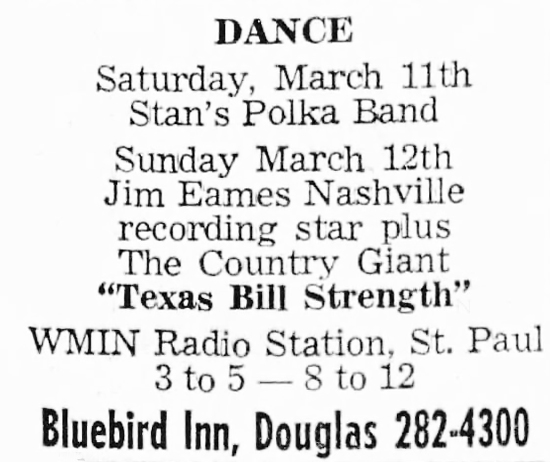
Rochester Post Bulletin, March 11, 1967
Billboard confirmed that TBS has returmed to WMIN: TBS, C&W entertainer and deejay who was forced to vacate the local radio scene more than a year ago due to ill health, has rejoined WMIN, Minnesota’s only 24-hour country music station. (March 18, 1967)
TBS made a return engagement to the Bluebird Inn on March 26, 1967, this time with top billing over Jim Eames Ranchhands.

Rochester Post Bulletin, March 25, 1967
April 1967
On April 16, 1967, TBS made yet another trip to the Bluebird Inn in Douglas, Minnesota, this time on his own, according to the ad below.
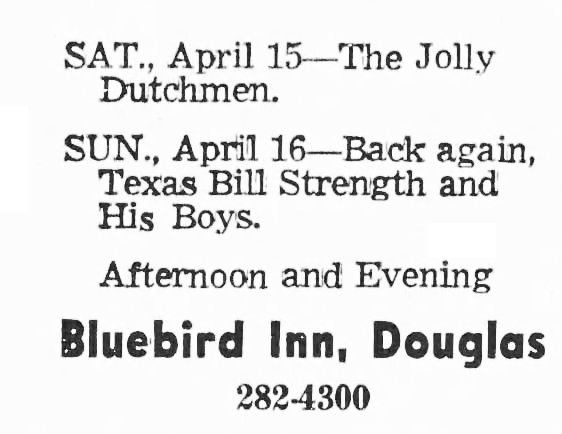
Rochester Post Bulletin, April 14, 1967
May 1967
Now here’s something interesting. All of the ads for the Excuse Club for May 25 – 27, 1967, look like the one below:
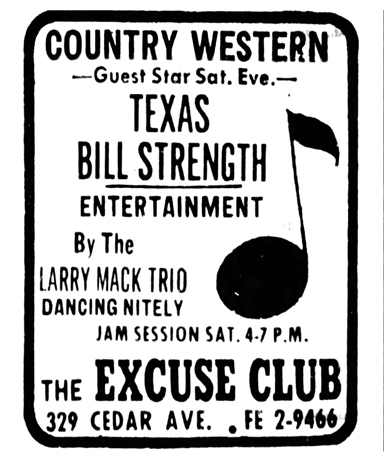
Minneapolis Star, Thursday, May 25, 1967 This would imply that Bill was going to be there on Saturday night, which was May 27, would it not? But what about this? Maybe it meant TBS was scheduled for Friday night? But the date stamp is automatic. Very curious.

St. Cloud Times, May 27, 1967
June 1967
Back by request! TBS made yet another appearance at the Bluebird Inn in Douglas, Minnesota on June 18, 1967. Apparently it was a Fathers Day show, where he shared the stage with Miss Georgiann and Jimmy See.
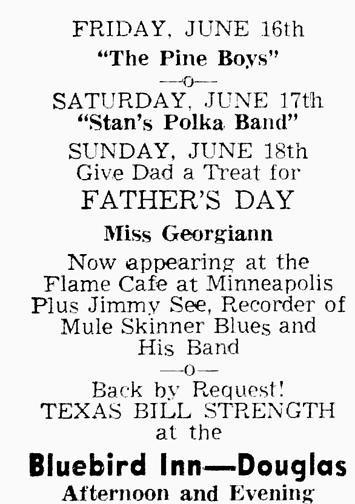
Rochester Post Bulletin, June 16, 1967
GREEN GREEN BACKS BACK HOME
And here’s a discovery for 1967. It seems the Trashmen (of “Surfin’ Bird” fame) recorded a novelty song called “The Green Green Backs Back Home,” credited to the Trashmen and the Desert Rat Singers. The record tells us that our friend Mike Jann produced this gem, and the writing credits went to Curly Putnam (who wrote the original song “The Green Green Grass of Home) with special words by Larry LaPole.
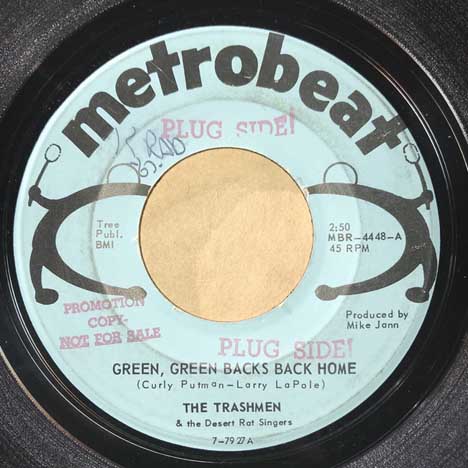
There are many, many connections going on here:
- The record starts with Trashmen lead guitar player Tony Andreason doing his best Walter Brennan.
- Tony and Mike Jann were friends from their teen years, and Mike was the keeper of the flame of the T-Men until his death.
- The second voice on the record, doing a great Gabby Hayes, is none other than Texas Bill!
- Mike was a big fan of Texas Bill – see photos he provided to this page in 1956. He may have been the one to suggest Bill for the part.
- Larry LaPole was the author of perhaps the greatest surf song of all time – “King of the Surf” – the flip side of “Surfin’ Bird.” Larry wrote it using surf terms that Will Jones published in one of his columns in the Minneapolis Tribune.
- Larry was normally a Country singer, with his band the Polecats, and a friend of TBS. They both played at the Excuse Club, and Larry, a wonderful artist, drew some fanciful pictures of Bill that Bill’s son Dale still has.
- Mike and Larry both worked at the Minneapolis Star and Tribune.
Mike recalled that the flip side of this record – “Address Enclosed” – also by Larry LaPole, had been recorded earlier, and was sort of an orphan song, looking for a home. Tony used a psuedonym, “Tony Jones,” a nod to George Jones, so as not to alienate his rock ‘n’ roll fans with a Country song, revealed Mike.
October 1967
TBS had a brief fling at a Fort Lauderdale radio station following the country music convention in October 1967. (Billboard, April 27, 1968)
1968
March 1968
Will Jones phone interviewed TBS, back on WMIN. He has recorded a new “Texas Bill Strength’s Greatest Hits” album in Nashville. (The album was released in 1967.) (Minneapolis Tribune, March 8, 1968)
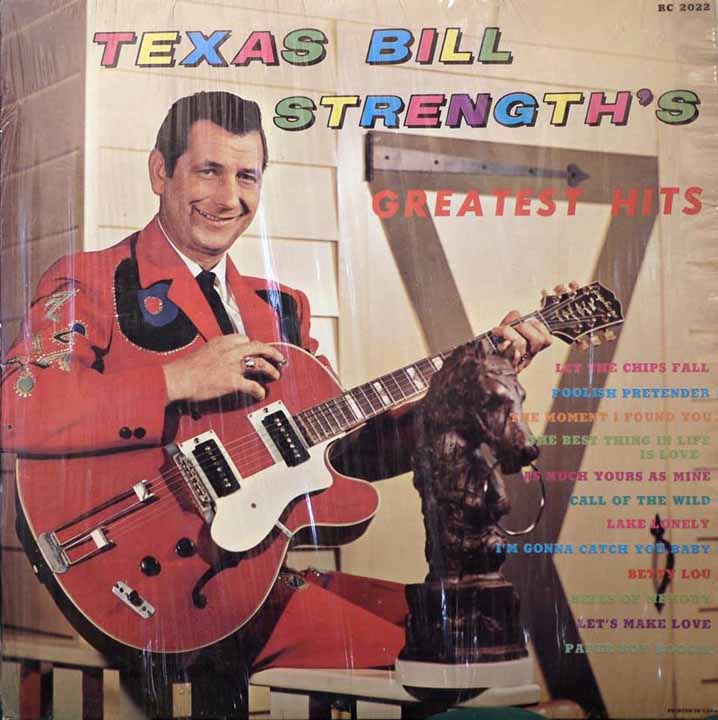
Songs on the album and the years they were recorded are:
- Let the Chips Fall – 1962
- Foolish Pretender – 1962
- The Moment I Found You – 1966
- The Best Thing in Life is Love – 1966
- As Much Yours as Mine – 1965
- Call of the Wild – 1960
- Lake Lonely – 1965
- I’m Gonna Catch You – 1966
- Betty Lou – 1966
- Let’s Make Love – 1963
- Bells of Memory – 1964
- Paper Boy Boogie – 1964
April 1968
TBS has again settled in Atlanta, where he’s doing a daily platter show over WTJH Radio. He’ll spend his free time playing clubs and show dates in Georgia, Alabama, Tennessee and the Carolinas. Strength also plans to record for his old friend, Bill Lowery. Texas Bill reports that he’ll be married to a Minnesota girl in June. (Billboard, April 27, 1968)
1969
March 1969
On March 2, 1969, radio station WTJH, East Point, Georgia, will sponsor a country music show at the city auditorium honoring the “old timers” of the industry, reported Billboard the day before. Governor Lester Maddox proclaimed Sunday as “Old Timers Day in Georgia.” The line-up of talent included:
- David Rodgers, Columbia Records
- Penny Linsey, Galaxy Records
- Clayton Read, Master Records
- George Read & His Blue Ridge Mountain Boys
- Jack Holden & Frances Kay
- WTJH Ranch Hands
- The Wranglers
- Don Echols
- Hoyt Bruitt
- Freddie Cole
- Jimmy Myers
- Billy Willson
- Bud, Dannie and Mote
- Skillit Likkers and Band
- Spero Patterson
- Riley Puckett
- Slim Spewman
- Debbie and Ronnie Ruggles
- Billy Goldman
- Sylvia Eason
- Billy Dillsworth
Emcees were WTJH announcers:
- Buzz Walker
- Country Jim
- TBS
- Ned Lukens
Discouraged with the state of Country music, TBS tried to quit. Quoting an interview from 1970, Ronnie Pugh wrote:
The year before, 1969, Strength even tried to give up performing to sell insurance. Though his natural gregariousness and quick humor, which had made him so good on radio, might have served him well in the insurance business, he simply couldn’t do it. “It’s like they say. It gets in your blood. Every time I passed a night club, I wanted to go in and start singing.”
Dale sent along this humorous letter from Merle Travis to TBS, commenting on the placid “Hillbillie Convention” of 1969 and how good it was to see each other.
Dale says:
This is a great example of how creative some of the country entertainers would be in communicating with each other. Comedic letters, sketches, photos, taped messages, and gifts were exchanged – I have a nice engraved cigarette lighter that Merle gave TBS. I think without exception all of the artists my Dad worked with were just great people. Bigger than life. And they gave each other a lot of respect, support and love. And I got to experience it all first hand. How cool is that?
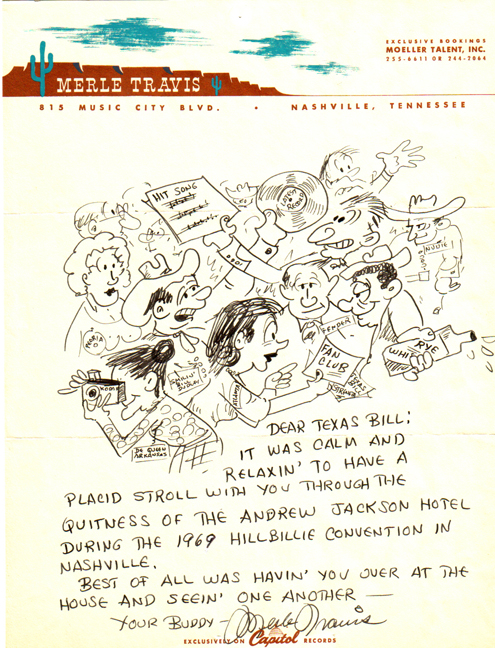
Image courtesy Dale Strength
1970
April 1970
Will Jones wrote that “Texas Bill” is Back in Town:
The often-shot-at TBS is back among us, after having spent the past three years in Atlanta and Birmingham, and touring with Grand Ole Opry units in the South.
He no longer has the metallic-purple, gold-wheeled ’29 Model A Ford that he used to sport around here. During a visit to Nashville he sold it to Johnny Cash, who intends to use it on a TV show.
Strength opened over the weekend at the Casino Royale, a storefront in the Shorewood shopping center that operated for a couple of years as a teen club and is now going the country-western route. Strength is there Fridays, Saturdays, and Sundays, zinging in his own creations such as “Hillbilly Hell,” a takeoff on “Hillbilly Heaven,” among the country-western standards.
He’s also returning to the disc-jockey scene here, and will launch a show on KTCR in a couple of weeks.
Minneapolis Tribune, April 13, 1970
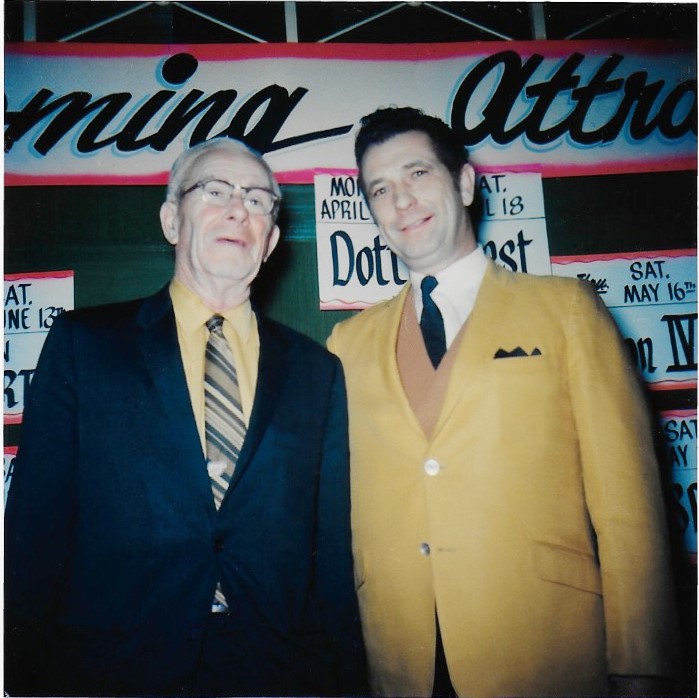
David Stone and TBS; from the dates, probably March or April of 1970. Photo courtesy Dale Strength
Will Jones: “Revised Report on Texas Bill”
TBS, who used to be a disk jockey at KTCR, came back to town and told me he was going back to work there, and I printed it. Now here’s a letter from Robert J. Rock, general manager of KTCR and KTCR-FM: “I do the hiring and firing of personnel at these stations. For your correct information, Strength has not been offered any position at these stations. And furthermore, he will NOT be offered a position here, now or in the future.”
I sense a problem there.
Minneapolis Tribune, April 23, 1970
June 1970
From June through October 1970, TBS had a string of appearances at the Flame:
- June 15 – 20 with the Tiny Harris Country Band
- June 22 – 27 with the Tiny Harris Country Band and Justin Tubb
- June 29 – July 4 with the Tiny Harris Country Band
July 1970
From July 6 to 11, 1970, TBS appeared with Jean Shepard and Warren Robb at the Flame.
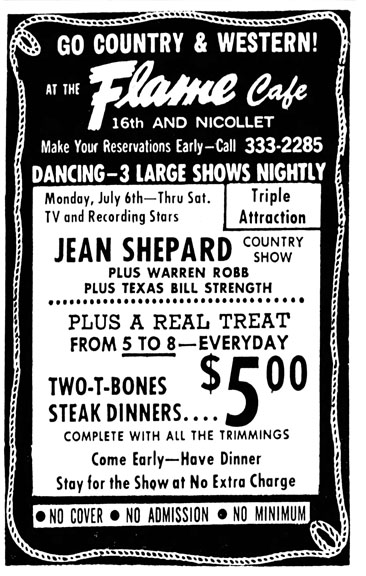
Minneapolis Tribune, July 5, 1970
From July 20 to 25, 1970, TBS appeared with Carl and Pearl Butler and Warren Robb at the Flame.
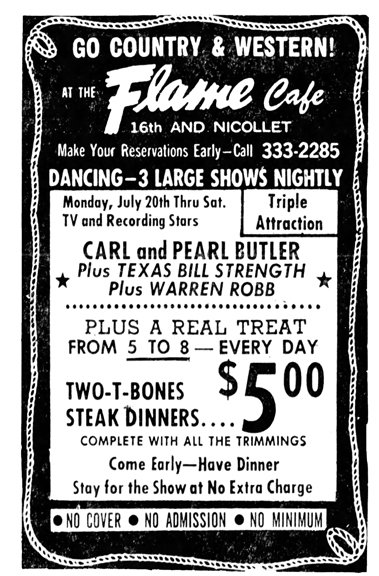
Minneapolis Tribune, Sunday, July 19, 1970
From July 27 to August 1, 1970, TBS appeared with Warren Robb at the Flame.
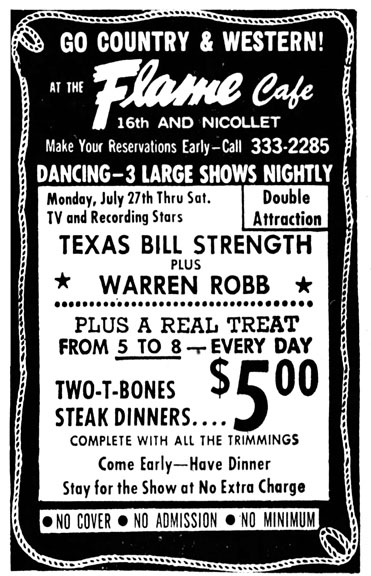
Minneapolis Tribune, July 26, 1970
August 1970
From August 3 to 8, 1970, TBS appered with Liz Anderson and the Willis Wade Country Band at the Flame.
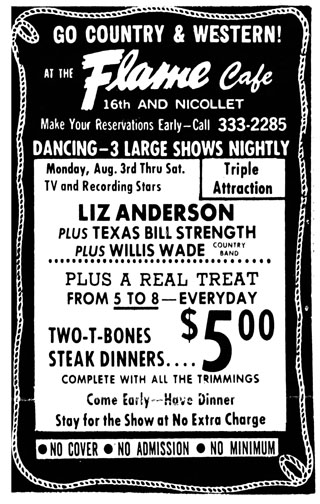
Minneapolis Tribune, August 2, 1970
From August 17 to 22, 1970, TBS appeared with Willis Wade and Johnny Darrell at the Flame.
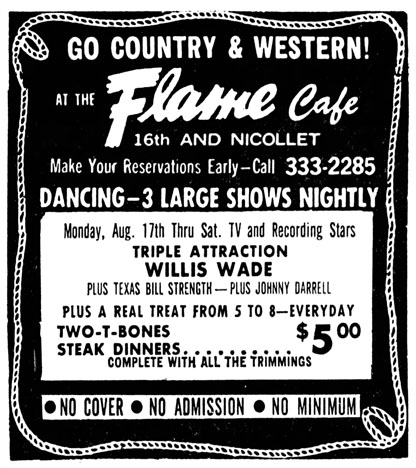
Minneapolis Tribune, August 16, 1970
September 1970
On September 26, 1970, Billboard cried, “Texas Bill Strength, where are you? I was just listening to one of your old Sun Records tunes that Shelby Singleton has repackaged on a variety LP. Great.”
From September 28 to October 3, 1970, TBS appeared with Jerry Naylor and the Clyde Owens Country Show at the Flame.
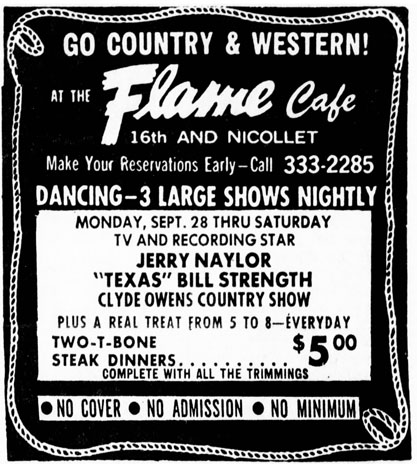
Minneapolis Tribune, September 27, 1970
October 1970
From October 12 to 17, 1970, TBS appeared with Billy Maphis and Rose Lee, plus the Billy James Country Show at the Flame.

Minneapolis Tribune, October 11, 1970
From October 26 to 31, 1970, TBS appeared with the Cantrells and the George Deaton Country Kings at the Flame.

Minneapolis Tribune, October 25, 1970
1971
March 1971
HILLBILLY HADES
RECAR
“Hillbilly Hades” was a clever takeoff on the popular and sentimental “Hillbilly Heaven,” written by TBS with Eddie Dean and Hal Southern. TBS first cut it on Recar Records, yet another of George Garrett’s Minneapolis labels, issued in 1971 as 45-9001. The flip side was “Nervous as a Cat,” another comical song.
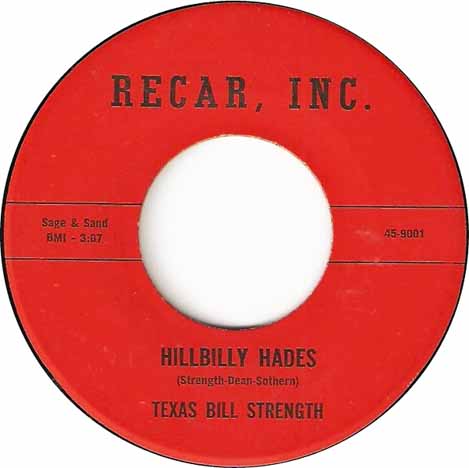
Both songs were then reissued on the Starday label, with the exact same number in March 1971. Bill had been identified as a Starday performer in 1967 but hadn’t had any records released.
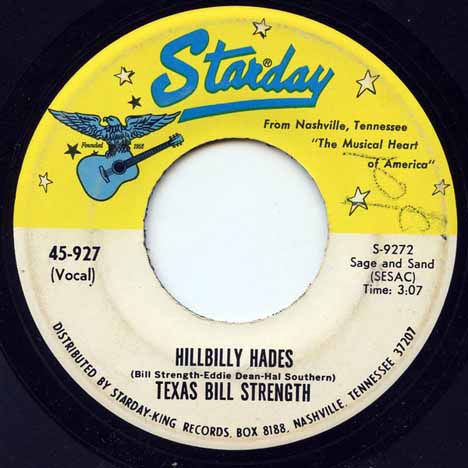
On March 28, 1971, Billboard reported, ” TBS’s new single on Starday is titled ‘Hillbilly Hades,’ a parody of Tex Ritter’s big click of a few years back, ‘Hillbilly Heaven.’ ”
TBS spent two days in Cincinnati last week, plugging his new Starday release, a parody of one of Tex Ritter’s big ones of a few seasons back. Strength stopped here en route from Nashville to Minneapolis, where he continues to spin country platters while appearing as a regular at the Flame. (Billboard, March 13, 1971)
TBS is alive and well in Minneapolis. He wrote Paul Ackerman, music editor of Billboard, a letter about a new Starday Records single called “Hillbilly Hades,” which is a parody of the old “Hillbilly Heaven” country disk. For those of you who don’t know, Texas Bill one of the great country air personalities. (Billboard, April 3, 1971)
April 1971
Since this came out of a St. Cloud paper, let’s assume that The Office is in the Granite City. TBS had an engagement on April 1 and 2, 1971 with the House Bros. and Bobby Byrd.
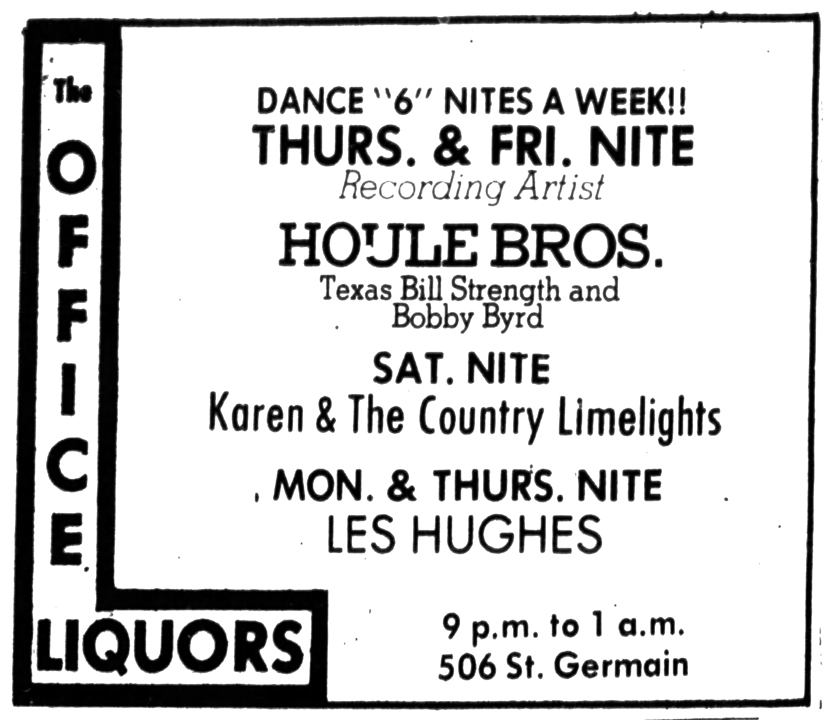
St. Cloud Times, April 1, 1971
May 1971
On May 13 and 14, 1971, TBS appeared at Cowtown U.S.A., presumably near Rochester, Minnesota for a free show with The Guys and Dolls. Although his new hit, “Hillbilly Hades” was spelled wrong,” perhaps the folks at Cowtown didn’t notice. A subsequent ad suggested that folks come out “after the fights.”
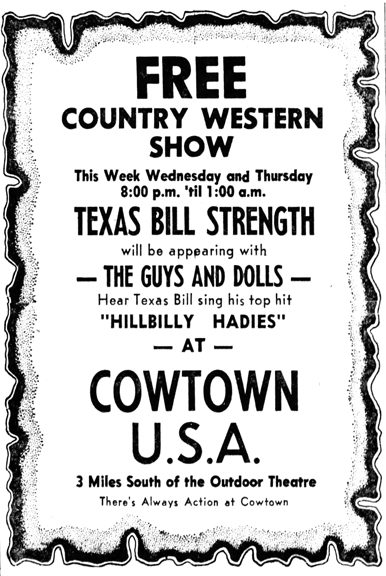
Rochester Post Bulletin, May 11, 1971
July 1971
On July 4, 1971, TBS and Marvin Rainwater performed two shows at 6 and 9 pm at the Stagecoach Inn, between Savage and Shakopee, on Highway 101.
TBS and Marvin Rainwater opened Cooper’s West, the former Seventh Street Rec, 1209 W. 7th in St. Paul, in July 1971. (Connie’s Insider, July 24 to August 20, 1971) Bob Fernow remembers TBS doing some live radio broadcasts from Cooper’s West. The venue didn’t stay country for long.
November 1971
On November 9, 1971, TBS began a stint at a local Minneapolis club called the Filling Station.
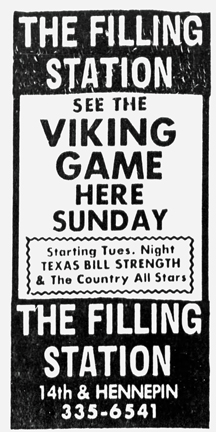
Minneapolis Tribune, Friday, November 5, 1971
Ronnie Pugh quoted an unnamed local newspaper (not the Minneapolis Star or Tribune) that had interviewed TBS in November 1971.
Times have changed … since Bill arrived in 1955 with his guitar. There are at least 20 all-country music night clubs, with at least 15 more which occasionally bill country performers. Progress, undoubtedly, but a scene in which Texas Bill Strength could not possibly hold the upper hand that he once did.
December 1971
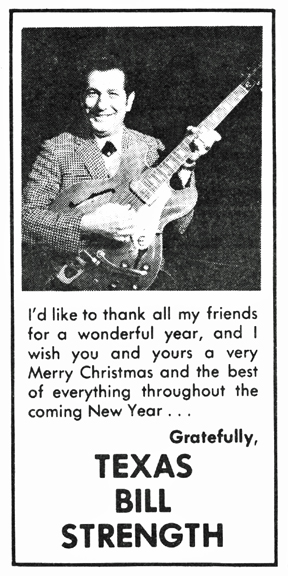
Country & Western News-Scene, December 1971
January 1972
The 49 Club in New Brighton was a country place – see the link for more details. TBS began a run there in January 1972.
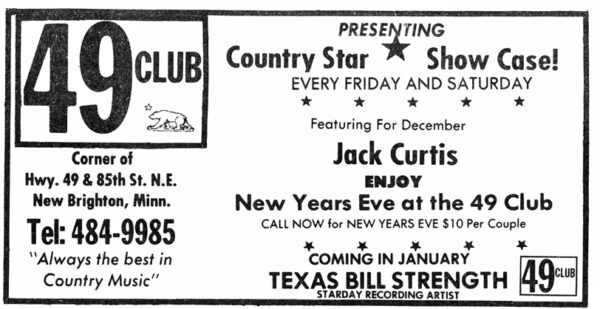
Country & Western News-Scene, December 1971
1972
February 1972
From February 22 to 27, 1972, TBS had a stand at the Mermaid Supper Club, which featured Country music.
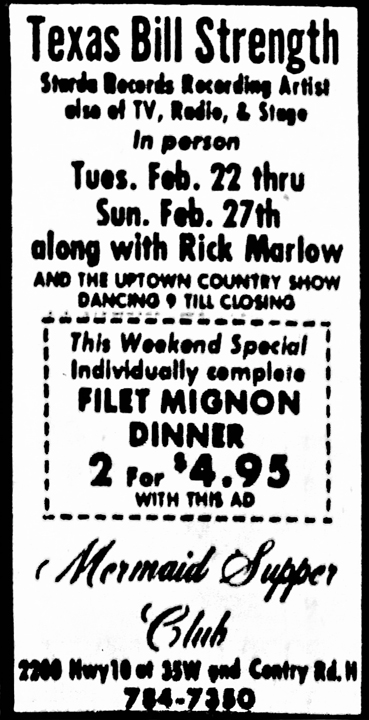
Minneapolis Star, February 1972
August 1972
THE RIVERSIDE
The ad below confirms that TBS performed at the Riverside Supper Club in Ludden, North Dakota, on August 11 and 12, 1972. The Riverside was the last venue Texas Bill ever played, on August 5, 1973.

Image courtesy Dale Strength
September 1972
On Sunday, September 24, 1972, TBS appeared on the Charles McCarty Show, a late-night (10:30) TV show on Channel 5. McCarty was the former Mayor of St. Paul (1970 to 1972), and the purpose of the show was to antagonize his guests like radio host Joe Pyne. On the same show McCarty had the Imperial Wizard of the KKK, a female “Cigar Advocate,” an International Mediator, and a “Guru who discusses life.”
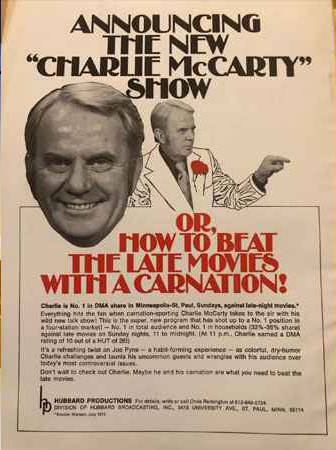
Image from KSTP.com
October 1972
BENEFIT FOR FRANK MAY
On Sunday, October 15, 1972, the Country music community held a benefit for the critically ill guitar player and singer Frank May at Denny’s Loft in St. Paul. “Texas Bill Strength hosted the show and deserves much credit..” reported the Country & Western NEWS-Scene, November 1972.
Other participants included:
- Barbara Lee Mac
- Jan and Patti North
- Marvin Rainwater
- Chill Hilmin
- Bob McDonald
- Bob Flynn
- The Guys and Gal
- Freddie Haas with his Golden Nuggets
- The Mark Allen Trio
- Fern Dale
- Kim Martin
- Ray Boyles
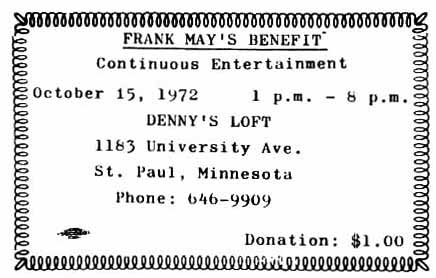
Ticket courtesy Jan Sherman, via Derik Olson
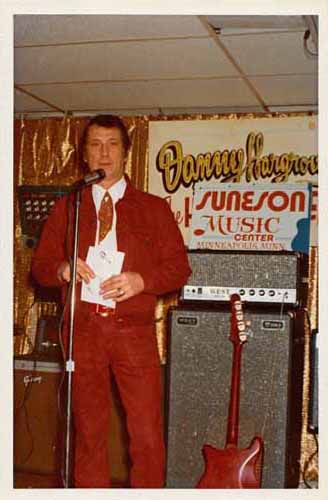
Photos courtesy Jan Sherman via Derik Olson


TBS, Fern Dale, Barbara Lee Mack, and Jan Sherman. Photo courtesy Jan Sherman Well over $2,000 was raised. Frank May, nee Mazzitello, died the following Sunday at age 38.
November 1972
SOUND 80
The November 1972 Insider mentioned that Sherwin Linton had cut a single at Sound 80. “The Sundowners, Texas Bill Strength, and Mary Beth and Chill Hilmin have also recently cut sessions at Sound 80.”
1973
March 1973
After discontinuing its country format a year ago, the Flame reverted to form and began bringing in big name country performers again. There were now two full-time country house bands: TBS and his group in the front lounge and the Chill Hilmin Country Show in the main room. Part of the renewed interest can be attributed to the addition of an all-night country show on KTCR-FM with Gregg Elsworth. KSTP AM also had a midnight to 6am country show directed specifically at truck drivers and other night people, hosted by Al Carlson. KSTP had a powerful 50,000 watt signal. (Billboard, March 10, 1973)
May 1973
BRITE STAR RECORDS
On May 12, 1973, Billboard announced that TBS, still active with radio and television in the Minneapolis area, has signed with Brite Star Records. The label has a Nashville address. It was his last record label.
TBS cut two sides for Brite Star, issued as No. 2448:
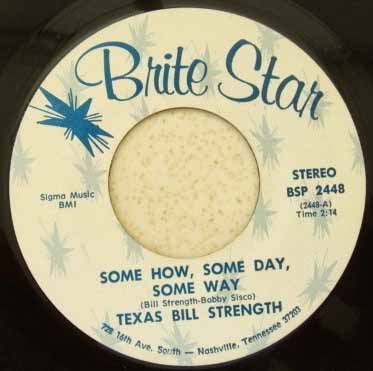
“Some How, Some Day, Some Way,” written by TBS and Bobby Sisco 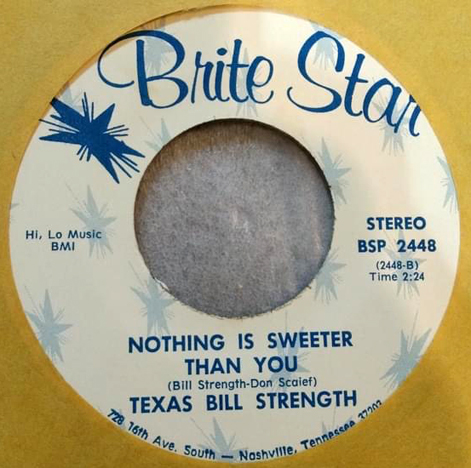
“Nothing is Sweeter Than You,” written by TBS and Don Scaife
June 1973
The June 1973 Insider reported that TBS was working at Larry Henning’s By George Inn in Anoka, by Lake George.
Johnny Cash, June Carter, Carl Perkins, and the Tennessee Three were in town on June 13, 1973, to perform at the Minneapolis Auditorium. TBS caught up with him while he was in town, and wrote about him in his “Down Memory Lane” column in the Upper Midwest Country & Western News Scene magazine. The article also included this photo of the two, taken on that June 13, 1973, day.
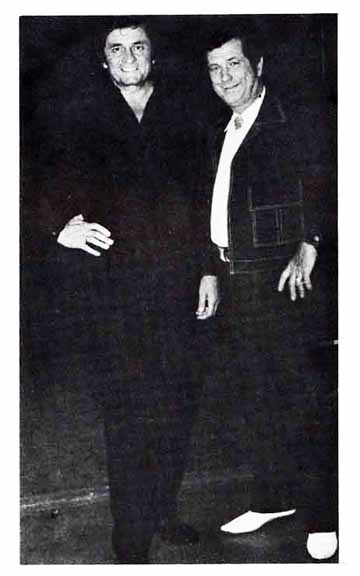
JR RANCH
On June 15, 16, and 17, 1973, TBS performed at the JR Ranch in or near Eau Claire, Wisconsin, run by John Roucheat (hard to read). On the 16th and 17th, the Ranch was running a Rodeo, and Tex Ritter was also on hand for entertainment. Attractions included Dancing under the stars to Country Western Music June 15, 16, & 17 by Texas Bill Strength, Star of Radio, TV, Stage and Records.

Eau Claire Leader-Telegram, June 6, 1973 The Insider reported on this appearance in its July 1973 issue, but true to form garbled it to say it was the H&R Ranch. They did did get the Tex Ritter part right, though. Unless TBS and Ritter were at some other ranch as well?
Although the issue below of the Upper Midwest Country & Western News-Scene is labeled August 1973, I will put it here because events that took place in July are reported in the September issue (below). This issue features Texas Bill on the cover, and promises stories about his friend, Hank Williams.
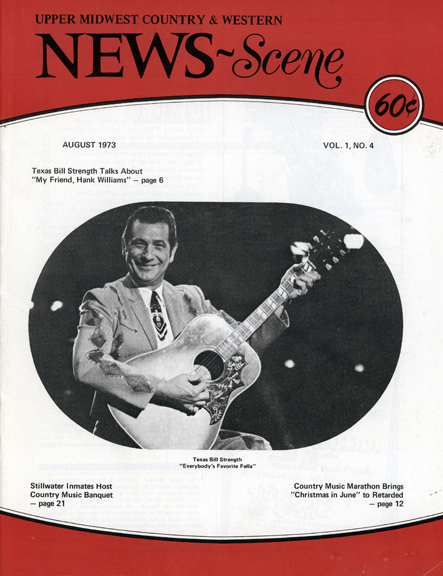
July 1973
TOURS TO NASHVILLE
Since about 1971, bus tours to Nashville had become de rigueur in the country music world, and the July 1973 Insider reported that tours to Nashville from Minnesota were “booked up tight for months.” In the September issue of the Upper Midwest Country & Western News – Scene, written in advance, there was a half-page spread: “Texas Bill Strength Nashville Fun Fest Planned.”
From time to time, so many friends of mine have asked about a trip to Nashville to see the Grand Ole Opry and other special places of interest in Music City, such as the Country Music Hall of Fame, a tour of the Opry stars’ homes, etc., So . . . I’ve decided to put together a package deal whereby you can enjoy a four day vacation . . . I’m chartering an air-conditioned Greyhound bus.
The package included two dinners ate one of Tex Ritter’s resaurants, and visiting the Opry on both Friday and Saturday. Bill would appear on the Opry on one of those nights. Musicians would entertain on the bus! The cost was only $125 – he wrote that other companies were offering the same trip for $225. The bus would leave Minneapolis and St. Paul on Thursday, August 23, 1973, and arrive in Nashville in about 14 hours. It would live Nashville Sunday morning, August 26.
The quarterly meetings of the officers and directors of the Country Music Association were held on July 9 – 11, 1973 – the first time in our City. The Insider reported that Sound 80 gave a cocktail party at their studios, and TBS was there, along with Roger Suneson, Tex Ritter, LeRoy VanDyke, and Roger McGuinn.
THE CEA
On July 22, 1973, a picnic was held by the Upper Midwest Country Entertainers Association (CEA) at Wally’s Resort, Lake Sarah, near Loretto, Minnesota. The newly-formed organization was spearheaded by Freddie Haas, and attempted to unite area country musicians where other attempts had failed. The interim committee consisted of:
- Freddie Haas, president
- Billy Hines, vice president (replaced by TBS because of other commitments)
- Linda Tretter, secretary-treasurer
- Freddie Miller, seargant-at-arms
- Ray Boiles, publicity
As reported in the September 1973 edition of the Upper Midwest Country & Western News – Scene magazine, TBS had invited Tex Ritter to one of their planning meetings, which had, up to that point been fairly contentious. Although Ritter, “bone tired” from the CMA meetings, said he could only stay a few minutes, Ritter stayed for hours and got the nascent organization on track. TBS organized the picnic grounds, and others took on tasks that made the event a total success, according to the magazine.
The photo below shows Freddie Miller, Tex Ritter, Freddie Haas, and TBS at Billybud’s.
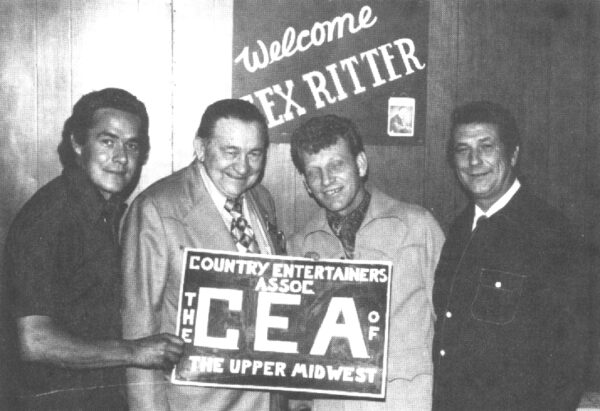
Photo courtesy Upper Midwest Country & Western News – Scene By the time the September issue of the UMC&W News-Scene describing the activities of the CEA went to press, Texas Bill had had his accident (see next chapter). The photo of he and his good friend Tex Ritter was placed on the cover.
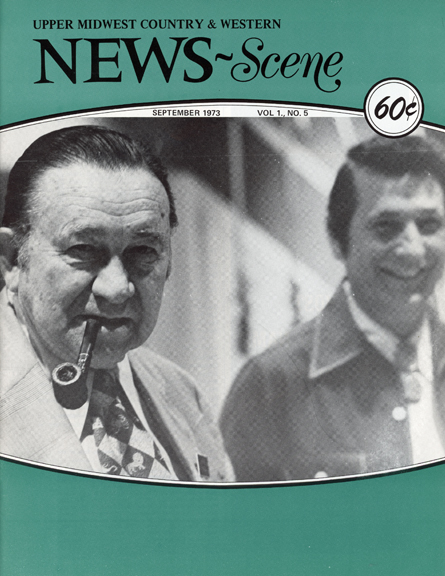
The cover of the September 1973 issue of Upper Midwest Country & Western News – Scene
September 1973
Plans were made for Bill to be one of the Wednesday guest stars at Billybud’s, according to Nancy Brown’s “Around the Town” column in the Upper Midwest Country & Western News – Scene, September 1973. Under the circumstances, it is unclear whether this ever happened. She refers to him as “Everybody’s Favorite Fella.”
In the same issue of Country & Western News – Scene, Bill’s own column, “Down Memory Lane,” mentions that he has just returned from Canada.
Texas Bill Strength: Family History
This first section gives some background on Texas Bill’s family, going back to his grandparents. First we look at the Strength family on his father’s side, and then a brief look at the Yielding family on his mother’s side. Since all the Strengths were named William, the generations are color coded:
- Grandparents are Red
- Parents are Green
- Texas Bill Strength (TBS in this document) is, at least in this section, Purple.
Adding to the confusion is the protocol that when a Sr. dies and the Jr. has a son with the same name, the Jr. becomes the Sr., and the son becomes the Jr.
THE STRENGTH FAMILY
Despite his moniker, Texas Bill Strength was actually born and bred in Alabama. At the end of the 19th and beginning of the 20th Centuries there were many, many Strengths in the State of Alabama, and very few anywhere else. William Thomas Strength, Jr. comes from a long line of men with the same name.
Looking for early William Strengths, the Census of Free Inhabitants of Western Division, Tallapoosa County, Alabama, taken on August 8, 1860, shows a William Strength, born in Georgia in 1834. An undated document shows a William Strength in the 34th Alabama Infantry of the Confederate Army. Whether this was the same man or if he/they were relations to our Strength family is unknown.
1819
John Henry Strength was born in 1819. He and his wife Louisiana Stevens Strength were the parents of William T. Strength, and therefore TBS’s great grandparents.
Their children were:
- John Henry Strength, Jr., born 1841.
- Hugenius Strength, born 1847
- Columbus Washington Strength, 1843 – 1915
- Mary Strength, born 1850.
- William T. Strength, born 1855.
1883
TALLASSEE
William T. Strength married Mary Artimiss Holt on July 1, 1883, in Elmore County, Alabama. William was TBS’s grandfather. He was born in May 1864. [1855] Artimiss was born in 1853 in Summit, Alabama.
1889
Lena (“Leener or Lener”) Strength was born in May 1889 to William and Artimiss. Lena married Lee Milton McDaniel. In 1910 she, Milton, and her sister Ada lived in Tallapoosa, where they all worked at a cotton mill, Milton as a drawer, and the women as spinners. In 1918 the family lived in Odenville, in St. Clair County, where they were farming. In 1920 the McDaniel’s had three children and lived in unincorporated Jefferson County. Milton worked as a teamster at a sawmill, where many of his neighbors were coal miners. In 1935-1940 the family lived in Branchville, Alabama, with four of their children. Milton was listed as a farmer on the 1940 Census. Milton died February 19, 1955, in Leeds, Alabama. Lena died on April 25, 1962, in Bell City, Alabama. She was buried at Bethel Baptist Church Cemetery in Branchville.
1890
Willey Strength was born in December 1890 to William and Artimiss. Willey is no doubt a nickname for some unknown Christian name. No information could be found about Willey, and the last we see of him is in 1900 when he is 9 years old. There is a Bill, Jr. in the same family at that point, so it’s unlikely that Willey’s real name was also William, but it’s unclear.
1891
Lige Strength was born on August 18, 1891, in Tallassee, Alabama to William and Artimiss. He was inducted into the Army on March 15, 1918, at Ashville, Alabama. He served from March 20 to December 6, 1918. At that time he lived in Acmar, Alabama. He was also a coal miner. He married Minnie P. Sullivan on March 7, 1923 in St. Clair County, Alabama. He died on May 19, 1930, and was buried at Mt. Olive Cemetery in Morris, Alabama.
1893
Ada Bell Strength was born in May 1893, to William and Artimiss. Ada married A.C. Brown. In 1930 Brown was a mechanic at a textile mill in Russell, Alabama. In 1935-1940 the Browns lived in Girard, Alabama. In 1940, Brown and three of their sons worked in a textile mill. In 1963 she was listed in James’s obituary as Ada Brown, Phenix City. When she died on July 11, 1970 her last name was Thomaston. There is a marriage notation for her on October 10, 1951, in Russell, Alabama, but no spouse is listed.
1895
Ivy L. Strength was born on January 19, 1895, to William and Artimiss. On June 10, 1911, Ivy married Ollie Parker in Tallapoosa and had one child. Then she married a Mr. Gray and had two children. On November 12, 1928, she married Robert Jefferson Mashburn (1881-1964) in Etowah, Alabama. Mashburn had four children. In 1963 Ivy lived in Pell City, Alabama. Ivy died on June 29, 1985, in Ragland, Alabama. She is buried in Mount Zion Cemetery in Pell City.
Mary Artimiss Holt Strength died on April 10, 1895, in Warrior, Alabama. Warrior is now a northern suburb of Birmingham. At the time of her death, Warrior’s population was about 1,000.
On December 14, 1895, William married Rosa Vidella “Deller” McKay or McCay. Della is TBS’s Grandmother. She was born in August 1875. She was the daughter of James and Harriet McCay.
1897
William Thomas Strength, Jr. was born in May 1897, to William and Della Strength. This William Strength was TBS’s father. He went by WT, and became WT, Sr. when his father died.
1899
Art Strength was born in August 1899, in Tallassee, Alabama, to William and Della.
1900
The Census taker in the 1900 Federal census (June 13, 1900) spelled the family’s names the way they were pronounced, including their surname, written as “Strinth.” Della was listed as “Deller,” and the children were listed as:
- Leener (Lina)
- Willey (unknown real name)
- Lige
- Adie (Ada)
- Ivie (Ivy)
- Bill Jr. (William, Jr.)
- Art
William T. Strength was listed in the 1900 Census as a farmhand.
James Solomon Strength, son of William and Della, was born on August 22, 1900, in Alabama. James never went to school and was illiterate – he signed his WW I registration with an X. His WW II registration indicated that he lived in Irondale, Alabama, was unemployed, and that his contact person was his mother, R.V. Bruner. James died on June 11, 1963. His obituary stated that he had lived in Leeds (near Moody), and that he had lived in Irondale most of his life. It said that he was a retired coal miner. He was buried at New Hope Baptist Church cemetery. He was survived by his wife, Viola, of Leeds. His brother, W.T., was living in Houston, as was his half-brother, R.A. Bruner.
1901
Susan Frances “Fannie” Strength, Della and William’s daughter, born August 26, 1901, in Montgomery, Alabama. Fannie married James Jason Alexander “Shug” Isbell. Shug was born in 1872 and died in 1957. Shug was 46 and Fannie was 18 in 1920. He had daughters aged 18 and 16 at the time. Together they had at least three more children. In 1920 they lived in Bold Spring, Alabama. In 1930 he worked at the sawmill on Bessie Ferry Road in Jefferson County, Alabama, near her brother William. In 1940 Rosa’s obituary said that S. Isbell lived in Irondale. James’s obituary says that Fannie Pilkington lived in Gate City, Alabama, in 1963. Susan died on January 30, 1972, in Mobile. Her obituary in the Mobile Register indicated that her name was Mrs. Susan Frances Pilkington, a native of Montgomery. The obit does not list anyone named Pilkington in the list of survivors.
1901-1906
William T. Strength died sometime between 1901 and 1906.
1906
Della Strength, William’s widow, married Reuben Marion Bruner on May 13, 1907, in Jefferson County, Alabama. Reuben was born in 1864 [or 1871] in North Carolina. His parents were from Virginia. It was the second Marriage for both Della and Reuben.
1907
Lorna Geneva Bruner, Della and Reuben’s daughter, was born on September 19, 1907, in Birmingham. She first married James Barnett at age 18 on January 3, 1923, using the name Loney Bruner. They were married at Roberson Mines, Jefferson County. She married Willie Green Braswell on October 26, 1929, using the name Geneva Barnett. In the 1930 Census she was listed as Mary for some reason, and was living in Cotton Hill, Alabama where Willie was listed as a farmer. In 1935-1940 the family lived in Eufaula, Alabama, where Lorna worked in a textile mill. Willie was not shown to be working in 1940. In 1963 Lorna lived in Eufaula. Lorna died in September 1984 in Eufaula, Alabama. She is buried in Sardis Cemetery, Baker Hill, Alabama. Willie died on April 23, 1986, and is in the same cemetery.
1909
Raphael Anglo Bruner, Della and Reuben’s son, was born on September 13, 1909, in Tallassee, Alabama. He was only 5’ 2” and weighed 115 pounds. He worked as a truck driver. In 1940 and 1963 he lived in Houston. He died on June 10, 1978, of lung cancer in Houston, Texas.
1910
TALLAPOOSA
In 1910 the Federal Census showed that Della and Reuben M. Bruner lived on Ashhurst Ave., Tallapoosa, Alabama. By this time Della was known as Rosie. Reuben “Ruby” and Rosie both worked in cotton mills – Reuben as a weaver, Rosie as a doffer. Children living with them were listed as Louie G. and Rachel A. Bruner, and James, Susan, and William Strength.
1913
Rufus Bruner, son of Rosie and Reuben, was born in 1913 in Rodo, North Carolina. He died on April 6, 1923, at the Roberson Mines in Jefferson County, Alabama at the age of 11. He is buried at the Hillview Baptist Church Cemetery in Forestdale, Alabama.
1914
Martha Dulcina “Cinny” Bruner, daughter of Rosie and Reuben, was born on August 23, 1914, in North Carolina. She married George N. Mitchell on October 26, 1931. In 1940 George was a laborer in Irondale. In 1963 she lived in Irondale, Alabama. In 1940 her mother Rosie (listed as Rosa) and her half-brother James lived with her and her family. She died on February 17, 1994, in Fountain Valley, California.
1916
Rosa M. [Vidella] Bruner, daughter of Rosie and Reuben, was born on May 2, 1916, in Charlotte, North Carolina. On August 2, 1930, at age 14, she married Therel Deforrest Carlton, age 18, in Irondale. Therel was born in Mississippi on May 12, 1912. Both of their fathers had to give their permission to wed. On February 19, 1933, son Robert Lewis Carlton was born. In 1934 Rosa and Theral lived in Gate City, Birmingham. In 1935 she was a laundress in Birmingham. They divorced in February 1939, and at the time of the April 12, 1940, Federal Census, Robert was living with Theral and his new wife. Theral apparently married again in 1944.
Rosa married Frank M. Burton on August 24, 1939, in Jefferson County. Frank was born on December 8, 1909, and was a steamfitter. At the time Rosa was a waitress. She died on November 23, 1940, “at a local infirmary” in Birmingham at the age of 24. She and Frank had lived at 1021 12th Street N. The obituary said that they had one son and two daughters. Rosa was interred at the New Hope Cemetery, Birmingham.
1920
In 1920 Rosie and Reuben lived in unincorporated Jefferson County and Reuben’s occupation was listed as “charcoal burners.” Their household included only Rosie and Reuben’s children:
- Lorna
- Raphael
- Rufus
- Dulcina
- Rosa
1935
In 1935 Rosie (listed as Rosa) was a housekeeper in Birmingham, according to the Birmingham directory.
1940
In 1940 Rosie lived with daughter Cinny Bruner and son James Strength in Irondale, according to the Census. Daughter Rosa’s obituary stated that she was survived by parents Mr. and Mrs. R.N. Bruner, Irondale.
1942
Rosie died August 5, 1942, Jefferson County, Alabama
THE YIELDING FAMILY
The Yieldings were TBS’s relatives on his mother’s side.
1888
ONEONTA
George McGovern Yielding (TBS’s Grandfather) was born in March 1859 in Alabama. Both of his parents were also from Alabama. He died on January 25, 1915, in Oneonta, Blount County, Alabama.
George’s wife Lucy T. Yielding (TBS’s Grandmother) was born in March 1863 in Alabama. Her parents were also born in Alabama.
In June 1900 Lucy and George reported to the Census that they had been married for 12 years, which would have made it about 1888.
Their son John Henry Yielding was born in April 1888.
1890
In the 1890 Federal Census, George was listed as a truck driver. They reported that two of their seven children so far had died.
- Mary Yielding was born in September 1890.
- Eliza Belle Yielding was born in April 1892.
- Gypsie Lucille Yielding was born on July 4, 1893, in Oneonta, Alabama.
- Tomie G. Yielding was born in June 1898.
- Jessie Leon Yielding (TBS’s Mother), born on September 30, 1903.
- Katie M. Yielding was born in 1907.
1910
Florence N. Yielding was born in 1910.
The 1910 Federal Census reported that the Yielding family lived in Oneonta.
1915
George Yielding died in 1915, when Jessie was only 15 years old.
1918
On September 9, 1918, at age 15, Jessie married Sam Cross Sandling. Sam was 21 years old, born on March 2, 1897, in Birmingham. In a 1918 Birmingham phone directory he was listed as a butcher, but on his World War I registration card (undated) he listed his employer as the Alabama Great Southern Railway. Sam was inducted into the military from Bibb, Alabama on August 26, 1918, and first assigned to a base in Georgia, but was apparently able to make it back to Birmingham to marry Jessie in September. Jessie’s mother Lucy had to sign an affidavit giving permission for her to marry since she was a minor. Sam Sandling died on October 16, 1918 – where or how is unknown. It was the height of the Spanish Flu, and many of the men conscripted to fight in WW I (Sam was to be a boiler maker) never made it to France. He was interred at the Macedonia Baptist Cemetery in Oxford, Georgia.
1919
Jessie had Sam’s son, Eugene Henry Sandling, TBS’s half-brother, on June 9, 1919, in Birmingham. Although there was no shame in being a war widow, and the baby was legitimate, it appears that Jessie took back her maiden name. Other evidence that of Eugene’s real father was that one of his brothers named him as his contact person on his military registration form, using his real last name. However, the name Strength was used on some Census documents.
Brother Albert’s World War II registration card named Eugene as the person who would always know his address. At that time, Albert listed Eugene’s address as 4038 Sixth Ave. No. in Birmingham, which was a bit off from WT and Jessie’s 4032 address. Eugene served in the Marine Corps from April 1, 1944 to March 23, 1947. He married Mattie Beatrice Hall on May 6, 1939 – she died in 1988. His second wife was Christine Kolojacko (May 30, 1932 – January 11, 2011). Eugene died on December 19, 1990, in Conroe, Texas, and is buried at Woodlawn Cemetery, Houston.
JESSIE AND WILLIAM, SR.
1918
Since Lige lived in Acmar in March 1918 according to his World War I military registration card, his brother William probably moved with him from Tallapoosa as well, but there is no hard evidence.
William served in World War I, but if so his military registration card doesn’t seem to be on Ancestry.com. He would have been 20 years old, so it would make sense.
It is unclear when Jessie and William got married but it was probably 1919 or 1920.
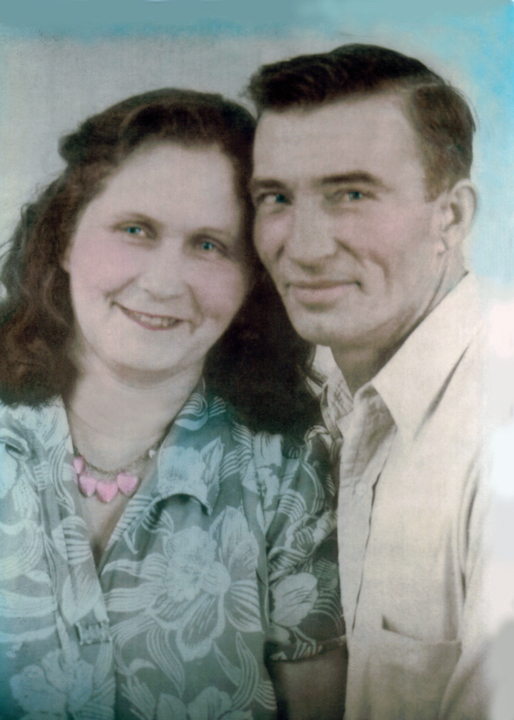
Jessie and William T. Strength Photo courtesy Dale Strength
By all evidence, the Strength family was a poor, itinerant, mining camp family that moved to where the mining jobs were from about 1920 to the early 1940s. Counting Eugene, Jessie’s son by a previous marriage, the Strengths had eight boys. TBS was the fifth of the eight.
1920
MOODY
The 1920 Census showed the family living on “Private Road, Mining Camp, St. Clair County” (town of Moody scratched out). The road no doubt belonged to a mining company, as the Census showed that William T. Strength, age 22, was a coal miner. Jessie was 18 years old. The household also included baby Eugene and William’s brother Lige Strength, now age 30.
Moody is located about 15 miles east of Birmingham. It was known as Moody’s Crossroads well into the 1950s, the crossroads being Park Ave. and Moody’s Parkway/Highway 24/Highway 411. At the end of Park Ave. is the Star Ridge Landfill (shown on the map below as Advanced Disposal Moody Landfill), 770 acres described as a former coal mine.
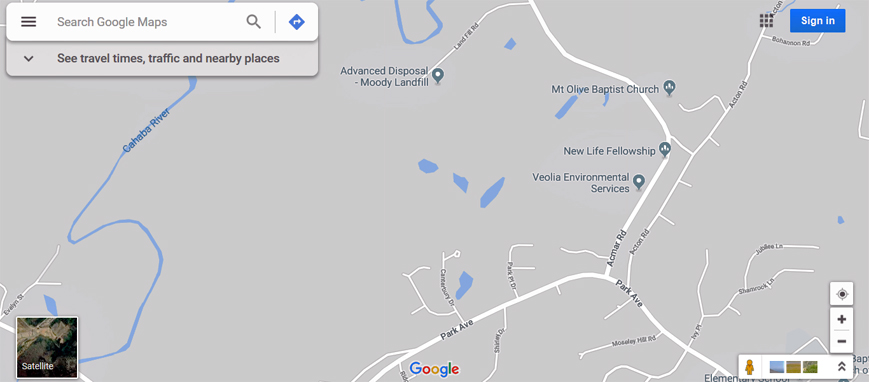
1921
Fred Thomas Strength was born on January 22, 1921, in Acmar, Alabama to William and Jessie. Uncle Fred must have been an interesting character. In 1937, at only 16, he and his dad were convicted of “Distilling” in Jefferson County, Alabama. (See 1937 below.)
In February 1942, Fred’s military registration revealed that he had a “scar across upper lip.” Later that year, in September 1942, he was convicted of “contributing to the dependency, neglect, and delinquency of a female under 18” and sentenced to 12 months in prison, court costs of $18.10, and a fine of $500. If I’m reading this right, he escaped on May 15, 1943, was recaptured on March 11, 1944, and discharged on September 24, 1944 – “Paid out.”
Even his love life was confusing. Documents say he married Jimmie/Jemmie Lee Watson in Miller County, Arkansas, on May 28, 1950, but then he married her again on June 20, 1953, in Houston. She died on February 8, 1988. He died on July 15, 1988, in Liberty, Texas.
1922
Albert Clark Strength was born on September 12, 1922, in Acmar, Alabama. In 1942 he lived in Birmingham with his parents W.T. and Jessie and worked as a delivery man. His World War II draft registration card noted that he had a long scar on his right leg. He enlisted in the Army on September 21, 1942. In 1950 he lived in Rushville, Nebraska. On May 23, 1951, he married Nellie Florine Alfred in Houston. He died on July 22, 1993, in Galveston, Texas.
ACMAR
Much of the following information comes from the following people:
- Jane and Vernon Barker, Acmar residents. Jane provided me with a Moody/Acmar calendar issued by the Lion’s Club that includes photos and historical information.
- William Rowell, a young man with deep roots in Acmar, having grown up in the house that the school teacher occupied during the mining days.
- Donna Turner, Acmar resident historian, who has provided information and photos.
- Penny at the Moody Public Library, who shared historic photos.
Acmar is an unincorporated community in St. Clair County, three miles from Moody. It was founded in 1908 by Henry F. DeBardeleben, founder of the Alabama Fuel and Iron Company, who opened two coal mines at Acmar. The name Acmar is a combination of two mines, Acton and Margaret – Margaret was named for Henry’s daughter-in-law. Henry died in 1910 and was succeeded by his son Charles, who the miners and their families reportedly called “Uncle Charlie.”
Donna Turner says that most babies at that time were born at home with the company doctor in attendance. Those with very serious illness or injuries went to South Highlands Infirmary in Birmingham.
Several mines were opened in Acmar; some were slope mines and some were shaft mines. Once depleted, soil and rocks were removed and they became strip mines, with coal harvested by drag-line equipment. The soil was then replaced or ponds were built. Coal production peaked in 1926.
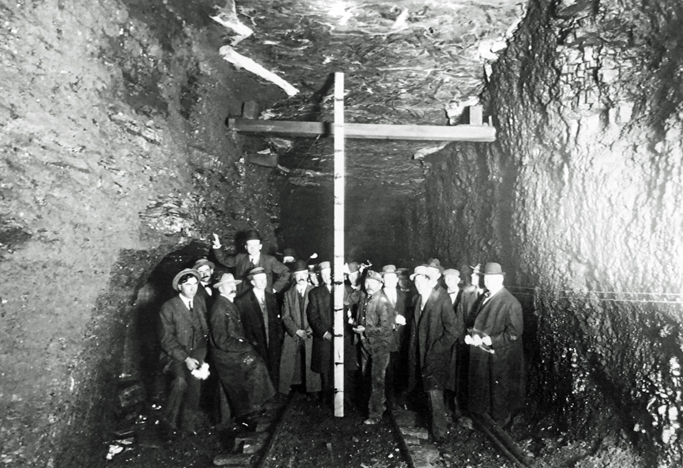
Photo courtesy Moody Public Library Jane Barker’s calendar says that in 1926 “Uncle Charlie” hired experts to teach the miners to garden and their wives how to can and preserve the food their husbands grew. These skills allowed the miners to weather the Depression without having to accept relief.
Donna reports that “the company also promoted music and even brought in a musician to teach music, mostly to the young people, and the band played at many company events.”
Not all was rosy at the mine, apparently. Wikipedia, citing a book called Everyone Was Black Down There (Robert H. Woodrum, 2007) says that in October 1935, one miner was killed and six were injured when strikers belonging to the United Mine Workers of America attempted to drive into the mines. William Rowell says that there were mounted machine guns at the entrance to the Acmar mines; the concrete is still there.
The mines at Acmar closed in 1951. Several buildings from mining years remain at Acmar, which is an active residential community today. The epicenter is the Acmar United Methodist Church, still active today. Back when the mines were active, the church alternated Sundays between Methodist and Baptist services. The Strengths would likely have gone to the Baptist services. The Baptists eventually formed their own church.
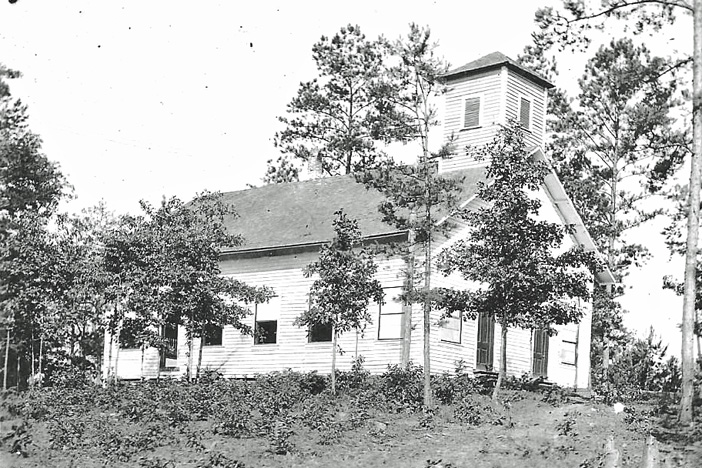
Acmar Church in the 1920s. Photo courtesy Donna Turner 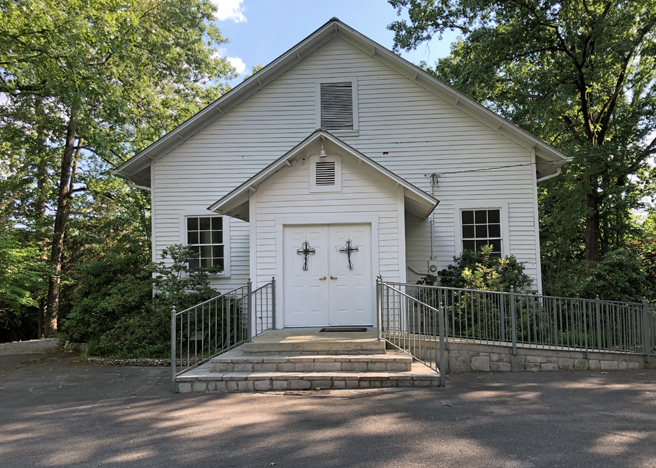
Acmar Church in 2019. The steeple was removed.
The black church is also still there, but in considerably worse shape. It appears that it was later used as a community center. The two churches were proximate to each other in mining days, but the roads have since been reconfigured, so the path between them is a little convoluted.
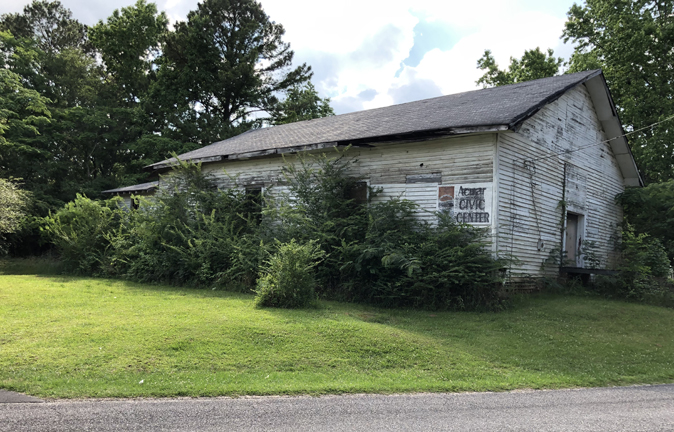
Acmar’s old black church
Other buildings that remain are the teacher’s residence, a gas station, and the commissary. As in most company towns, workers were paid in script, which William Rowell says was referred to as “clacker.”
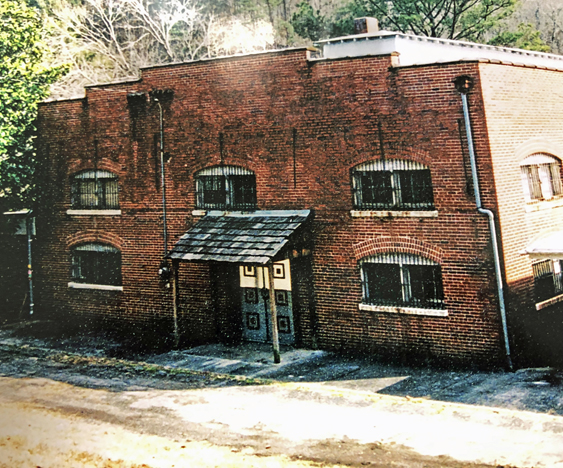
Acmar Commissary – Photo courtesy Moody Public Library
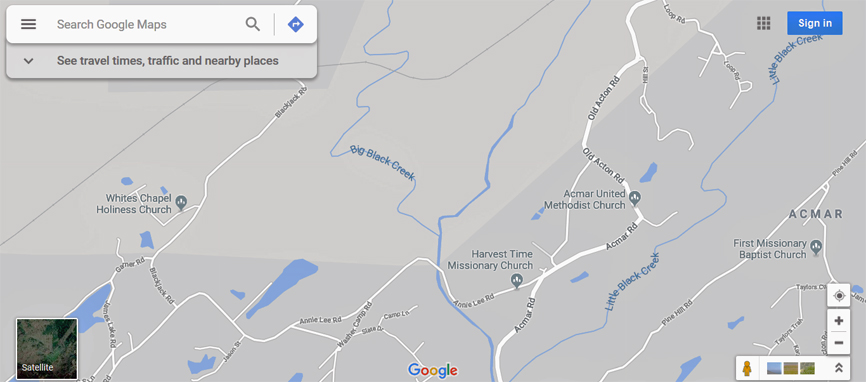
1923
IRONDALE
Edward Woodrow Strength, Sr., was born on May 22, 1923, in Irondale, Alabama to William and Jessie. He served in the Navy from February 4, 1941 to August 9, 1946. In 1950 he lived in Houston. He died on August 30, 2002.
1926
James Silas Strength was born on May 4, 1926, location unknown, to William and Jessie. James served in the Navy from February 1943 to March 22, 1947. He married Helen Lucille Hall in May 1950. In 1950 he was a painter living in Pasadena, Texas. He died on March 21, 1992, in Harris County, Texas, and is buried at Houston National Cemetery.
BESSEMER
1928
William Thomas Strength, Jr. was born on August 28, 1928. Family lore says that he was born in Bessemer, Alabama, but no birth certificate has been located. The family does not appear in the 1926 or 1932 Bessemer directories, although there are quite a few men listed in them with the occupation of miner.
Chris Eiland at the Bessemer Hall of History reports that in 1928, there were three possible places he could have been born:
- Elizabeth Duncan Memorial Hospital, known as Bessemer General Hospital, located at Third Ave. and 17th Street. This hospital was built in 1913 and closed in the early 1970s. It is now the site of Bessemer City Hall.
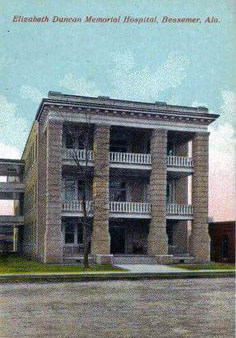
Bessemer General 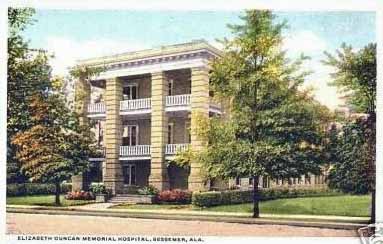
Muscoda Mine Dispensary. Muscoda was one of many Birmingham-area company towns, located at Readers Gap on Red Mountain, south of Bessemer. It is now pretty much a ghost town.
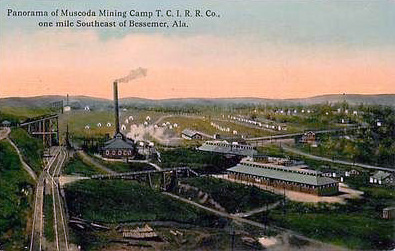
Muscoda Mining Camp
Employees Hospital of the Tennessee Coal, Iron and Railroad Company (TCI), located in nearby Fairfield. TCI became a division of U.S. Steel, and in the 1950s the hospital was renamed after Dr. Lloyd Nolan. The building was demolished in 2009. Fairfield is proud to be the birthplace of George Lindsay (“Goober” on the Andy Griffith Show..”), born in the same year as Texas Bill, but by 1930 he was living with his grandparents in Jasper.

Tennessee Coal, Iron and Railroad Hospital at Fairfield And, of course, William Jr. (TBS) could have been born at home.
IRON MOUNTAIN
Bill’s eventual wife Dorothy said that he was born in Iron Mountain, Alabama. Iron Mountain is a peak in Alabama and has an elevation of 1,188 feet. There doesn’t appear to be a town there, but perhaps there was a company mining town there in 1928? Here’s a map of the area:
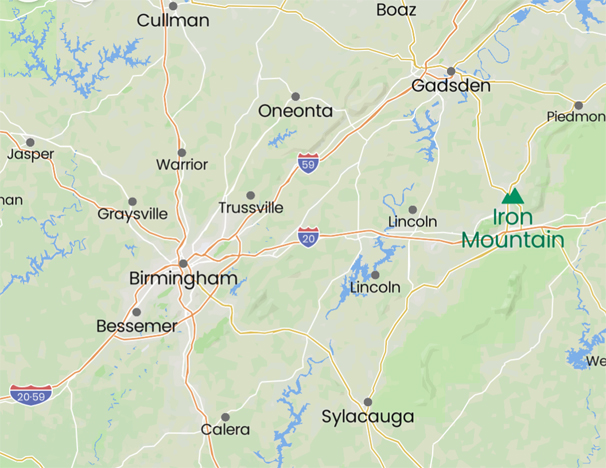
1930
BESSIE
In 1930 the Federal Census shows that the family lived in a house at 191 Bessie Road, Bessie Town, Jefferson County, Alabama. Bessie was located 22 miles northwest of Birmingham. William T. Strength and his brother James were coal miners.
William and Jessie’s Children in 1930 were:
- Eugene (Sam’s son)
- Fred
- Albert
- Edward
- James
- TBS (listed as W.T. in the Census)
BESSIE MINE
This history of Bessie was provided by Don Veasey of the Birmingham Public Library, compiled from the book The Birmingham District: An Industrial History and Guide, written by Marjorie L. White.
The Sloss-Sheffield Steel and Iron Company was the Birmingham District’s second largest producer of pig iron. Many corporations in the Birmingham District built and maintained housing and entire towns, assuming most responsibility for the general welfare of their employees up through World War II. The Sloss-Sheffield Company owned and operated housing, bathhouses, and commissaries at most of its furnace and mining operations, including Bessie.
The Bessie Mine opened in 1903. It was named for John T. Milner’s granddaughter Bessie. It was fairly common for Birmingham-area industrialists to name mines, towns, and railroads for daughters or other family members.
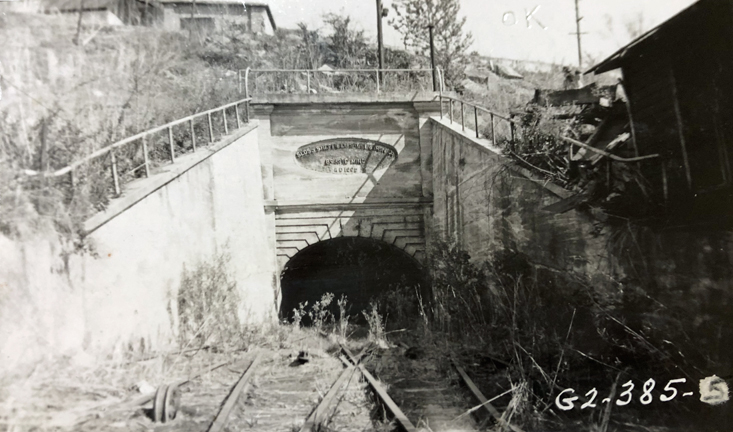
Bessie Mine entrance, 1940. Photo Birmingham Public Library The mine entrance had a 20 ft. reinforced concrete wall, was 24 ft. high, with guardrails of 3 inch pipe. The entrance was 22 ft. wide, and accommodated a double track rail system.
An article in the Birmingham News dated January 2, 1942, reports that the Bessie mine shut down in 1932. This would seem to indicate when the Strength family probably left Bessie. They had definitely moved on by 1935.
In 1942 it was announced that the Sloss-Sheffield Steel and Iron Co. would spend $700,000 to refurbish the Bessie Mine to provide materials for the War effort.
By 1955, only the Flat Top, Bessie and Hardspat mines were still in operation. As the mines closed, people moved away. Housing at the Bessie and Flat Top mines was sold to employees in 1957 and was mostly demolished in 1964.
Flat Top and Bessie closed in 1976 when the Jim Walter Corporation (successor to U.S. Pipe, the successor to the Sloss Company) reopened the new Nebo mine nearby.
ROADS IN BESSIE
The configuration of the area is basically a circle of roads that presumably surround the mine itself. There are two roads that lead to Flat Top Road, which is the main thoroughfare through the area (the orange line at the top of the map below, south of Highway 23).
Another name for Bessie appears to be Maben, which may have been the Post Office.
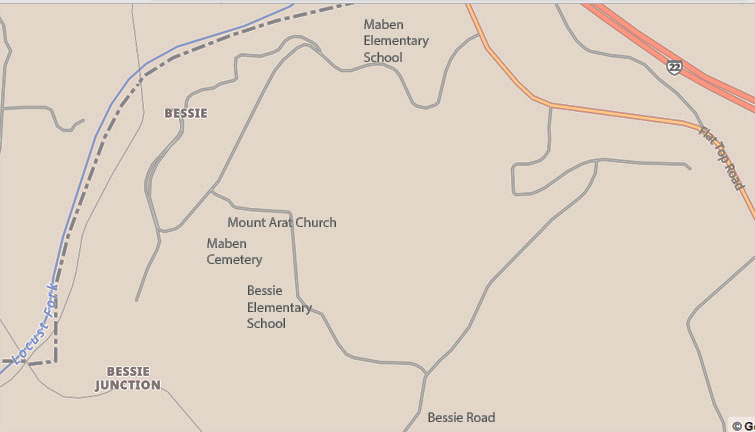
Any attempt to drive through the area now is thwarted by gates that close off the dirt roads.
On the 1930 Census form for the district that included Bessie, there were a handful of roads:
- Bessie Ferry Road: The ferry to which Bessie Ferry Road refers appears to be to the southwest of Bessie, in the bend of the Locust Fork where the river turns back to the north. This appears to be part of the road from the Palos area across the river to Porter, which seems to be a few miles from Bessie. There are a few roads now that lead toward the river but current aerial views do not seem to show any old roadbeds right to it, so the location of Bessie Ferry Road remains unclear.
- Bessie Mines Road: Some current maps still show this road.
- Bessie Road: Various maps show Bessie Road in different locations, mostly south of the mine. The location of 191 Bessie Road is unfortunately lost to history.
- Dry Ridge: Does not exist today.
- Sweet Ridge: Does not exist today
- Lindberg: Bessie-Lindberg Road can be seen on some maps, leading to the extinct town of Lindberg. In 1930, one man, Thomas Davis, a waiter in a restaurant, was counted on the Census as living on Lindberg.
In all, in 1930 the district had 365 houses with 410 families.
BUILDINGS
In 1940, the Jefferson County Tax Assessor took photos of the buildings at the Bessie mine to use for property tax purposes. Mr. Veasey at the Birmingham Public Library was kind enough to pull those files and retrieve the photos.
Below is an example of the kind of home the Strengths would have lived in. It was described as a three room cottage with a pine floor. The 1930 Federal Census says that they paid $6/month in rent.
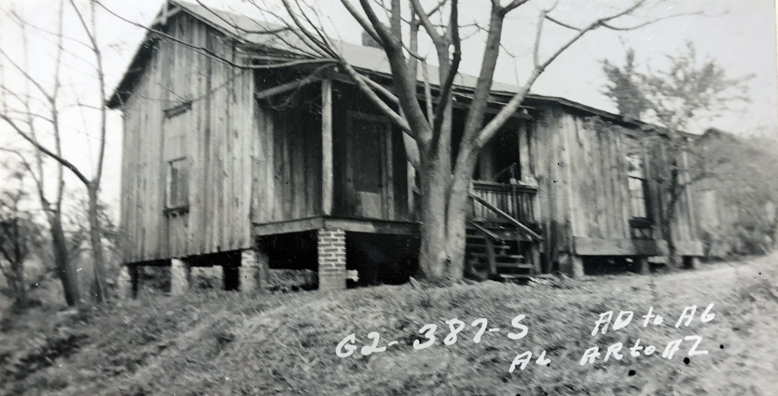
Photo courtesy Birmingham Public Library
Life at the mines was strictly segregated – after all, this was Alabama – which was a little ironic since the coal dust painted everyone black. The photo below is some kind of mine office, with separate entrances marked “White” and “Colored.”
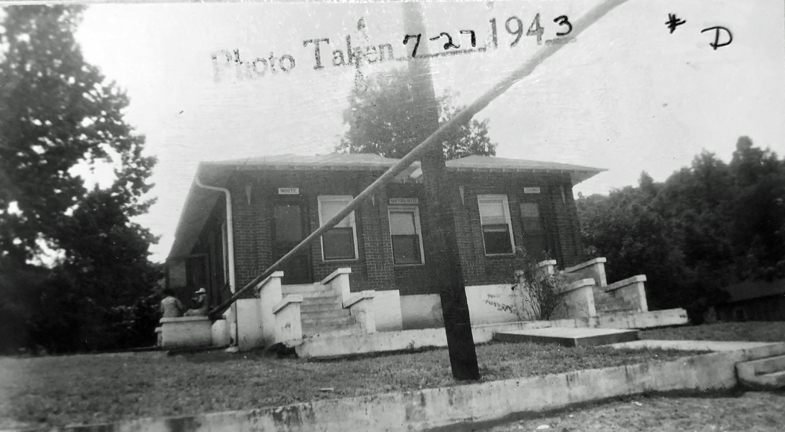
Photo courtesy Birmingham Public Library
There were separate white and black schools, and there are two schools indicated on the map above. The white school was razed on December 8, 1964 – the time that most of the buildings were demolished.
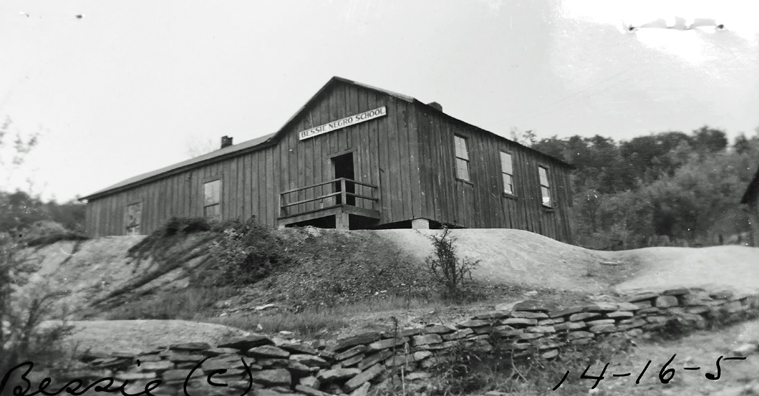
This building has a sign that says “Bessie Negro School.” Photo courtesy Birmingham Public Library.
The map shows a “Mount Arat Church.” Could that be Ararat? The photo of this church was not identified with a name, denomination, or race.
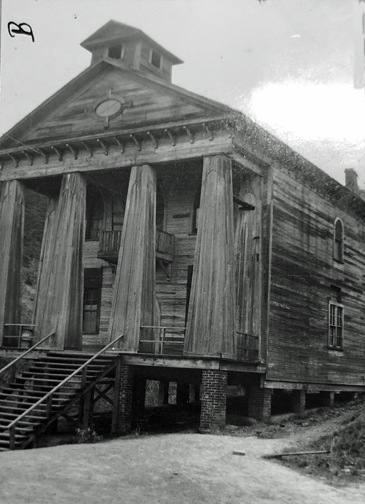
Photo courtesy Birmingham Public Library
Bessie Town is now located within the city of Adamsville, northwest of Birmingham. The only thing left of Bessie is the cemetery. Photos of most of the gravestones in the Bessie/Maben Cemetery can be found on the findagrave.com website.

Photo by Patricia Wilbert, findagrave.com
1932
(BIRMINGHAM)
Arthur Leon Strength was born on February 16, 1932, to William and Jessie. Findagrave.com says that he was born in Birmingham, which may be a clue to where the family lived that year. He was apparently known as Pete, and served time in Huntsville Prison in Texas in 1950 (see 1955 below). He died on February 12, 2010, in Lithia Springs, Georgia.
1935
IRONDALE
The 1940 Census asked where the family lived in 1935, and Strengths answered Irondale, a mining town just west of Birmingham.
Irondale is the home town of Fannie Flagg (family name Neal), who wrote the book Fried Green Tomatoes. The story is set at the Whistle Stop Café, which is now called the Irondale Café. It is a cafeteria type place where strictly Southern food is served. Irondale’s historic district is on 1st Avenue, which lies on either side of the railroad tracks. The Café faces the tracks. The film was not made in Irondale, but in Georgia; Irondale is still a thriving community, while in the movie it just fades away… (Thanks, Don Veasey!)
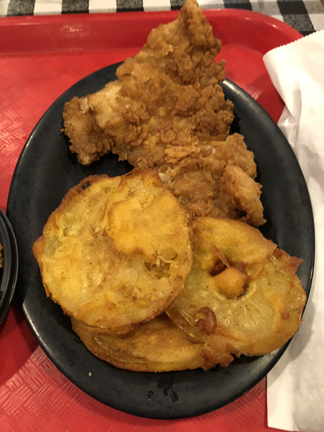
Fried Green Tomatoes – and a Pork Chop
1936
Charles E. Strength was born on February 4, 1936, location unknown, to William and Jessie. Charlie passed away on April 30, 1955, in Pasadena, Texas. He is buried at Woodlawn Cemetery in Houston.
1937
W.T. Strength, age 40, (TBS’s dad) and Fred Strength (TBS’s 16-year-old brother) were convicted of “Distilling” in Jefferson County, Alabama (Bess Division). The notes read, “The Grand Jury charged that subsequent to 11-30-19 (sic) [the defendants] did and unlawfully mfg, sell give away or have in his possession of a still.” They were sentenced to 1 year and 1 day to 1 year and 7 months. WT’s sentence began on April 18, 1937, and Fred’s began the next day. A distilling fee of $50 each was paid on May 1, 1937. They were paroled on November 2, 1937.
Note that in April 1937, when WT and Fred got in trouble with the law, the court was called the Bess Division. So it may be that they were still in Bessie in 1937, and didn’t move on to Irondale until a bit later?
1940
OVERTON
By 1940 the family had moved seven miles west to Overton, an unincorporated area of Jefferson County with about 200 households. Maybe. Overton was essentially the same as Irondale. (William’s half-sister Rosa’s obituary in November 1940 said that he lived in Irondale.) It was a coal mining town, but William, now 44 years old, worked at building construction. He reported that he had a fifth-grade education. The address given was Irondale Rt. 1, 27th Street Road, which doesn’t really compute on a map. The streets in Irondale only go to about 25th Street, and that area is heavily industrial today.
1942
BIRMINGHAM
In 1942, William, Sr., Jessie, and TBS’s brother Albert were living at 4032 6th Ave. No. in Birmingham, Alabama. Albert was probably listed separately in the directory because he was 22 years old; no doubt the younger boys were there as well. TBS would have been 13 or 14.
NEW ORLEANS
The 1945 New Orleans directory lists Bill, Jr. and his parents living at 857 Magazine Street. Bill’s father was listed as “Delta ship building.”
In 1946 TBS filled out his military registration card (see below), and listed his mother at the same address. This address is also found in a New Orleans directory.
In an interview, TBS’s wife Dorothy remembered that WT, Sr. and some of his sons worked as painters, and that WT, Sr. would make “white lightning.” She thought that TBS might have been in Houston four or five years before Jessie and WT moved there.
HOUSTON
Bill’s parents were living in Houston, the May 13, 1950, Census tells us. The address was 1104 Chartres Street., in downtown Houston. In addition to William and Jessie, who were not working, the household included:
- Bill’s brother Fred, 29, listed as a painter in a building firm. At that time he had never married;
- Bill’s brother Arthur, 28, listed as a telegrapher in a telegraph office. He was listed as a widower.
Chartres Street still exists, along a southeastern stretch next to Interstate 69 (Eastex Freeway), which began construction in about 1954. Texas Bill’s parents lived on the other side of Chartres Street, however, and were probably displaced after their 1950 residency. Their home is either under the highway or the site of the George R. Brown Convention Center.
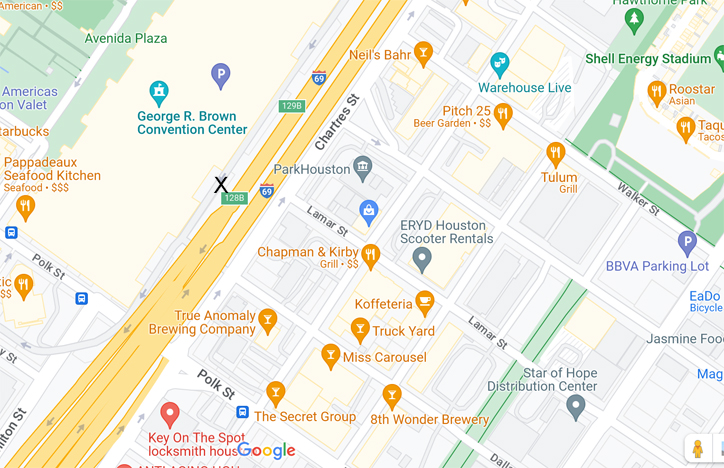
X marks the spot where TBS’s parents lived in Downtown Houston in 1950
William., Sr. and Jessie are difficult to find after this, but in 1958 we find a listing for them at 1277 Sheffield in Houston. William was listed as a carpenter.
CONROE
Jessie died at her home in Conroe, Texas, on September 1, 1965, of carcinoma of the bladder. She was 62. At the time she had been working as a waitress at a drug store soda fountain. Her address was described as “Hollow Road, ½ mile East of Tamina Road, Rt. 1, Box 259 A, Conroe.” She was interred at Woodlawn Garden of Memories, Houston.
W.T. Strength, Sr. died at the VA Hospital in Houston on February 7, 1966, at the age of 69. He also died of cancer of the bladder. His occupation was listed as Painter. His address was listed as Box 77301, Conroe, Texas. He was interred on February 9, 1966, at Woodlawn Garden of Memories, Houston.
Texas Bill Strength: Early Career
TEXAS BILL AND THE GUITAR
So how did a man born and raised in Alabama become “Texas Bill?” Jimmie Rodgers notwithstanding, there really were no cowboys in Alabama, so he moved to Houston. This in itself is a mystery. In 1942, at the age of 14, his parents and his brother Albert were living in Birmingham. Where did TBS go to school? He reportedly attended ROTC – where was that? In a 1945 directory he was listed as living with his parents in New Orleans. But sometime after August 28, 1944, at age 16, he was in Houston. We may never be able to explain his movements during these years.
And for that matter, how did he learn to play the guitar? Son Dale asked him that question once. The answer was not the romantic scenario of taking lessons from some black bluesman in New Orleans – he just learned by ear. “Hell son, there’s only 12 notes, how hard can it be?” Dale took that advice to heart and became a professional guitar player himself, self taught.
1944
THE JOY THEATER, HOUSTON
Family lore is that TBS won an amateur talent contest at the Joy Theatre in Houston at the age of 16. A search through the Houston papers doesn’t give up any evidence or details about the contest.
National Hillbilly News columnist Norma Winton wrote in 1949 that, in remembering that episode, Bill said, “My Mother thought for sure I was dying, and I can’t say what the old man said.”

Texas Bill at age 16. Photo courtesy Dale Strength The theater had been called the Crown Theatre, stood dormant for most of the 1930s, and reopened in 1937 as the Joy, known for a time as the Joy-Tex. (Cinema Houston: From Nickelodeon to Megaplex, by David Welling). All of the references found in the Houston Chronicle (albeit classified ads for help) cited the Joy Theatre.
The people at CinemaTreasures.com describe this now-demolished theater:
Not one of the Houston’s finer show places, this bottom rung, second-run showplace was located at 303 South Main. A haven for Republic westerns, B-movies, and Columbia serials, the Joy Theatre was notorious for running exploitation films and holding late night burlesque shows on weekends.
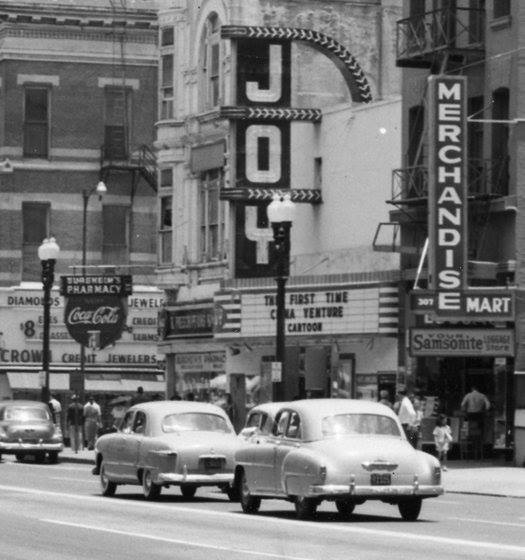
The Joy Theatre, 1953. Credit CinemaTreasures.com 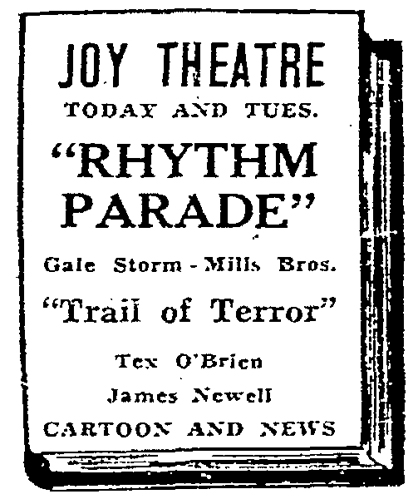
Houston Chronicle, March 27, 1944
KTHT
As a result of this talent show win, the article below tells us that TBS got a job at Houston radio station KTHT at the age of 16. A look at the Houston Chronicle says that KTHT was started up by a County Judge who was forced to give up his position before the FCC would give him a license. The station went on the air with skeleton programming on July 28, 1944, and became an affiliate of the Mutual Broadcasting System on September 1, 1944. Although most of the programming came from Mutual, there were other shows that TBS could have participated in, such as “The Texas Cowboys” and “The Bar X Cowboys.”
1945
NEW ORLEANS
The 1945 New Orleans directory lists Bill, Jr. and his parents living at 857 Magazine Street. Bill’s father was listed as “Delta ship building.”
ST. JOSEPH, MISSOURI
October 1945
The first article about Texas Bill that comes up in a search in Newspapers.com is dated October 12, 1945, and is in the St. Joseph, MO, Journal. This article is important enough to quote in full:
New Entertainer Appears Daily on Station KFEQ
Texas Bill is one title in radio that is more than a stage name, because KFEQ’s Texas Bill Strength is really from down the Texas Trail. He was born in Bessemer, Ala., and after the right doses of schooling and R.O.T.C., took off for the Lone Star State, with his guitar under his arm. He first played and strummed his gitfiddle on the stage of the Joytex Theatre, in Houston, where he won first prize in a stage contest. This got him a job with radio station KTHT, in Houston. And so the radio bug got him.
Texas Bill is now on his way to bigger and better things, even Hollywood, if he can get the breaks. But, Bill isn’t the type to sit back and wait for the breaks to come to him. He’ll make them for himself by trying to do his best along as many lines as possible every single day. He even composes lots of the songs he sings on KFEQ, and hopes to get some of those songs of his recorded one day soon.
Next to music, Texas Bill probably likes girls and food best. He likes to dance, and always wants to learn some new step. He’s five-feet eight, has brown eyes, dark, curly hair, and add to all this his real Southern drawl, and you see what we mean. Texas Bill Strength is heard over KFEQ Monday through Saturday at :15 (sic) a.m. and 11:45 a.m., at 1:30, 2:00, 3:30, and 4:15 p.m., and Sunday morning at 9:45.
His reason for leaving Houston was addressed in a later interview, when he said, “I was just a kid and had the roving fever.” (Ronnie Pugh) A published letter revealed that at KFEQ he did 34 broadcasts weekly, although in those days a show could be as little as 15 minutes.
December 1945
On December 12, 1945, TBS was part of Deb Dyer’s radio show, which took place at the City Hall Auditorium in Chillicothe, Ohio. An article in the Chillicothe Constitution Tribune had a big come-on, saying that “Not only is this a big revue, but prizes will be given to the oldest woman in attendance, the youngest baby, the largest family present and other.” The facts about TBS were a little fast and loose:
Some of the features are: Texas Bill Strength of Houston, Texas. He formerly worked on the Southern Network from KTRH of Houston but is at KFEQ in St. Joseph, Missouri now. Texas Bill is a real Texas cowboy. His home is Houston, Texas, where he lived his entire life before coming to St. Joseph. He is one of the most popular singers on the radio today. He has a southern drawl, a deep baritone voice and, when he stars strummin’ his guitar, you are in for a real treat.
Other acts on the bill were:
- Lexie Lou, Queen of the Yodeling Cowgirls
- The Miller Sisters
- Vincent Westoff
- Swede Johnson
- The Milk Maid Trio
- Uncle Abe, the Fiddler
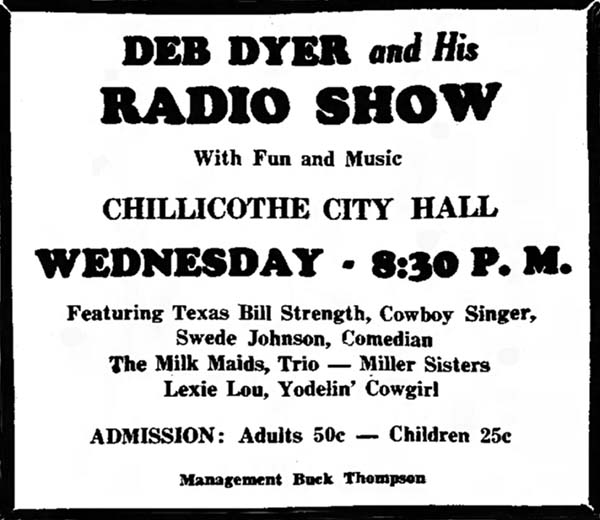
Chillicothe, Ohio, Constitution Tribune The next day’s news reported that snow kept the crowd small, but manager Buck Thompson said that the troupe would return again.
1946
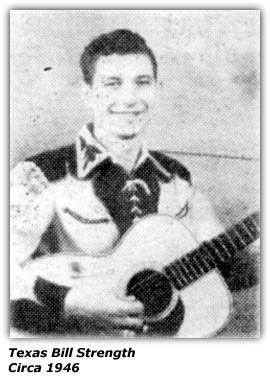
Photo courtesy Dale Strength
May 1946
The May 1946 issue of National Hillbilly News included a brief write-up about TBS by long-time Ernest Tubb Fan Club President, Norma Winton. At that time, TBS had just finished working at KFEQ in St. Joseph, Missouri. The note said that “His popularity was such over KFEQ that he was being sponsored over 17 other radio stations at that time.”
While working at station KFEQ that May, he traveled to KXEL in Waterloo, Iowa, to look for a job. Unfortunately the owner of KXEL was a brother of the owner of KFEQ, so KFEQ fired him.
MEETING ERNEST TUBB
Soon after he lost his KFEQ job in St. Joseph, he got the chance to meet his idol, Ernest Tubb, at a concert in Fort Dodge, Iowa. He hitchhiked 300 miles to the show and was elated and scared when Tubb put him on as an opening act before the 12,000-person crowd. “Ernest dressed me up in one of his suits – boots and hat and everything. It just fit me … that was my first big show date.” (Ronnie Pugh)
Although not a permanent position, TBS sang for a while at KSOO in Sioux Falls, South Dakota. (Ronnie Pugh)
In the April/May 1946 issue of Melody Trails, Ernest Tubb Fan Club President Norma Winton reported that TBS had written 27 songs but hadn’t yet cut any records. She also reported that:
Texas Bill Strength is no longer at KSOO, Sioux Falls, but is now out in some might swell country – Denver, Colorado … At this writing, Bill isn’t on the air regularly, but is waiting for his Union transfer, and resting up a bit. (Ronnie Pugh)
July 1946
In her “Just Driftin’” column in the July 1946 issue of National Hillbilly News, Norma Winton noted that he was working in Colorado (KMYR in Denver) and making personal appearances throughout the area. In her “Radio Programs and Cowboys” column in the same issue, she mentioned that Texas Bill had presented her with a special recording of her favorite tune at the time, “Yesterday’s Tears,” along with several of his own compositions, including “Please Don’t Ever Forget Me” and “Louisiana Lou.” But he may have been longing for his Southern roots, as Norma noted that he was talking about the cold weather and how hard it was for a Southern boy to cope with it. While he may have complained about it, he was doing well at the time and Norma was envious that he was able to work there since she was a native of the state.
August 1946
On August 28, 1946, TBS turned 18 and filled out his Military Registration Card. He listed his address as Station D, Box 184, St. Joseph, MO, but noted his occupation as “Exemployed” – no doubt because of his misadventure with KFEQ. He described himself as 5’9″ tall, hazel eyes, brown hair, with a light brown complexion. His mother Jessie was given as his next of kin; her address was given as Magazine Street in New Orleans. Bill’s parents were listed in the New Orleans directory in 1946, as they were in 1945.
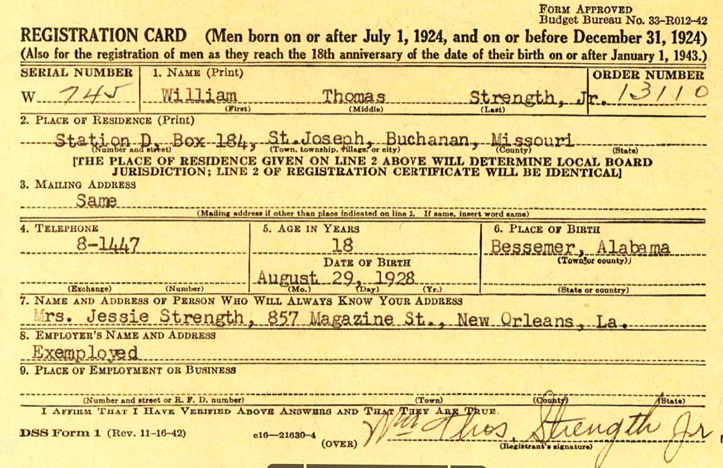
August 28, 1946. Image from Ancestry.com
MELODY TRAIL RIDERS
September 1946
In September and October 1946, TBS was the star of the new band, the “Melody Trail Riders.” That we all agree on. Three sources give slightly different versions of this story.
In the September 1946 issue of Melody Trails, Miss Norma Winton reported that TBS was working as the star of her new band, the “Melody Trails Riders,” in Fort Smith, Oklahoma. “You’ll be seeing and hearing a lot of Bill in the future.”
On October 3, 1946, the Sallisaw, Oklahoma, Democrat American reported that the band was managed by Miss Winton and led by TBS. It had recently entertained in the Roland High School Auditorium on Friday night, September 27, 1946. Members of the show included Jack and Audrey Manning, and Rusty Russell. Jack and Audrey were leaving for a radio job in Kansas City. “The rest of the gang and others will be around in your high school soon. Watch for them!”
October 1946
On October 12, 1946, Billboard again called TBS the leader of the “Melody Trail Riders,” as well as the emcee and the manager. The live program was described as a “new show that is proving popular with Fort Smith and Eastern Oklahoma folk song lovers.”
At present show consists of five pieces, and plans have been made to increase the number soon. In addition to Jack and Audrey and Rusty Russell, the list of performers cited by Billboard included Jackie Jackson and the Larson Sisters.
MEMPHIS
By the end of 1946, Bill’s career had taken him to Memphis, based on a letter to the editors of National Hillbilly News that listed his PO Box as being in Memphis.
November 1946
TBS, playing the Rainbow Gardens, Memphis, is heard over WHHM. (Billboard, November 16, 1946)
National Hillbilly News columnist Norma Winton reported that in the early days, Texas Bill was also writing tunes such as “There’s Always Two to Blame,” “I’m Lonely Since You’ve Gone,” and “You’ve Left Me Behind.”
In the latter part of 1946, Floy Case reported in her column that TBS had a six-piece western band and was making personal appearance in Missouri and Kansas. She noted that Bill was “…doing all right for himself in this hillbilly biz.” She also mentioned that he had written two new tunes, “The Rose of My Heart” and “Who’s Gonna Love Me Now.”
December 1946
In an article in the December 1946 issue of the Mountain Broadcast and Prairie Recorder, Floy Case told readers that Bill was the “singing emcee of Norma Winton’s band the “Melody Trail Riders.” Case described TBS as “…a young fellow who seems to be going places in a hurry.” Bill and the group were playing dates in the eastern Oklahoma and western Arkansas areas.
At some point before he met his first wife, TBS had a daughter by another woman.
1947
January 1947
Arlie Kinkade’s column, “This, That ‘n the Other” reported that he was working at WHHM in Memphis. (National Hillbilly News, January 1947)
Also in January 1947, Floy Case wrote that Bill was one fellow that “…gets around,” going from Texas to South Dakota and Colorado. She mentioned that he had been working as part of Norma Winton’s band, the Melody Trail Riders, out of Ft. Smith, Arkansas, but had since formed his own band, the “Ranch Ramblers,” and was working regularly at the Rainbow Gardens in Memphis. She, like many of the columnists back then who also dabbled in songwriting, then mentioned that Bill had been plugging a song she had written with Jimmie Davis, “I’m Beginning to Forget You,” that had also been recorded by Ernest Tubb.
A 1952 article mentioned that in 1947, Bill toured with several large road shows then and did stints at KMYR in Denver, KSOO in Sioux Falls, KMA in Shenandoah, Iowa and KRLD in Dallas.
BACK TO HOUSTON
July 1947
Although he is not named on the radio listings until 1948, it could very well be that he was anchoring the “Ranch Hand” program on KATL, as early as May 11, 1947. He is identified as “Ranch Hand” in the 1948 ads below.
December 1947
A 1951 article in Cowboy Songs magazine said that Bill had gone back to Houston in 1947. Evidence of this is in an article in the Houston Chronicle dated December 11, 1947, where he is named as a participant in a floor show at the Plantation. The show was a benefit to buy a jeep for “crippled children.” He is identified as “Bill Strength, radio singer.”
1948
A 1948 Houston directory listed Bill’s address as 504 Aurora. This was the home of his wife Dorothy’s parents. His occupation was given as KATL.
1948 was a busy one in Houston, where he worked at three different radio stations
January 1948
Foremost Dairies offered TBS a 15-month contract to do a morning show called “Ranch Roundup” on a new 5,000 watt station, KLEE. KLEE, located in the Milby Building, went on the air on January 31, 1948, and TBS could have been included in what the Houston Chronicle called “Hillbilly Program.” He was listed under his own name from April 16 to July 31, 1948.
May 1948
In May he had an evening disc jockey program over radio station KATL.This show was 15 minutes long. (Ronnie Pugh reported that this show was called “Texas Music for Texans,” but local radio listings show it under his name. A show by that name only appears in a search for a few months in 1949.) This unusual arrangement seems to have lasted only during his tenure at KATL, which appears to be May 11 to July 31, 1948.
Ronnie Pugh also says that he sang on a third Houston station, KNUZ. This could not be confirmed by radio listings, but the show may not have been under his name.
Ronnie Pugh describes the radio shows:
- Each show was heavy on cowboy songs, as those titles and one ad makes clear: “Gather round all you good neighbors who like your western songs with that true Texas flavor! Just relax and let Texas Bill throw those ropin’ rhythms your way. They’re guaranteed to please ya plenty podner.
- He performed at night clubs.
- He guested on a new barn dance show, “The Houston Hoedown Club.”
- He immersed himself with personal appearances in the Houston area.
These personal appearances in 1948 identified him as the “F and M Ranch Hand.”
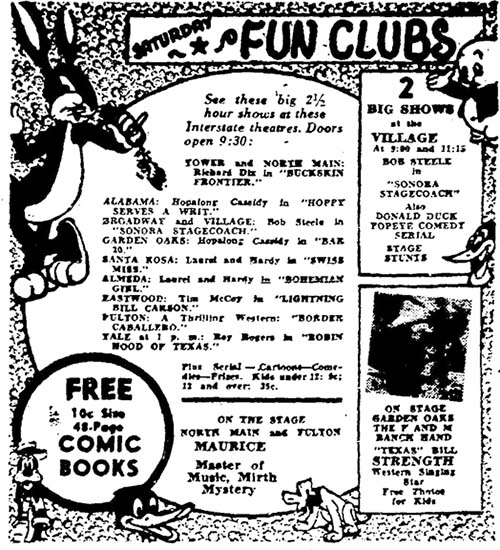
Houston Chronicle 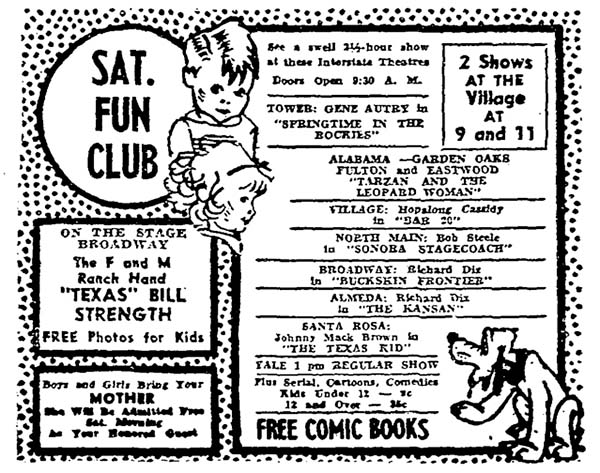
Houston Chronicle, May 7, 1948
WIBB
This is a shot in the dark, but an article on the history of station WIBB in Macon, Georgia, states that it went on the air on November 18, 1948. Although it was just a daytimer with two stations as competition, the article states:
But slowly, through the appeal of such personalities as Johnny “The Bullfrog” Hamrick, “Texas” Bill Strength, and Jimmie Layfield, who played his Hammond electric organ over the airwaves Sundays through Thursdays, the station carved out a respectable following by catering to a wide audience. (The Macon Telegraph, May 31, 1998).
Other than WIBB being one of the stations that carried his CIO program (see January 1950), there is nothing in his previous biographies that indicate that Bill ever worked in Macon, but apparently he did in 1948/1949, at least for a little while. Bill wasn’t known for staying in one place for very long in these early days.
1949
CIRECO RECORDS
Bill’s first recordings were apparently made in Houston on Cireco Records. Seven sides were cut at the session. It appears that Bill played on all of the sessions; the lead singers were both Texas Bill and Jerry Irby.
Two 10 inch records were released:
Cireco 101, with both sides credited to Jerry Irby and his Texas Ranchers:
- “You Can’t Take it With You”
- “Almost Every Time”
Cireco 102:
Side A: “49 Women” by Jerry Irby and his Texas Ranchers
Side B: “Little I and Big You,” by TBS and his Saddle Ranchers
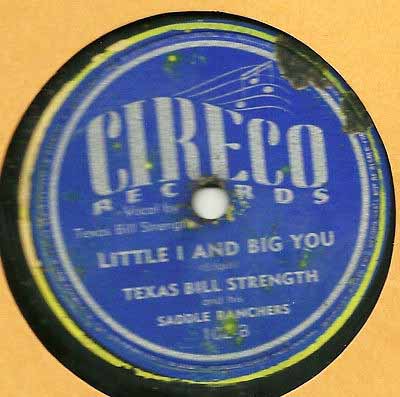
The other songs TBS and Irby recorded at Cireco in 1949, but were not released were:
- “Cowboy’s Sweetheart”
- “El Rancho Grande”
- “Buttons and Bows”
Frank’s notation indicates that the lineup for this session was:
- Jerry Irby and His Texas Ranchers [Gerald F. “Jerry” Irby] vocal, first rhythm guitar
- *Texas Bill Strength aka David Grey and His Texas Ranchers [William Thomas “Texas Bill” Strength] vocal, second guitar
- Unknown lead guitar
- Possibly Ernest “Deacon Evans, steel
- Peter ?, bass
- ? drums
- Anthony “Tony” Sepolio, fiddle
- Pete Burke, piano
- [vcl-2/gt], ? [ld gt], poss. Ernest “Deacon” Evans [steel], Peter ? [bass], ? [drums-7], Anthony “Tony” Sepolio [fiddle],“Pete” Burke [pno-6])
- How David Grey fits into this picture is anyone’s guess, unless that’s Jerry Irby’s real name.
February 1949
DOROTHY ALTMAN
On February 23, 1949, Texas Bill married Dorothy “Dottie” Altman in Houston. Dorothy was the seventh child of Joseph V. and Pearl Nona Altman.
Joseph Altman was born in Czechoslovakia on March 28, 1891 and came to the U.S. in 1910. By at least 1930 he lived in Houston, where he died in 1980.
Joseph’s wife Pearl was the daughter of John Nona, who was born in either Poland (or Germany,) depending on the year of the Census. Her mother Martha was also of Polish/German descent and was born in Texas or California, Pearl variously reported. Pearl was born in Chapel Hill, Texas on August 7, 1889. The 1900 Census indicates that her birth name may have been Peladio. In 1920 she lived in Austin on a farm with her brother Adam. Pearl died on March 26, 1952, at the age of 62. Her residence was the family home at 504 Aurora Street in Houston.
Joseph and Pearl’s children were:
- Albina “Bina” Krusleski (born in 1913)
- Wallace (1922)
- Josephine E (1925-2022) Married Edward Ludwig, then Michalak
- Paul A. (1923)
- Helen Mary (July 28, 1927) Roberts Waddell
- Lillie Frances (July 1929) Married Alan Hannuksela, then Enoch Allen Miles
- Dorothy L (born on January 6, 1931)
In a taped interview with her son Dale, Dorothy provided a great deal of information about how she and TBS met. At the time, Bill’s parents were living in New Orleans and Bill was living in Houston.
Dorothy met Bill after the Joy Theater talent contest, while he was playing at a nightclub in Houston. The club was owned by a friend of the Altman family. She may have been 16-17 yrs old. Four of the five Altman sisters (without Bina) would go to the theater to see the regular Sunday afternoon jam sessions, which he hosted, and they met there. At one point she went up to the table where TBS was sitting with a couple of other players with him that worked for the club. She “said hi and what not,” and sat down and started to get to know each other. She said that because a family friend owned the place “Big Momma” (Pearl Altman) trusted her little underaged kids there. The girls continued to come into the club on Sunday afternoon for a few weeks. He was playing for the “kitty.” After she got to know him better she would pass the hat around for him.
She continued that it was just natural that he would go to their house and meet their Mother. It was Bill’s idea – he didn’t have any family in town and they brought him home to have dinner with the family. Big Momma fell in love with him immediately. She used to “box his ears good” when he misbehaved. Dorothy said Pearl gave him the discipline he didn’t get at home. At various times, two other Strength boys, Charlie and Pete, would also stay with the Altmans, which didn’t set well with their mother Jessie, who thought Pearl was trying to take her boys away from her.
Bill and Dorothy were married by the clerk of the Harris County court. The ceremony was solemnized on March 13, 1949, by Rev. L.R. Pearson, Pastor of the North Main Baptist Church.
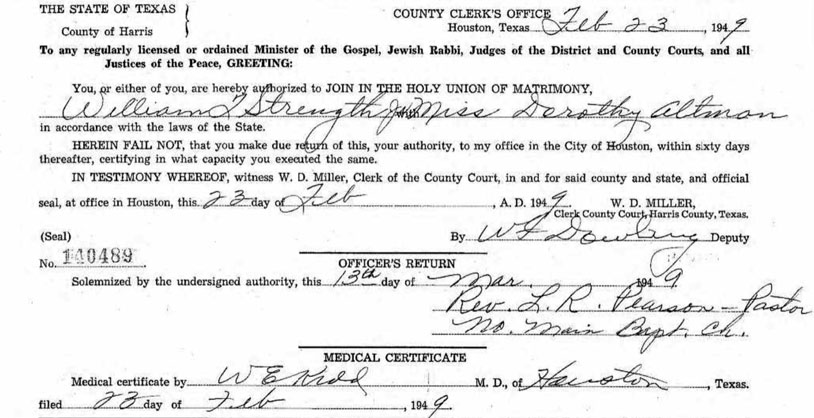
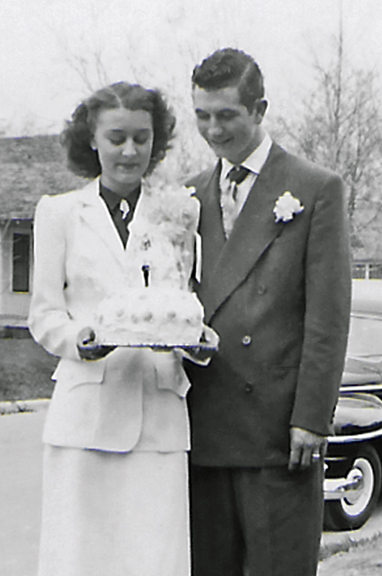
Dorothy and Bill at their wedding reception, Aurora Street, Houston. Photo courtesy Dale Strength
May 1949
4-STAR RECORDS
By May 1949, TBS had signed with 4-Star Records.
In May 1949 he recorded two sides:
- “If I Could Buy Your Love”
- “Please Don’t Ever Forget Me”
The record was released in December 1949, as TBS and His Saddlepals. It was issued as either 4-Star 1334 and/or 3176.
Billboard reviewed it on December 17, 1949:
- “If I Could Buy Your Love,” Western string ork [orchestra] setting and a straightforward but not especially strong vocal on a likely pop-Western piece.
- “Please Don’t Ever Forget Me,” Tune is machine-stamped out of a familiar die, with nothing special of its own. Rendition is plodding.
July 1949
Biff Collie, the “Bellerin’ Bowlegged Boy, who whirls wax at KNUZ, Houston, reports that rustic music is going great guns in his town. Collie, who does five hours of DJ’ing for folk music daily, is working closely with the Hoedown Club, local bistro which features such local and territory names as:
- Floyd Tillman (Columbia)
- Leon Payne (Capitol and Bullet)
- Ben Christian (4Star)
- Benny Louders
- Texas Bill Strength (4 Star)
On Thursday nights, the “Houston Hoedown Dance” brings together all the local bands, with over 1,000 dancers attending.
(Billboard, July 30, 1949)
September 1949
BIRMINGHAM
TBS and Dorothy moved to Birmingham, Alabama, in September 1949.
October 1949
In Birmingham, Texas Bill did daily radio programs at WRBC, which was part of a network of 37 stations throughout Alabama and Georgia. Listings are found in the Birmingham News starting on October 6 for an October 7 start date. He did a split shift from 12:30 to 1 pm and then 2:30 to 3 pm. Curiously, WBRC was an FM station, at 102.5 mc. Listings continued until October 29, 1949, announcing his regular hours on October 31, 1949.
GREENVILLE, ALABAMA
In late October, 1949, Bill received a job offer from WGYV, on the Alabama Broadcasting System in Greenville. The station had started up in August 1948.Greenville is located in south Alabama, just 122 miles from the ocean. The small town had 6,731 residents in 1950, and not many more today. He drove all night to be there by the morning of October 31. The station had rented an apartment for the couple, which included a pregnant Dorothy. Early that morning, when he left for the station, Dorothy asked to be dropped off at the hospital. Their son, Ernest Dale Strength, was born prematurely at the Speir Hospital. Dale was named after his father’s hero/mentor/friend, Ernest Dale Tubb. The family lived on Conecuh Street, which runs through the town.
Texas Bill worked for WGYV for two months.
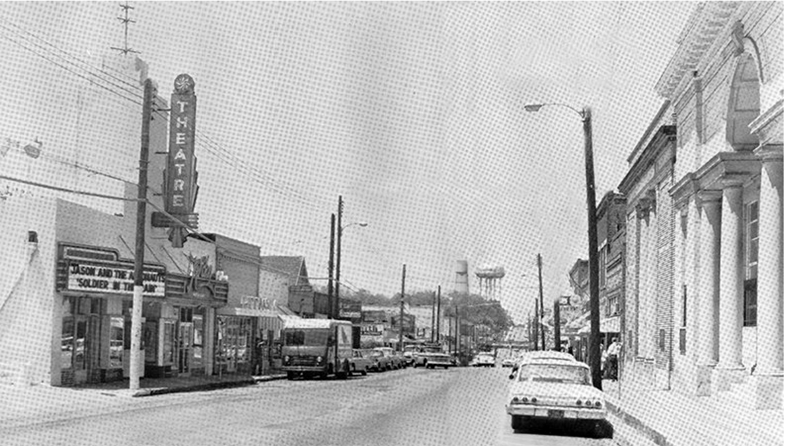
Downtown Greenville, from the City’s website
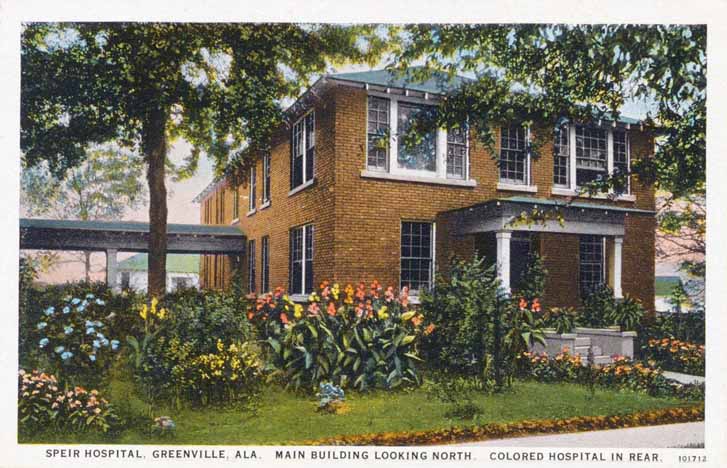
Postcard of Speir Hospital courtesy of the Butler County Historical & Genealogical Society
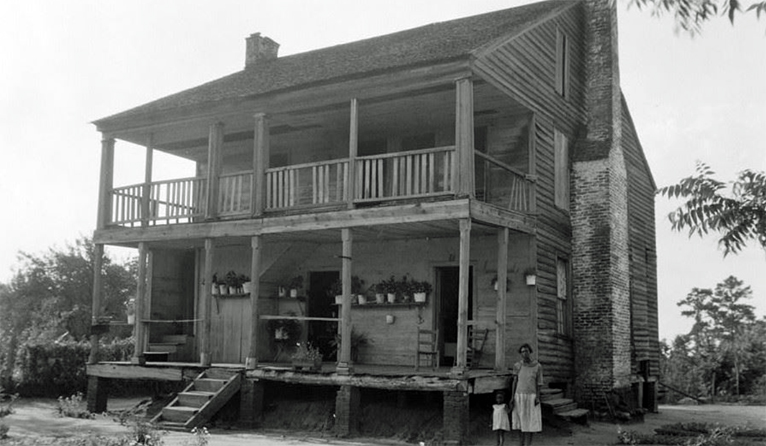
Another part of Greenville’s history, from the City’s website.
November 1949
The caption for the photo below reads:
“TEXAS” BILL STRENGTH,” now with WGYV, Greenville, is heard every morning at 5:30 and is master of ceremonies at the Saturday Night Jamboree. Bill also has several shows during the week. He is the author of several popular songs, including “Louisiana Lou,” “Please Don’t Ever Forget Me,” “Rose of My Heart,” “Im Still Lonely for You.” He started in radio in 1945 at KTHT, Houston, Texas, by winning an amateur contest, and has since been with 19 radio stations and has played with such famous names as Tex Ritter and Bob Nolan, Sons of the Pioneers. Bill has also recorded for Cireco Records. He is already a favorite with local radio fans.
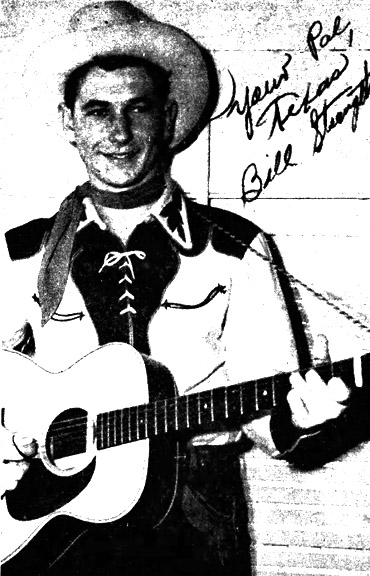
Greenville Advocate, Greenville, Alabama. November 10, 1949
4-STAR RECORDS
In November 1949, TBS and His Saddlepals recorded two sides for 4-Star Records (1403) in Houston:
- “Actions Speak Louder Than Words”
- “Mr. Moon Sailing High”
There is no information of a release date and they do not seem to have been reviewed in Billboard.
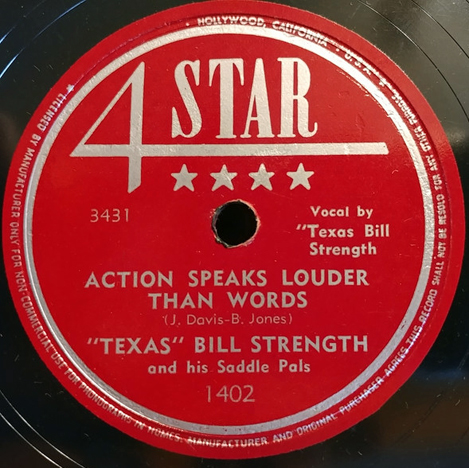
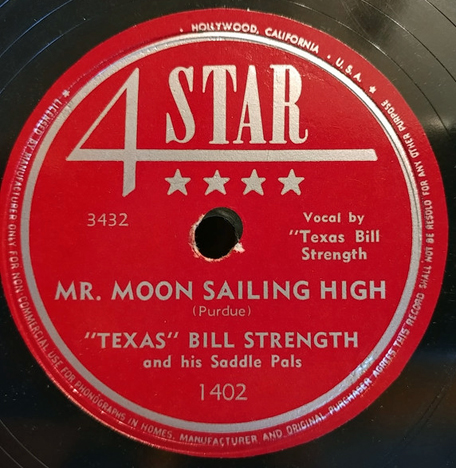
December 1949
TBS (4 Star) is doing a DJ shot over at WGYV, Greenville, Alabama. His show includes:
- The Greenville Bucheroos (sic)
- Andy Williams (apparently a Country Andy Williams)
- The Midnight Ramblers
- The Camellia City Ramblers
- Cousin Wilbur
- Charley and Honey Lou
(Billboard: December 17, 1949)
It was later clarified that Andy Williams was a separate act on WGYV and not part of Bill Strength’s show. (Billboard, January 21, 1950)
TBS is personally managed by Rudy Clark, Birmingham. (Billboard, December 24, 1949)
BACK TO HOUSTON
In his “Southwestern Round-Up” column for National Hillbilly News, Tex Moon wrote that in late 1949, Bill once again moved back to Houston.
He was supposedly one of the mainstays at a new venue in Houston where it was said, “The Best Bands of All Come to Hillbilly Hall.” Other performers at the venue included Floyd Tillman, Hank Lockwood, Leon Payne, Benny Leaders, Pete Hunter, the Texas Cowboys, and Woody Carter.
1950
January 1950
THE CIO
TBS took a job with the CIO on January 17, 1950. The first 15-minute program hit southern stations on Sunday, January 22, 1950. At first the program had no title, but later gained the name “American Folk Songs Featuring Texas Bill Strength.” (Ronnie Pugh)
The Congress of Industrial Organizations (CIO) was a federation of unions that organized workers in industrial unions in the United States and Canada from 1935 to 1955. TBS’s affiliation with the CIO was mentioned in a long column by Victor Riesel, which was syndicated in several newspapers simultaneously. It read:
To push its southern organizing campaign, the CIO will put “Texas” Bill Strength, popular disc-jockey and folksinger, on the air to send his ballads across a six-state network, covering Georgia, Alabama, South Carolina, North Carolina, Tennessee, Virginia, and parts of Texas. Between the ballads will be George Baldanzi, CIO southern chief, with speeches.

Emanating from WGST, Atlanta, TBS made radio transcriptions with Baldanzi, which were aired over 126 stations. At that time, the CIO had over 6.5 million members, so Texas Bill and his record label, 4-Star Records, took advantage of that and created a slogan for Bill,” …the Boy with 6 and a half million sponsors.”
The 1951 Cowboy Songs article notes that Bill was such a hit with his CIO job that he logged over 57,000 miles: traveling on tours, personal appearances, visiting those in hospitals and institutions, and attending union meetings and conventions for the CIO. Impressively, it was said that he entertained upwards of a quarter million people at each of those conventions. Like many artists, Bill shared the stage with many of the mainstays of country music in that era. But Bill also got to entertain some well-known political figures of the era due to his work with the CIO, including Vice President Alben Barkley, Senator Hubert H. Humphrey, Congressman Christopher of Missouri, and Secretary of Labor Maurice Tobin. See April 1950 for photos of Texas Bill with Senator Humphrey.
Some of the more well-known venues he appeared at were the Palmer House in Chicago; the “world’s largest auditorium” in Atlantic City, New Jersey; the Hotel Utah in Salt Lake City; the National Training School for Boys in Washington, DC; and the Hudson Manor in Tampa.

Image courtesy Dale Strength He also appeared on KWKH’s Louisiana Hayride in Shreveport.
None of the articles or ads found implied that TBS did anything but sing and/or entertain at meetings and conventions. The last mention of any CIO actions found was on February 7, 1953.

CIO Publicity Photo. Courtesy Georgia State University Library
The ad below appeared in several Southern newspapers on January 20, 1950. An article in the Kingsport, Tenn., Times stated that the programs began on Sunday, January 22, 1950, and were heard from 1 pm to 2 pm. Presumably the programs were only heard on Sundays and not for the entire hour.
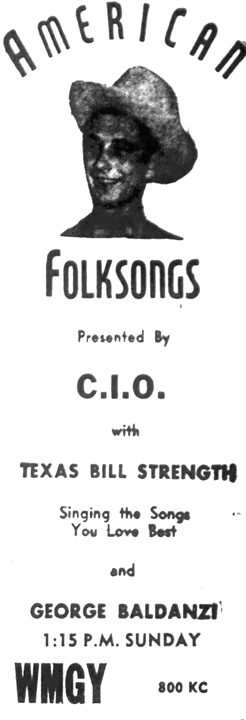
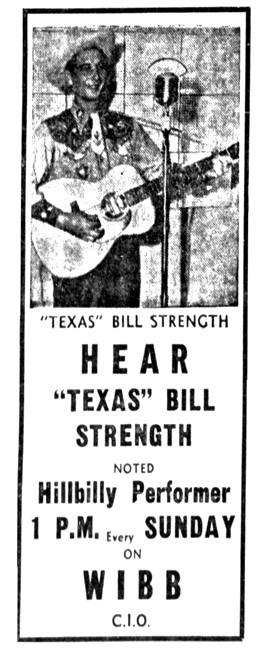
Macon, Georgia, Telegraph. Saturday, January 21, 1950
February 1950
TBS was to come to Macon, Georgia during the first two weeks of February, 1950, for public appearances for the CIO, reported the Macon News, January 20, 1950.
March 1950
March 11, 1950, Billboard:
The CIO is using hillbilly music as its major format in a new transcribed radio series thru the South. Since January 22 the CIO has been piping the 15-minute weekly show Sunday afternoons to a network of stations that started with 29 outlets and now is carried commercially by 90 outlets in seven Southern States from South Carolina to Virginia. Emanating from WGST, Atlanta, the program features TBS, 4-Star recording artist. In between songs by Strength, George Baldanzi, organizing committee director and executive v.p. of the Textile Workers’ Union, discusses problems involving the Southern worker. In addition to his e.t. shows, Strength is on the CIO payroll to make appearances at all major meetings and conventions held by the CIO in the seven Southern State territory.
April 1950
THE 1950 CENSUS
The 1950 Census, which was taken on April 3, 1950, reveals that Texas Bill’s family lived at Apartment 1, 1633 Euclid Ave., Atlanta. Today there is a Euclid Ave. NE (there is no SE), but the addresses end at 1414, when Euclid meets Oakdale, so the building may have been removed or the roads changed.
His “Occupation Category” was checked as “Unable to Work,” perhaps because there was no category for a “Professional singer Labor Organization,” which was written in under Occupation. Under Income, he reported that in 1949, he made no money as someone else’s employee, but made $2,340 as his own business. “Relative Income” – the income of someone else in the household in 1949 – was $252.
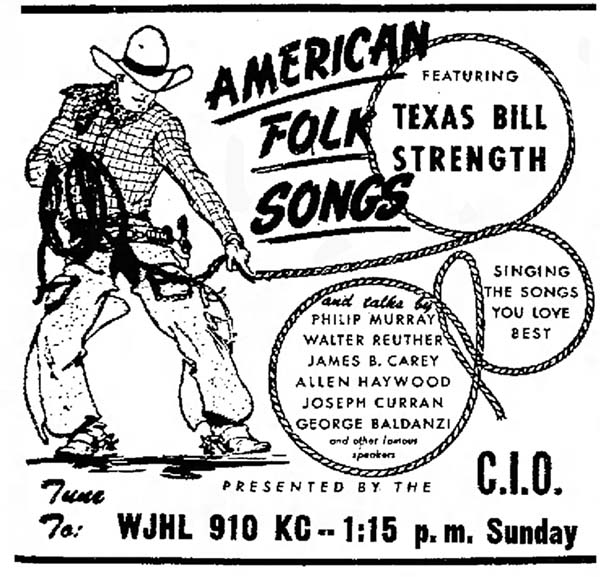
Ad placed in Kingsport, Tenn., in April 1950 and Gastonia, NC in June 1950
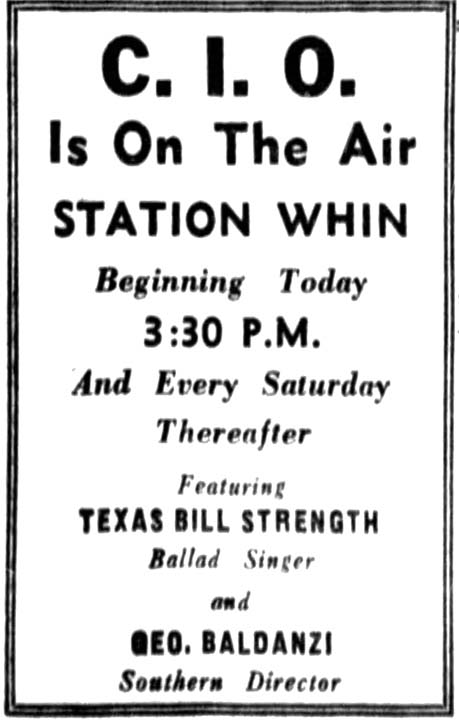
Nashville Tennessean, Saturday, April 8, 1950
The shows were geared toward the Southern states of Virginia, Tennessee, Georgia, North and South Carolina, and Alabama, but were seen on radio logs in Texas as well. By 1951 they were heard on 126 stations.
Initially the target audience for these broadcasts were textile workers that the CIO sought to unionize. We see by the ad below that he was making personal appearances in 1950, sponsored by the Textile Workers Union of America, CIO.
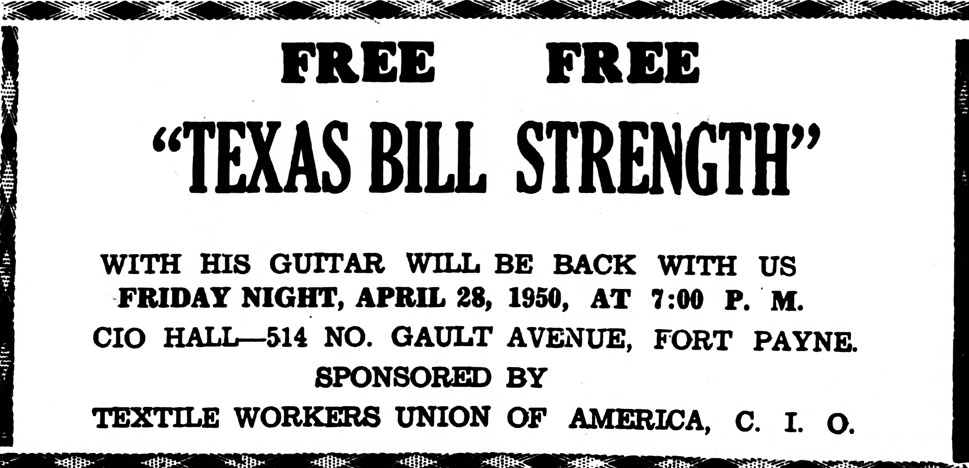
Fort Payne Journal, Fort Payne, Alabama. Wednesday, April 16, 1950
4-STAR RECORDS
In April 1950, TBS and his Saddlepals had a recording session for 4-Star Records in Houston.
Both songs were written by TBS. Billboard reported that the record (1465) was released on June 3, 1950.
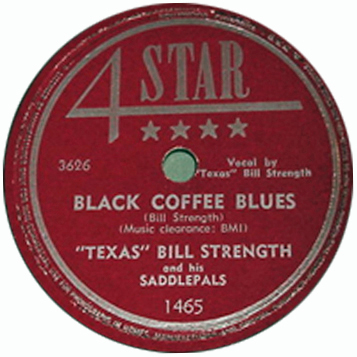
“Black Coffee Blues” 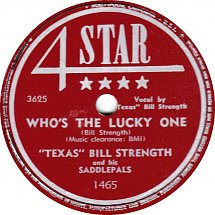
“Who’s the Lucky One”
MEETING WITH SENATOR HUMPHREY
On April 18, 1950, Minnesota Senator Hubert Humphrey came to make a speech in Richmond, Virginia. The original plan was for Humphrey to debate Virginia Senator Byrd, but arrangements could not be made for Byrd’s appearance, so Humphrey made a speech on “Which Way, America?” The event was sponsored by the Virginia Commonwealth League (an anti-Byrd organization), and took place at someplace called “The Mosque.” (Richmond News Leader, April 18, 1950)
The caption on the photo below reads:
MUSIC BEFORE ORATORY – Enjoying a bit of rhythm before his speech here last night is Senator Hubert Humphrey (second from left), with David G. George and James P. Hart (right), Virginia Commonwealth League officials. Guitar player is “Texas Bill” Strength.”
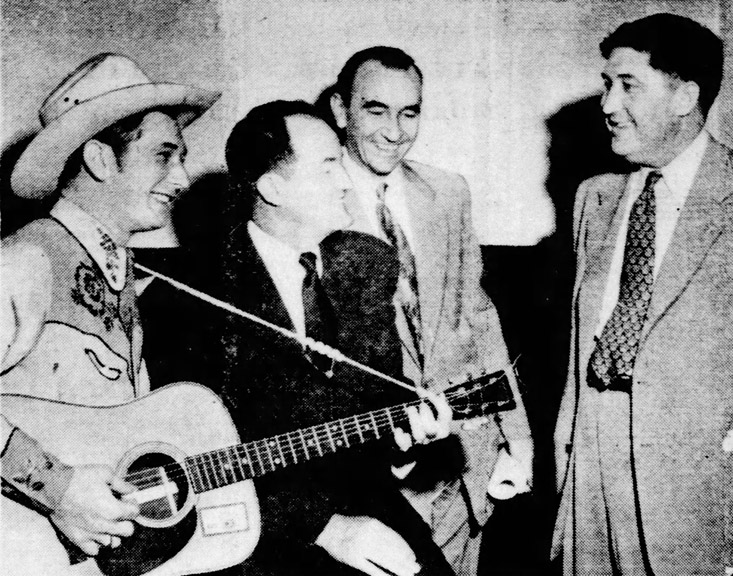
The photo below, heretofore undated, can now be dated April 18, 1950. Is the Senator playing Bill’s guitar? Photo courtesy Dale Strength
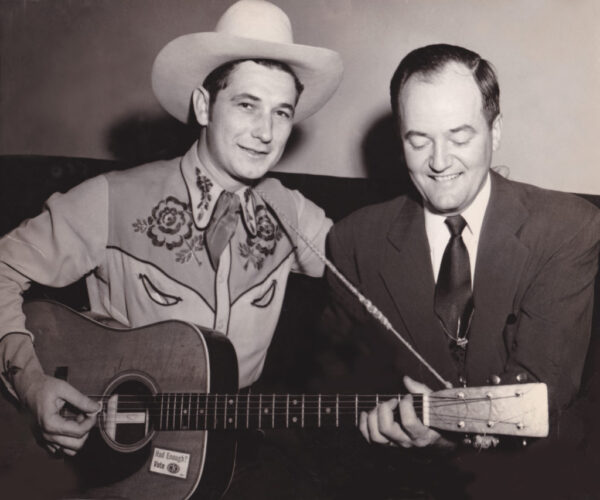
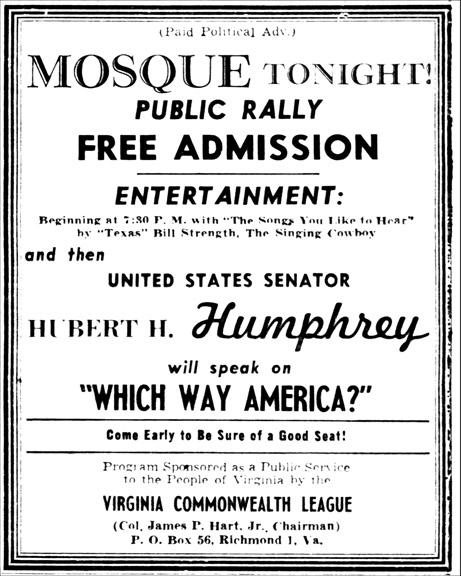
Richmond Times Dispatch, Tuesday, April 18, 1950
In the latter part of April, 1950, TBS was to accompany Representative George H. Christopher of Missouri on several appearances through Virginia Textile Workers Union Halls. The schedule was:
- April 21, Friday night, Fairy Road, near Danville
- April 22, Saturday afternoon, Clarksville
- April 22, Saturday night, Lynchburg Union Hall
- April 23, Sunday afternoon, Buena Vista
TBS was given two paragraphs about his background in the announcement in the Lynchburg (Virginia) News and Advance, April 18, 1950.
Unfortunately, TBS missed the April 22 event, where 250 textile workers showed up, because he was “called back to Georgia for organizational activity.” His replacement was Screechy Carwile, Lynchburg folksinger. (Lynchburg News and Advance, April 23, 1950)
May 1950
WE WILL OVERCOME
The CIO’s theme song was “We Will Overcome,” the same song used by the Civil Rights movement ten years later. Records show that TBS and His Saddle Pals recorded it at 4-Star Records (OP-102) in May 1950. The flip side was “Shall We Gather at the River.” No release date is known.
Another 4-Star release, this time with Number 45-1499, is shown to be recorded in July 1950, also with his Saddle Pals. The flip side was again “Shall We Gather at the River” and no release date is known.
In 1952, the record appears on a CIO label with the number OP-102. TBS is listed as the Producer. According to RP, it was only distributed to union members.
In 1952, 4-Star reissued its 102 as X-36. A recording date of January 1952 is given, but that may be the reissue date, as TBS was no longer recording for 4-Star in 1952.
These reissues are confusing, as we can see below that there is a record with the number OP-104 issued by 4-Star. TBS worked for the CIO from 1950 to 1952, and for 4-Star from May 1949 to about 1950.
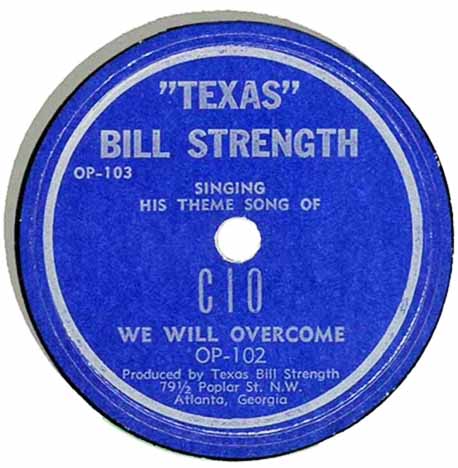
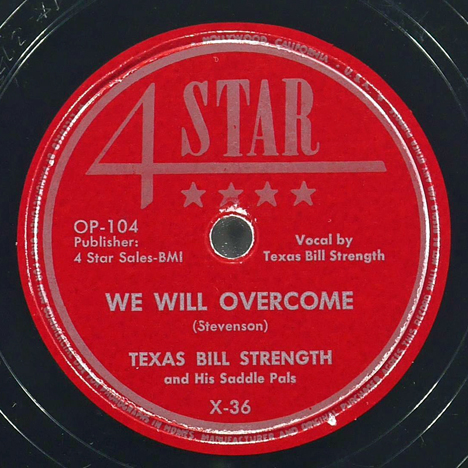
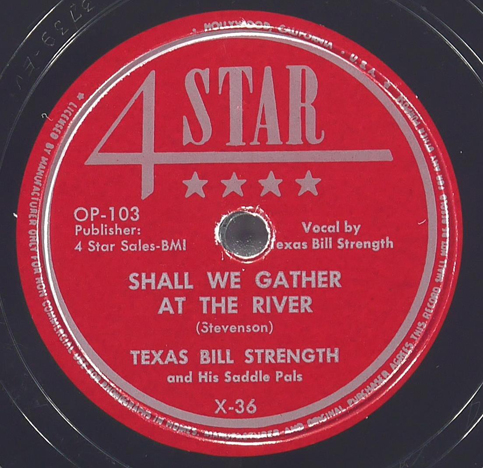
September 1950
4-STAR
In September 1950 TBS and His Saddlepals recorded four sides for 4-Star Records in Houston.
The first record was numbered 45-1532; no release date is known, and no Billboard review was found.
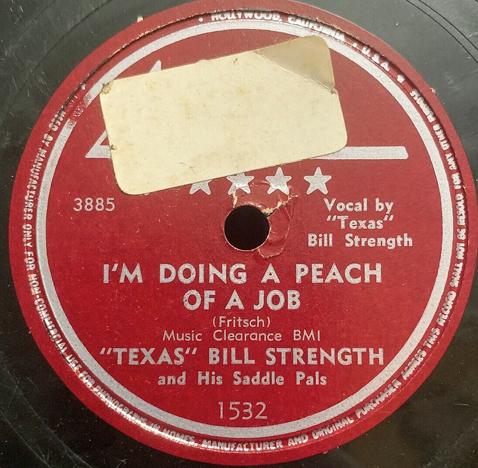
“I’m Doing a Peach of a Job” 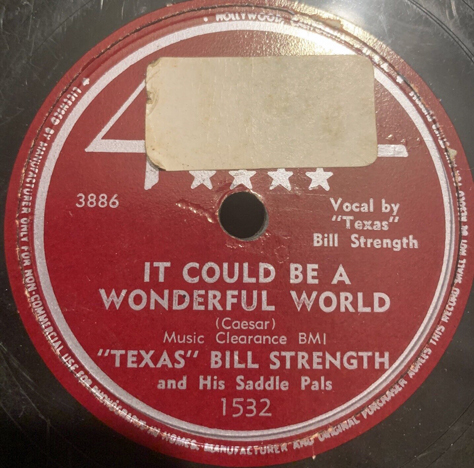
“It Could be a Wonderful World”
The second record was 45-1554 and was released in March 1951, as evidenced by an ad in Billboard placed by 4-Star Records on March 17, 1951. No review was found. It appears to be the last 4-Star release. The record below was pressed for disc jockeys and comes with a commercial!
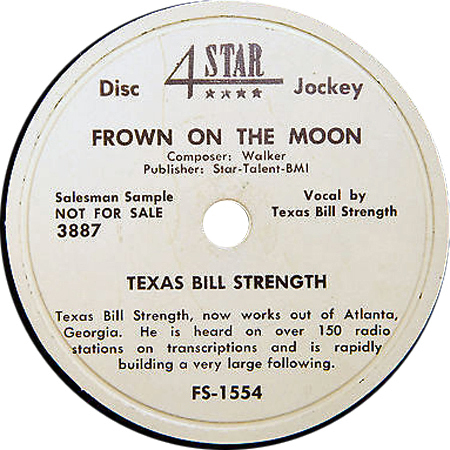
“Frown on the Face of the Moon” 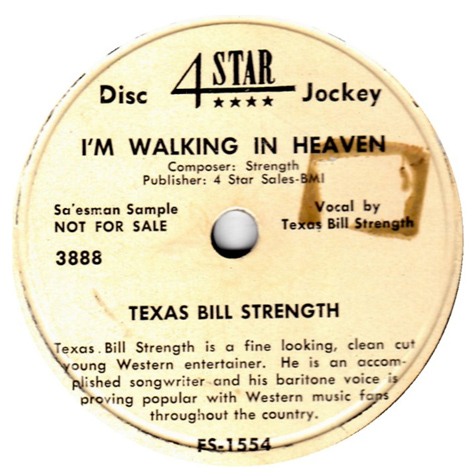
“I’m Walking in Heaven,” written by TBS
On September 22, 1950, TBS – billed as star of radio, stage and television – appeared at the Rebel Retreat in a program sponsored by the Bristol Optimist Club. Bristol, Virginia, and Bristol, Tennessee were across the state line from each other. Proceeds from the show were earmarked for the club’s general welfare fund. Bill was accompanied by a local band. (Bristol, Virginia Tennessean, Friday, September 22, 1950)
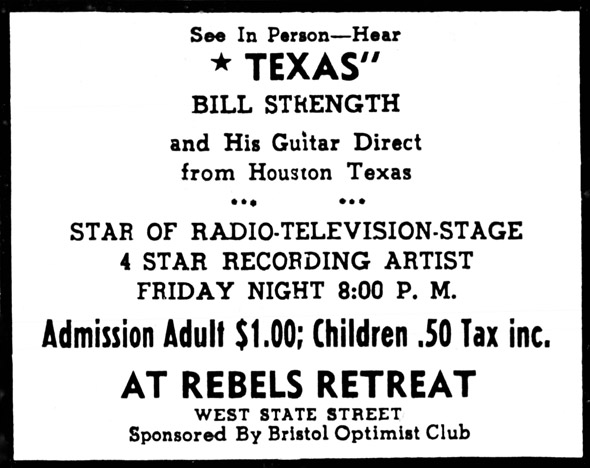
Bristol Herald Courier, Bristol, Tennessee. Friday, September 22, 1950
October 1950
- On October 1, 1950, TBS entertained 1300 boys at the Washington National Training School for Boys.
- On October 2 he was in Hickory, North Carolina, entertaining at the Sipes Orchard Home.
- He planned to give four or five shows in the area on October 3.
- From here he planned to go to Macon, Georgia to perform at the Macon Industrial Home.
Hickory, NC, Daily Record, October 2, 1950
On October 11, 1950, TBS performed three shows at the CIO Hall in Kingsport, Tennessee, for the benefit of Holliston Mills employees and their families. The shows were at 1, 3:30, and 7:30, and were sponsored by the CIO organizing committee. (Kingsport News, Tennessee, Wednesday, October 11, 1950)
On October 12, 1950, the CIO held a mass rally in the Hickory City (North Carolina) City Auditorium to acquaint the public with the CIO. In a pre-rally article, the Hickory Daily Record reported that:
Efforts are being made to arrange for the presence of TBS, movie and radio star [my emphasis], and the Hollywood Ramblers, composed of workers at a local furniture plant. “Emphasis at the present time is centered upon organizing the furniture industry in the Hickory-Lenoir-Newton-Conover area …” (October 7, 1950) Note that TBS had not and would not make a movie, despite his fondest dreams.
The next day, October 13, the Hickory Daily Record reported that:
Previous to the opening of the meeing and at intervals during the sessions, music was furnished by “Texas” Bill Strength of Houston, Tex., widely known guitarist and singer of hillbilly songs; and Oscar Turner and “Red” Eckhard, guitarist singer and mandolinist-singer, respectively, Hickory furniture plant workers.
November 1950
In his column “Lowdown on Hoedown,” Verlin Mays wrote that TBS was
enjoying a brief vacation after his recent tour through Bristol and surrounding towns in Southwest Virginia and East Tennessee. According to a letter I received from Bill, he’ll really start to work in earnest in a few more days. I’d like to wish him a lot of luck because he certainly is a fine boy and a wonderful entertainer.
Bristol Virginia Tennessean, November 10, 1950
December 1950
TBS (4-Star), who has been working labor meetings for the CIO during the past 14 months, was featured singer at the CIO’s national convention in Chicago at the Hotel Stevens two weeks ago. The labor org intends to cut a six-disk album shortly of labor songs by Strength. (Billboard, December 15, 1950)
TBS, “the well known Southern radio and recording star,” was scheduled to make a personal appearance at a “Let’s Get Acquainted” Square Dance sponsored by Local 273, United Furniture Workers of America, CIO (Williams Furniture) on December 4, 1950, at Dave’s Place in Sumter, South Carolina. (Sumter Daily Item, Saturday, December 2, 1950)
TBS with Hank and Audrey Williams in Shreveport, 1950.
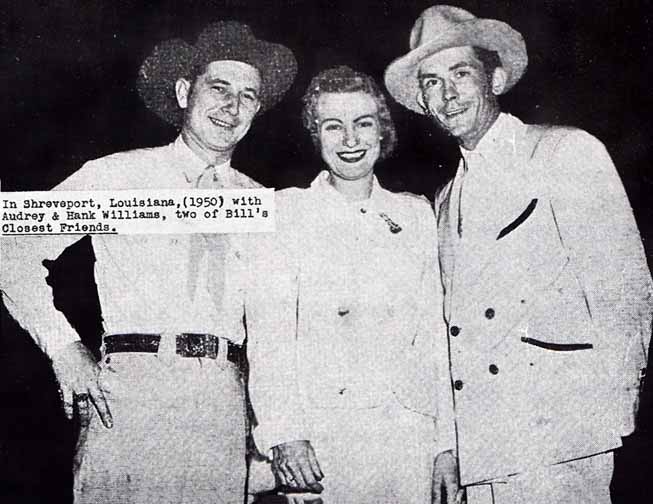
Photo courtesy Jan Sherman, via Derik Olson
1951
GRAND OLE OPRY
Somewhere it says that TBS had been the guest of Ernest Tubb on the Grand Ole Opry five times by 1951. Dates for Bill’s appearances on the Opry are very difficult to track down. Another “article” says that he appeared on September 23, 1950, but that article seems to have disappeared. Other possible dates are:
- 1952 – In his “Down Memory Lane” column, he wrote that he was on the same segment as Hank Williams on his first appearance on the Grand Ole Opry in 1952 (Upper Midwest Country & Western News – Scene, September 1973)
- March 21, 1953, guest of Webb Pierce
- July 12, 1953
- 4
- November 21, 1953 (but that was the Disc Jockey Convention)
- January 29, 1955, guest of Faron Young (or was it the same date, 1956?)
- Spring 1955, guest of Carl Smith
- August 6, 1955
- April 22, 1961
Mind, one needs to be asked by a member to be a guest on the show, and TBS was never a member of the Opry. He was a frequent member of the Grand Ole Opry roadshows, but the number of times he actually appeared at the Ryman Auditorium in Nashville is unknown.
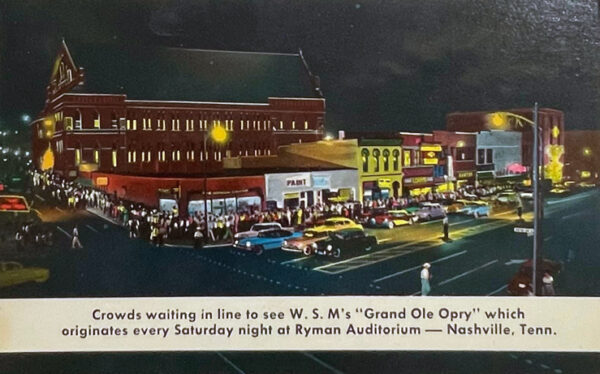
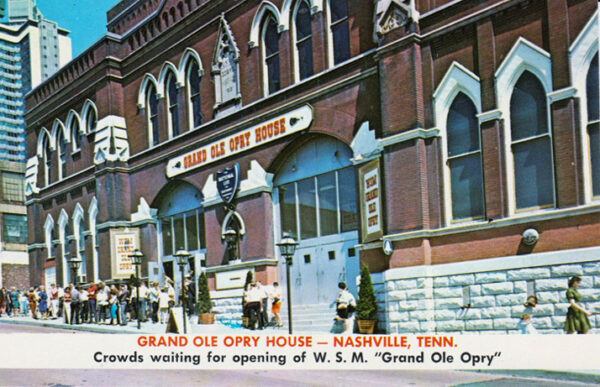
The 1951 Atlanta directory listed TBS’s occupation as “vocalist CIO,” living at 124 Jewel.
January 1951
TBS entertained at a two-day CIO convention in Tampa on January 13-14, 1951. (The Tampa Tribune, January 12, 1951)
February 1951
On February 1, 1951, TBS was in Birmingham, Alabama, for a series of CIO meetings. He was pictured in the Birmingham Post-Herald on February 2 visiting the “Crippled Children’s Clinic,” “which is his custom in each city he visits.”
TBS entertained at a meeting of the United Steelworkers of America from Utah and Nevada, which took place in Midvale, Utah, on February 4, 1951. (The Park Record, Park City Utah, February 1, 1951)
April 1951
Robert Wayne Strength, TBS and Dorothy’s second child, was born in Atlanta on April 13, 1951.
On that very day, Ernest Tubb wrote a generous introduction of TBS to Dave Kapp of Decca Records, inviting Kapp to listen to Bill’s music. At this point in his life, Bill was probably indeed still clean cut and conscientious. His wife Dorothy said that his problems with alcohol didn’t start until he met the boys in Memphis in about 1954.
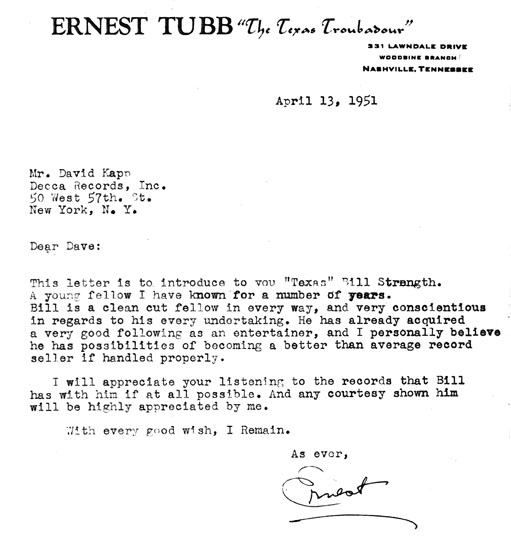
In 1951 TBS made several appearances over WAGA-TV in Atlanta while still working for the CIO.
October 1951
The photos below were taken at a conference of the United Steelworkers of America, District 35, Local 309, in Alcoa, Tennessee, on October 6, 1951. The man in the second photo is W.H. Crawford. At the time, Crawford was the Director of the United Steelworkers of America.
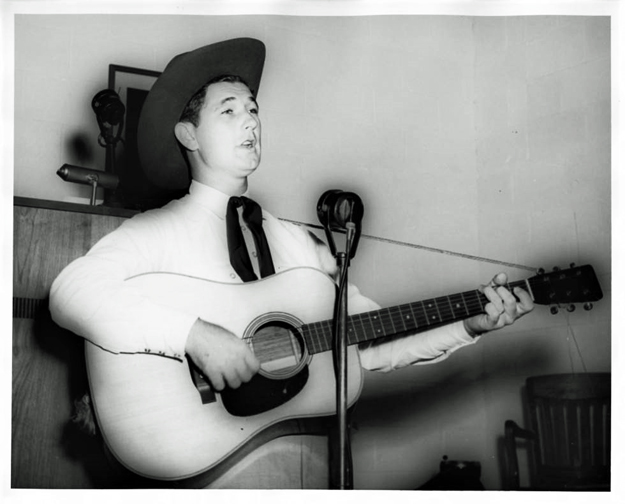
Photos Courtesy Georgia State University Library
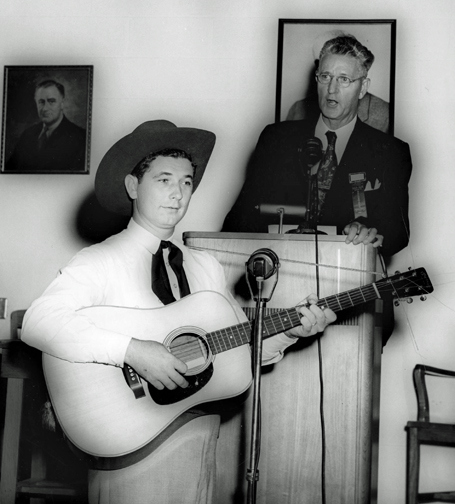
November 1951
CORAL RECORDS
In November 1951, TBS signed a three-year contract with Coral Records, a subsidiary of Decca. His friend Ernest Tubb was instrumental in securing the deal, which was beneficial to Tubb as well, since it meant extra work for some of Tubb’s Texas Troubadours. Plus, TBS was under contract for a time to Ernest Tubb Music for his publishing. (Ronnie Pugh)
Billboard explained that Owen Bradley was hired to head up the recording operation of Coral Records, and nine new country artists were added to the roster, including TBS “of Atlanta.” (February 9, 1952)
On November 26, 1951, he had his first Coral session, cutting four sides at the Tulane Hotel in Nashville:
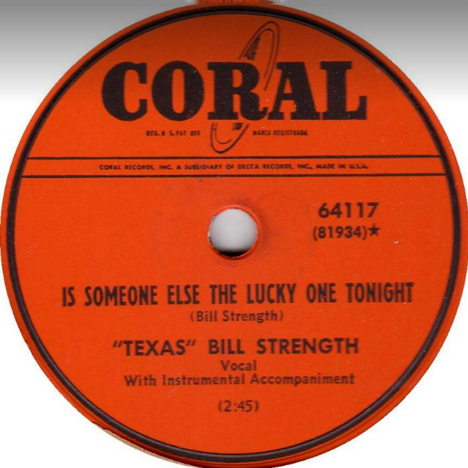
“Is Someone Else the Lucky One Tonight,” written by TBS 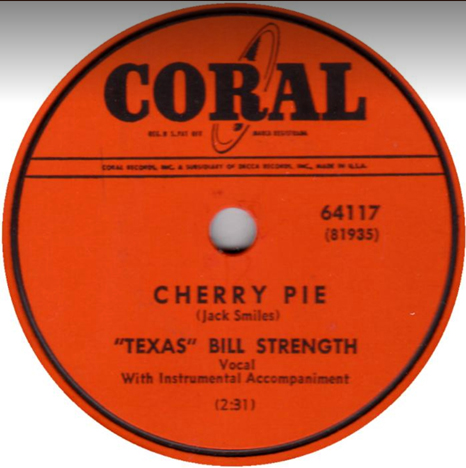
“Cherry Pie” 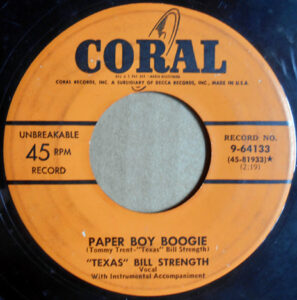
“Paper Boy Boogie” Paper Boy Boogie” was originally written and released by country singer Tommy Trent on Checker Records. TBS added his own flair and covered it shortly afterwards.
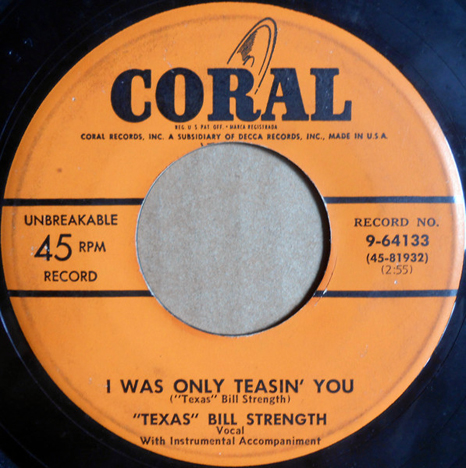
“I Was Only Teasing You,” written by TBS Coral 64117 was issued as a 78 rpm record. No release date or Billboard review were found.
- “Is Someone Else the Lucky One Tonight,” written by TBS
- “Cherry Pie”
Coral 64133 was issued in June 1952 and Billboard reviewed it on June 14, 1952:
- “Paper Boy Boogie:” “Material in this one is very strong with a good boogie beat. Fine instrumentation includes a standout honky tonk piano. Vocal by Bill Strength adds to the attractiveness of side. Should pull coin.” (Ronnie Pugh says Chet Atkins played guitar on this record.)
- “I Was Only Teasing You:” “Tune is a switch on the normal weeper. Texas Bill warbles it in pleasant style with a fine assist from the sidemen.”
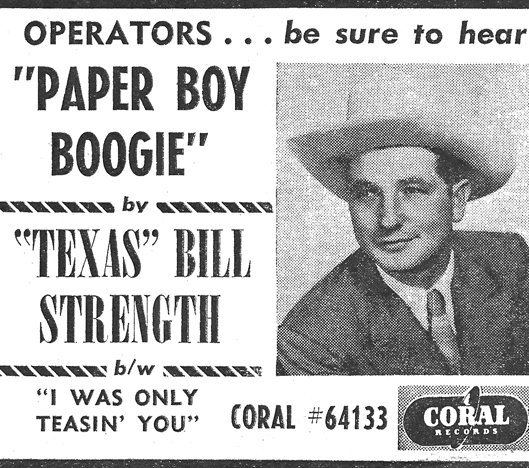
Ad courtesy Dale Strength
At some point in 1951, TBS entertained a North Carolina textile organizing meeting. Now, this photo may just be 2/3 of Bill from the back, but the message it imparts lies in the smiles and laughter on the faces of the men and women in his audience.
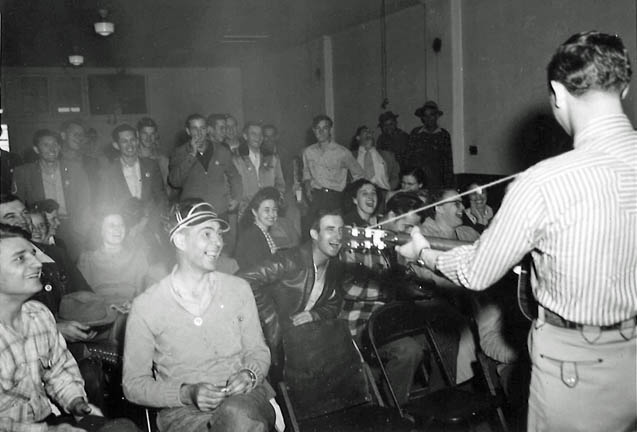
Photo courtesy of the George Meany Labor Archive at the University of Maryland, College Park
1952
February 1952
TBS, new Coral addition, is now working regularly at WAIM, Anderson, SC, and plans to book more talent into his region. He is contemplating using Ernest Tubb soon. (Billboard, February 23, 1952)
April 1952
TBS (Coral) is still working out of the Atlanta office of the CIO, doing songs at labor gatherings. (Billboard, April 5, 1952)
WEAS, DECATUR
On April 6, 1952, TBS moved his base from WGST in Atlanta to WEAS in Decatur, just 5 miles northeast of downtown Atlanta. No longer just on Sundays, a June 1954 article mentioned that his show was from 11:00am to 12:45pm daily. Still working for the CIO, his target audience consisted of the employees of Lockheed. He had a manager, John V. Riffe of Atlanta. (Ronnie Pugh)
This half-hour show gave out special prizes and launched the “Texas Bill Talent Hunt.” “Anyone who can sing, whistle or play ‘Chopsticks’ on a musical instrument and wants to appear with Bill on the radio should contact the CIO office.” (Ronnie Pugh)
Bill would spend over two years at WEAS, and became a fixture in the Atlanta area. He was known as “The Singing Disc Jockey.”
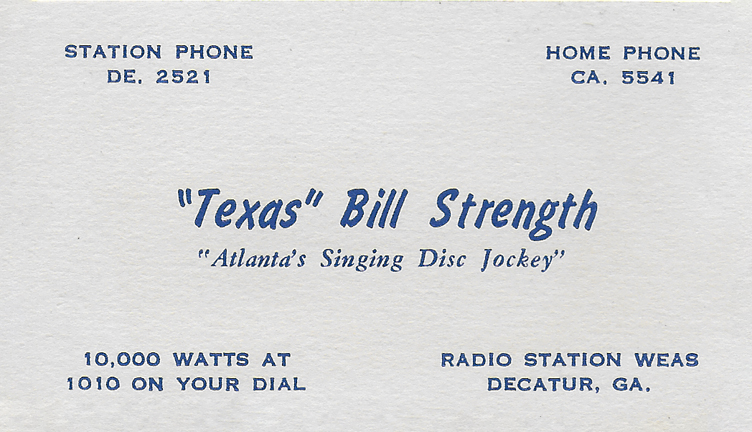
Business Card Image courtesy Dale Strength - He brought top country music acts into the area for the Dixie Barn Dance, held at East Point’s Civic Auditorium.
- He appeared on WLWA-TV with Ray McKay and the Swingbillies.
- He recruited acts to appear at “his own” Silver Slipper Club, where he would perform on weekends.
THE SILVER SLIPPER
After much frustration and asking questions and writing letters, we still do not know where TBS’s elusive Silver Slipper night club was located. References in the newspaper go back to 1937, when it was reported that Police found a stolen taxi at the Silver Slipper roadhouse on the New Macon Highway (which is now the Old Macon Highway). In 1938, owner Paul Johnson was indicted by the Clayton County Grand Jury on three counts of having slot machines at the Silver Slipper roadhouse. In 1941, County Commissioners revoked all dance hall licenses in Clayton County. The Silver Slipper was referred to as a “Jook.” The location was described as just beyond the Fulton County line on McDonough Highway.
By 1949, the Silver Slipper had changed hands and was now owned by J.P. Copeland. We know this because he was in trouble. He also had a tourist camp, and he was charged with not keeping track of his guests’ cars. Think of one of those noir movies where the young couple are running from the law and/or their parents for one reason or another. We learn here that both the Silver Slipper and the tourist camp are on Highway 42.
On February 20, 1950, the Silver Slipper was advertised for sale or lease. The property included the night club and courts, and apparently was described as being on the Airline Highway.
The first ad shows up in 1950:
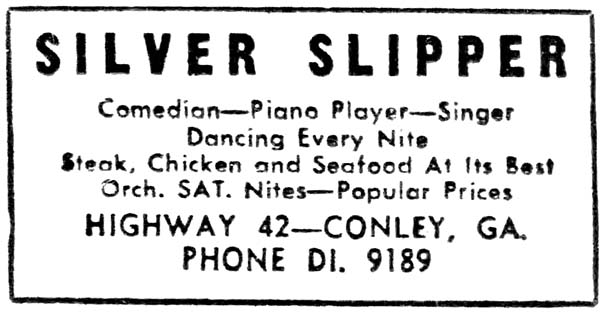
Atlanta Constitution, December 25, 1950 On February 28, 1953, one could dine and dance to Groover’s Orchestra.
On June 5, 1953, the Silver Slipper Dining Room was listed for rent or sale. The ad said that it seated 200. It’s possible that this may have been when TBS became an owner/partner.
The next mention is an ad in February 1954.
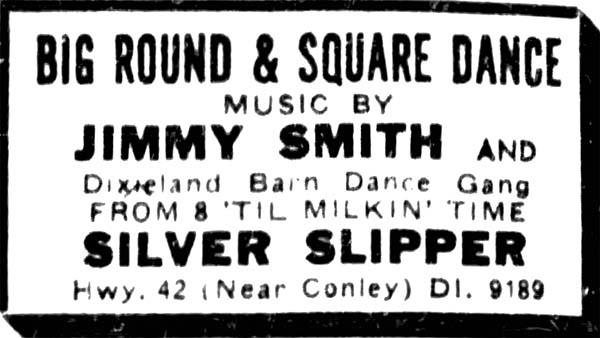
Atlanta Constitution It was probably during 1954 that TBS recorded “Y’all Come” on the radio, which can be heard here. As you can hear, he throws in a “to the Silver Slipper Friday nights.”
Most mentions of the place in Billboard occur in 1954, and are listed below.
An issue of the Houston Star from the Summer of 1954 provides the names and instruments of the Melody Ranch Boys while promoting TBS’s club, the Silver Slipper:
Every Friday and Saturday night, folks in and around Atlanta can now dance to the music of TEXAS BILL STRENGTH, and the MELODY RANCH BOYS, at the fabulous SILVER SLIPPER SUPPER CLUB, on Hiway 42, eight miles from downtown Atlanta. The MELODY RANCH BOYS feature Buddy Pattilo, fiddle; Jimmy Estes, electric bass; Lamar Hawkins, electric guitar; and our star, Bill. They are also heard daily at 7:15pm over WEAS.
Even though he left Decatur for Memphis in September 1954, the Silver Slipper continues to be mentioned until the end of October 1954.
In January 1955 it was further described as being on Moreland Ave., which is the same as Highway 42.
One last ad for the Silver Slipper appeared in 1957:
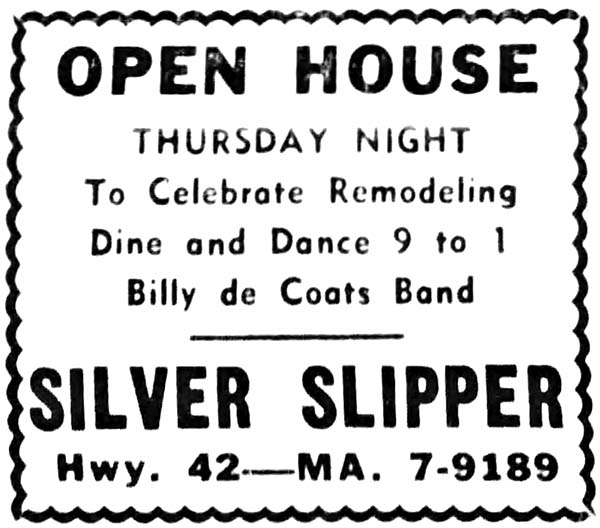
Atlanta Constitution, September 19, 1957 On October 21, 1959, owner Jasper T. Copeland died of a stroke. He had lived on Highway 42 for 14 years. The Silver Slipper had been leased to Amvets.
The area is mostly industrial now, but there is something telling. There is a road that loops off of and behind Moreland Ave. called Cottage Lane; ironic given the miles of trucks and factories it abuts. But one guess is that the Silver Slipper or at least those tourist cabins used to sit inside that area. So far, the answer is elusive.
April 1952
Sandra Pearl Strength, TBS and Dorothy’s third and last child, was born on April 13, 1952, most likely in Atlanta. Her arrival was announced in the July 26, 1952, issue of Billboard.
June 1952
CORAL RECORDS
On June 27, 1952, TBS had his second recording session for Coral at the Tulane Hotel in Nashville:
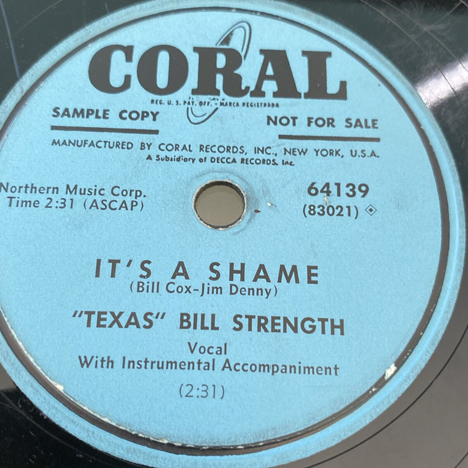
“It’s a Shame 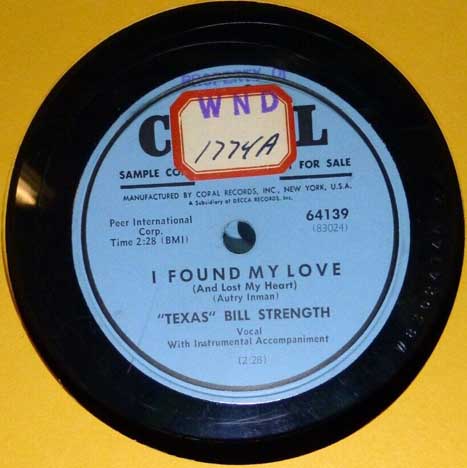
“I Found my Love and Lost my Heart” The record was released in September 1952 and reviewed by Billboard on September 27, 1952:
- “I Found My Love” – The chanter has a fine country tune here and he gives it a sympathetic reading. Tho Strength’s piping is not very powerful, he projects with a good deal of warmth.”
- b/w “It’s a Shame” – “Routine rural weeper is read with the proper pleading quality by Texas Bill. Might do okay in the more rustic areas.”
July 1952
Strength’s e.t. radio show is now heard on 51 Southern stations. He is still touring for the CIO. (Billboard, July 26, 1952)
CORAL RECORDS
On July 28, 1952, TBS returned to Coral Records for his third recording session:
- “Rain or Shine”
- “Heart Don’t Complain”
Coral 64152 was released in March 1953 and reviewed by Billboard on April 4, 1953:
- TBS is on the charts with Coral release “Rain or Shine” (“Bouncy ditty is sung nicely by Strength with his strong voice. Strong band gives good support.”)
- b/w “Heart, Don’t Complain” (“Melancholy oatune is warbled with feeling by Strength. He’s trying to tell his heart that he tried his best.”)
TROUBLE IN HAZELHURST
Being an itinerant folk singer with the CIO was not without its hazards. Organizing large companies was a hot-button issue in the 1950s, and you might just get run out of town.
Take for example the case of the Cook Lumber Company, where CIO organizer John Scott was “mauled” by a man at the gate of the company on July 31, 1952, for handing out union leaflets to workers. The next day, July 1, a man claimed he was beaten by union organizers. July 1 was also the day that John Ramsey, the director of community relations for the CIO, and Texas Bill arrived in town from Atlanta. Bill was known as “the CIO Singer of Songs,” said the report. Ramsey said that he, Scott, and Strength were beaten by seven men at the gate of the plant.
The CIO organizers had planned a mass meeting on July 2, but they called it off at the request of the Sheriff, who could not guarantee their safety. The Sheriff said he feared violence unless the organizers left town. As the six union men started to leave their hotel, a crowd of about 50 men gathered around, and the Sheriff told the mob that the CIO men were leaving. The Sheriff escorted the union men to a nearby town, followed by about a dozen cars.
Ramsey vowed to return to Hazelhurst with lawyers and warrants in two or three weeks to arrest their assailants. He said that they were asked to come into Hazlehurst, and “the trouble was started by a small gang of thugs used by certain politicians.” (The Macon Telegraph, Monday, August 4, 1952)
August 1952
TBS was the special guest on KWKH’s Louisiana Hayride, in Shreveport, on August 2, 1952.
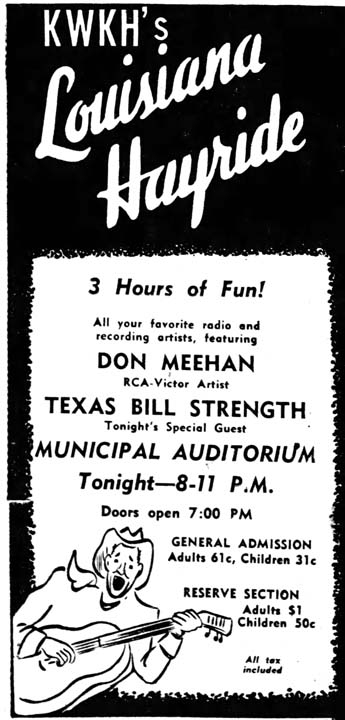
Shreveport Times, August 2, 1952
Fall 1952
THE HOUSTON STAR
Another indication of TBS’s popularity was his Fan Club, based in Columbia, Tennessee. The club was run by Willie Bea Gray and Freda Jones, who called him the Houston Star.
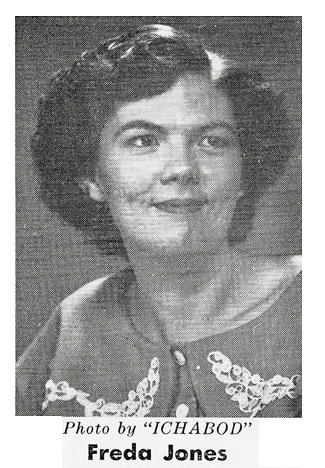
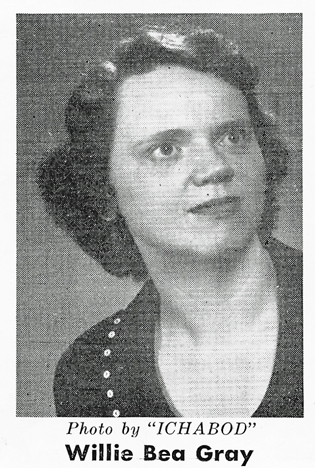
For a dollar a year, members received an autographed photo, membership card, a newsletter every six weeks, and the quarterly Houston Star publication, described as slick, fact-filled, and one of the best of its kind. The first issue came out in the Fall of 1952. By the spring of 1954, membership reached 40,000 in 20 states, and by that fall it claimed coverage in all 48 states. The club’s motto was “Let’s Boost Bill With All Our Strength.” (Ronnie Pugh)
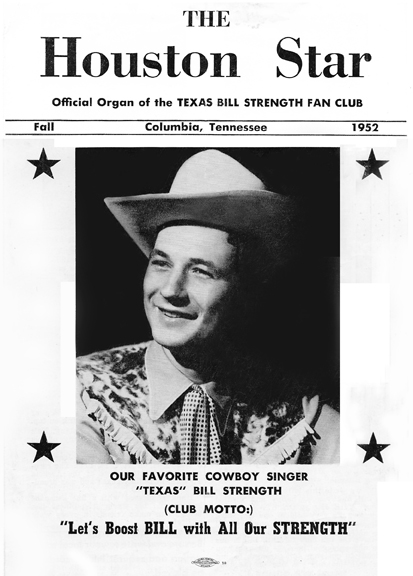
Cover of the first edition of the Houston Star, Fall 1952
They open with this letter to Texas Bill’s fans:
Dear Friends:
As we write this letter we are hoping it will find you as happy and thrilled about “THE HOUSTON STAR” as we. You see, it’s very seldom one can work with a fine person as our own Bill Strength. And we do feel it a great honor to have the fan club for Bill. Bill is our one and only goal, and we do want you friends to put your full Strength behind our Bill – making him one of the tops in this folk music world! He has put his full support behind the club, and it is his will for it to be a success. With your help it will be a success. It is as much your club as it is ours, so be sure to send your news for the journal and write and tell us what you think of this first issue. We hope you will help us to obtain new members. And please do request and buy Bill’s records. You’ll like them we know! Remember – Let’s Boost Bill With All Our Strength. In the meantime don’t forget we are —
Yours for Bill,
Freda and Willie Bea
Here was Bill’s response, also in that first edition in Fall 1952:
Dear Club Members:
I don’t know how to go about thanking you for taking an active part in my new fan club. I’m really excited about it, and of course, grateful to Freda and Willie Bea for being so progressive in getting it started.
We want you to feel that this is your club, and want you to mail in suggestions on how we can improve it. From time to time, we’ll print the words to songs, poems, etc. Be sure and let us know who your favorite country singer is. Freda and I have discussed having a contest later on. You’ll be hearing more about it in the near future.
In future issues of the HOUSTON STAR, I’ll be letting you know where I’ve been on my trips for the CIO, and when I’ll be coming through your home town.
Until next time, lots of luck to each of you, and thanks for joining the club.
Texas Bill Strength
Tragedy struck in April 1954, when the home of President Freda Jones was destroyed by fire, taking all of the records of the club with it. Miss Jones asked that members contact her by writing to the club at 104 East 14th Street, Columbia, Tennessee. (Huntsville Times, April 8, 1954)
Ronnie Pugh stated that the club operated between 1952 and 1955, Bill’s peak years in the South. Indeed, we have copies of the Houston Star dated:
- Fall 1952
- Spring and Winter 1953
- Spring and Summer 1954
- Spring, 1955
However, there was evidence that it lasted at least until at least 1957. On September 30 of that year, Billboard reported that Mary Moore, 112-A Peak Tops (U.S.N.S.), Green Cove Springs, Florida, is the new president of the TBS Fans’ Club, succeeding Dixie Ann Brown, who has been forced to resign due to illness.
October 1952
TBS may guest at the national CIO convention in Los Angeles in mid-November. (Billboard, October 25, 1952)
1953
The 1953 Atlanta directory listed TBS’s occupation as “field rep CIO,” living at 124 Jewel East Point.
SOUTH CAROLINA
February 1953
TBS (Coral) is renting his home in Atlanta to move permanently to Columbia, SC, where he’ll do his radio shows for the CIO. (Billboard, February 7, 1953)
The above was the last mention found of the CIO. It appears that, for whatever reason, TBS chose to leave the CIO (or the CIO chose to part with him) and he returned to his job and home in Atlanta, on WEAS. Ronnie Pugh’s biography doesn’t mention this move to Columbia, so there’s no evidence other than the Billboard items that he actually moved his family out there.
March 1953
NASHVILLE
From the Houston Star, Spring 1953:
TBS guested on Webb Pierce’s program at the Grand Ole Opry on March 21, 1953.
Two of his fans took the bus to see him, and wrote their recollections for the Houston Star, Spring 1953:
[He was]dressed in a lovely green cowboy suit. The yoke o the shirt was in white, greeen fringe. On the pants were designs of white horseshoes at the pockets. To this Bill wore a green scarf, white hat, and green and whitte cowboy boots. All of you would have been proud hof nice he looked that Saturday night.
He also went to the Ernest Tubb Record Shop, where he sang his latest release, “Rain or Shine.”
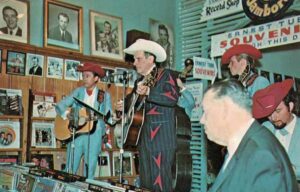
Ernest Tubb’s Record Store He also made an appearance on Smiling Eddie Hill’s “Opry Echoes” at radio station WSM.
(BACK TO) ATLANTA
April 1953
Bill was on WEAS in April 1953, although for only half an hour in the early morning. On Sunday, April 26, he performed two shows with Hank Thompson and his Brazos Valley Boys, Ron McKay and the Swing Billies, Dan Ross, and others at a show at the East Point Auditorium in East Point, Georgia. In his Fan Club newsletter, the Houston Star, he reported that Hank came over to the Strength’s house for dinner.
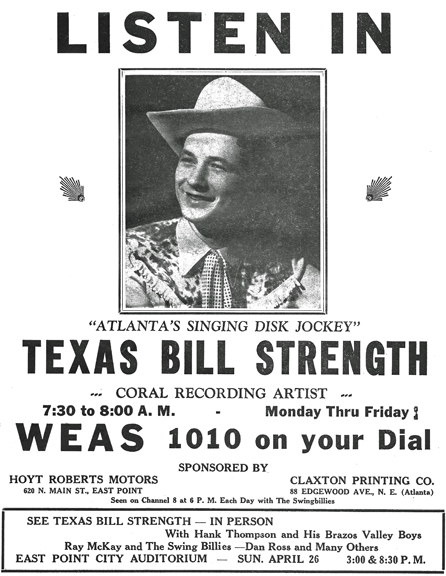
Image courtesy Dale Strength
May 1953
TBS writes from Atlanta that he’s now [back] with that city’s Radio Station WEAS. (Billboard, May 2, 1953) He had worked at WEAS since April 6, 1952.
He was also appearing on TV with Ray McKay and the Swingbillies at WLWA-TV (Mondays at 5:30 pm, Channel 8.) Plus he had a one-our broadcast on Saturday mornings called the “Young American Club,” which gave young boys and girls a chance to get on radio and win prizes. “I’m really thrilled about this show,” he wrote in the Houston Star. “It looks like it will eventually grow into something big for the boys and girls in Atlanta.”
Bill rode a beautiful white stallion in a huge parade down Peachtree Street in Atlanta on May 7, 1953, in honor of Korean war veteran and former P.O.W. Pfc.William G. Moreland of Atlanta, reported the Spring 1953 issue of the Houston Star.
On May 10, 1953, TBS appeared with Mrs. Hank Williams at the East Point Auditorium in Atlanta. Also on the bill were Radio Dot and Smoky, and the Swingbillies.
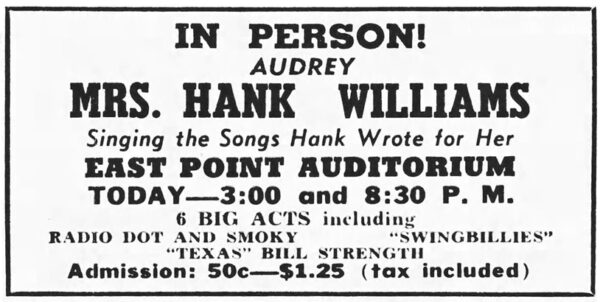
Atlanta Journal, May 10, 1953 In the Spring 1953 issue of his fan club’s Houston Star newsletter, he said that his wife “Dot and I intend to go to Hollywood for our summer vacation and visit Tex Ritter.”
Other news was that TBS’s new Song Book #2 was now available for 50 cents, sent to TBS Publications at a PO Box in Atlanta.
June 1953
TBS, Coral recording star, has started a talent quest show over radio Station WEAS, Atlanta, “Young American Club Broadcast,” from 9 to 10 am each Saturday. Youngsters perform either hillbilly, pop or jazz. (Billboard, June 6, 1953)
The Winter 1953 issue of the Houston Star reported that the Strengths did indeed take that summer vacation to Hollywood. TBS and promoter William McFarland drove to the West Coast, and Dorothy followed by plane, arriving seven days later than the men did. The children stayed home. Dorothy visited an aunt and uncle, who had never met Bill before. They took the Sunset Limited back together, via Pasadena, Tucson, Yuma, and El Paso.
The Winter 1953 Houston Star also mentioned several other appearances, some dated, mostly not:
- He was a featured star on the “Mid-Western Hayride” program, over station WLW in Cincinnati. That was both a radio and TV show, so there’s no way to determine which he was on.
- He was a guest of Jimmy Skinner over WNOP, Newport, Kentucky.
- He played to a full house for Ted Kirby in Ft. Payne, Alabama.
- He played the National Guard Armory in Birmingham.
July 1953
On July 12, 1953, Red O’Donnell, in his “Top o’ the Mornin’” column in the Nashville Tennessean, reported that TBS was in town to appear on the Grand Ole Opry. The next month, August 1953, O’Donnell noted TBS’s birthday in his column.
September 1953
TBS is working in Atlanta’s Coral distributor’s office with John Thompson (formerly Cincinnati) in charge. (Billboard, September 12, 1953)
October 1953
TBS and Leon Beaver set for new Coral session immediately under direction of Johnny Thompson, who also handles diskery’s Atlanta office. (Billboard, October 3, 1953)
TRAILWAYS STATION
On October 15, 1953, Atlanta’s new Trailways Bus Station opened with much ballyhoo, and TBS was prominently included in the festivities. Below is the full page and two close-ups of the entertainment sections, from the Atlanta Constitution.
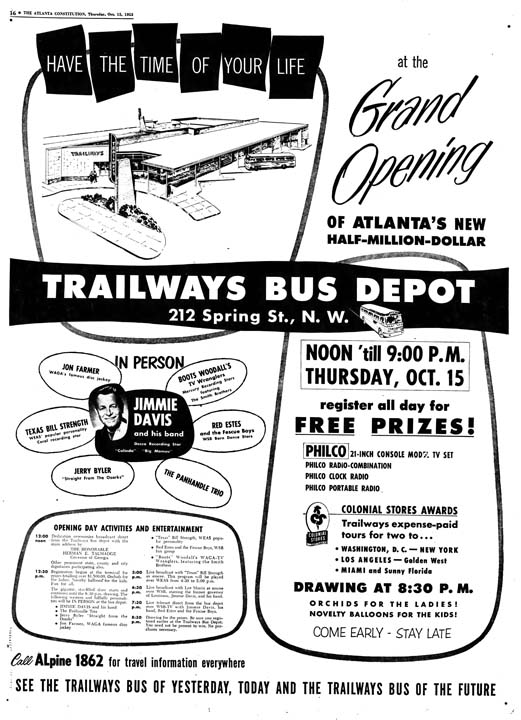
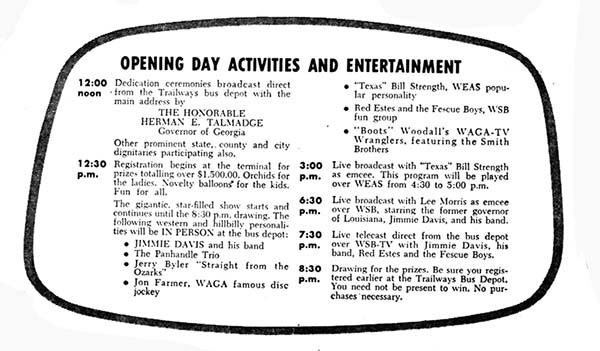
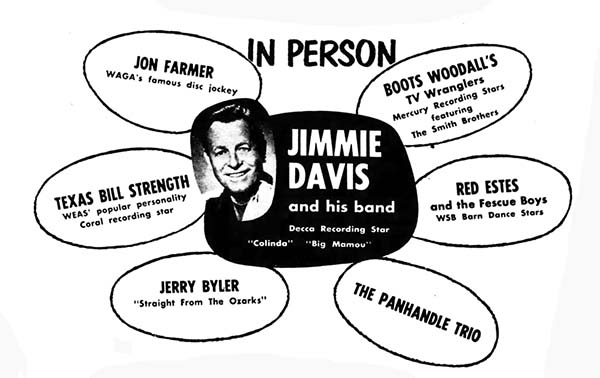
Billboard reported that ex-Governor Jimmy Davis was the guest of Georgia Governor Herman Talmadge for the occasion, and that festivities were headed by:
- Boots Woodall
- Smith Brothers
- Paul Rice
- Pat Patterson
- Cotton Carrier
- TBS
The Houston Star reported that Bill and Curtis Gordon promoted a show in East Point, Georgia on October 25, 1953, which starred Faron Young, Little Rita Faye, Smily Wilson, and Kitty Carson. No evidence of this show is found in the Atlanta newspapers online, and in fact, Faron Young had just gone into the Army and was highly promoted for a show on September 11 for U.S. troops.
However, on November 14, 1953, Billboard reported that TBS promoted an all-star country jamboree in Atlanta recently, with:
- Little Rita Fay
- Curtis Gordon
- Faron Young
- Smiley Wilson
- Kenny Lee
- Kitty Carson
- David Bucie and his boys headlining the bill
RHYTHM RANCH
From the end of October to the end of November 1953, TBS had some dates at the Rhythm Ranch, 19 Baker Street NW, in Atlanta. He shared the stage with the Las Vegas Seven, but also with Piano Red, a/k/a Dr. Feelgood?!
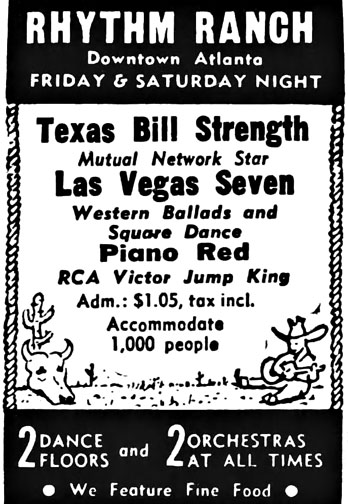
Atlanta Journal, October 23, 30, November 6, 14, 17, and 20, 1953 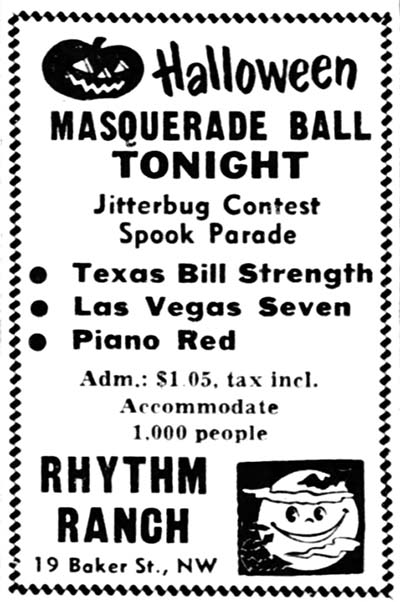
Atlanta Constitution, October 31, 1953
November 1953
NASHVILLE
November 20 – 21, 1953 were the dates of the Second Annual Hillbilly Disc Jockey Convention, held in Nashville. These events became more and more corrupt and riotous, until the convention of 1959 broke open the whole corrupt system of payola. An expose in the Miami Herald shouting “Booze, Broads, and Bribes” put many DJs out of work, including Alan Freed, virtually the inventor of Rock ‘n’ Roll. Dick Clark survived only by divesting of his many other interests in movies, song publishing, and other subsidiaries.
The Houston Starr also reported that while in Nashville, TBS also guested on the Ernest Tubb Jamboree and made a guest appearance on the Grand Ole Opry.
CORAL RECORDS
On November 21, 1953, TBS recorded four sides for Coral at the Tulane Hotel in Nashville.
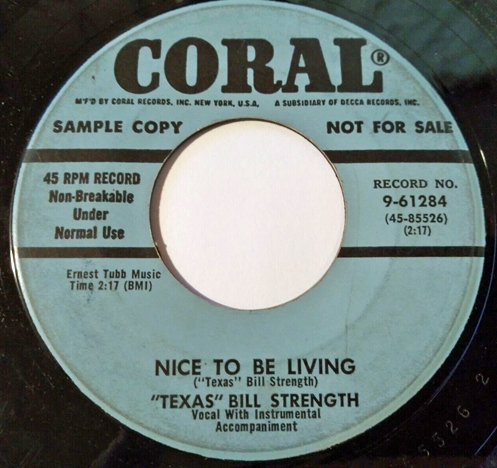
“Nice to be Living,“ written by TBS 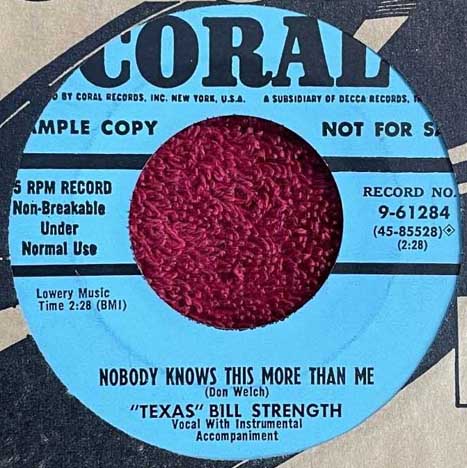
“Nobody Knows This More Than Me“ 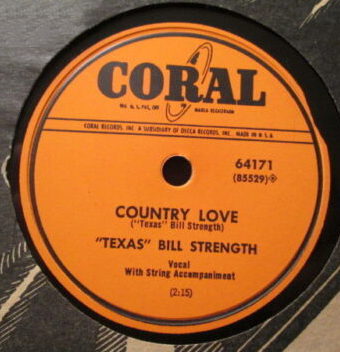
“Country Love,“ written by TBS 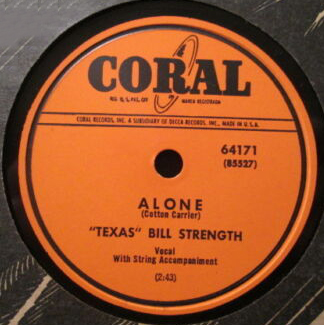
“Alone“ Coral 64171 was released in January 1954 and was reviewed in Billboard on February 6, 1954:
- “Country Love” – “Here’s a real cute country item, combining novelty appeal with solid rural sentiment. The ditty is Ernest Tubb’s, and TBS gives it a solid vocal.”
- b/w “Alone” – “A rural ditty full of sadness and pitched in a minor key. TBS does the vocal with heart.”
Coral No. 61284 was release in November 1954 and Billboard reviewed it on November 13, 1954 (a year after the sides had been cut):
- “Nice to be Living,” – A jaunty-paced vocal on a happy little ditty
- b/w “Nobody Knows This More Than Me” – A plaintive weeper about a man who couldn’t buy love, sung with sincerity and feeling.
This acetate appears on YouTube, and appears to be a demo, before the final version of “Nice to be Living” was recorded.
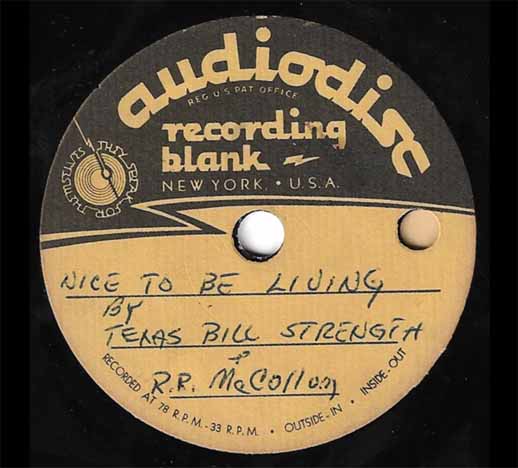
On November 22, 1953, TBS promoted a “Hillbilly Jamboree” at Atlanta’s Municipal Auditorium. Homer and Jethro headlined the bill and there was a capacity crowd. Also featured were:
- Mac Wiseman
- Bonnie Lou
- Jimmy Skinner
- Swingbillies
- Las Vegas Seven
- Tom Gibson
- Warren Roberts
(Billboard, November 21 and December 5, 1953)
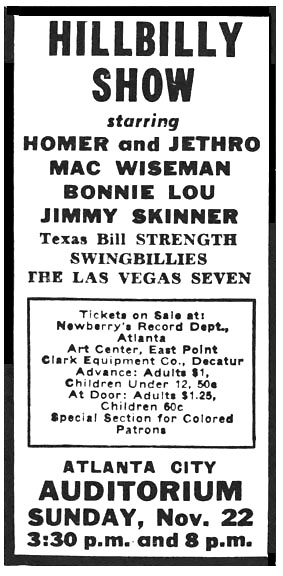
Atlanta Journal, November 15, 1953
Another cool ad for a gig at the Rhythm Ranch. These appearances came with some regularity, at least through mid-December 1953, with Bill Drake listed at the top of the bill.
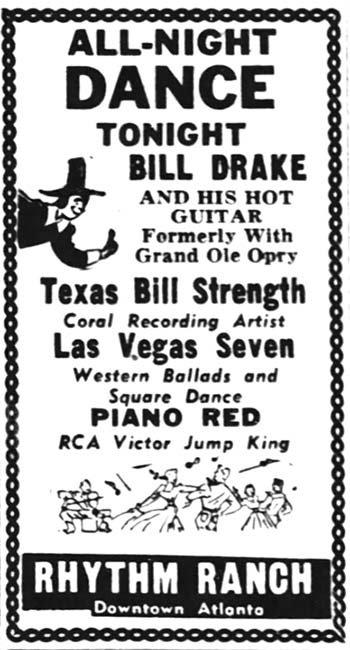
Atlanta Constitution, November 25, 1953
December 1953
December 5, 1953, ad in Billboard:
TEXAS BILL STRENGTH
CORAL
Radio Affiliation, Live Show: WEAS, Atlanta; As DJ: Same
Instrument Played: Guitar
Personal Manager: Bill Keller, 217 West Ponce De Leon Ave., Decatur, Georgia
Booking Office: Stars, Inc., Candler Bldg., Atlanta
Favorite Record, Own: “It’s a Shame;” Other: “May the Good Lord Bless and Keep You”
No. Personal Appearances per Month: 12
Speaking of Coral, it appears that TBS had four songs that he had pitched to his record company but they didn’t want him to record them, so he made an acetate of them, hoping someone else would record them. The songs are:
- “My Ray of Sunshine”
- “I’m So Happy I Could Cry” (the opposite of “I’m so Lonesome I Could Cry”)
- “If I Didn’t Love You” (written by his wife Dorothy)
- “Little White Church”
This acetate has fortunately made its way back into the hands of the Strength family, thanks to a generous collector.
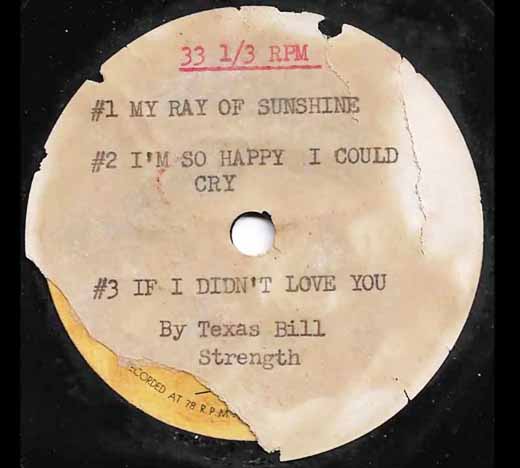
CORAL RECORDS
In December 1953, Coral appears to have dropped several of its C&W artists to concentrate on just a few. TBS survived the cut. The strategy was to issue fewer releases and promote them more vigorously. (Billboard, December 26, 1953)
Coral Records is entering the country and western field with a regular release schedule. Initially, releases will be pushed out at the rate of three and four records per month, according to A&R topper Bob Thiele … Thiele has appointed Johnny Thompson to head up the Coral C&W operation in Nashville… Thompson opened Coral’s Cincinnati and Atlanta branches. He has pruned Coral’s C&W roster to three artists – Tommy Sosebee, Texas Bill Strength and Tabby West. He is negotiating with two name artists.
(Billboard, December 5, 1953)
A two-hour “hillbilly show and dance” was presented at the Sports Arena in Atlanta on December 17, 1953, under the auspices of the National Association of the Handicapped. The Atlanta Constitution reported that all proceeds from the show would be used to assist “physically handicapped persons who have lost one or more members of their body or who have been disfigured and are unable to obtain normal employment.” A list of performers, culled from the Atlanta Constitution, the Atlanta Journal, and Billboard, included:
- TBS
- Peachtree Cowboys
- Kenny Lee
- Romeo Brinkley’s Cain Street Cowboys
- Leon Beavers and his Las Vegas Seven
- Slick and Greasy
- Armand Herron
- Tom Gibson from WATL
Prizes donated by Atlanta merchants were distributed, with the shindig drawing to a close with a dance by Ray Rice and His Rhythm Aces.
(Atlanta Journal, December 16, 1953; Billboard, January 9, 1954)
HILLBILLY BALL
A Hillbilly Ball was held at Atlanta’s Municipal Auditorium on December 22, 1953, and “went on til Milkin’ time” with:
- Jack and Frances Holden
- Boots Woodall
- Smith Brothers
- TBS
- Kenny Lee
- Jimmy Smith
- Peachtree Cowboy
- Uncle Eb Brown
- Tom Gibson
- Leon Beavers
- Warren Roberts
- David Jones
- Tom Lowe
- Tom Noland, and
- Cuzzin’ Lem
(Billboard, January 9, 1954)
Another Hillbilly Ball was held on New Year’s Eve, 1953, at the Atlanta Municipal Auditorium. The Atlanta Journal claimed that the Ball, at $1 a person, was the biggest New Year’s Eve celebration at the price in Atlanta. (December 24, 1953) Entertainers included:
- TBS
- Rocky Porter and the Rockettes
- Jack Holden and the Still River Boys
- The Peanut Stompers
- Uncle Eb Brown, R.L. MCoy, square dance caller
The action started at 8:30 and continued till milkin’ time.
No dates were given, but in the Spring 1954 issue of the Houston Star, Bill reported that he had show dates in
- Memphis
- Birmingham
- Dayton
- Cincinnati
- He had also appeared with Ernest Tubb on his Midnight Jamboree show over WSM in Nashville.
1954
January 1954
The Atlanta directory listed TBS as an announcer on WEAS in Decatur, living at 124 Jewel.
Folk talent galore played host to the March of Dimes at Atlanta’s Tower Theater [late January, 1954]. Among those participating were:
- The Smith Brothers
- Boots Woodall
- Pat Patterson
- Little Brenda Tarpley
- Jon Farmer
- Bill Lowery
- John Carroll and Little Donny
- TBS
- Bobby and Mack Atchinson
- Jerry Howell
- The LaFatterairs
- Jack Holden
- Kenny Lee
- Tom Gibson
- Romeo Brinkley
(Billboard, February 6, 1954)
TBS was a featured performer at a Big Round and Square Dance at the Alabama National Guard Armory in Birmingham on January 30, 1954. Also on the bill was Kenny Lee. The dance was sponsored by radio station WVOK.
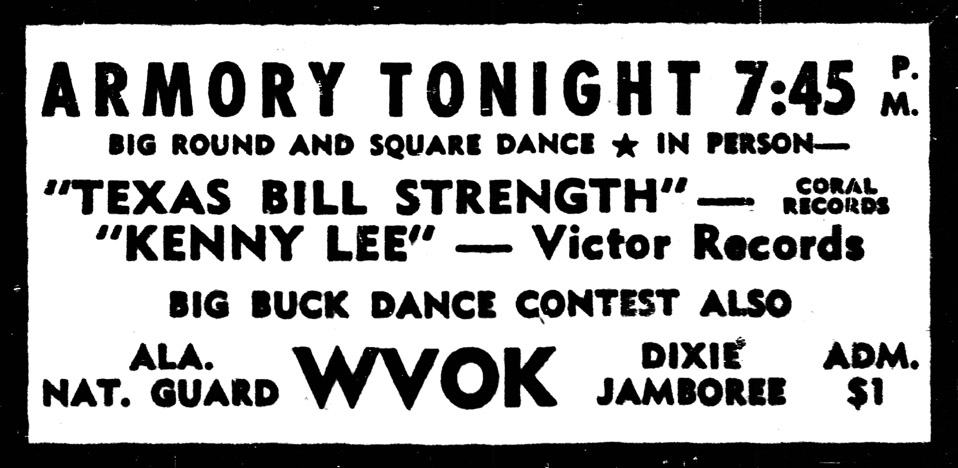
Birmingham Post Herald, Saturday, January 30, 1954 On January 26, 1954, Bill played a Sunday show with Fuzzy “St. John,” so reported the Spring 1954 Houston Star.
February 1954
On February 14, 1954, TBS had a 22-minute interview with DJ Marty Roberts over WCKY, Cincinnati. Both sides of his Coral record were played. (Houston Star, Spring 1954)
WEAS, Decatur, Georgia, is going to 50,000-watt strength in February, with TBS and Jack Holden handling the disk jockey chores. (Billboard, January 16, 1954) TBS was holding up the 11 am to 12:30 pm and 5:45 to 6:45 slots, Monday through Friday.
March 1954
TBS guested on Marty Roberts’ WCKY, Cincinnati, show recently. (Billboard, March 6, 1954)
April 1954
CORAL RECORDS
On April 8, 1954, TBS and Tabby West (nee Phyllis Spain) recorded two sides on Coral. This would be the sixth recording session on Coral.
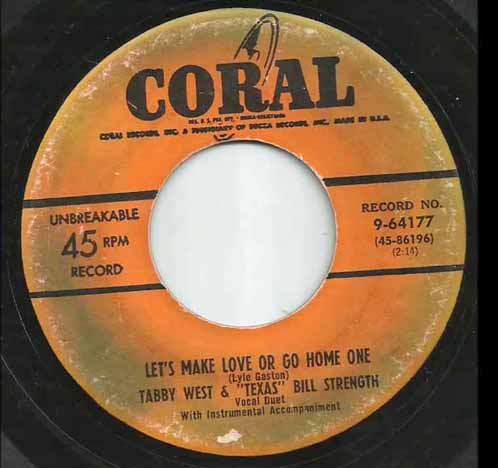
“Let’s Make Love or Go Home” 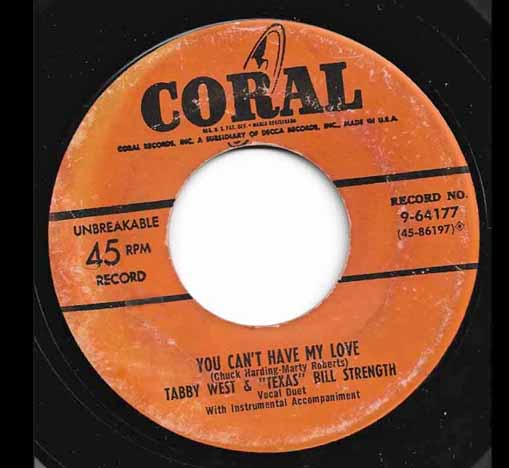
“You Can’t Have My Love” Coral 64177 was released in June 1954 and reviewed in Billboard on July 3, 1954:
- “Let’s Make Love or Go Home” – Tabby West and TBS team up for a saucy reading of a happy novelty effort. Side is cheery, and it could get spins.
- b/w “You Can’t Have My Love” – Old-fashioned opus is sparked by the vocal of the thrush and the sweet-talk of chanter Bill Strength.
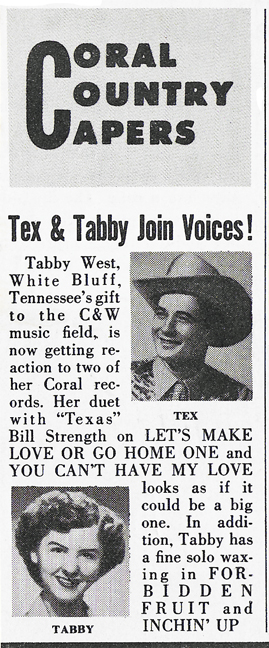
Article courtesy Dale Strength
SILVER SLIPPER
TBS’s ownership of his night club, the Silver Slipper, was about to come to an end, but he still had an interest in it in 1954, as evidenced by the following ad from the Atlanta Journal (April 30, 1954):
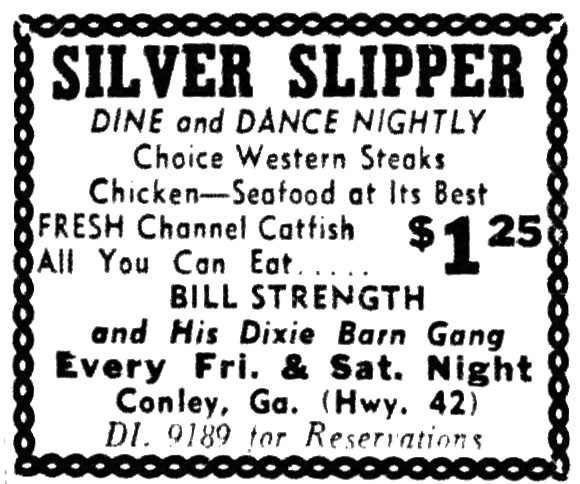
May 1954
The Nashville Banner reported that Tabby West and TBS completed another Coral recording session on or before May 7, 1954 (the date of the article). The titles were due for a rush release, according to Coral execs. As far as we know, the sides were never released. The were:
- Forbidden Fruit
- Inchin’ Up
On May 15, 1954, TBS and Jimmy Skinner played the Midway Jamboree in Gadsden, Alabama, with Lee Bonds, Little Rita Faye, and others.
On May 16,, 1954, Curtis Gordon and TBS promoted a show at the East Point, Georgia, Auditorium, with Autry Inman, Jimmy Skinner, Little Rita Faye, and many others. (Houston Star, Summer 1954)
The second annual Jimmie Rodgers Memorial celebration took place on May 25 and 26, 1954, and Bill was looking forward to promoting his latest releases, “Country Love” and “Alone,” reported the Houston Star.
The ad below for TBS and WEAS radio appeared in the Spring 1954 edition of the Houston Star. He had worked for WEAS since April 1952.
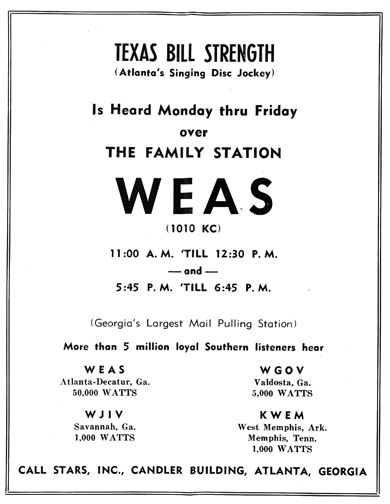
June 1954
TBS appeared on the cover of the June 1954 issue of Cowboy Songs, and was one of three artists featured in the issue.
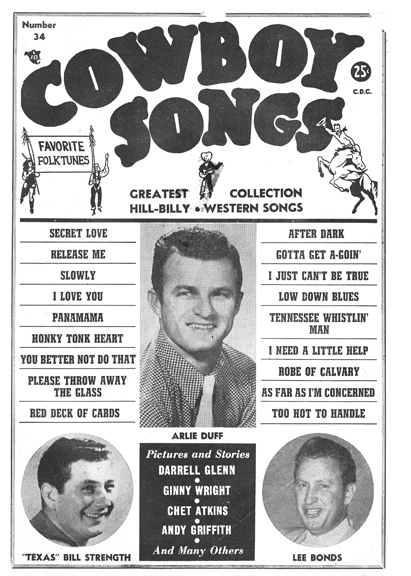
TBS was still having fun at the Silver Slipper, apparently.

Atlanta Journal, June 11, 1954 The Houston Star (Summer 1954) named his Melody Ranch Boys to be:
- Buddy Pattilo, fiddle
- Jimmy Estes, electric bass
- Lamar Hawkins, electric guitar, drums, and mandolin
- Shorty Boyd, steel guitar
- Terry O’Neal, rhythm guitar
The Melody Ranch Boys were also heard daily at 7:15 pm over WEAS.
TBS was apparently teaming up with Jimmie Skinner to do some one-nighters.
On June 12, 1954, Billboard reported that the two did a show at La Grange, Georgia.
Then on June 18, the Nicholasville, Kentucky News Week advertised a stage and screen show, with stage shows at 3:45, 7:45, and 9:45. The movie was “Tennessee Champ.”
Summer 1954
A summer 1954 article in Country Song Roundup‘s Fifth Anniversary Issue which featured spotlights on disc jockeys from around the country offered the reader some quotes attributed to Texas Bill that give us perhaps some insight into music and his career:
Since I began singin’ about ten years ago, I have always felt that Country music was a part of my life. I have taken it for granted that it is the only business that I should be in. Within these ten years, I have been associated with many types of people who tell a story. Some tell their story in a speech, others in books, and yet, there are people who can better tell a story in song. … and I guess that’s why I’ve been inspired to since my boyhood, to tell my story in a song.
In addition to music being a part of my daily life, I think it is one of the most gratifying things that could ever happen to an artist. Why? Because when I make other people happy with a song, either on a show date or by playing records on my D.J. shows, I feel that I am reaching my goal—I’m living Country Music!
July 1954
TBS played a string of 10 dates in Ohio, Kentucky, and Indiana with Jimmy Skinner recently. (Billboard, July 17, 1954)
Hank Snow, the Smith Brothers, and TBS played to 15,000 music and baseball fans in Atlanta last week. (Billboard, July 24, 1954)
August 1954
George Riddle, 18-year-old country DJ at WMRI, Marion, Indiana, had TBS and Lonzo and Oscar as guests recently. (Billboard, August 21, 1954)
TBS, WEAS, Decatur, Georgia, continues with his name act policy at his Silver Slipper there. (Billboard, August 28, 1954)
September 1954
MEMPHIS
In September 1954, TBS was moved to Memphis where WEAS had a sister station, KWEM, in West Memphis, Arkansas. He formed a new band, the Swingsters, and played two nights a week in a club at 5100 Summer Ave. in Memphis. (Ronnie Pugh)

KWEM Letterhead courtesy Dale Strength It was the same time that Elvis, Johnny Cash, and Sun Records were discovering rock ‘n’ roll, and Memphis was an exciting place to be. Bill had so many personal appearances in the Memphis area and around the country, that it was amazing that he could keep his DJ job at the same time, but he stayed at KWEM from September 1954 until he moved to Minnesota in November 1955.

TBS AND ELVIS
An article called “Elvis Before Sun” (Examiner.com) by an unknown author dated October 12, 2010, posits that in September 1954, when TBS was moved to station KWEM in West Memphis, he became friends with Elvis Presley, and Elvis appeared live on KWEM Radio twice in 1954 before he signed with Sam Phillips at Sun Records. In one of those performances, he sang with Johnny Burnette and the Rock n’ Roll Trio. Scotty Moore and Bill Black, who played on Elvis’ Sun releases, appeared live on KWEM in 1954 with their first band, the Starlite Wranglers. Elvis performed with the Starlite Wranglers, who also released their own record on the Sun label.
Elvis’ high school friend, George Klein, started working at KWEM at about the same time that Elvis released his first Sun record in 1954. George started at KWEM part-time before moving into mornings and seeing his first ratings success there, before moving on to WMC and then WHBQ in Memphis.
Legend has it that Elvis walked into Sun Studios to record a song for his mother but that doesn’t seem to be the case. No doubt he did go to Sun to record a song for his mother, but Sam Phillips most likely heard Elvis first on KWEM.
Many of the artists Sam signed he heard first on KWEM, including B.B. King, Howlin’ Wolf, Ike Turner, Stan Kessler, Smokey Joe Baugh, Paul Burlison, Barbara Pittman, Jean Chapel and the Miller Sisters.
Could it be that TBS gave Elvis his first radio exposure before the legendary Dewey Phillips discovered “That’s All Right,” played it incessantly on his program on WHBQ on July 8, 1954, and was given credit for putting Elvis on the radio for the first time?
Unfortunately, the theory doesn’t hold water when looking at the calendar. If TBS didn’t start working at KWEM until September 1954, and Dewey Phillips played the record in July… whoops! Nevertheless, TBS and Elvis did become lifelong friends, and both recorded at Sun Studios.
Another side note about Bill and Elvis and all of the musicians who recorded at Sun Studios. Dorothy said it was only then that Bill started to have a bit too much fun, stay out too late, drink too much, and get into habits that would prevent him from becoming reliable enough to fulfill his dreams.
“TBS will be Mr. Disc Jockey on the September 10 show from WSM, Nashville.” (Billboard, September 4, 1954) Ronnie Pugh reported that a large contingent of his fan club crowded the WSM studios for the event.
Marty Roberts, platter spinner at WCKY, hopped into Atlanta for an appearance at TBS’s Silver Slipper Club. (Billboard, September 11, 1954)
On September 17, 1954, TBS played Sleepy-Eyed John’s Eagles Nest with Webb Pierce and the Wilburn Brothers. (Billboard, October 2, 1954)
HANK WILLIAMS DAY IN MONTGOMERY
September 20 and 21, 1954, marked the second observance of Hank Williams Memorial Day in Montgomery, Alabama. The first Hank Williams Day was arguably March 31, 1953, although it did not appear to be a gathering but a memorial held by radio stations. Williams died on January 1,1953.
This second Hank Williams Memorial Day drew more than 200 C&W DJs and performers to Montgomery. The event was sponsored by the Alcazar Temple of the Shrine. The event was highly publicized in the Montgomery Advertiser-Alabama Journal.
An early article advertising the event prominently featured TBS’s photo and bio on the front page:
To take a brief sampling might here give you some idea of the variety of talent already scheduled.
Start with Texas Bill Strength. Former star of a Texas network and a chain of 126 other stations, he now has turned disc jockey. He has three daily DJ shows over 50,000 watt WEAS in Decatur, Ga. Additionally he has a swing-band, the Melody Ranch Boys, and his own club, the Silver Slipper, near Atlanta. (August 29, 1954)
TBS was described as coming to the event from Houston, and whose latest recording, “You Can’t Have My Love,” was becoming a nation-wide hit.
The itinerary was as follows:
Monday, September 20: This evening was dedicated to performances by artists from Williams’ home state of Alabama.
Late Monday afternoon, a group of performers entertained some 200 GIs at the Maxwell Air Force Base hospital with a 30-minute impromptu show.
This was followed by a huge free show to about 8,500 people at the recently-opened Normandale shopping center, where special honors were given to Hank Williams’ mother, sister, and his widow, Audrey. A life-sized portrait of Hank was presented to his mother.
A combined crowd of about 2,800 attended three dances held Monday night at Fort Dixie Bibb Graves Armory, the Alcazar Shirne Temple, and the City Auditorium, with the various artists doubling between the three spots..
Tuesday, September 21:
Delegates journeyed to Oakwood Annex Cemetery to place a wreath on Williams’s grave.
TBS and his band paid a visit to the grave of Hank Williams in Montgomery.
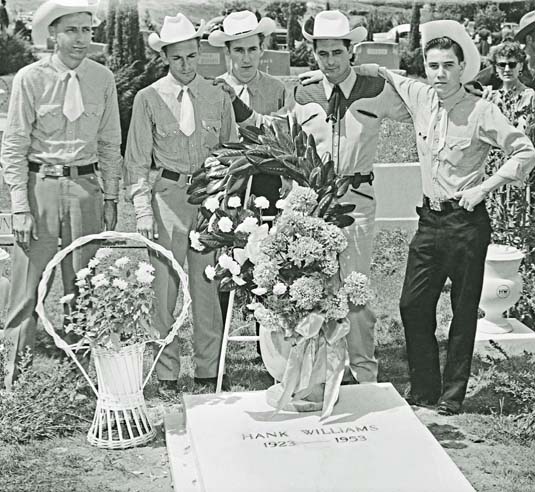
Photo Courtesy Dale Strength
There was a huge parade featuring Governor-Elect Big Jim Folsom, witnessed by an estimated 60,000 people. It took an hour for the parade to pass a given point.

Climaxing the event was the headliner show at the Cramton Bowl, seen by about 8,500 people. Tennessee Governor Frank Clement was the principal speaker. Audrey and her children Lycrecia and Hank Jr. unveiled an 11 foot marble monument of Williams which was to be placed on his grave. (Billboard, October 2, 1954)
On September 25, 1954, TBS did a “Youth for Christ” charity show with Roy Rogers, Dale Evans and the Sons of the Pioneers. (Billboard, October 2, 1954)
October 1954
TBS, who recently transferred from WEAS, Atlanta, to KWEM, Memphis, is doing a three-hour deejay stint daily plus a 15-minute live show. (Billboard, October 2, 1954)
TBS will appear at his own nitery, the Silver Slipper, Atlanta, on October 9, 1954, with his Melody Ranch Boys. (Billboard, October 9, 1954)
Elvis Presley, with his guitar and bassmen, Scotty and Bill, made an appearance recently at TBS’s nitery [The Silver Slipper] in Atlanta. (Billboard, October 23, 1954)
TBS, still featured on KWEM, Memphis, played his own Silver Slipper nitery, Atlanta, on October 30, 1954, and then embarked on a string of personals that will keep him busy for some time. (Billboard, November 13, 1954)
November 1954
On November 6, 1954, TBS played the “Barnyard Frolics,” Little Rock, with Sammy Barnhart (Okeh). (Billboard, November 13, 1954)
On November 13, 1954, TBS played Birmingham. (Billboard, November 13, 1954) While in Birmingham, TBS guested with Joe Rumore and Dan Brennan at WVOK, Buddy Starcher at WLBS, and Uncle Jim Atkins at WBRC. (Billboard November 27, 1954)
On November 13, 1954, Billboard polled C&W artists to determine which disk jockeys were doing the best job promoting their music. TBS was tied with four others at Number 50 out of 55; his station was listed as KWEM.
On November 15, 1954 TBS appeared in Sheffield, Alabama, with Webb Pierce and Red Sovine. (Billboard, November 13 and 27, 1954)
On November 16, 1954, TBS, Webb Pierce, and Red Sovine appeared in Ripley, Mississippi. (Billboard, November 13 and 27, 1954)
On November 17, 1954, TBS appeared with Webb Pierce, Red Sovine, Bob Neal, and “Many More!” in a Great Two-Hour Jamboree at the Catholic Club Auditorium in Helena, Arkansas.

Helena Daily World, November 16, 1954
On November 18, 1954, Webb Pierce and Red Sovine again headed the bill for another two hour jamboree in Owensburg, Kentucky. Audrey Williams was also on the show, plus one of the Wilburn Brothers.
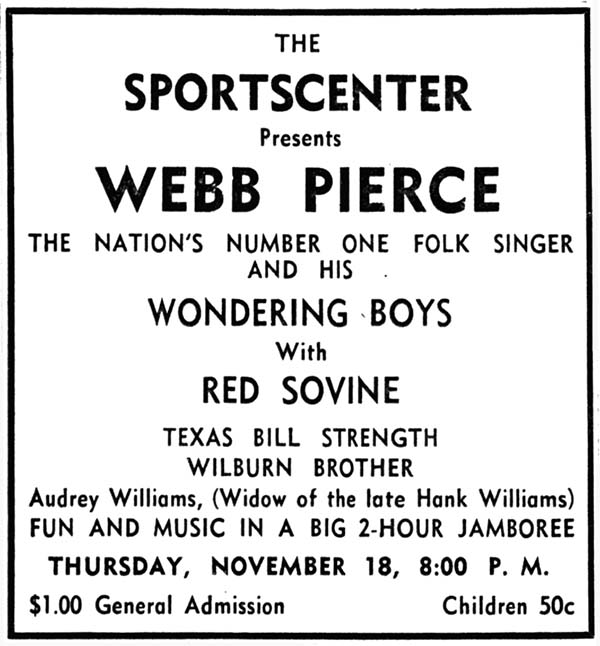
Owensboro, Kentucky, Messenger, November 18, 1954
In November 1954, TBS was scheduled to attend the deejay conclave in Nashville. (Billboard, November 13, 1954)
In late November 1954, TBS was scheduled to play the Roosevelt Lounge in Detroit. (Billboard, November 13, 1954)
On November 28, 1954, TBS was on the bill for a Stars of the Grand Ole Opry package show at the Memphis Auditorium. The show also included:
- Johnnie and Jack
- Kitty Wells
- The Tennessee Mountain Boys
- Cousin Nimrod
- Sonny James
- Chuck Reed
- Bud Deckleman
- Tiny and the Eagles
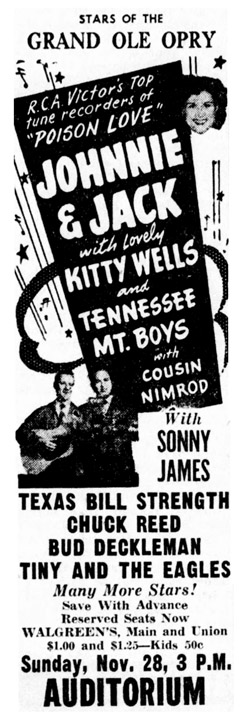
Memphis Press Scimitar, Wednesday, November 24, 1954
December 1954
On December 8, 1954, TBS, Elvis, and the Parker Bros. Band performed at the P&G car lot in West Memphis, Arkansas. This ad was quite a remarkable find by Dale!
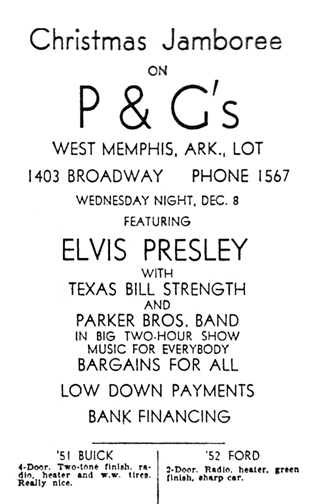
Ad courtesy Dale Strength
Here’s another one, with a fun admonition from Elvis at the bottom:

Memphis Press Scimitar, Tuesday, December 7, 1954
On December 23-25, 1954, TBS played Houston and then hopped back to Memphis to resume his chores at KWEM there. (Billboard, January 8, 1955)
One of those appearances was in the ad below, and was also mentioned in Charlie Evans’ “Night and Day” column in the Houston Chronicle. Evans: “Special guest will be Texas Bill Strength, who has been hitting the big-time shows through the South.”
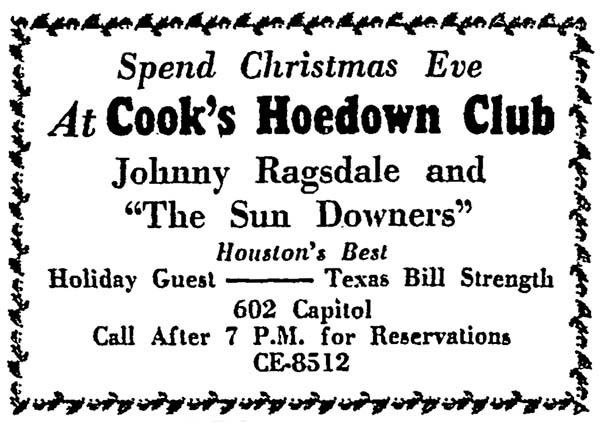
Houston Chronicle, December 23, 1954
Here is another Christmas appearance; in 1954, December 25 fell on a Saturday night.
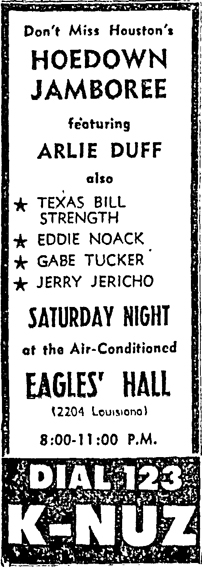
Houston Chronicle, December 25, 1954
1955
January 1955
TBS is set to play a string of dates with Jim Edward and Maxine Brown and Elvis Presley after the first of the year. (Billboard, January 8, 1955)
TBS played a place in Memphis called the Palms in mid-January 1955.

Memphis Commercial Appeal, Saturday, January 15, 1955
On January 29, 1955, TBS was a guest on “Grand Ole Opry” with Faron Young. (Billboard, February 12, 1955)
February 1955
On February 5, 1955, TBS appeared on the “Ernest Tubb Jamboree” on WSM, Nashville. (Billboard, February 12, 1955)
TBS was the feature on “Barnyard Frolic” over KLRA, Little Rock. (Billboard, February 12, 1955)
March 1955
TBS visited the country deejays in Birmingham and Atlanta last week after winding up on a chain of 14 theaters in Arkansas and Mississippi. (Billboard, April 2, 1955)
Spring 1955
In the Spring 1955 issue of the Houston Star, TBS was pictured with “White Flash,” an Arabian Stallion. In the Summer 1954 issue there was an ad for a place called the Poney Ranch, so it was probably taken there.
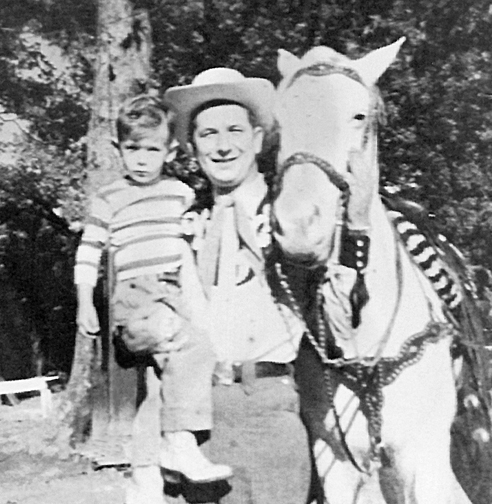
Young Dale with his Dad and White Flash. Photo courtesy Dale Strength and Houston Star, Spring 1955. 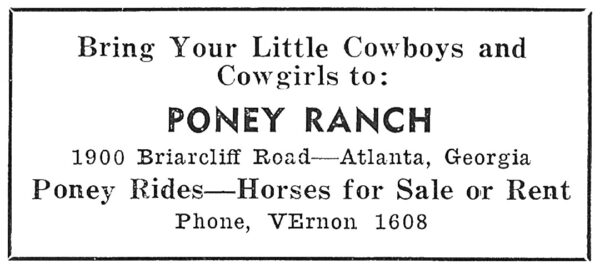
Houston Star, Summer 1954
May 1955
THE DEATH OF BROTHER CHARLIE
On May 1, 1955, TBS flew to Houston to attend the funeral of his 19-year-old youngest brother, Charles E. Strength, who passed away on April 30, 1955, in Pasadena, Texas. Charlie was a 19-year-old student at the time. Although TBS reported to Billboard that he died from an auto accident (Billboard, May 14, 1955), in truth, Charlie committed suicide. In an interview with his mother Dorothy, Dale discovered that Charlie had often spoke of killing himself, although she wasn’t sure of the reason. TBS and Dorothy had tried to get Charlie to live with them in Atlanta, but his mother didn’t want him to.
Below is a photo of Charlie, taken just before he passed.

Photo courtesy Dale Strength 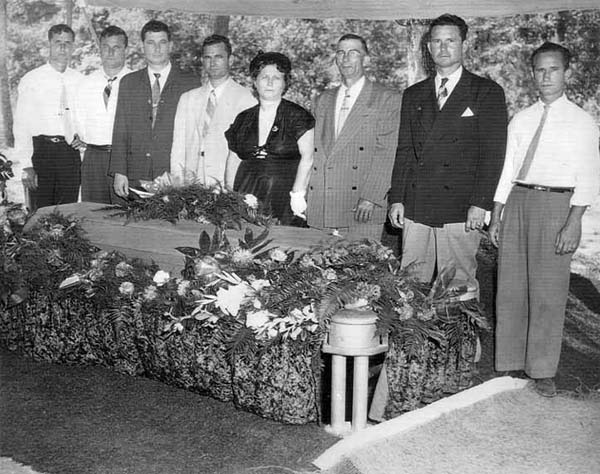
The Strength family at Charlie’s funeral: James, Albert, Bill, Edward, parents Jessie and WT, Gene, and Fred. Arthur (“Pete”) is not pictured. Photo courtesy Dale Strength In the photo above, the story of Eugene, Jessie’s first son, is pretty clear, since he is nearly a foot taller than the rest of the Strength boys. TBS is probably the tallest of the Strength brothers, at either 5’ 8” or 5’ 9” (depending on the source). Eugene’s military registration card wasn’t found on Ancestry.com, which is a good source of height and weight, but the photo seems to show that his father must have been bigger than William T. Strength, Sr.
The absence of brother Arthur (“Pete”) is explained by the fact that on June 5, 1950, he began a six-year sentence at Huntsville prison for stealing a motorcycle in New Orleans and driving it to Houston. He had been working as a messenger boy in Houston, and was convicted at the tender age of 18. Dorothy’s mother, “Big Momma,” helped him get paroled, but not in time for the funeral.
On May 13, 1955, TBS was set to embark on a 14-day tour of one-nighters thru Texas, Colorado and California. The trek forced Strength to miss the Jimmie Rodgers Memorial Day celebration in Meridian, Mississippi, May 25-26. (Billboard, April 2, 1955) [Later on Billboard says that he did make it.]
On May 16, 1955, TBS appeared with Curly Fox and Biff Collie over KPRC-TV, Houston. (Billboard, May 21, 1955)
From May 19-24, 1955, TBS was set on swing that’ll carry him from Port Isabell, Texas, to Mexico City. (Billboard May 21, 1955)
On May 21, 1955, TBS was on KWEM, West Memphis, Arkansas. He had recently been signed to Capitol Records in Hollywood. He also signed with Hollywood agent Bobbie Bennett. (Billboard, May 21, 1955)
Bennett was a Hollywood agent who had worked with Spade Cooley. She helped him find guest spots on several major shows while he was on the West Coast during the summer of 1955.
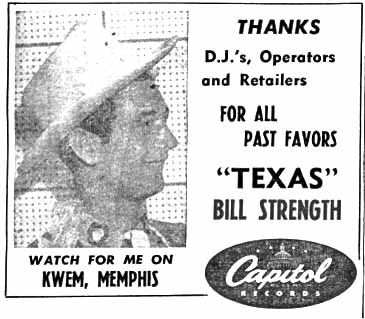
The Spring 1955 issue of the Houston Star reported that TBS had been a guest of Carl Smith on the Grand Ole Opry lately.
SOJOURN TO HOLLYWOOD
Following the Jimmie Rodgers Celebration in Meridian, Mississippi on May 25-26, 1955, TBS headed back home to Memphis to reload another suitcase and then hit out for the West Coast and a Capitol Records session. (Billboard, June 11, 1955)
On May 28, 1955, TBS was scheduled to appear in the feature slot on the “Big D Jamboree” in Dallas. (Billboard, May 21, 1955) (With Slim Whitman, (Billboard, May 28, 1955) (With Arlie Duff, (Billboard, June 4, 1955)
June 1955
On June 14, 1955, TBS pulled a packed house to the Ritz Theater, Parkin, Arkansas, with the result that he was held over the following night. (Billboard, July 2, 1955)
Somehow, between June 14 and June 25, 1955, according to this timeline, TBS made it from Arkansas to Hollywood. He was back in Memphis on July 4.
On June 25, 1955, TBS does a stint on Cliffie Stone’s “Hometown Jamboree” in Hollywood. (Billboard May 21, 1955).
July 1955
On July 4, 1955, TBS was booked to emcee the “Grand Ole Opry” package to be presented at Russwood Ball Park, Memphis, sponsored by the local chapter of the Cerebral Palsy Fund. The show was promoted by Elmer Yates. The lineup included:
- Ernest Tubb
- Goldie Hill
- Faron Young
- Wilburn Brothers
- Marty Robbins
- Carter Sisters
- Rod Brasfield
- Minnie Pearl
- Sleepy-Eye John of WHHM
(Billboard, May 21, 1955)
On July 22, 1955, TBS (Capitol) had an engagement at the Coldwater Theater, Coldwater, Mississippi. Afterwards he headed for the West Coast, where he’s booked thru August 1 by the Bobby (sic) Bennett Agency, Hollywood. (Billboard, July 30, 1955)
Can you drive from Mississippi to Arkansas in one day?
RED FOLEY – July 23, 1955
TBS was tentatively set to appear with Red Foley’s TV network show June 18. (Billboard, May 21, 1955)
TBS has had his guest appearance on Red Foley’s “Ozark Jubilee” ABC-TV network show shifted to July 23. (Billboard, July 2, 1955)
En route [from Mississippi on July 22, ] TBS stopped off in Springfield, Missouri, Saturday (23) for an appearance on Red Foley’s “Ozark Jubilee.” (Billboard, July 30, 1955)
En route to the West Coast, Strength guested on the Ozark Jubilee. (Billboard, August 17 and 27, 1955)
Now Bill had from July 24 to July 29 to make it from Missouri to Los Angeles for his Capitol Records recording session.
Ronnie Pugh wrote that he drove 135 miles between Tulsa and Oklahoma City to visit Hank Thompson. And then he drove the rest of the way to Hollywood across the desert with the top down.
CAPITOL RECORDS
On July 29, 1955, TBS had his first Capitol recording session. He recorded four sides:
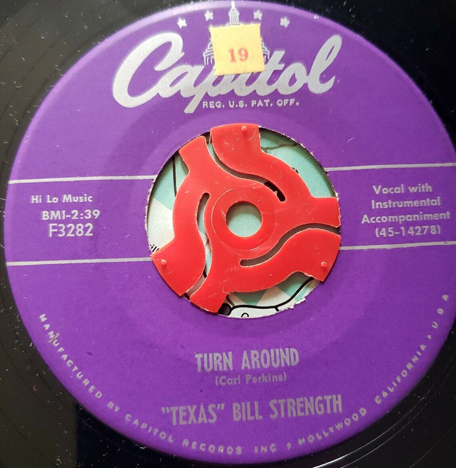
“Turn Around“ 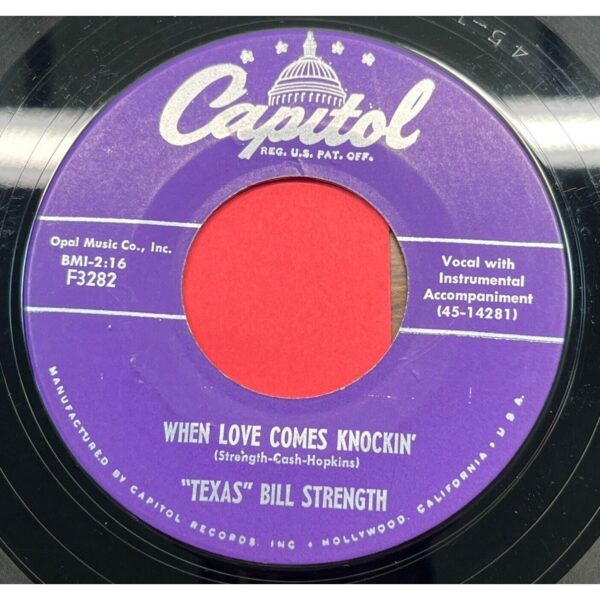
“When Love Comes Knockin’“ – written by TBS, Cash, Hopkins Capitol F3282 was released in November 1955, and was reviewed by Billboard on November 12, 1955:
- “Turn Around” – “A strong country ballad with a good melody line and effective lyrics. Texas Bill gives a fine performance. Will get strong deejay action.”
- b/w “When Love Comes Knockin’” – “Fine country rhythm side, belted out in great fashion by Texas Bill, to a lively backing featuring strings and honky tonk piano. Watch it.”
“Turn Around” was included on a Record List on an ad by McLean’s Records in the Newport News Daily Press, published on December 2, 1955.
An unusual independent review of this record was found in the Wichita Eagle, published on January 8, 1956:
- Texas Bill Strength has strength in the vocal lines of “Turn Around.” His drawling voice presents a love song of the usual pickin’ and singin’ style. Piano, violin and steel guitar keep the background lively. A movable harmony between instrumentalists is notable.
- “When Love Comes Knockin’” is on the other side and on this one Texas Bill had a hand in the composition. A slappy, happy bit, it has some hot solo by violin and fast fingering on the piano part while the whole features jump rhythm and a hoedown tang.
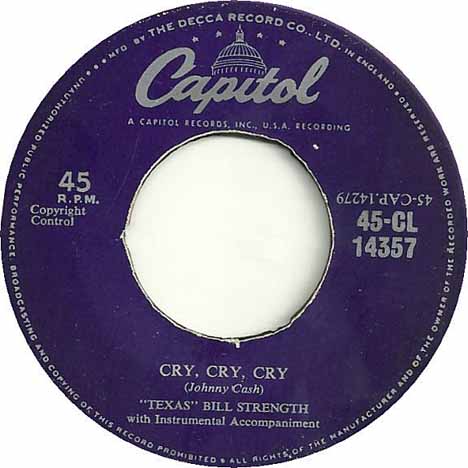
“Cry, Cry, Cry,” written by Johnny Cash 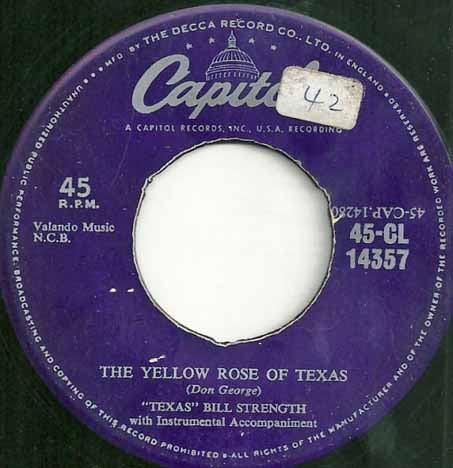
“Yellow Rose of Texas” CRY, CRY CRY/YELLOW ROSE OF TEXAS
Judging from the record numbers, Capitol must have released “Cry, Cry, Cry” (F3217) b/w “Yellow Rose of Texas” first, although we have no release date or Billboard review. The Los Angeles Times reported on the release of “Yellow Rose” on August 11, 1955. The story of the record is interesting:
Wikipedia reports that Johnny Cash was signed to Sun Records in 1954 and brought Sam Phillips the song “Hey Porter,” which he had written while in the Air Force. He was told to come back with a more commercial song, and overnight he wrote “Cry! Cry! Cry!” His first record featured “Hey Porter” as the A side and “Cry, Cry, Cry,” as the B side. The latter entered the Country charts at No. 14. It was standard at the time for other artists to immediately cover songs.
Ronnie Pugh speculated that TBS may have been the first artist on a major label to record a song written by Johnny Cash. Below is an excerpt from a TBS’s “Down Memory Lane” column that he wrote for Upper Midwest Country & Western News Scene magazine, published in September 1973:
I like to remember the first day I met Johnny. In the summer of 1955, I was doing my daily DJ show when Johnny walked into the studios of KWAM (sic) in [West] Memphis, very much unknown to anyone … He talked to our station manager and made a tape of a few of his songs … which were later to be recorded for Sam Phillips and the Sun label … A few weeks later, I had the pleasure of being the first DJ to play the first Johnny Cash record, “Hey Porter” … Since my show was made up of requests, the mail began pouring in for Johnny Cash records. John was a top mail puller and soon became the hottest artist on the turntables all across the nation. Before making his first recording, Johnny had been an appliance salesman in Memphis.
I had just been signed by Capitol Records at the time, and I flew to Hollywood and recorded his “Cry, Cry, Cry” … I knew it was a hit song and was hoping to reap some of the sales gravy. The big wheels at Capitol agreed it was a hit … I recorded it on Friday morning and the following Tuesday the D.J. samples were shipped from Capitol’s pressing plant … A rush release … and even though I was on a major label, I still couldn’t compete with the Johnny Cash record of “Cry, Cry, Cry” …
Luckily, I had “The Yellow Rose of Texas” on the flip side, so they turned it over and made “Rose” the push side; and as a result, John and I both had a hit.
The letter below appears to have been sent to a fellow disc jockey, gently urging him to keep spinning “Cry, Cry, Cry.”
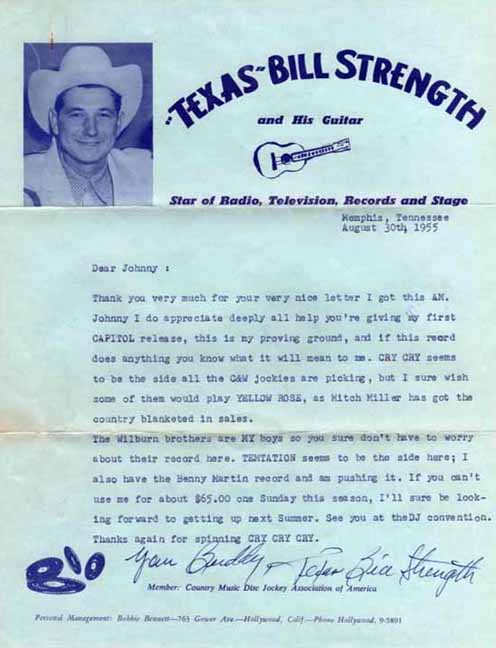
August 30, 1955, Memphis. Image courtesy Dale Strength
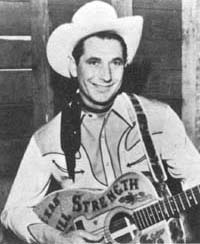
Photo courtesy Dale Strength 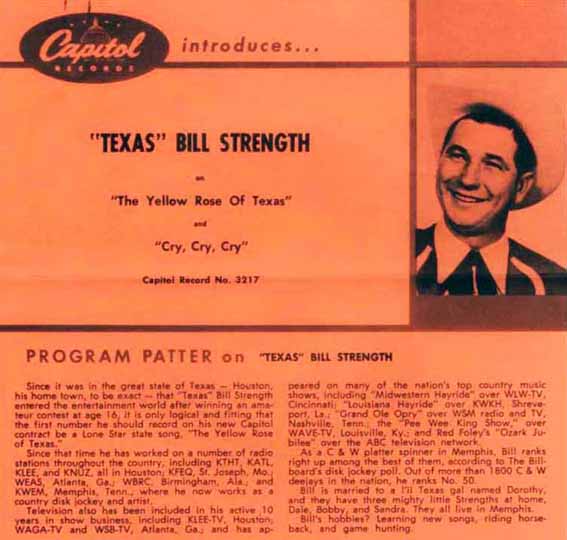
On Saturday, July 30, 1955, TBS appeared on Spade Cooley’s TV show, KTLA-TV, Hollywood. Bill has just taken delivery on a new 45-foot, air-conditioned house trailer, a new ’55 benzine buggy. (Billboard, July 30, 1955)
An undated list of “Recent Appearances” notes that TBS had appeared on the Spade Cooley Show twice.
During his recent trek to Hollywood for the Capitol session, Strength made a successful screen test, with negotiations under way to spot him in a Western feature soon. (Billboard August 20, 1955)
August 1955
On the Coast, TBS:
- Visited with Tex Ritter and Wade and Stuart Hamblen
- Appeared on “Town Hall Ranch Party,” KTTV in Hollywood, with Ritter, Johnny Bond, Wesley and Marilyn Tutt and Freddie Hart
- Appeared with Jolly Joe Nixon and Cliffie Stone over KXLA, Pasadena
- Appeared with Hank Penny and Sue Thompson at Riverside Rancho
(Billboard, August 27, 1955)
OVERTON PARK SHELL, MEMPHIS
On August 5, 1955, TBS appeared on Bob Neal’s eighth and last “Anniversary Jamboree” at the Overton Park Shell in Memphis. Just as Elvis had made his first professional performance at the 1954 event and blown the 4,000 people in the audience away, in 1955 it was Johnny Cash’s time to shine. Hear TBS’s announcement of the show that he made the day before, on his radio show HERE.
- Webb Pierce
- Elvis Presley, Scotty and Bill
- Wanda Jackson
- Bud Deckleman
- Johnny Cash
- Sonny James
- Red Sovine
- Jim Wilson
- Charlie Feathers
- The Neal Boys

Memphis Press Scimitar, August 6, 1955 Dick Stuart, WMPS Memphis, wrote to Billboard that “The biggest country show ever to play Memphis pulled a record-breaking crowd of over 4,000 people to the Bob Neal ‘Eight Anniversary Jamboree’ at Overton Park Shell.”
The performers “kept the crowd on the edge of their seats for well over three hours, despite threatening skies. On the Neal anniversary one year ago, Elvis Presley made his debut, and was a sensation. This year Johnny Cash broke thru as the outstanding new act in Memphis. I’m handling him.” (September 17, 1955)
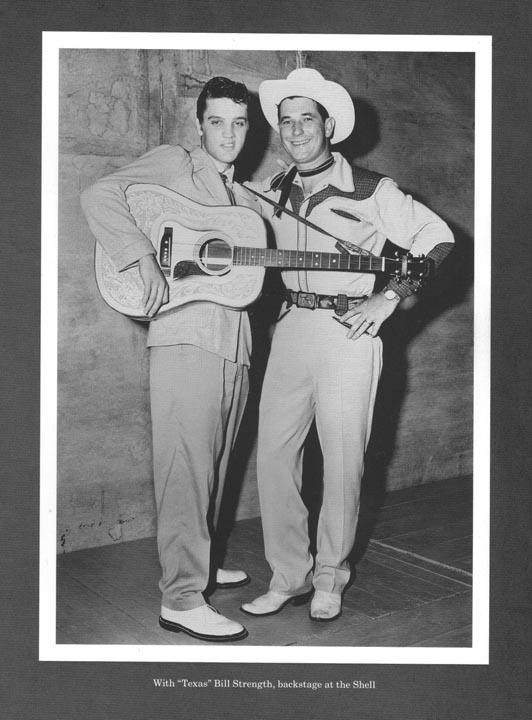
Photo courtesy Dale Strength The Memphis Press Scimitar of August 6, 1955 also reported that the troupe also visited Little Rock, Arkansas; Sheffield, Alabama; Camden, Arkansas; and Tupelo, Mississippi that week.
On August 6, 1955, TBS did a stint on the “Grand Ole Opry” in Nashville, and the Ernest Tubb “Midnight Jamboree” over WSM. (Billboard, August 20, 1955)
On August 7, 1955, TBS appeared as a guest at Roy Acuff’s Dunbar Cave in Clarksville, Tennessee, with Faron Young, the Wilburn Brothers, and Eddie Hill. (Billboard, August 20, 1955)
On August 13, 1955, TBS was due in Cincinnati for a visit with local disk jockeys and other friends. He has just returned from the West Coast, where he cut his first session for Capitol. (Billboard, August 13, 1955)
On August 14, 1955, TBS left Memphis for a two-week promotional tour in the interest of his initial Capitol release, “Yellow Rose of Texas,” b/w “Cry, Cry, Cry.” He has stop-offs skedded for Louisville, Indianapolis, Cincinnati, Chicago, Philadelphia, New York, Washington and other Eastern cities. (Billboard, August 20, 1955)
In August 1955, TBS was back in Columbia, Tennessee, after a jaunt to the West Coast that offered him the opportunity “of guesting on a number of shows and visiting with folk artist friends.” (Billboard, August 27, 1955)
TBS was a visitor at the home office of The Billboard last week [late August] while in Cincinnati to promote his initial Capitol release, “Yellow Rose of Texas” b/w “Cry, Cry, Cry.” He also guested with various local deejays during his Cincy stay. (Billboard, September 3, 1955)
September 1955
And then there’s Abdalla’s Furniture Store, “Southwest Louisiana’s Largest and Finest,” which also sold Popular, Race, and Hillbilly records. For five weeks in September and October 1955 we see Hit Records charts in the Opelousas, Louisiana, Daily World, with TBS’s “Cry, Cry, Cry” b/w “Yellow Rose of Texas” taking various places on the Hillbilly chart, although they are not numbered. Also, the two sides change from week to week.
On September 10, 1955, TBS played the “Barnyard Frolic” at Robinson Auditorium, Little Rock. Show is emseed by Sammy Barnhart (Decca) and airs over KLRA. (Billboard, September 24, 1955)
The Beatttyville (Kentucky) Enterprise reported on September 15, 1955, that TBS “dropped in to see us the other night … hope you heard him. Grand guy.”
TBS had been a recent visitor to DJ Thom Hall at WKYW in Louisville. (Billboard, September 17, 1955)
On September 17, 1955, TBS played the National Guard Armory Birmingham. (Billboard, September 24, 1955)
On September 18, 1955, TBS appeared with:
- Martha Carson
- The Carlisles
- Ferlin Huskey
- Simon Crum
- Jim and June Wilson
- George and Earl
- The Hushpuppies
- The Country Gentlemen
- Kenny Lee
- Bill Lowery
- And a Host of Others

Atlanta Journal, September 18, 1955 The location of this show is interesting. Billboard (September 24, 1955) described it as the Atlanta Crackers Ball Park, (September 24, 1955), while the ad above describes it as Ponce de Leon Park. They were one in the same, at the time the home of the Atlanta Crackers baseball team. Amazingly, there was also an Atlanta Black Crackers baseball team. The stadium is gone now, demolished in 1966.
Strength says reports have been good on his first Capitol release, “The Yellow Rose of Texas” b/w “Cry, Cry, Cry,” with the latter getting the most play. (Billboard, September 24, 1955)
On September 25, 1955, TBS was part of a big Grand Ole Opry show at the Norfolk City Auditorium in Virginia. The show was presented by radio station WCMS in Norfolk. The performers were: (Information in quotation marks comes from the Norfolk Ledger Star, September 22, 1955.)
- Faron Young and His Deputies “for the youngsters”
- Little Jimmy Dickens “for the old-timers”
- The Wilburn Brothers (Teddy and Doyle)
- Rod Brasfied
- Grandpa Jones
- TBS “extra added from Memphis”
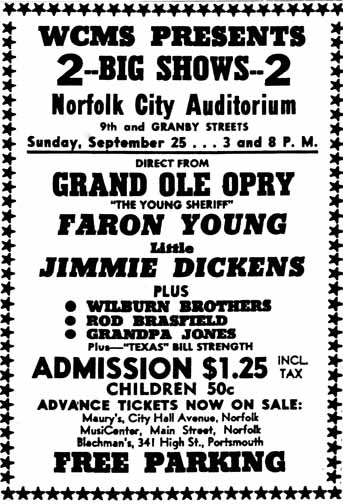
The Virginian Pilot, Friday, September 23, 1955
TBS was in Cincinnati on personals on September 27, 1955, visiting C&W DJs and music men to plug his new Capitol release, “Yellow Rose of Texas,” b/w “Cry, Cry, Cry.” He flew out that night for Memphis. (Billboard, October 8, 1955)
The Corpus Christi Caller Times of September 30, 1955, mixed all of its genres together on its charts, but TBS’s “Cry, Cry, Cry” was there, above a Dean Martin song.
October 1955
On October 13 – 15, 1955, TBS participated in the opening of Memphis’ newest and one of the Mid-South’s largest and most complete shopping centers, the Park Shopping Center, at Park and Getwell. The first six stores staged a jamboree inaugural with top stars of the radio and television musical world, starting with Texas Bill Strength from 9 to 10am for each of the three days. Bill was described as
the popular country disk jockey and artist on radio station KWEM, where he ranks among the top platter spinners. Out of more than 1,800 deejays in the nation, Billboard ranks him No. 50. He lives in Memphis with his wife, Dorothy, and three little Strengths, Dale, Bobby and Sandra.
(Memphis Commercial Appeal, Thursday, October 13, 1955)
On October 21, 1955, TBS and his band were scheduled to entertain at the Kennedy Veterans Hospital with a variety show. It was one of three projects supported by the Armed Forces Officers’ Wives Club of Memphis. (Memphis Commercial Appeal, Friday, October 21, 1955)
TBS’s recording of “Yellow Rose of Texas” was No. 4 in the Cincinnati C&W market. (Billboard, October 22, 1955)
Johnny Cash’s version of “Cry, Cry, Cry” is only now beginning to shape up as a left-field threat. Starting off nicely in the Nashville and Memphis trade areas, it has continued to grow there and has begun to spread. Richmond, Dallas, New Orleans and Little Rock are other territories where Cash has now established himself. TBS’s version is also a good seller in a number of key spots. (Billboard, October 22, 1955)
On October 23, 1955, “Grand Ole Opry TV Stars” gave two performances to good houses at the Memphis Auditorium in the big North Hall. Sponsored by Bob Neal, the show featured:
- Jimmy Dickens and his Country Boys
- Moon Mullican, the Hillbilly Liberace
- Rod Brasfield, Comedian
- Jean Sheppard
- The Wiburn Brothers
- Hawkshaw Hawkins
- Eddie Bond
- TBS
- Ray Price and the Western Cherokees
Faron Young was scheduled to appear, but was hospitalized in Albany, Georgia with hepatitis. (Memphis Commercial Appeal, Sunday, October 23, 1955)

Memphis Commercial Appeal, Sunday, October 23, 1955
On October 28, 1955, TBS was scheduled to appear in Carrollton, Kentucky, with Jimmie Skinner and Hylo Brown. (Billboard, October 22, 1955)
On October 29, 1955, TBS was scheduled to make a return stand with “Circle Theater Jamboree” in Cleveland. (Billboard, October 22, 1955)
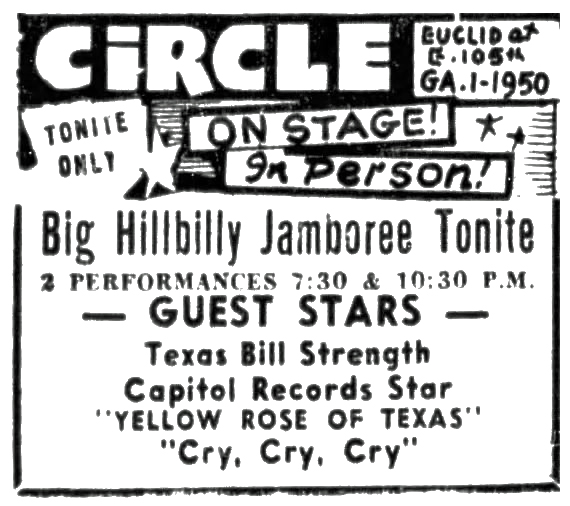
Cleveland Plain Dealer, October 29, 1955
On October 30, 1955, TBS appeared at the Lyric Theater in Indianapolis for an “All Star Jamboree.” Billboard (October 22, 1955) reported that Dick Blake was the producer of the show. Other performers were:
- Martha Carson
- The (Bill) Carlisles
- Jim Wilson
- Sonny Grubbs
- Possibly Ferlin Husky, according to the Billboard blurb

Indianapolis Star, Friday, October 28, 1955
November 1955
Billboard reported that on Saturday, November 5, 1955, TBS was to appear on the Pee Wee King TV show over WBBM, Chicago.
This is a head-scratcher.
The Pee Wee King Show apparently began broadcasting on station WAVE in in Louisville in 1949.
In Chicago it was shown on WBBM from October 11, 1952, to March 28, 1953.
In Chicago it switched to station WMAQ in April 25, 1953.
In Minneapolis, it was broadcast on KSTP starting on March 17, 1953.
An undated list of Bill’s performances says that he appeared on the Pee Wee King Show on station KMMJ-TV, Chicago.
Station KMMJ was in the middle of Nebraska somewhere.
Leave it to Texas Bill to leave us in a quandary!
On November 6, 1955, two shows were presented by Jimmy Skinner and Lou Epstein at Emery Auditorium in Cincinnati. Performers included:
- Pee Wee King and Band (RCA Victor)
- The Stanley Brothers (Mercury)
- TBS (Capitol)
- Jimmie Skinner (Decca)
- Jimmy Williams (MGM)
- Hylo Brown (Capitol)
- Betty Foley (Decca)
- Bonnie Sloan (Columbia)
- Neal Burris (Columbia)
- Ray Lunsford (Excellent)
- Fiddlin’ Red Herron (King)
- Natchee the Indian trick fiddler
- Little Eller Long
- Red Murphy
- Roy Moss
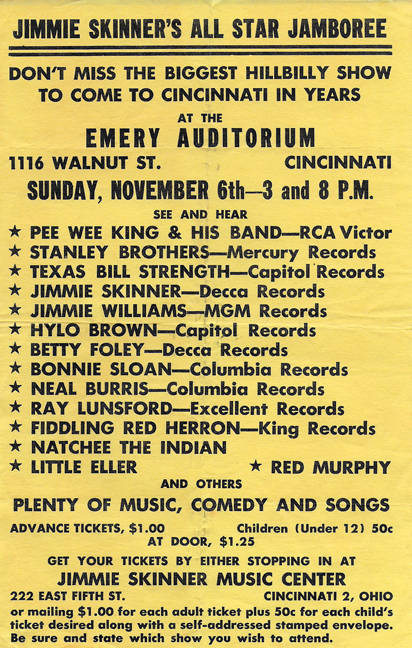
Jimmie Skinner was the emsee. The big show was touted via five Cincy radio and TV outlets. It marks the first C&W talent brigade to play a Cincinnati theater in many years. Reported in Billboard November 5, 1955. On November 19, Billboard reported that 4,800 ducats were sold for the 2,200-seat auditorium. SRO business was the order at both performances, with several hundred turned away at the matinee showing. The show got heavy promotion via five local radio and TV stations.
(Billboard, November 5 and 19, 1955)
The 1955 Billboard C&W Disk Jockey of the Year Poll put TBS at Number 26 out of 60. He was identified as working for KWEM. (November 12, 1955)
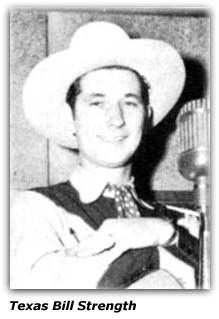
Undated photo, courtesy Dale Strength
On November 12, 1955, TBS put an ad in Billboard, with a picture of himself and text that read (vertically – punctuation added)
THANKS Dee-Jays for every spin you gave me on Cry Cry Cry b/w Yellow Rose of Texas. Your Grateful Buddy, Texas Bill Strength, exclusively on Capitol Records. Hope you like my brand new release, “Turn Around” b/w “When Love Comes Knockin’” Congratulations, WSM, on your 30th Anniversary. Glad to be here. Texas Bill Strength, Station KWEM, Memphis, Tenn. Phone Mutual 5-8606. Member CMDJ. Represented by Miss Bobbie Bennett, 763 Gower Ave., Hollywood, Calif. Hollywood 9-5891.
FAREWELL TOUR
On November 13, 1955, TBS made his final appearance in Memphis at the Ellis Auditorium. It was a farewell tribute to TBS, who announced to the crowd that he was moving to Minnesota to introduce Yankees to country music. The concert, which lasted between 3 and 8 pm, was the first of a six-day tour. Performers at the concert were:
- Hank Thompson
- Charline Arthur
- Elvis Presley
- Carl Smith
- Carl Perkins
On November 14, 1955, the Memphis show from the night before was repeated in Forrest City, Arkansas.
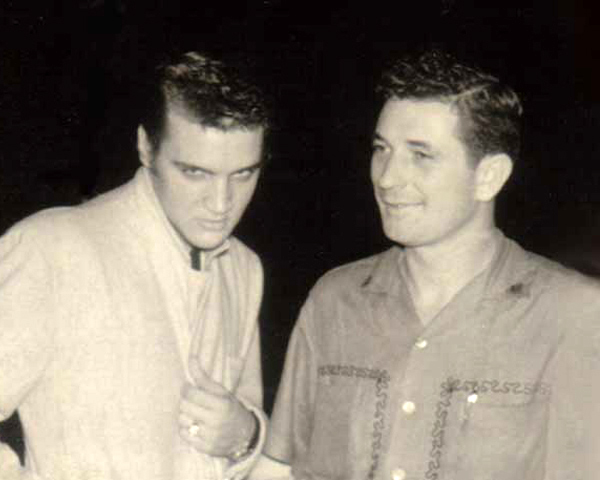
Elvis and TBS before the Forrest City, Arkansas show. Hank Thompson was off camera to the right. Photo courtesy Dale Strength. The tour was promoted by Bob Neal, Presley’s personal manager. Strength has just given up his deejay chores at KWEM, Memphis. (Billboard, November 6, 1955)
On November 29 and 30, 1955, TBS was scheduled to guest star on “Hometown Jamboree,” Houston. Whether this was a radio or TV show is unclear. (Billboard, November 12, 1955)
Texas Bill Strength: Death and Legacy
One topic that I knew almost nothing about was the circumstances surrounding the automobile accident that led to the untimely death of Texas Bill. It’s no wonder – the information was all over the place: (more…)
Texas Bill Strength
This is the first of a 5-page series. These pages are not intended to be a biography of Texas Bill, but an attempt to retrace his many steps across America during his short but incredibly action-packed lifetime.
It was created at the request of and with the help of Dale Strength, Texas Bill’s eldest son, who is dedicated to preserving the legacy of his father.
Sources include:
- Ancestry.com
- Articles from Billboard magazine, as provided by Dale’s cousin
- Mr. Roland S. McDonald, Reference Archivist, Alabama Department of Archives and History
- Minneapolis Star and Tribune
- MyHeritage.com
- Newspapers.com
- PragueFrank’s Country Music Discographies – Frank Frantik has done an awesome job collecting information on Country artists and their recording sessions, despite the fact that he lives in in Prague, Czech Republic. All such recording information comes from this site.
- Ronnie Pugh’s article “Sing, Spin, Stump, Sell: The Forgotten Figure Who Did it All,” written as an entry on TBS for the Country Music Foundation’s encyclopedia. A version was read at the 14th International Country Music Conference on June 6, 1997, in Meridian, Mississippi.
- Don Veasey, Curator of Photographs, Department of Archives and Manuscripts, Birmingham Public Library
- Taped interviews that Dale conducted with his mother at her home in Texas in the early 1980s.
Corrections and additions are always welcome.
Feel free to contact me.
Jeanne Andersen

Professor James Frances Patrick O’Neill
FROM DON BETZOLD
The following tribute to one of the classic KDWB Disc Jockeys was written by former State Senator and avid KDWB fan Don Betzold. It is reproduced here with the permission of Senator Betzold and courtesy of the Pavek Museum of Broadcasting.
In the 1960s, every Twin Cities teenager knew there were two, and only two, Top 40 radio stations. At one end of the AM radio dial at 1130 was WDGY. “Wee-Gee” was the heavyweight with the powerful signal which could be heard all over the Midwest. At the opposite end of the AM dial at 630 was KDWB, Channel 63, which could hardly be heard 25 miles out of town. The two stations played the same Top 40 records, which was quite a variety back then, including rock ‘n roll, ballads, country western, folk, a little jazz or rhythm and blues, Motown, instrumentals, and even novelty songs. Their contests and promotional giveaways were modest. A lucky listener might win a new 45 single.Despite their format similarities, there was a world of difference between the WDGY and KDWB. To me, the WDGY announcers sounded pretty much the same. It also seemed to me that they spun the vinyl singles on their turntables just a little bit faster than 45 revolutions per minute so that they could play more records per hour.
I was loyal to KDWB from the time that I bought my first transistor radio from my father’s appliance store in July 1961 and soon thereafter happened upon its 63 “easy to remember” frequency. I thought the disk jockeys were clever and happy to be there. They were billed as “the Seven Swinging Gentlemen.” Each had his own style for his own program, from Hal Murray’s zany jokes in the morning, followed by Art Way and Bob Friend, to our “lovable leader” Lou Riegert in the evening, followed by Randy Cook and then Don Duchene at midnight.
James Francis Patrick O’Neill, the afternoon host, was the best of them. He joined the station about the time I started listening, and I listened to him every chance I had for six years.
As a disk jockey on a Top 40 station, his job was to play the latest hits. O’Neill didn’t just announce the next record and move on; when the song was over, he would find a nice quip or a pun to tie into it. He might even offer a personal view on a Top 40 record. I once heard him play “In Dreams,” then a current hit by Roy Orbison. When the song was over, O’Neill said that he really didn’t care much for the song when he first heard it, but it grew on him.
What distinguished O’Neill from other announcers was how he used his airtime. He put on a real show. Initially he was on three hours a day, later four hours every day, six days a week, 50 weeks a year, taking two weeks of vacation in July.
JFPO called himself “Professor” O’Neill. He carried that schtick to the publicity photos in the weekly Top 40 record surveys. Instead of posing with the traditional head shot, he wore a mortarboard and tassel with a graduation robe, sporting glasses and a raised index finger pressed against his creek, his other fingers curled and resting under his chin. The photo didn’t give his audience a clue what he really looked like; we had to use our imaginations.
He spent hours each day preparing for his daily show. He claimed to have “a cast of thousands” and he referred to his “studio audience” to the point where one almost believed there was such a thing. He conversed with his many voice effects and made us laugh with his dry sense of good humor. His radio characters included Snooky Lanson and poet laureate Keates Schmidlap, who gave thoughtful advice in his ditty, ending in a pun. He made parodies of his own station; D.J. Leary had the “Live Line to the World of Sports”, O’Neill created “D. J. Looney” in rebuttal. O’Neill could work up a joke based on Will Rogers or Louisa May Alcott. He included forgotten historical events, like the trial of Sacco and Vanzetti, into his off-beat dialogue. He did skits based on local news, so you had to pay attention to current events to get the gist of his satire. He even prefaced normally mundane announcements of the time and temperature with a quip, for example, “K-D-W-B ‘whatever-happened-to-Hailey-Mills?’ time is 5:17.” He might imagine some “schlep” who had “a smile on his lips, and song in his heart, and two tickets to the midnight showing of Rebecca at Sunnybrook Farm.” He used big, sophisticated words, like “aficionados,” “inveterate,” or “halitosis,” causing this teenager to go to the dictionary so I could understand his jokes.
He had continuing humorous sagas, which often ran each day for weeks. He had a passionate campaign to stop Lake Phalen from leaking. Each summer, he gave reports from his mythical Camp Nitty-Get-Get, with his own theme song which included the line “I hope the check my daddy writes don’t bounce back to you.” During the elections of 1964, he used his airtime to campaign for Mayor of Dinkeytown. I was a high school freshman that autumn and I mailed in my written ideas, which he read on the air with kudos to me.
He was never mean or insulting, just funny. Unlike other deejays, he offered occasional glimpses into his own well traveled life, invariably as part of some joke. He mentioned his stint in the Army. Sometimes he told us a little about his family, always with affection. One late August, he teasingly described how unhappy his daughter was because summer vacation was almost over and she had to go back to school, a sentiment I shared.
He ended each show with “Recipes I’ve gotten sick to.” My favorite was pickled herring upside-down cake. After he read the recipe, he groaned with a “yeech,” as though someone else had sent the concoction to him. As the instrumental played in the background and the clock headed to the newscast at the top of the hour, O’Neill would proclaim that “the last four hours have been a veritable ball.” (How many times do you hear the word “veritable”?) He’d then promise “we’ll do it again tomorrow.” He would then caution us: “Don’t take any nickel nickels, hey.” And finally he would end his program with his signature phrase, “See you out there!”
It was a fun time to listen to Top 40 radio.
Then times changed, starting with the assassination of President Kennedy. When the Beatles led the British music invasion two months later, the music got much better, and the radio stations which played the records changed as well. “Much more music” meant less jock talk. More rock also meant no more of any other kind of music. With few exceptions, if it wasn’t rock, it wasn’t played. Any record released prior to 1964 was scratched from the playlist. Soon, newscasts were gone. The newer, younger deejays had one main job: announce the next record and keep playing the hits. There was no time to entertain, to ponder, to offer ideas, to establish an identity with the audience.
The days of the personality deejay were over. I wrote my protest letter to the program director at KDWB. He responded with a very polite note explaining that this was the direction of the radio industry. I kept listening to Jim O’Neill’s daily program. He still managed to work in a few funny lines and an occasional bit, but he was being crowded out with too little airtime to work his craft. He had to spend more time announcing the next record and playing more non stop hits. Undoubtedly, the changing times also made it tough for O’Neill. It must have been hard to put together a glib, light-hearted show when our attention was on the Vietnam War and riots at Selby-Dale in Saint Paul and Plymouth Avenue in Minneapolis.
Jim O’Neill signed off at KDWB for the last time on Friday morning, August 25, 1967. By then, his program had been moved to the 6 a.m. to 10 a.m. slot. Shortly before 10 a.m., he said that “the last six years have been a veritable ball.” There was no promise that we would do it again tomorrow. After he said “See you out there!” he played his final record, “Jackson” by Nancy Sinatra and Lee Hazelwood, and was gone from our local airwaves. Then the next deejay started his shift, and the hits just kept on coming.
I never met Jim O’Neill. I saw him from afar at the 1965 Beatles concert at Metropolitan Stadium when he was introduced with other deejays from KDWB and WDGY, just before the Beatles took the makeshift stage.
I finally had the chance to visit the KDWB studio in October 1967, less than two months after Jim O’Neill left. As I looked around that small building, I saw no visible evidence that he had ever been there. The studio where the on-air deejay sat was a modest soundproof room, with the turntables, microphone, tape cartridges, and audio board, all contained in a small space. The record library, with a hundred hours or so of past hits, was in the back of the room. It was just an old wooden bookcase, about three feet high, each shelf crammed end-to-end with 45’s.
On that visit, I met a part-time deejay, and asked him about Jim O’Neill. The announcer mentioned, with some awe, that O’Neill was in his forties. Actually, JFPO was in his late thirties at the time, but the point was still the same. It was remarkable that someone so “old” was doing this kind of work. Then the deejay said with a certain amount of amazement, “he was incredible. He’d get up at three in the morning and start writing his show!”
A few weeks later, I had to write the caption which I wanted published about me in my 1968 senior yearbook. As a tribute to Jim O’Neill, I wrote that my favorite saying was: “See you out there” and that is what was printed under my senior photo. I adopted his signature phrase then, and I continue to use it to this day.
As a teenager, I was bound and determined to become a disk jockey, just like Jim O’Neill. But I never had his talent; few people do.
Many things have changed around here since Jim O’Neill left town. The old KDWB studio building which sat in a desolate field near Lake Elmo on Highway 12 and Radio Drive is long gone. A large empty office building now sits on its ground. The surrounding radio towers are long gone as well. Highway 12 has become Interstate 394. Radio Drive was once a little dirt road leading from the highway to the station; now it’s a major road through the booming suburb of Woodbury. I doubt that any of the thousands of people who drive on it know why it was named “Radio Drive.” The 630 AM frequency now belongs to a Spanish-speaking radio station. KDWB became an FM station in the mid-1970s with a powerful signal, and moved its studios to Richfield. They still play today’s popular music, but they can’t play any of the music which built the station because their young audience wouldn’t listen to it.
In September 1967, Jim O’Neill started his new radio job as the “Morning Mayor” at WLW-AM in Cincinnati. His task was to unseat the morning ratings king at a rival station. He did it. O’Neill’s humorous program became the number one morning radio show in that market. He stayed at WLW for the next 15 years and then worked at another Cincinnati station after that.
Jim O’Neill died on June 24, 2004 at the age of 75. His Cincinnati Enquirer obituary said that O’Neill’s colleagues called him “the lovable one.” One Cincinnati announcer remembered that “he was the most prepared guy I ever worked with. He always had a stack of material. He was a radio man. He lived radio.”
I learned to appreciate his dry, witty humor. I’m happy to remember a man I never met, but with whom I regularly shared a little time every day during six teenaged years of my youth. I was glad to be one of the Professor’s “students.” It was a veritable ball.
FROM CURT LUNDGREN
In 1967, Curt Lundgren, a future disk jockey himself, was also a big fan of Jim O’Neill, and was happy when the Professor took the time and thought to give him a humorous response to his fan letter. 55 years later, Curt shared it with me, and now you:
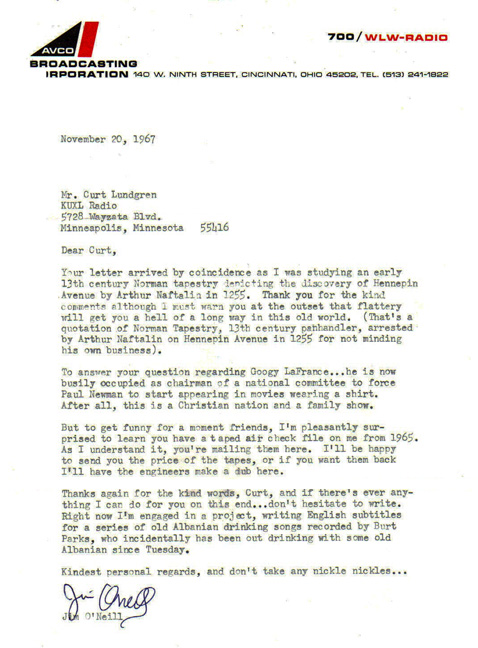
Courtesy Curt Lundgren Johnny Canton
One of the indisputably most popular disk jockeys of the 1960s in the Twin Cities was WDGY’s Johnny Canton. His smooth style contributed to the less-raucous sound of Wee-Gee, as opposed to the more frenetic KDWB, at least in my pre-teen opinion! Johnny was kind enough to send his career highlights. All photos except as noted courtesy Pavek Museum of Broadcasting.
Birthday: October 4th, 1941, Kansas City
I was going to be a schoolteacher until I was 12. And then I went to a radio station one day in Warrensburg, Missouri, and I fell in love with the magic of how a guy can sit in front of a mike and be heard miles away.
My on-air “debut” was May 8th, 1958, at KLEX-AM Radio, Lexington, MO. I was 16 years old.
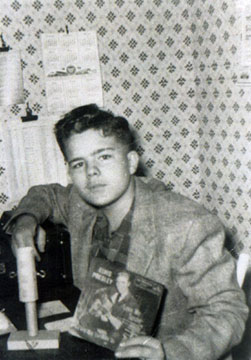
My broadcasting journey took me to stations in Colorado; Pennsylvania; Kansas City; Rochester, NY; Cleveland, OH; and the Twin Cities, MN. In addition to being an on-air personality I have been a Program Director, News Director and Music Director at various stations.
In 1965, while at WHAM-AM, Rochester, NY, I narrated David Wolper’s “The Making of a President” promotion for the CBS-TV special sponsored by Xerox Corporation.
In August 1966, while at WIXY-AM, Cleveland, OH, I introduced the Beatles at their concert there.
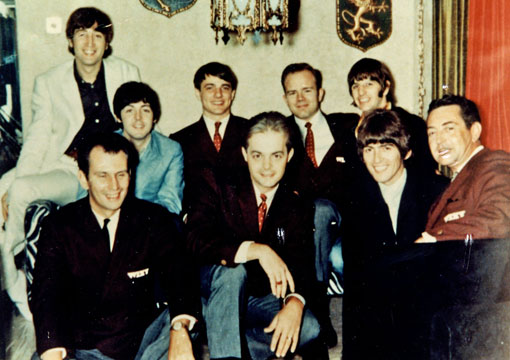
Johnny’s in the back row next to Ringo.
My Twin Cities career began in November, 1966, at WDGY-AM Radio, a leading Top-40 station at the time. I was on the air as well as WDGY’s Music and Program Director. While at WDGY I received the Radio-TV Mirror Magazine “On-Air Personality Award” in 1968.
[Johnny co-emceed the Connie Awards in 1968 in an Oleg Cassini Nehru suit from Keiffer’s.
On June 28, 1969, he was interviewed on “American Bandstand” in their “Hollywood Hotline” segment, reported the Insider.
From a 1970 ad: “Good Morning Twin Cities! Johnny Canton takes the morning in easy stride. A Touch of music, a few laughs, entertaining you from 9 til noon. Request your favorite song, hear it, and win it on Johnny’s Phon-A-Song Line, 827-9955.”]
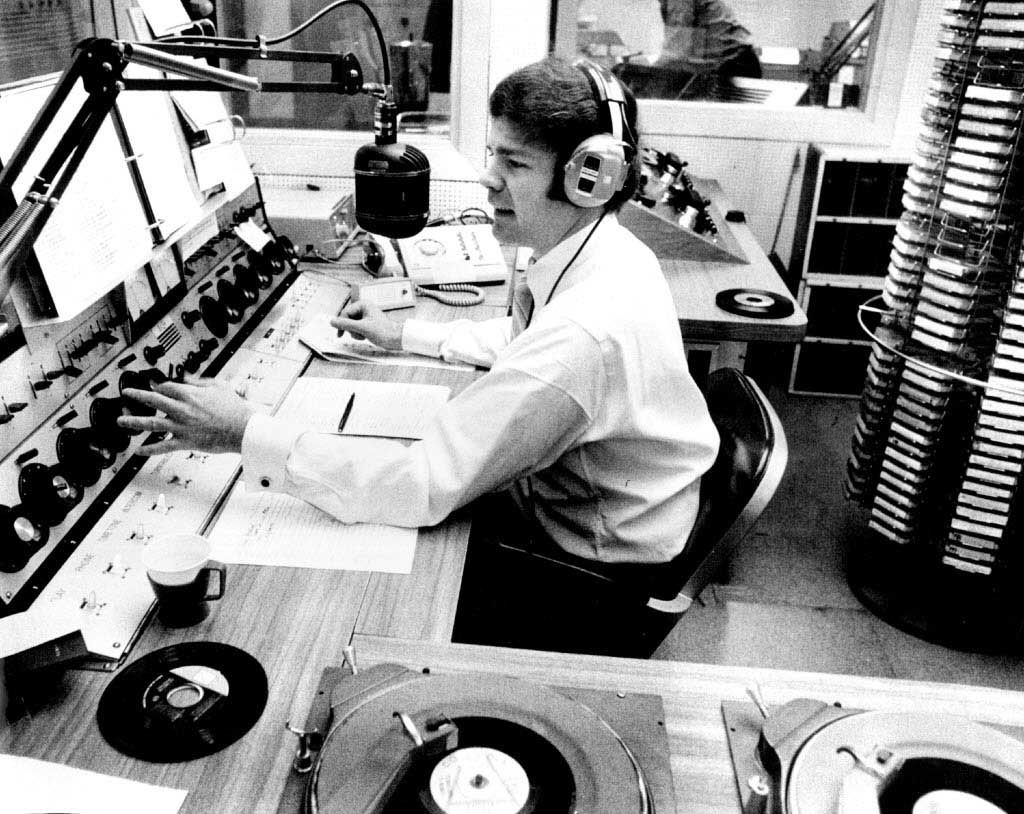
1970 photo from StarTribune Archives
In late 1977 I joined WCCO-FM Radio which changed call letters to WLTE-FM in 1984.
On Twin Cities TV I hosted “Bowling for Dollars on KSTP-TV 5, 1977-1978, and hosted “Bowlerama!” on KMSP-TV 9, 1983-1987.
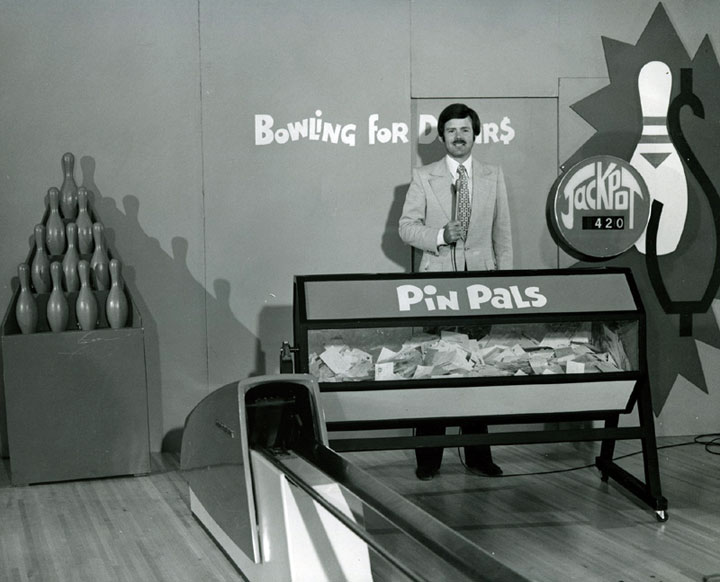
1977 – KSTP
I have appeared in many radio and TV commercials; narrations; industrial films/videos; newspaper, magazine and catalog print ads – many national, including Whirlpool Total Cereal, Golden Grahams Cereal, Montgomery Ward, Culligan Water, Hamm’s Beer, Polaris Snowmobiles and others.
I have had several acting roles, including that of an airlines ticket agent in the Ross Hunter/Universal film, “Airport,” which was partially filmed in the Twin Cities.
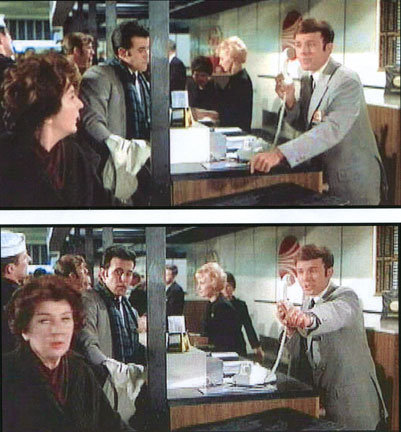
I also appeared as the M.C. in the Joe Cocker film, “Mad Dogs & Englishmen,” also partially filmed in the Twin Cities.
In his autobiography Take Me Home, the late John Denver credits me with giving his record career a substantial boost by being the first disc jockey to introduce “Take Me Home Country Roads” on radio.
Through the summer the song got into the national bloodstream. It first aired in Minneapolis, where Annie and I were still living. I had taken the record around to a very hot disc jockey named Johnny Canton at station WDGY, who liked the song and gave it tremendous play. After that, word of mouth moved it. The same thing happened from city to city.
In 1977 I became Executive Vice President of Masters & Associates, Inc., a Twin Cities advertising agency. This led me to form Canton Communications, Inc., in November, 1978, a Twin Cities advertising/radio-TV production firm.
And without a doubt a huge career highlight was being inducted into the Minnesota Broadcasting Hall of Fame in October 2006.
Johnny retired as an on-air radio personality in December 2011.
Click here to see a great short video highlighting Johnny’s career, produced by the Pavek Museum for his induction into the Hall of Fame.
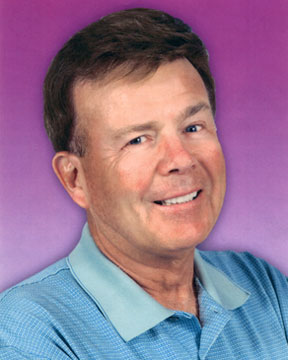
Johnny in 2011 Johnny Canton passed away on Saturday, December 31, 2016, due to a Cerebral Vascular Accident (severe stroke) he suffered on Monday, December 26. His family included his significant other of 34 years, Janie Meyer, and daughters Jonna and Heather.
Johnny was a Twin Cities icon and a genuinely nice guy.
Also see Johnny’s page on minniepaulmusic.com.
Jimmy Reed
Jimmy Reed – KDWB (1966 -1967), KRSI (1969), WDGY (September 23, 1969 – 1984), WLOL (1986)
James Arthur Rud was born on October 2, 1936. An interview in the St. Louis Park High School Echo tells us that he went to Brookside Elementary School, same as me! The interview says that he got his inspiration to pursue broadcasting when Bud Kraehling came for career day. He graduated from Park High in 1954. Next to his name in the yearbook it says “Don’t mention motors or you will get him started.” He worked on the school paper, big time in Hi-Y, in a school play, and on the badminton team!
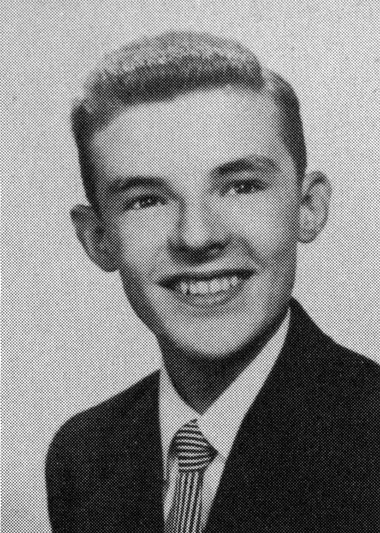
Jimmy Rud’s Graduation Photo, 1954 Jimmy graduated from Brown Institute in 1959. Back to the Echo interview, it says that Jimmy got the idea for his double entendres dfrom Laugh-In; it was so successful he was hired from KRSI to WDGY. From a 1970 ad: “Jimmy Reed moves Hit Sound ’70. Putting it all together every night from 7 to midnight. Come into Reed’s world. Much More Music is Jimmy’s specialty.” Jimmy opened his first show at WDGY by stating he was “..out on pass from the suburban rest-home.” (KRSI was on Excelsior Blvd. in St. Louis Park.)
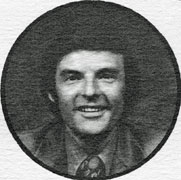
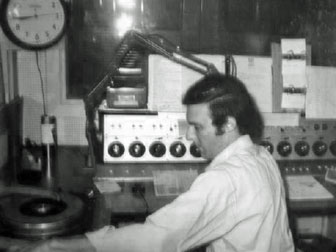
1969 photo courtesy Rick Burnett’s Twin Cities Radio Airchecks 
Courtesy Jeff Lonto After he left WDGY in 1984, he apparently went to WLOL, as evidenced by the very end of this aircheck, discovered by Jeff Lonto.
Jimmy died on June 16, 2017, in Red Wing at the age of 80. He had been living in Farmington. I am very sad that he died before I had a chance to talk to him, but I couldn’t find him. His obituary in the Red Wing Republican Eagle reads:
He was born on Oct. 2, 1936, to Geraldine (Feeney) and Norman Rud, Sr., in Minneapolis. Jimmy graduated from Brown Institute in 1959, and began working in radio. His radio personality name was Jimmy Reed and he worked for KDWB, KRSI, and WDGY. Jimmy adored music and in the 1970s an ad promoting his radio show used the tag line “More music is Jimmy’s specialty.” He also owned Reed’s Pizza in Prior Lake.
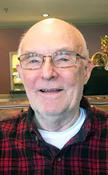
Jack Thayer
There would be no music, local or otherwise, without disc jockeys, and one of the most influential DJs in the early days of Twin Cities popular music was Jack Thayer. Seemingly in constant motion, he worked here for years as an on-air DJ, the General Manager of our first rock ‘n’ roll station, the host of an “American Bandstand” type TV show before there was an “American Bandstand,” and the host of Teen Hops at the popular Prom Ballroom. Much of the information below comes from local media expert Jeff L. Lonto, with my thanks.
EARLY HISTORY
Jack G. Thayer was born Glover Eddy Thayer on November 22, 1922, in Chicago. His father, Harley Thayer, worked for the U.S., Chicago, and North Western Railway for almost 48 years, working his way up from a coal shoveler to Superintendent. Using Census data and railroad employment records, here is a sketch of where the family traveled:
- 1922 to 1930: Chicago
- April 1934 to 1935: Milwaukee
- January 1937 to ?: Winona, Minnesota
- 1940 to 1946: Chadron, Dawes County, Nebraska, in the Northwest part of the state.
Jack Thayer seemed to pack a lot of activity into 1941 to 1943:
- On June 7, 1941, he was hired on as a laborer for the U.S., Chicago, and Northwestern Railway. It is unclear whether it was only for a week or not.
- On June 30, 1942, he registered for the military, showing his occupation as student and his residence as Chadron.
- His first job was at KOBH radio in Rapid City, South Dakota. Rapid City is about 100 miles straight north of Chadron. KOBH would change its call letters to KOTA on January 1, 1945.
- Next there was a short stint at a Chicago radio station.
- Once in the Twin Cities, he enrolled in Joe Beck’s Twin Cities School for Radio
WLOL: 1943 – 1952
In 1943 Thayer was hired as a DJ by Bob Bouchier, a classmate from the Beck School and the General Manager of the station. His shows included “Swing Time” and “Top Tunes of the Week,” the latter pioneering the Top 10 format.
Apparently it was okay for DJs to plug songs! Billboard Magazine said that Thayer was one of the DJs that made the song “All Right Louie Drop the Gun” (the original version by Art Kassel and Gloria Hart) such a big hit in 1949. The record below also came out in May 1949.
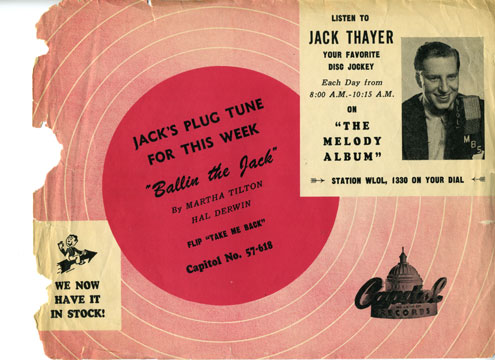
Image courtesy Pavek Museum of Broadcasting
WTCN: 1952 – 1956
On August 17, 1952, Thayer moved to WTCN radio and TV. While maintaining a daily on-air disk jockey schedule, he participated in several other TV and live shows:
- “Jack’s Corner Drug Store” ran at 4:00 pm weekdays, starting just days after WTCN went on the air: September 7, 1953. This teen dance show began four years before “American Bandstand” went national. TV Guide: “Jack Thayer, emcee. The scene is the replica of a drug store. High School and college students are invited to the show.” Another description went: “jivey teen-age dance get-together. Dance contest $180. Tangos, rhumbas, and other South American Favorites.”
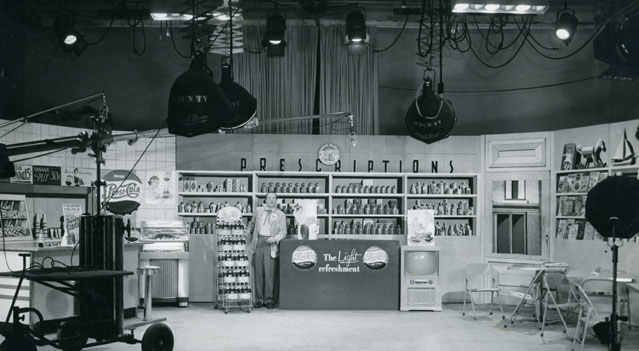
Photo courtesy Pavek Museum of Broadcasting
- “Jack Thayer’s Beach Party” was the name of his show from June 12 to July 7, 1954. TV Guide: “Broadcast from the veranda of the Calhoun Beach Hotel, overlooking beautiful Lake Calhoun.”
- “Jack Thayer’s Sun Fest” was the name of the afternoon show during the summer of 1955.
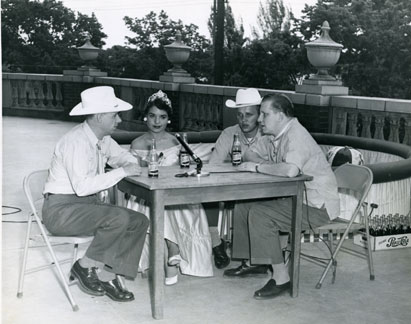
Photo courtesy Pavek Museum of Broadcasting
- After the 1955 “Sun Fest,” the show was renamed “Record Hop.” The afternoon show went off the air (partly because of the Mickey Mouse Club) on October 28, 1955.
- “The Jack Thayer Show” was broadcast on Saturday evenings from February 20, 1954, to October 24, 1955. This show may have also been known as “Top Ten Records.” Photos are labeled “Lip Synch Show,” if that’s a clue to the format.

Photo courtesy Pavek Museum of Broadcasting
- He and his wife Donna hosted Miracle Mile Theater, where they showed a movie and presented 16 commercials for stores at the Miracle Mile Shopping Center in St. Louis Park.
- At times Thayer even filled in as a weatherman at the station!
- In 1952 Thayer launched a series of Teen-Time Dances on Wednesday nights at the Prom Ballroom. His last appearance was on July 3, 1957; he was replaced by WDGY’s Bill Bennett.
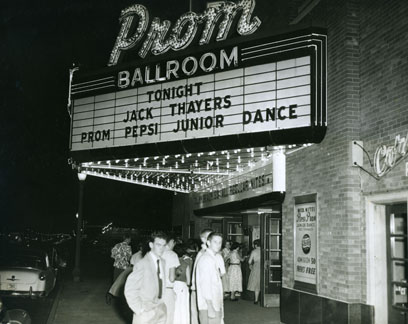
Photo courtesy Pavek Museum of Broadcasting All of this activity led Minneapolis Tribune columnist Will Jones to dub Thayer the most visible TV personality in the Twin Cities.
Thayer left WTCN in January 1956.
WDGY
In 1956 he was lured away from his two TV shows and radio show on WTCN to go with WDGY radio. He began his disk jockey duties on February 6, 1956.
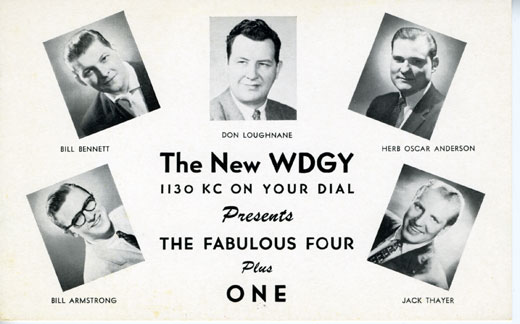
1956
In July 1957 he gave up his on-air duties and became General Manager of WDGY.
As a promotion, in November 1958 Jim Ramsburg cooked up the Radio Wonders basketball team. WDGY Jocks teamed up with professionals Ed Kalafat, Bobby Cox, Jim Springer, and Corky Devlin, possibly former Minneapolis Lakers. The team could not play high school and college teams, but would go out to small towns for exhibition games. Some not so happily as others, he admits. Proceeds would go to a charity mutually agreed upon by the two teams. The photo below, provided by Jim Ramsburg to the Pavek Museum of Broadcasting, shows Jack Thayer holding the ball. Clockwise from Jack are Bill Diehl, Don Kelly, Dan Daniel, Stanley Mack, and Ramsburg.
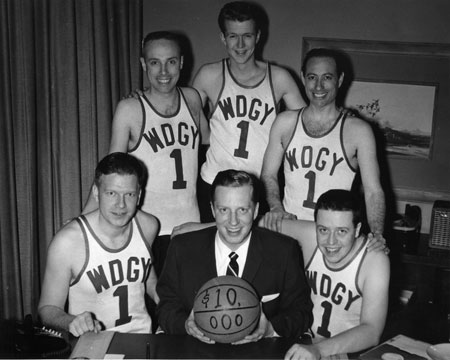
Photo courtesy Pavek Museum of Broadcasting He left WDGY on December 24, 1958.
From 1958 to 1959 he served as the fifth president of the Minnesota Broadcasters Association.
In January 1959 Jack finally took a vacation; records show transit papers in Puerto Rico and Haiti.
AFTER MINNESOTA
In May 1959 he left Minneapolis for California.
In 1963 he moved to WHK in Cleveland, another Storz station. One of his stunts was to invite Nikita Khrushchev to a sock hop sponsored by the station.
In January 1967 he moved to KLAC-AM in Los Angeles, where he created the call-in talk show where he debated hot issues of the day with his listeners.
From there he became General Manager of KMET-FM, owned by Metromedia, where he started the first commercial underground rock format, with deep album cuts and laid back DJs. The station started up in June 1968.
Jack and Donna divorced in Los Angeles in April 1969.
In 1970 he was hired as General Manager of WGAR in Cleveland, and he made dramatic changes in both the AM and FM stations. The FM station had been on the air for purely technical purposes; it then went to a 24-hour operation as WNCR, (Nationwide Communications Radio) and adopted a progressive rock format that was tapped two years earlier by WMMS. The AM side saw a format shift to adult contemporary.
Thayer later became President of Nationwide Communications, a subsidiary of Nationwide Insurance Company, based in Columbus, Ohio.
From 1974 to 1980, Thayer was president of NBC Radio.

1978
In 1975, while at NBC, he established the News and Information Service Network, which provided news “capsules” to all-news radio stations across the country, including WWTC in the Twin Cities. The concept of all-news radio was slow to catch on, and the NIS folded in 1977; CNN didn’t start its all-news format until 1980.
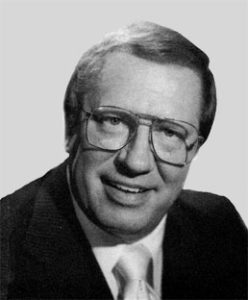
Thayer’s next move was in 1980 when he became the General Manager of WNEW, Metromedia’s flagship station in New York, which had a Big Band format on its AM station and album rock on the FM.
THE END OF A BRILLIANT CAREER
Thayer suffered a stroke in 1984, ending his broadcasting career. He lived in a New York nursing home for the next ten years. After a heart attack/brief illness he died on January 1, 1996, at St. Joseph’s Hospital in Providence, Rhode Island, at age 72. His obituary in the New York Times said that when he died he was the chief operating officer and executive vice president of Gear Broadcasting International, a subsidiary of Gear Telecommunications, a wireless cable operator in New England. It also said that he lived in Providence and Manhattan.
Jack Thayer is considered an innovator of the Top 10 format, talk radio, and underground rock radio. When he was inducted into the Minnesota Broadcasting Hall of Fame in 2013, his plaque rightly noted that “he left behind a legacy of innovation and achievement that pays credit to his Minnesota roots.”
Herb Oscar Anderson
Herb Oscar Anderson (HOA) didn’t spend much time in the Twin Cities, but he made a big impression, and went on to a huge career as one of the biggest DJs in New York. I tracked him down in Florida in 2013 and we had a wonderful phone conversation. Thanks to the Pavek Museum for some of the following information.
Herb Oscar Anderson was born on May 30, 1928, in South Beloit, Illinois. His mother (both of HOA’s parents were Swedish) spoke very little English, and when his father passed away, young Herb was sent to the Odd Fellows Orphan’s Home in Lincoln, Illinois. He eventually relocated to Wisconsin, where he wrote for the Janesville Daily Gazette.
In 1949/1950 he was hired by KSTP, but his tenure was interrupted by a three-year stint in 132nd Air Corps Wing out of Des Moines. Performing and/or organizing USO shows were included in his duties.
In 1954 he returned to KSTP, where he wanted to get into TV. They didn’t give him much to do, though: working overnight, he sold Bibles that glowed in the dark and such: “Better than a test pattern – or is it?” One source described him as a “utility man,” ready to jump in anywhere.
Someone at WDGY liked him, and he was hired away just as the station was moving to a Top 40 format. Herb kicked off the new format on February 6, 1956. That same day, WDGY “kicked its evening ‘Serenade’ show off the air.” Herb told me that they did the Top 60 songs at first, with a heavy emphasis on the personalities of the DJs. In three months the ratings of WDGY went up 365 percent! His obituary in the New York Times says that he was known as “235 pounds of genial joviality.”
Radio historian and fellow WDGY DJ Jim Ramsburg characterized HOA as a “very nice guy, surprising nervous on the air. He begrudgingly played the ‘Morning Mayor’ routine, which we stole from Eddie Clarke at our sister station, WHB in Kansas City.” At WDGY he began to sing along to Lawrence Welk’s instrumental, “Champagne Time,” and came up with his “Hello Again” theme. “Hello again, here’s my best to you. Are your skies all gray? I hope they’re blue.” He even recorded the song. Writing lyrics to instrumentals so that he could sing along to them became one of his trademarks.
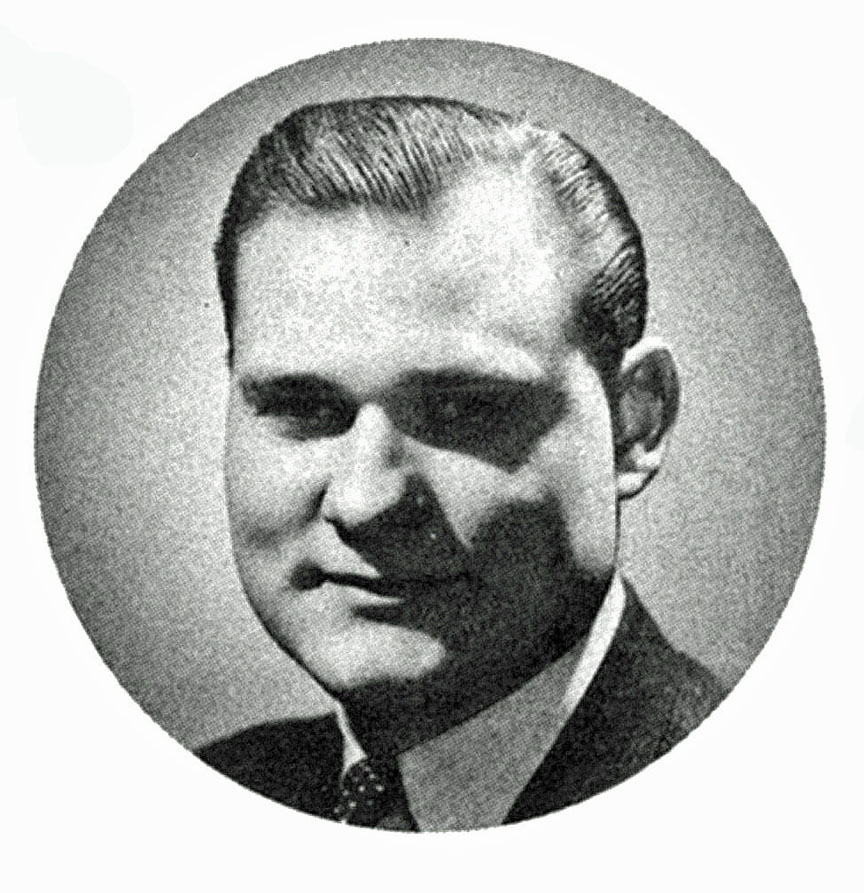
1956 THE CONTEST CRAZE
To kick off WDGY’s new format, owner Todd Storz and his P.R. staff dreamed up a myriad of crazy contests where listeners could win big bucks. (See the 1956 Contest Craze.) One contest involved a check that was hidden somewhere in town. The disk jockeys didn’t know where it was, but people assumed they did. Herb reported getting calls at home from guys with menacing voices who offered to “split it witch ya” if he told the guy where it was. He was genuinely afraid of these guys and happy when the contest was over!
OSCAR SOCKS
Herb shook up the Twin Cities in the Fall of 1956 with “Oscar Socks” – convincing high school girls to wear knee-highs of one design on the left leg and a contrasting design on the right. Girls at the brand new Park High responded in droves, but Principal Edward Foltmer suppressed the fad promptly. “We’d be opposed to any distracting influence at school,” he explained with a cautious smile. “We can’t allow bizarre clothing.” A bag lunch protest last Friday, with many girls wearing black and spurning the school’s hot lunch, followed. Boys at St. Louis Park High came to the girls’ rescue. “The boys wore their shirt tails out in protest after we weren’t allowed to wear Oscar Socks,” student Elaine Smedberg said. “But the administration made ‘em pull the shirt tails in. So the boys hiked up their pants, wore them around their ribs. Then a week ago, about 15 boys peroxided their hair.” Next morning, “the kids hissed the principal and started singing ‘Chain Gang’ in school,” other girls reported (not the Sam Cooke song). This event was reported in the Minneapolis Star, but not in the St. Louis Park Echo.
Anderson was interviewed in the Echo on October 24, 1956. “Andy”’s familiar greeting was “Hi ya gang, it’s a lovely day today.” He said that WDGY’s Top 40 lists were more in tune with actual popularity, since they were based not just on record sales but juke box plays and requests from various establishments including hotels and night clubs. His favorite pop singers were Elvis, Eddie Fisher, and Fats Domino. He, his second wife Terry Krikoff, and son Johnny were new residents in the Park. Other children were Herb Oscar Anderson II and daughter Carla.
Top 40 doesn’t necessarily mean rock ‘n’ roll – he told me that he basically played MOR for the housewives (my notes say “schmaltz,” but I don’t know if that’s his word or mine). I asked him if he liked that kind of stuff and he said he did.
GET THAT GUY OUTA HERE!
HOA was so popular that the competition at WCCO wanted him gone, so it was arranged that he be offered a job at WBBM, a CBS station in Chicago, with terms that he couldn’t refuse. He left Chicago on July 8, 1957. From there he went to New York: first to WABC, the top rated Top Forty station in New York in 1957, then to WMCA in 1958, and back to WABC from 1960 to early 1969, where he was the “Morning Mayor of New York.” It was his work in New York that he is best known for.
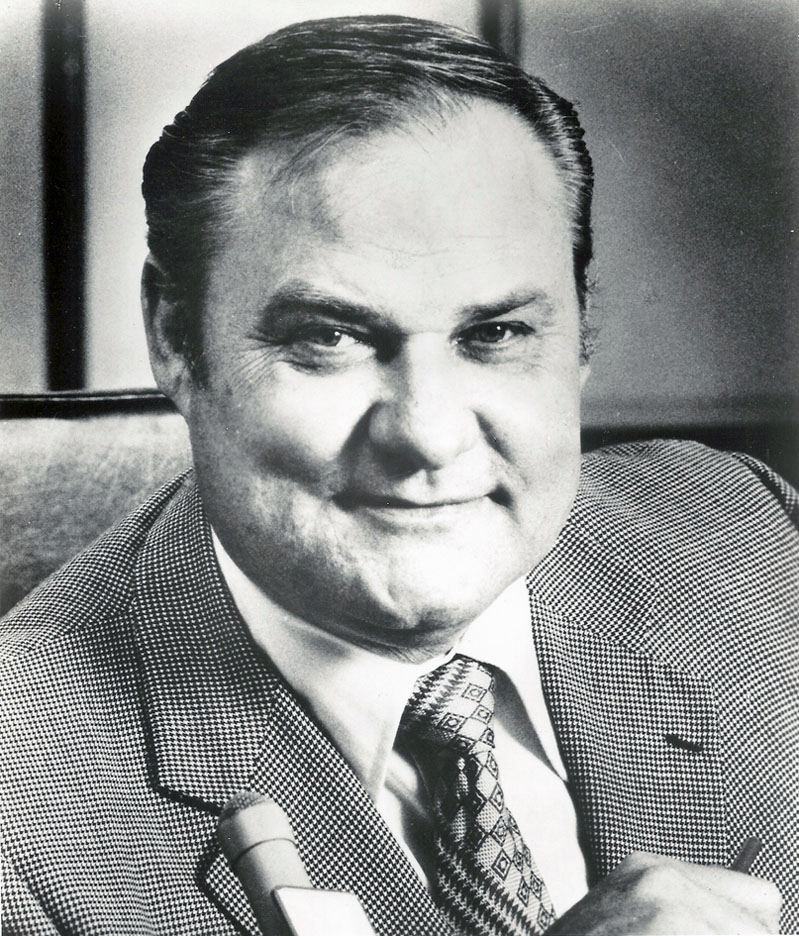
HOA in New York ALWAYS WORKING
Herb made some records, which are available for listening on YouTube – he wasn’t allowed to play his own records on the air. His post-Twin Cities activities also included a show in Turkey, recording tapes for TWA, English pirate radio, and performing an on-air audition for a Broadway show (Robert Goulet got the part).
When I talked to him he was on the air on Sunday nights on a station in Florida, loving every minute of it.
Herb Oscar Anderson passed away Sunday, January 29, 2017, at the age of 88. His son, John James, who played Jeff Colby in “Dynasty,” reported that he died in Bennington, Vermont, near Hoosick Falls, New York, where he had a home. The cause of death was kidney failure.
Here’s a site with a nice Profile of Herb Oscar Anderson by Scott Benjamin.
Dick Driscoll
Dick Driscoll was one of the most active, prolific, peripatetic, and hilarious disk jockeys to grace the airways of the Twin Cities. It is telling that there are many, many people in the industry – and part-time historians like me – who can credit him with career starts and boosts, interviews, and friendships. Dick Driscoll passed away on July 14, 2016, and will be sorely missed. Services were Friday, July 21, 2016, at Fort Snelling.
EARLY YEARS
Richard K. “Dick” Driscoll was born on December 20, 1932, in St. Paul, Minnesota, and went to Mahtomedi High School.
Driscoll made his broadcast debut in high school, when he and some friends found an Air Force transmitter the school had purchased as surplus. They got it working in the band room, and broadcast record shows and live music. They even covered sports from the third story roof of the high school, until the wind almost blew them and the remote equipment off the roof.. “We were on the air for about a month before the FCC got to us,” he said. “We were on the Air Force’s frequency for the Air National guard.”
His next appearance was legal. A trio made up of Driscoll on guitar, Bill Carlson on accordion, and Dick’s girlfriend (later wife), Mary Berthiaume, on vocals, won a spot on Cedric Adams’s junior talent contest on WCCO. They won three weeks in a row – which paid a $25 savings bond – until their trio was aced out by a soprano from the McPhail Music School singing from “Carmen.” Driscoll and Carlson then became CBS pages at WCCO, and Dick did many “walk-on” bits with Ed Viehman and Jergen Nash.
Driscoll graduated from high school in 1951. Here’s his class picture, showing that he was a leader and a funny guy at an early age.
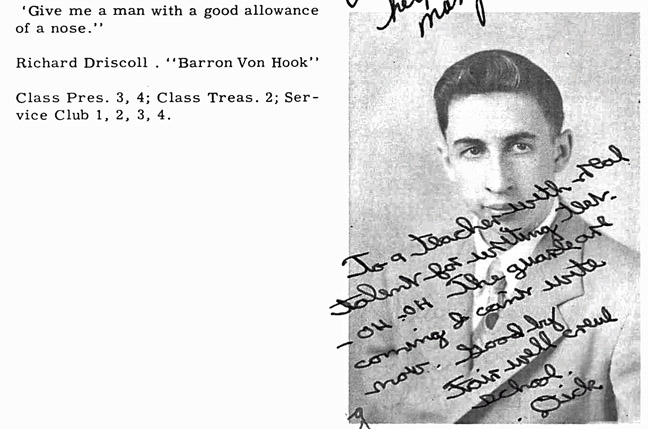
At some point, probably right after graduation, Dick was drafted into the Army and served for two years in the Armed Forces Radio in Korea. He remembers he was home before the war ended, which was in July 1953.
Dick married Mary Ann Berthiaume (born March 30, 1934) and they had three children:
- Patricia Lee Power
- Mary Lynn Olson
- Richard (Rich) Driscoll
Mary Ann died on August 29, 1983, and is buried at Fort Snelling.
TWIN CITIES RADIO AND TV
The indented section below is from a May 4, 1980, profile of Driscoll that appeared in the Minneapolis Tribune TV Week, provided by Jeff Lonto.
[In 1958] Driscoll broke into this market at WMIN…and within a couple of weeks found himself out with a strike. He heard that WDGY, then the town’s rocker, was looking for someone and a friend talked him into auditioning.
“Don Kelley was the program director,” Driscoll recalled, “and when I showed up he said he’d just turn on the mike and I should talk. So I did Dracula.” He was hired and in a year had built a Count Dracula fan club numbering near 6,000. Driscoll did promotions at dances and movies, emerging from a coffin. His first attempt began badly: At the Prom with Bill Diehl, he couldn’t get the lid up. As Diehl, who thought Driscoll was kidding, kept whispering to hurry, he finally shook the coffin off its stand onto the floor and rolled out.
The job at Weegee was starting out in style but shortly after he began there, WMIN’s strike was settled, leaving him under a six month obligation and driving from station to station, from one air shift to another.
He lasted into 1961 at WDGY, turned down a chance to go to [WLS in] Chicago, and moved to television, joining WTCN as an announcer, producer and news and weathercaster. Later [December 1964] he went to KQRS and by the turn of the last decade, was working at WTCN-TV, WAYL and WWTC. He survived that for three years.
…Driscoll…cut down to just WTCN and WAYL four years ago [1976]. That still occupied him seven days a week. He dropped to just WAYL last spring [1979]. In December [1979] he left that moneymaker for a station barely off its bum [WWTC].
…”This place was successful when I left it; when I walked back in, it was a disaster area” economically and physically, he said. Assured by the Short family that it was willing to hang in for the long haul, he signed on.
The change from beautiful music wasn’t traumatic, Driscoll said…”I had been at WAYL eight years…A good deal of that time I had been doing more than one format.” But after a couple of days at WWTC, “I started saying ‘What am I doing? Am I trying to relive my youth, or what?’”
RADIO AND TV
As you know by now, Dick’s career was not linear, and not exactly conducive to a timeIine. I interviewed him on April 22, 2013, late in his life, hoping to pin down dates for all his stations, but it was difficult, not only because there were so many, but because he often worked at more than one station at a time. This information comes from many sources, and I am open to corrections.
KXRA in Alexandria, Minnesota, 1952
Far East Radio Network
KFYR AM and TV
WHLB
WMFG
Arrowhead Radio Network
In mid-1952 to 1955 he said he worked for WDGY, and “tried to sneak rock ‘n’ roll” into the station’s otherwise MOR format.
In 1954 he was a booth announcer for WTCN-TV.
WMIN: 1958 for six months
WDGY: 1958 to 1961
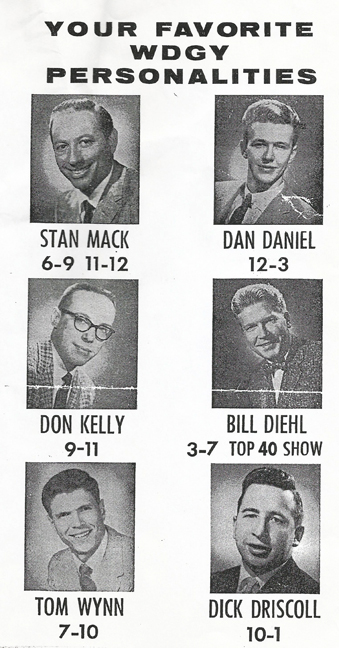
1960 – Courtesy Jeff Lonto 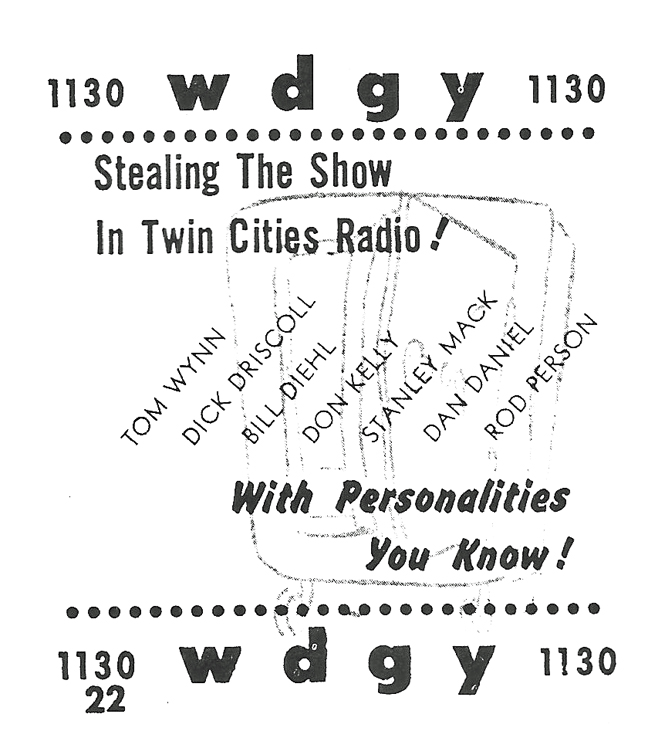
1961 – Courtesy Jeff Lonto
WTCN-TV: 1961 to 1980 and 1983 to 1985
KQRS: December 1964 – 1969.
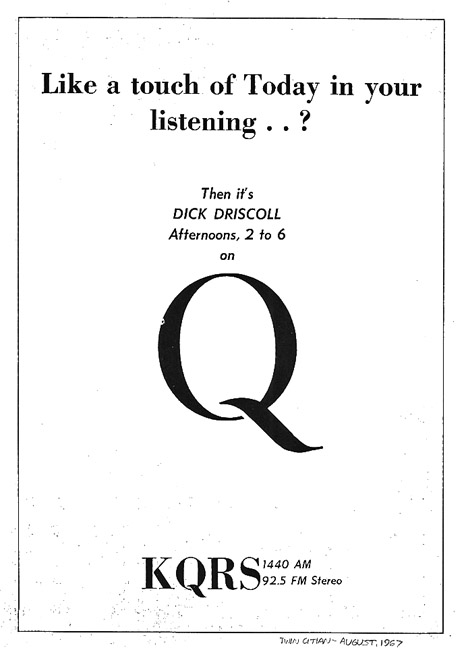
Twin Citian, August 1967, courtesy Jeff Lonto Dick’s son Rich tells the story about the time Dick met Wolfman Jack. The Wolfman was working on the AM side, which was a low wattage station that had to shut down at sunset, while Dick was on the FM side. Apparently Dick was the one in charge of shutting off the AM transmitter at dusk, and one day he did so just as the Wolfman was into a heavy conversation with a young girl. The Wolfman came in screaming at Driscoll, and a true friendship was born. Rich says that it was Dick who advised Wolf to pursue greener pastures in New York or Los Angeles, and the rest is history.
FLYING OFFICER NELSON
Jeff Lonto provides this story about one of Dick’s antics:
In 1967 he was on KQRS. He told me that was where he created the “Flying Officer Nelson” satirical traffic reports. Supposedly, WLOL, which had real traffic reports, filed a complaint with the FCC claiming KQ was deceiving the public with the bits. Dick said a hearing was held at the St. Paul offices, the commissioners heard the Flying Officer Nelson airchecks supplied by WLOL…and busted out laughing. They ruled no reasonable person would assume those were real traffic reports and dismissed the complaint.
My notes from my interview with Dick say that Flying Officer Nelson was sponsored by Win Stephens Buick for two years. Incidentally, Dick did hold a pilot’s license with instrument rating.
WWTC: 1970 – 1976, December 1979 – 1985
DOOBIE BROTHERS CONCERT
Jeff Lonto offers this interesting item:
On September 7, 1971, the Doobie Brothers performed the first rock concert to air live on a Twin Cities radio station. But the concert was not heard on KQRS; it was heard on WWTC (1280 AM) of all places.
WWTC, then primarily a middle-of-the-road music station, broadcast the concert live from Sound 80 recording studio in south Minneapolis. The show lasted about an hour and fifteen minutes. Dick Driscoll (who had moved from KQ to WWTC in 1969) interviewed the band. Driscoll recalls asking them why they called themselves the “Doobie Brothers” when they weren’t brothers and none of them were named Doobie.
“They looked at me like I was some kind of square,” Driscoll recalls.
Performing the concert on a 5,000-watt AM station gave the Doobies much needed exposure while allowing minimal risk of pirates “Bootlegging” recordings of the show.
A Minneapolis Star article the following day pointed out that the show was unlikely to be bootlegged anyway “because the Doobie Brothers are not an extremely popular group.”
The Doobies would not have their first hit until the next year. The show consisted of an acoustic set and an electric set.
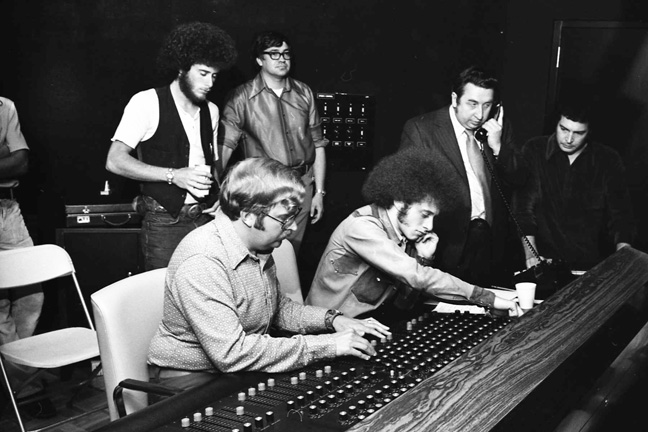
Dick in the studio at the Doobie Brothers session – Photo copyright Mike Barich – used with permission. 
Dick Driscoll at WWTC, courtesy Alan Freed via RadioTapes.com 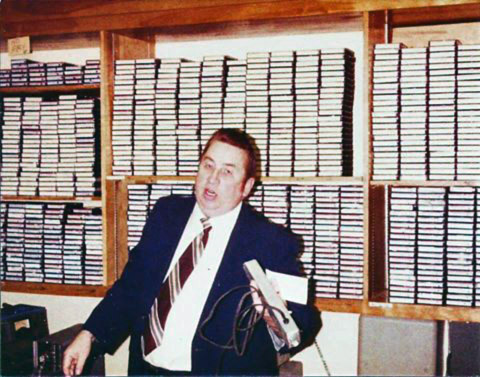
Another shot of Dick at WWTC, 1980, courtesy of Jeff Lonto
WAYL: 1973 – December 1979
KLBB: 1987- April 27, 1995
In 1987 he began working at KLBB. In 1995 Driscoll abruptly left the station and wrote a letter of explanation that he sent to fans wondering where he had gone. The letter said that in 1987 he began working a three hour shift, Monday through Friday. In 1994 the shift went to four hours without a commensurate raise in pay. Then new ownership bought the station with the intention of changing the format to rock, but fan protests quashed that idea. For six months Dick worked the same four hour shift, but suddenly the new owner “demanded that I work an additional 11 hours per week including six hours on Sunday… FREE!!!! … This, after my heart attack, was not the best plan I had ever had forced on me.” He continued the schedule for several months, [trying] to reason with KLBB to go back to the original KLBB agreement.” Finally, on April 27, 1995, he was told in a meeting that the owner “expressed a policy that seemed to state he would hire someone devoid of experience or qualifications who would put in Sundays rather than someone with 30 years on the air in the market who would only work Monday thru Friday.”
ACHIEVEMENTS
Dick’s resume reads:
Mr. Driscoll is highly regarded in the broadcast industry. He was an on-the-air personality with WCCO, WDGY, KQRS, WAYL, WWTC, KLBB, Time Life Radio and Television, Chris Craft Television, and MetroMedia Television. He was the announcer on the Howard Cosell Celebrity Roast. The Host of the Television series “CHILLER” and the writer/director of many specials. He is a consultant to Multi-national companies and is President of a Record studio [Mystery Ranch Studios]. He is nominated for the Broadcast Hall of Fame and was given the Lifetime Achievement Award in the Rock and Roll Hall of Fame. He is a member in good standing of The American Federation of Radio and Television Artists, The Screen Actors Guild, and The International Brotherhood of Electrical Engineers.
AIRCHECKS
Hear Dick Driscoll in action on radiotapes.com
Bill Diehl
Sources for this article include Timothy D. Kehr and an extensive interview with Bill and Helen Diehl in 2013. Many thanks also to the Pavek Museum of Broadcasting and radiotapes.com.
ST. PAUL PIONEER PRESS AND DISPATCH
William Franklin Diehl was born in February 1926 and began his career in the media as a paperboy for the St. Paul Pioneer Press and Dispatch in 1941. A phenomenal increase in subscriptions parlayed him into the job of copy boy when he graduated from High School in 1943 at the age of 17. In 1944, while taking evening classes at Macalester College, he became a copy editor (he also took film classes at the U of M).
In 1948 he became a Sunday movie columnist, and in 1950 he was promoted to movie editor with his column “Look ‘n Listen.”
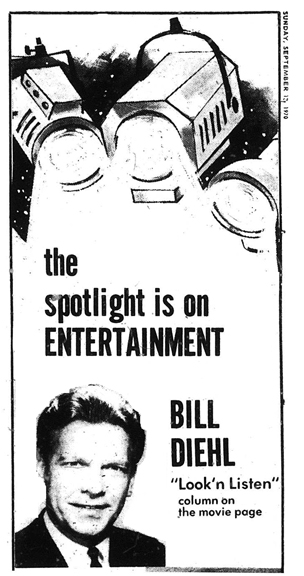
St. Paul Pioneer Press, September 13, 1970 He remained movie editor until 1985, and continued writing his column until he retired on May 31, 1996.
WMIN RADIO
His radio career started in 1948 at WMIN in the Hamm Building in St. Paul. Below is a photo of Stuart A. Lindman holding pictures of Steve Cannon, Merle Edwards, and Bill Diehl in 1949. Diehl left WMIN in January 1950.
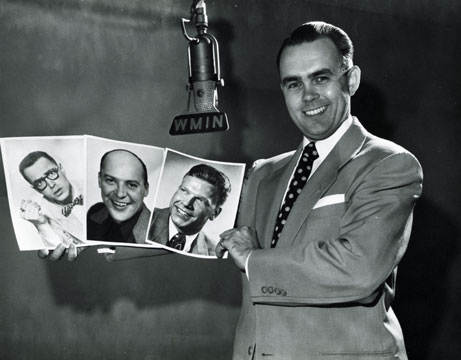
1949 photo courtesy Stuart A. Lindman via the Pavek Museum of Broadcasting.
KSTP-TV
In the summer of 1950 he did a movie gossip show on KSTP-TV called “Screen Stories,” which he wrote, produced, and presented. KSTP wanted him to stay but he wanted to keep his Pioneer Press job.
WMIN RADIO
He went back to WMIN in the fall of 1950 and stayed until early 1956. There he had shows called “It’s Your Diehl” and “Diehl’s Caravan,” where he played pop tunes, Broadway hits, and the songs of the day. He worked mornings, and also on Sundays from 3:30 to midnight.
WTCN RADIO AND TV
From late 1955 to 1957 he was also at WTCN, mostly doing radio but also some TV.
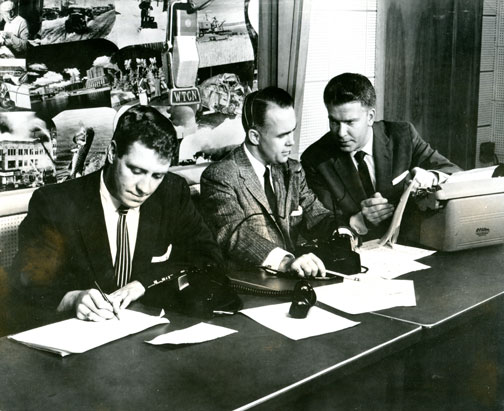
Ken Anderson, Stuart A. Lindman, and Bill at WTCN-AM. 1957 photo courtesy Stuart A. Lindman via the Pavek Museum of Broadcasting.
WDGY
In the fall of 1956 he moved to WDGY, where he did the afternoon Top 40 show. WDGY had become the first rock ‘n’ roll station in the Twin Cities earlier that year, and Diehl was the station’s star DJ. He was also the music director from 1957 to 1961 and got consistently top ratings. He mostly brought in his own records, because the station’s were “too scratchy.” Diehl was known for his phenomenal record collection, which he and his wife Helen bought mostly from Phil Moe at Pyramid Records on 11th Street in Minneapolis. An early Storz ad described Bill this way: “Top newspaper columnist, impersonator, humorist, inside-show-biz authority, business-newsman, full-fledged movie critic.”
TEEN DANCES
In 1957 Diehl was asked to M.C. his first teen dance, at the Armory in St. James, Minnesota. After that he made almost nightly appearances at local dance clubs with local bands such as Mike Waggoner and the Bops, the Trashmen, the Castaways, the Accents, the Underbeats, Gregory Dee and the Avanties, the High Spirits, the Chancellors, and others. He became so sought-after that he often made three appearances a night on the weekends, with wife Helen rushing him from one venue to another.
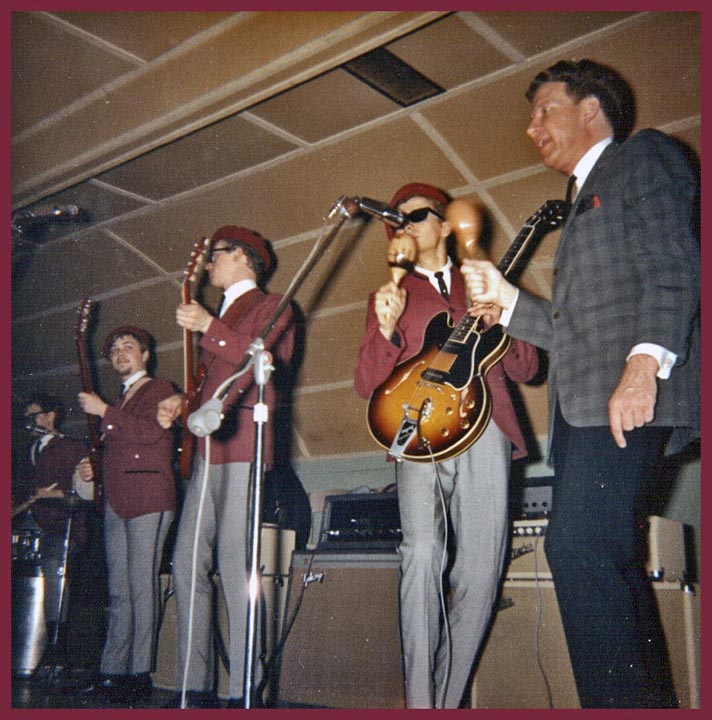
Diehl with the Underbeats. Photo courtesy Rod Eaton The Underbeats’ Rod Eaton remembers this about Bill:
Here’s someone who needs no introduction – at least not if you listened to WDGY or attended dances in Minnesota during the 1960s. Bill Diehl was everywhere. As a radio disc jockey he not only had a commanding on-air presence, he also had the ability to showcase local bands’ records. He MC’d dances all over the state several nights each week. And as a partner in Central Booking, he and Dick Shapiro worked with at least half of all the local bands. Bill appeared on stage with the Underbeats many times. He’d rush in, grab the mic, rev up the crowd, maybe give out a few records, chat with the band, then zip off to his next appearance.
Over time Bill became a friend, a fan, and a supporter. As movie reviewer for the St. Paul Pioneer Press Bill had private screenings of new films. He’d sometimes ask one or two bands to join him. The Underbeats saw the second James Bond film with Bill Diehl. Bill once invited us, and our wives and girl friends, to have dinner with him at his club. I’ll bet other members gave us some strange glances that evening. He always sent gifts as, one by one, musicians got married. Bill’s future wife Helen was an elementary school teacher. So Pat, nearing the end of her studies at the University, spent a day in Helen’s classroom learning the realities of teaching. Bill Diehl was as much a part of the local rock scene as any of the bands. He played a major role in putting Minnesota music on the map.
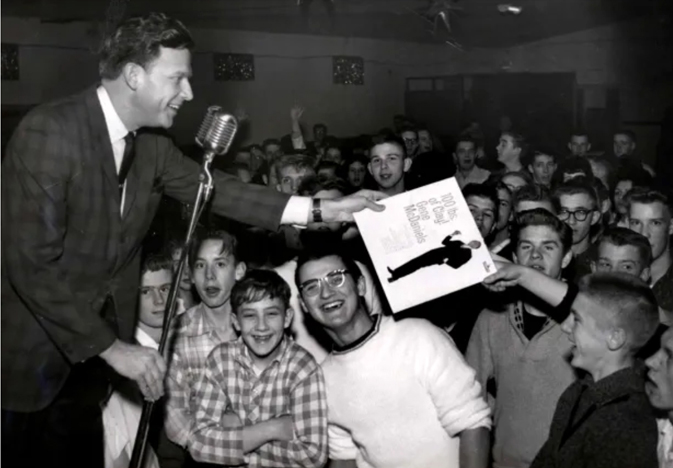
Diehl giving away a Gene McDaniels record, 1962. Photo from St. Paul Pioneer Press, courtesy radiotapes.com
BAND BOOKER
As he got to know the ballroom owners and the bands, he began to get them together as a favor to both. The booking union was skeptical when he told them he didn’t take a commission. They were eventually convinced, but made him join the union as a licensed booker. He and Dick Shapiro ran Central Booking for several years.
Bill actually belonged to five unions:
- AFTRA – American Federation of Television and Radio Artists
- ANG – American Newspaper Guild
- IBEW – International Brotherhood of Electrical Workers – required in order to spin his own records
- AGVA – American Guild of Variety Artists – required to appear on stage
- AAAA – Associated Actors and Artistes of America
RADIO WONDERS
As a promotion, in November 1958 Jim Ramsburg cooked up the Radio Wonders basketball team. WDGY Jocks teamed up with professionals Ed Kalafat, Bobby Cox, Jim Springer, and Corky Devlin, possibly former Minneapolis Lakers. The team could not play high school and college teams, but would go out to small towns for exhibition games. Some not so happily as others, he admits. Proceeds would go to a charity mutually agreed upon by the two teams. The photo below, provided by Jim Ramsburg to the Pavek Museum of Broadcasting, shows Jack Thayer holding the ball. Clockwise from Jack are Bill Diehl, Don Kelly, Dan Daniel, Stanley Mack, and Ramsburg.

WINTER DANCE PARTY
Diehl also M.C.’ed national acts as they appeared in the Twin Cities. One was the Winter Dance Party, starring Buddy Holly, Ritchie Valens, and the Big Bopper, when they appeared at the Kato Ballroom in Mankato on January 25, 1959 and the Prom Ballroom in St. Paul on January 28. The three stars died in a plane crash six days later. On the day the musicians perished, Diehl did a three-hour show on WDGY playing nothing but songs by the three young stars. Hear Bill Diehl talk about “The Day the Music Died” on an MPR piece from 2009.
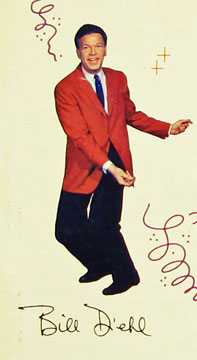 Bill twisting on the cover of a WDGY promotional album
Bill twisting on the cover of a WDGY promotional album
A FUNNY THING HAPPENED….
In 1965 he played a part in bringing the Beatles to Minneapolis. On the air, he promoted the Beatles event with phone-ins with George’s sister, Louise Harrison Caldwell. He traveled to Chicago to see the concert there and took home movies, which can be seen on a DVD produced in 1995 by KSTP-TV called “The Beatles: Minnesota Mania!” The DVD includes an extensive interview with Diehl and members of Minnesota bands from that era and is available from Video Beat. Diehl M.C.’ed the Minneapolis show and was hailed with boos when he announced that the concert would end if the audience rushed the stage.
WCCO RADIO
As rock ‘n’ roll changed, so did Bill, and he jumped to WCCO Radio on September 1, 1967, starting at the State Fair broadcast center.

Photo courtesy radiotapes.com In 1974 he did a weekly series of “Sunday Specials” for WCCO Radio, including a series of 50th anniversary specials. In 1988 he was removed from the weekday shift. He turned down Saturday or Sunday nights, and focused on doing commercials and special projects. He left WCCO in 1996.
Below is an undated page, probably out of a WCCO sales brochure, that focuses on Diehl’s history, calling him a “show business buff.” I hope you can read it.
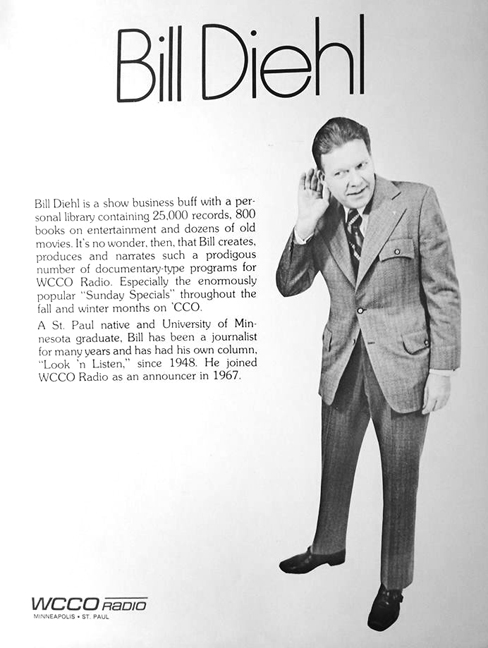
HELEN
1967 was also the year that he married his devoted wife, Helen, who was his true partner, driving him to the various emcee jobs and enabling him to make up to three events on busy nights.
At one time the Diehls had over 75,000 albums, representing all kinds of music. Some had never been played. Most of them were sold at two sales in the 1980s. They also have about 800 books on entertainment and a collection of over 400 old movies, including all of the Laurel & Hardy films. Bill and Helen founded the local chapter of the Laurel & Hardy club The Blockheads in September 1966.
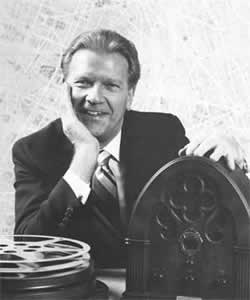
1984 photo courtesy radiotapes.com
WALLY MCCARTHY
In the fall of 1969 he began a series of commercials for Wally McCarthy’s Lindahl Olds on Highway 494 and Penn Ave. He did remote broadcasts from the dealership every Saturday morning, and the promotion became incredibly popular, making lots of money for McCarthy. Diehl would continue to be “Bill Diehl for Oldsmobile” until he left WCCO in 1996. (The site is now Best Buy headquarters.)

Diehl at Wally McCarthy’s, 1982. Image courtesy Minneapolis Star Tribune, July 22, 2017 Bill Diehl’s voice is instantly recognizable to just about anyone who lived in the Twin Cities in the last half of the 20th Century. He is a cultural icon – our own Alan Freed – and worked incredibly long hours to provide us with the rock ‘n’ roll we desperately needed. Thank you, Mr. Diehl!
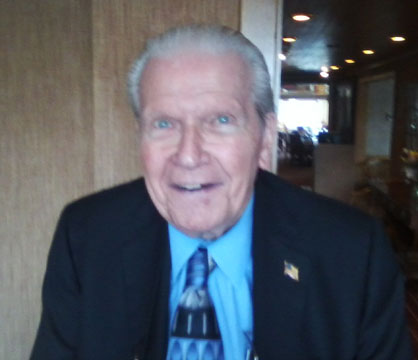
Bill Diehl, March 26, 2013. Pardon the blurry picture I took with my flip phone – he looked great!
WHO WAS BILL DIEHL?
Here is a meditation on Bill’s career, sent in by a “St. Paul man who loves radio” on the occasion of his death.
July 20, 2017
Bill Diehl, who died this week at age 91, was a hard-working newspaper columnist and radio broadcaster, probably the most important entertainment figure in the state of Minnesota in the 1960s.
He had an entertainment column in the St. Paul Dispatch (movie reviews, gossip about stars, etc.), wrote regularly for the St. Paul Pioneer Press, was a popular DJ for the rock ‘n’ roll radio station WDGY, did a record-rating column for the Youth Page of the Saturday Dispatch (essential reading), and did a lot of broadcasting work for WCCO, the highest-rated radio station in town. His opinion could make or break a film in the Twin Cities (and thus in Duluth, Rochester, Wabasha, and Crookston) – he seemed to have considerably more clout than the Minneapolis movie columnist (Will Jones) who was much more sedate, much less readable, and who had no radio presence at all.
Bill was caught up in the complexities of the 1960s. On the one hand, St. Paul was culturally very conservative in those days (much more than today), symbolized by the dominant position in the skyline of the Cathedral of St. Paul. On the other hand, rock ‘n’ roll was a steamroller, and in the first half of the ’60s in Minnesota, Bill was driving it at WDGY. He had so much clout in terms of rock ‘n’ roll, Beatles manager Brian Epstein, an exceptionally shrewd fellow, picked him to emcee the band’s 1965 concert at Metropolitan Stadium in Bloomington. If you look at photos of the Beatles press conference prior to the Met concert, you see that all the microphones are WDGY mikes. That’s Bill’s doing. The Beatles let him dine at their table and partake of their freebies at the Leamington Hotel for the two intense days they were in town. (John Lennon later described Beatles tours as “Satyricon!!!”)
So Bill was cool. On the other hand, Bill was shocked, shocked I say, by film nudity, which was a major flash point for the cultural shift of the ’60s. I well remember his appalled reaction to “Blow-Up” (1966) including his horrified description of the girls in it: “topless AND bottomless.” (Wait a second here, did Antonioni shoot “Blow-Up” at the Leamington?)
A further complication arose from Bill’s fear of hurting the movie business in the Twin Cities. He seemed to be in bed with some of the local movie heavy-hitters including the Mann family which owned some theaters and did all kinds of movie stuff “out on the Coast.” (Bill devoted an awful lot of column space to Mann family projects.) He could kill a movie or open it big-time (he published a rave for “Butch Cassidy” on a cold night in 1969; the Riviera Theater was packed to the rafters that night).
Bill aspired to serious reviewing but ended up confused, twisting this way and that to try to please all his constituencies, from the archdiocese to the Manns to the kids.
Meanwhile he tried to preserve his aura of hipness for the lucrative disk jockey gig. This venture eventually failed. He and his WDGY cohorts were perceived as old fogies by about 1966-67 and lost major market share to the hip challenger in town, KDWB. WDGY seemed to hate the Rolling Stones; KDWB loved ’em. Bill apparently saw the writing on the wall. Ever flexible, he shifted his broadcasting from WDGY to WCCO, the very definition of mainstream. He made a ton of money at ‘CCO hosting Saturday morning broadcasts from “Wally McCarthy’s Lindahl Olds” where you could get a free hot dog.” Bill’s affection for Oldsmobiles far exceeded his enthusiasm for “Blow-Up” or the Rolling Stones.
1965 INTERVIEW
The following interview with Bill Diehl came from an article “The a’ Go Go Spotlight” by Jim Karnstedt in the October 1965 issue of Twin City a’ Go Go.
The Rajah of the Records, the Deacon of the Discs, the Purveyor of the Platters and the Wizard of the Wax with all the Musical Facts. That’s only part of the story of WDGY personality, Bill Diehl. He also handles a successful booking agency, writes in the St. Paul Dispatch and coordinates special events. Last week, I managed to catch him in one of his spare moments.
T.C. a’ Go Go: How did you get started in your radio career?
Bill: I was writing an entertainment column in the St. Paul Dispatch which caught the attention of Sev Widman of WMIN. He thought it was wild and asked me to fill in on a radio show for the vacationing announcer. Soon after, I had my own show on WMIN.
T.C. a’ Go Go: Did you have any radio training at the time?
Bill: No, as a matter of fact, I used to read the newspaper out loud in order to get the proper pronunciation and phrasing.
T.C. a’ Go Go: What made you take up radio announcing?
Bill: I used to sit in the John, of all places, and I thought it would be great to be on the air.
T.C. a’ Go Go: Where did you go from WMIN?
Bill: KSTP asked me to do a TV show called “Sunday Screen Story.” So, I wrote it, produced it, and starred in it with no experience along those lines at all. After that, I declined a full time job at KSTP because the station said I’d have to leave the St. Paul Dispatch. Then I returned to WMIN for awhile and later joined WTCN TV where I did news, weather, movies, and other numerous announcing.
T.C. a’ Go Go: How did you land the job at WDGY?
Bill: Jack Thayer, who then managed the station hired me to do a Top 40 show, which achieved the highest ratings in the station’s history. I did a request show, “Nightbeat,” and now on Sunday, “Your Opinion Please”. Now my announcing is more confined to the weekends. I also coordinate WDGY’s special events like the WDGY AquaTEENIAL Spectacular and the WDGY Winter Carnival Spectacular of 1964, which attracted 20,000 people: 16,000 inside and 4,000 outside the St. Paul Auditorium. It was the largest crowd in the auditorium’s history.
T.C. a’ Go Go: What is the most memorable event in your radio career?
Bill: The one I always remember is the time I fluffed a commercial at WMIN. I mean real bad! Stuart A. Lindman consoled me and said everything would come out alright and I guess it did.
T.C. a’ Go Go: What do you feel is the most exciting part of radio announcing?
Bill: It’s the thought that at a 50,000 watt station like WDGY, your voice reaches out hundreds and hundreds of miles to thousands and thousands of people.
T.C. a’ Go Go: Where have your travels taken you?
Bill: I’ve been behind the Iron Curtain three times in nine years. My secondary purpose in traveling throughout Europe was to polish up on my German and French and taking 16mm color films.
T.C. a’ Go Go: What other public speaking do you do?
Bill: I’ve made many speeches for both public and private organizations. They include the Lions Club, Kiwanis Club, Optimist Club and many others. More than anything, I suppose, is the regular MC work which includes more than I can possibly name. The biggest event recently, of course, was the Beatle Concert.
T.C. a’ Go Go: What are your reactions on the bad publicity the Beatles received?
Bill: The story was blown completely out of proportion. I thought it was extremely unfair for that cloud of bad publicity to be pushed over the name of the Beatles. I got over sixty calls in my home that night.
T.C. a’ Go Go: I understand that you have a lot to do with the bands. Could you briefly explain this?
Bill: I have been booking bands in the Midwest for quite awhile now. Recently, I auditioned ten of them. I’m now, in addition to my regular bands, booking five of those ten. I’m especially proud of Suzie Q. and the Originals which I feel is going to be a very popular group.
T.C. a’ Go Go: What are some of the bands that you book?
Bill: Let’s see, there are the Accents, the Underbeats, Avanties, Chancellors, High Spirits, Del Counts, Gestures, Coronados, Froggy and His Friends, T.C. Atlantic, the Deacons, Suzie Q and the Originals, the Expressmen, and quite a few more. I’m in the process of consolidating with Dick Shapiro of Path musical Productions into the Central Booking Agency. We’ll handle a good part of the dance dates in the upper Midwest.
T.C. a’ Go Go: What is your opinion on the long hair issue?
Bill: I believe it’s purely a matter of personal taste. The arguments in schools seem a little hard to believe. However, it does depend on the age bracket. Ten and twelve year olds are bound by their parents to do as they’re told. When they reach sixteen to twenty-one, they’re more sophisticated and should be able to decide for themselves. It’s just a passing fad and you can see it diminishing already.
T.C. a’ Go Go: Could you give me a brief rundown of your daily activities?
Bill: It starts with my day at the newspaper. As entertainment editor I check clubs, theatres, call Hollywood and New York and usually attend a movie screening in the morning. In the afternoon I write my six-day-a-week entertainment column, “Look ‘N’ Listen,” along with my Saturday record column, “Platter Poll.” I do band bookings in the late afternoon. From about six to eight PM I get in a movie screening and afterwards a personal appearance or two. Lastly, I run out to the station to tape dance commercials. Sometimes I’ll go twenty-four hours without a wink, but eventually I’ll catch u p.
T.C. a’ Go Go: How can you afford to give away the prizes at dances?
Bill: Well, I’m unmarried, don’t smoke, and I’m certainly not a drinker, so it doesn’t put a big dent in my pocketbook.
T.C. a’ Go Go: With what top stars have you been associated in your past?
Bill: Just about any of them. Grace Kelly and I had to share out of the same lemonade glass. I’ve stayed at Robert Mitchum’s house numerous times and I’ve hob-knobbed with Bing Crosby. Also, my work necessitates interviews with a great many stars both in the movie and recording industry.
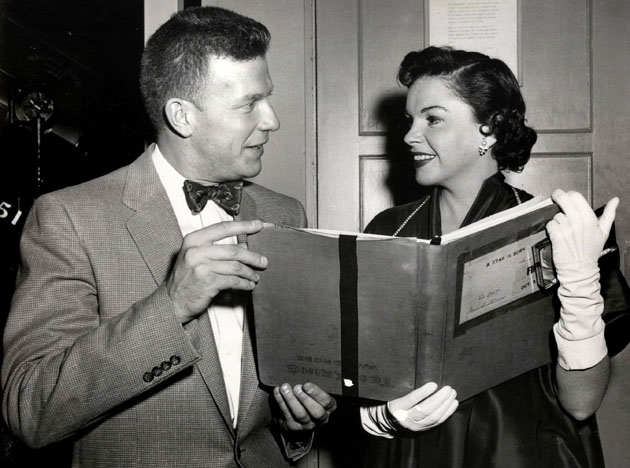
Diehl with Judy Garland in 1954 during the filming of “A Star Is Born” (St. Paul Pioneer Press) T.C. a’ Go Go: Being a personality, do people bother you much?
Bill: They don’t really bother me, but I do get calls twenty-four hours a day from people asking all kinds of wild questions. Girls will call me with their personal problems, but I don’t mind that because it’s quite flattering if I can help someone who really needs it.
T.C. a’ Go Go: What general advice can you give to someone following a career like yours?
Bill: They should have an appreciation for the arts and a solid background in English. We don’t communicate by smoke signals anymore, so it is very important to be knowledgeable on a variety of subjects. Most important, you shouldn’t worry about what people say about you. Just believe in yourself and what you are doing and you’ll be on the road to success.
In 2016, a committee of music lovers created a new award dedicated to Bill. Please see a separate page for the particulars of this special award program.
THE PASSING OF THE RAJAH
Bill Diehl passed away on July 19, 2017, at the age of 91. Below are three excerpts of his extensive obituaries.
THE ST. PAUL PIONEER PRESS
NEWSPAPERMAN BILL DIEHL – WHO CHAMPIONED THE BEATLES, STONES, LOCAL BANDS – DIES
By Ross Raihala, July 19, 2017
William Franklin Diehl always considered himself a newspaperman, first and foremost. But his 53-year tenure covering entertainment for the Pioneer Press was just the start of the résumé of a man who changed the way pop culture was covered, and consumed, in the Twin Cities.
Radio listeners knew him as “Bill Diehl, the Rajah of the Records, the Deacon of the Discs, the Purveyor of the Platters and the Wizard of the Wax, with all the musical facts.” When he wasn’t ruling the AM airwaves, he appeared on local television, emceed teen dances and concerts, booked and mentored young rock bands, introduced local audiences to the Beatles and the Rolling Stones, befriended Hollywood stars like Grace Kelly and Judy Garland, collected everything from records to World War II memorabilia, and traveled the world while documenting it all on 16mm film.
Diehl died Wednesday in hospice care at St. Paul’s Sholom Home East. He was 91. He is survived by his wife, Helen, who said Diehl died from complications after a fall that left him with limited mobility. There will be no funeral or memorial service, per his wishes. His cremains will be spread at Lake Itasca, where he proposed to Helen, whom he married in August 1967.
“He loved St. Paul and he loved the newspaper,” said Helen Diehl. “He was a workaholic and he was always on time. We loved the same things and we had a great life together. I’m thankful I had him for as long as I did.”
CHANGED THE FLAVOR OF THE NEWSPAPER
A St. Paul native, Diehl got his first taste of the newspaper business as a carrier at the age of 11. Each morning, he’d get up at 4 a.m. and was on the streets a half-hour later delivering what would eventually become a route with 250 customers. That attracted the attention of associate publisher Hal Shugard, who summoned Diehl to the Pioneer Press and Dispatch office. Diehl thought he was going to be fired but instead was offered a job at the newspaper upon graduation.
After completing his senior year at St. Paul Central High School in 1943, Diehl started working at the newspaper while taking night classes at Macalester College and the University of Minnesota. His first job was serving as a debt collector for the circulation department, but he soon angled his way into a copy boy position in the newsroom.
Almost from the start, Diehl made an impact. “War was taking its deadly toll at the time, and death notices were dominated by fallen servicemen,” he wrote in his final Pioneer Press column in 1996. He persuaded the editors to print an image of the flag as part of any death notice involving a member of the military. It caught on so quickly that the Minneapolis Star-Journal started doing the same thing a month later. “I was told by our want-ad executives that my flag idea quickly spread to papers across the nation,” Diehl wrote. “But it started here, and it continues. And (yes, I’m boasting) I am particularly proud of that.”
Diehl also adored the English language and puns, and as a copy editor he brought new flair to the previously stuffy approach to writing headlines. One of his first was atop a story about a saxophone player who was arrested for drunken driving after a particularly wild night. Instead of “Drunken musician is fined,” Diehl went with “Sax player goes on toot.”
In 1950, Diehl pitched then-managing editor Fred Heaberlin an offer described by late Pioneer Press columnist Don Boxmeyer as such: “Bill said he’d write a daily column, handle all television listings and write a Sunday column, plus a gossip column, a record column and cover nightclub acts. All for about $2 a week and a peanut butter sandwich.” Heaberlin’s response: “Who could refuse a deal, or a Diehl, like that?”
Diehl took full advantage of the position, earning sources inside Hollywood and, at one point, reviewing five or six new films a week. He talked about some of the stars he met during a 1965 interview with Twin City ‘a Go Go, a “magazine for Twin City young adults on the go.” As Diehl said at the time: “Grace Kelly and I had to share out of the same lemonade glass. I’ve stayed at Robert Mitchum’s house numerous times and I’ve hobnobbed with Bing Crosby.”
BUDDY HOLLY, ELVIS, BEATLES, STONES
“Legendary” is how Boxmeyer described the sheer number of Diehl bylines in the newspaper. But Diehl was about much more than cranking out column inches. His radio career began in 1948 at WMIN when he was offered a gig subbing for a vacationing DJ who asked Diehl, “You know how to do a radio show, don’t you?” Diehl lied and said he did and then hit the public library and read a book about how to become a broadcaster.
That was just the start of Diehl’s radio career, which included a decade at WDGY helping to establish the Top 40 format as the “Rajah of Records,” and 26 years at WCCO, where he did Saturday morning remote broadcasts for an Oldsmobile dealer. “You could pop right on out to Wally McCarthy’s (Lindahl Olds) showroom and have a hot dog with Bill,” wrote Boxmeyer.
In 1950, Diehl also made his television debut at KSTP, Minnesota’s first commercial television station. He hosted a summertime show, “Screen Story,” about the entertainment business. He once again learned the ins and outs of the position through the public library. Diehl impressed station owner Stanley E. Hubbard so much that Hubbard offered him a full-time job. Diehl offered to work nights and weekends but refused to leave the newspaper, and Hubbard wasn’t interested in sharing him. “I picked the Pioneer Press.”
Diehl turned his radio fame into another job, making personal appearances and emceeing live events. In 1958, Diehl introduced Buddy Holly, Ritchie Valens and J. P. “The Big Bopper” Richardson on stage in Mankato and at the Prom Ballroom in St. Paul, six days before the three musicians died in a plane crash. In 1964, Diehl emceed the Rolling Stones’ first local performance, in the Danceland ballroom at the Excelsior Amusement Park. The following year, he did the same thing for the Beatles at Met Stadium in Bloomington. He accompanied the Fab Four for their entire stay in town, which he later wrote was “48 hours of unparalleled excitement.”
Mike Waggoner’s Twin Cities band the Bops was one of the first groups Diehl took under his wing. “Bill was almost a spokesman for a generation,” Waggoner said. “We were just a bunch of kids trying to play music in roller rinks, on flat-bed semis and wherever we could. He championed what we did. He was tremendously busy, but also generous with his time. He not only enjoyed what he did every day — writing for the newspaper and playing records on the radio — he enjoyed seeing the rest of us develop our skills.
“Bill was a very caring, very sensitive fellow who wanted people to do the best they could with whatever they had.”
When he wasn’t ruling the AM airwaves, he appeared on local television, emceed teen dances and concerts, booked and mentored young rock bands, introduced local audiences to the Beatles and the Rolling Stones, befriended Hollywood stars like Grace Kelly and Judy Garland.
Diehl’s tireless schedule took a toll on his personal life. In his early years, he lived with his first wife, Marilyn, in a $75-a-month furnished apartment in Highland Village. “That’s all I could afford.” “I didn’t have any money. … (Marilyn) gave up after a while. She wanted a divorce.”
And while Diehl championed the burgeoning rock ‘n’ roll movement, he was also a conservative unafraid to take entertainers to task.
An early supporter of Elvis Presley, Diehl was unimpressed after seeing the 21-year-old play the St. Paul Auditorium in 1956. “On stage, Elvis, you were nothing but a male burlesque dancer,” he wrote. “Your gyrations were straight from strip-tease alley. Happily, you did leave your clothes on.” He went on to praise Presley as a fine example to kids for not smoking or drinking but went on to ask: “Why, Elvis, do you then resort to your ‘Pelvis Presley’ routine?” He ended the column in a huff, concluding that “in show biz, nothing grows in dirt.”
An immaculate dresser himself, Diehl took Mick Jagger and company to task about their lack of grooming. “They looked like they’d slept in their clothes for a week and hadn’t eaten for two,” Diehl wrote of the Rolling Stones. “Soap must have been a dirty four-letter word to them.”
“STAR WARS,” WORLD TRAVEL
Diehl also kept readers fully informed on the sexual content and politics of films he reviewed, warning of “total frontal” or “rear male” nudity. At the same time, he wasn’t afraid to champion movies he loved. In 1977, he raved about a film by the name “Star Wars.”
George Lucas’ space epic, Diehl wrote, “brims with suspense and interest for everyone, and in every age bracket. Its storyline is simple and direct and marvelously executed. Spellbinding and captivating, the footage in stunning style shows the potential of screen Entertainment with a capital ‘E’ (as opposed to those dreary, mindless offerings in which the cast can do nothing more than disrobe and engage in sexual gymnastics). You’ll want to see ‘Star Wars’ again and again.”
Diehl’s film writing even made an impact on St. Louis Park natives Joel and Ethan Coen, who paid tribute to Diehl in their 1996 film “Fargo.” In the scene where William H. Macy’s character Jerry Lundegaard tries to strike a business deal with his father-in-law, he gets rebuffed with the line: “If I wanted bank interest on $750,000, I’d go to Midwest Federal. Talk to old Bill Diehl.”
Stan Turner knew Diehl professionally for years and formed a friendship with him in the ’80s when Turner was the main news anchor at KSTP-TV. Turner had the opportunity to sit down for a one-on-one interview with President Ronald Reagan, and Diehl was impressed with the results. “Bill wrote me the nicest note, saying he appreciated that I treated the president with respect at a time when many were not.”
The pair soon bonded over broadcasting, pop music and other shared interests, and Turner became “a very privileged member of his circle of friends.” Diehl and his wife, Helen, did not have children and were able to spend their free time traveling the world, hitting every continent except Antarctica. (“Bill said he didn’t want to go somewhere where the birds were dressed better than he was,” said Helen Diehl.)
“They didn’t go to danger zones, but if you name any other place, they’d have been there,” Turner said. “They went into China, Southeast Asia, northern Europe and North Africa. He had a great interest in World War II and visited many battle sites.”
Over the course of the last handful of Saturday nights each year, Diehl and his wife would invite friends in groups of eight or so for dinner and a screening of footage Diehl shot around the world.
“He would narrate the films, reading from a travelogue script he wrote in his own hand,” Turner said. “There were three reels, and Helen would serve dinner between them. It was mesmerizing and always a great evening. Just like in his movie reviews, Bill loved puns and wordplay. They were such gracious hosts, we often would stay until midnight. I don’t know how they had the stamina.”
In his final Pioneer Press column in 1996, Diehl wrote that “I have been granted more fun, thrills, excitement, more of just about everything than any reasonable human being could expect.”
Diehl dealt with health problems in his 80s but still managed to get out from time to time. A year and a half ago, he was Waggoner’s guest of honor at his 75th birthday party. “He was in a wheelchair and relatively immobile, but still sharp as a tack,” Waggoner said. “It was uncanny how his recollections were absolutely bright and articulate and on point. He loved to tell the stories, and we all loved to hear them.
“He became influential without trying to be influential. He believed strongly in youth and reinvention. I don’t think the man ever gave up on trying to be current. He personified professionalism and was always a very modern man. He was a gentleman and a friend, not only to me, but to so many others.
“He was Bill Diehl. He is Bill Diehl, and he meant so much to all of us.”
MINNEAPOLIS STAR TRIBUNE
Media showman, Minnesota’s rock ‘n’ roll ‘godfather’ Bill Diehl dies at 91: He helped shape Minnesota’s burgeoning rock scene in the 1960s.
By Crystal Duan, July 22, 2017
Back in the days when there were “showmen,” Twin Cities media personality Bill Diehl embodied the concept. In a career that spanned more than half a century, he was a radio disc jockey, a film critic, a newspaper columnist, an entertainment emcee and a star in his own right. Diehl passed away Wednesday while in hospice care at St. Paul’s Sholom Home East. He was 91.
Born in 1926, Diehl started working for the St. Paul Pioneer Press as a paperboy at age 15. From there, he managed to land a job in the newsroom, eventually becoming the paper’s lead movie critic and befriending many Hollywood stars. He also helped establish the Top 40 format for Twin Cities radio stations, moonlighting as an on-air personality for WMIN (now known as KMNV), WDGY and WCCO.
Steve Moravec, a radio station consultant in St. Paul, was 19 when he met a “glib and clever” Diehl at WDGY in the 1960s. Moravec remembers admiring the “commanding figure.”
“I don’t know how he did what he did,” Moravec said of Diehl’s varied professional pursuits. “I don’t think I have ever in my life had as much energy as Bill Diehl did for years and years.”
Diehl will be remembered as “the godfather” of the midcentury Twin Cities music scene, according to Moravec. For years, Diehl used his role as a radio personality to help Minnesota musicians book live shows and otherwise promote their work. He was a mentor and adviser to several local acts, introducing audiences to their music with airplay and by emceeing concerts.
Dal Winslow, of the Minneapolis band the Trashmen, said Diehl was an essential figure during the band’s early days.
“He was the one who said, ‘You guys gotta record that song,’ when we first came out with [the 1963 hit single] ‘Surfin’ Bird,’” Winslow said. “And we went back and played it for him at the radio station because that’s how helpful he was, and he said, ‘You should cut it down and rerecord it,’ and offered all sorts of helpful advice like that.”
Diehl is survived by his widow, Helen.
There will be no funeral or memorial services, per Diehl’s wishes.
MINNEAPOLIS STAR TRIBUNE OBITUARY
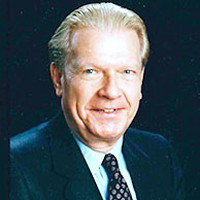
Diehl, William F. “Bill” 91, of St. Paul, Minnesota, after a long illness, on July 19, 2017. Survived by wife, Helen; brother, Dr. James (Gayle) Diehl; sister-in-law, Mrs. Phyllis Nelson; nieces and nephews; great (and great, great) nieces and nephews. Preceded in death by parents, Mr. and Mrs. Frank (Ellen) Diehl; sister, Mrs. Joan (Howard) Nelson.
Bill Diehl was a newspaper columnist, Radio broadcaster and pioneer television broadcaster. He worked at the St. Paul Dispatch/Pioneer Press for 53 years. He was at WMIN from 1948-1956; WDGY for 11 years, and WCCO Radio for 26 years. At WDGY, he was “the Rajah of the Records, the Deacon of the Disks, the Purveyor of the Platters, and the Wizard of the Wax with all the musical facts.” Along with his broadcasting duties, he was a popular Emcee for musical acts, including Buddy Holly. He played a significant role in bringing the Beatles to Minneapolis in 1965.
After beginning as a paperboy at the St. Paul Dispatch, he was employed by the paper as a copyboy, rising to have his own column, “Look and Listen” by 1950. He was Entertainment Editor and film critic until 1985; continuing to write his own column until 1996. Bill and Helen Diehl had an extensive library of albums and classic films and were founders of the Blockhead Tent of the Laurel and Hardy Club “Sons of the Desert.” Our thanks to the Nurses and Staff of Sholom Home in St. Paul, Minnesota, as well as to the Hospice caregivers. Memorials preferred. O’Halloran & Murphy 651-698-0796
Published on July 23, 2017
Barry Siewert (Barry McKinna)
Barry Siewert was born and raised in St. Louis Park. He has a brother Bruce who was an all-star basketball player at Park High in the 1950s. Their mother Newnie, a former Miss Fergus Falls, is an accomplished artist and community volunteer. Father Wally was a WWII veteran of the Battle of the Bulge, receiving a bronze star and a purple heart. He worked as foreman of NW National Life Printing. The family lived at 3924 Xenwood Ave So.
Barry graduated from Park High in 1965 and started his career in broadcasting. He began as Barry “McKinna”, on-the-air at KDWB radio. He has interviewed countless artists and was the first person to play a song not on a record in the Twin Cities. It was a tape cartridge in 1971 of Elton John’s “Crocodile Rock.”
Following his time at KDWB, he went back to using his real name and was on-the-air at many radio stations, including: WDGY, WWTC, KS95, WLTE, and K102. He also spent many years anchoring the news and sports on local Channel 11 TV.
Barry has recorded and produced music, has organized and played with many bands, including “The Rocker Brothers Band.”
His company, BSC Studios, creates and produces business videos and radio/TV commercials and produces various consumer shows.

Barry at KDWB, 1973. Photo courtesy RadioTapes.com
Save
